Kanchenjunga Base Camp Trek - Updated Cost | Itinerary | Map

- Duration 22 Days
- Difficulty Level Moderate or Grade B (**)
- Destination Nepal
- Meals & Accommodation Breakfast, Lunch and Dinner
- Trip Start & End Kathmandu-Kathmandu
- Trip Type Camping and Adventure Trekking
- Major Attraction Dense rhododendron, pine, and oak forests, panoramic views of Makalu and Chamlang
- Maximum Altitude 5160 Meters
- Best Time April-May-June, September-October and November
- Kanchenjunga, the third-highest peak globally
- Dense rhododendron, pine, and oak forests
- panoramic views of Makalu and Chamlang
Kanchenjunga Base Camp Trek is a well-trailed route despite being a journey into the wilderness, as the region bears a mild topography and is easily accessible. Kanchenjunga, meaning Treasures of Snow, stands 28,198ft tall, the third-highest peak in the world. Considered a remote trek through Eastern Nepal, the trail passes restricted areas and takes the periphery of the border to the Indian state of Sikkim.
The trek starts after a flight to Biratnagar and a four-hour drive to Basantpur. The trail climbs through the settlements of the yak herders, Sherpa, and Chhetri villages with a backdrop of the Kanchenjunga massif. Crossing the ridge towards the Tamur River, panoramic views of Makalu and Chamlang appear. The trail crosses the Mewa Khola at Dobhan and follows the TamurKoshi. Dense rhododendron, pine, and oak forests pass along the way.
At Ghunsa, a Sherpa village, prayer flags and gompas are plenty. Jannu and other unclimbed peaks can be seen from a monastery nearby. Next, the trail passes through the edge of Kanchenjunga Glacier. After crossing the junction of Lhonak Glacier and the valley, we come to a gorgeous clearing with a magnificent landscape of unspeakable beauty, where we set camps for the day. Lhonak’s exploration continues for some days, including going to Pangpema to view Kanchenjunga’s north face. Then, slowly descending through Tortong, Yamphudim, Khebang, Phakholing, and Tharpu, we reach Bhadrapur, where we take a flight back to Kathmandu.
Eastern Nepal is distinguished by increased diversity on several levels, including ethnic groupings like the Rai and Limbu people, the richness of flora due to the region's higher summer rainfall, and some of the most breathtaking mountain vistas in the Himalayas. We enter a different environment by traveling along the glacial torrent of the Tamur and Ghunsa Rivers which originate on the northwestern face of the Kanchenjunga Himal. Peaks like Pyramid Peak, Jannu, the Twins, and of course, Kanchenjunga (8586m) dominate the landscape, which is eclipsed by an alpine majesty in practically every direction. On the return trip over the Mirgin La Pass, it is not any less dramatic as we traverse the mountain to the south (4500m). This is a difficult journey in a place that hasn't seen much travel lately.
A trek to Kanchenjunga's base camp is in and of itself an epic adventure that never lets up on the thrill. Compared to other treks in the Indian Himalayan range, the journey to Kanchenjunga Base Camp is considerably distinct from the others. Across the borders of Nepal, Tibet, and India, the Kanchenjunga massifs form a large cross (Sikkim). In India, Kangchenjunga was considered the tallest mountain until 1849, when Everest and K2 were discovered.
Geographically speaking, Kangchenjunga ranks third among the world's highest peaks, together with its five large massifs. Since 1988, there has been a significant increase in tourism to these five Himalayan massifs in the Sikkim region. In the beginning, trekking was prohibited in the region to protect its ecosphere. The explorers slowly revealed the hidden lakes, tribal communities, and forested areas home to a wide range of flora and species.
Starting at Yuksom, the exhilarating trip to Kanchenjunga base camp continues to Bakhim, Dzongri, Laxmi Pokhari, Bikhbari Chaurikhang, Rathong Glacier, Bikhbari, and eventually ends at Bakhim. Trekkers will marvel at the breathtaking views of Mt. Khangchendzonga (8,586 m), Mt. Kokthang (6,148 m), Mt. Pandim (6,691 m), and several other peaks in the area throughout the 11-day excursion. A trekker with an adventurous spirit, a desire to discover uncharted territory, and the resolve and physical stamina to meet the rigors of a physically taxing path through one of Nepal's most remote areas may consider undertaking the Kanchenjunga trek. This trek is typically performed for small groups of people searching for custom dates; we offer knowledgeable advice, preparation, and a high degree of professionalism and care on a trek with a great crew. This trek visits both base camps on the north and south side of the mountain.

What to expect at the Kanchenjunga Base Camp trek?
- Learning about the villages and culture of the Limbu people.
- Enjoy the expansive view of the nearby mountains, including Rating, Chandra Peak, Frey Peak (5830 m), Koktang (6,148 m), Kabru Peak (7,412 m), and the Kabru Dome (6600m). ∙ Meet and get to know the residents of isolated villages.
- An unforgettable experience is a trek to the third-highest mountain's base camp. ∙ Visit a Sikkim tea garden, learn about the many tea varieties, and spend some time outside.
- Take a monastery tour to learn more about Sikkim's vibrant culture.
- Abundant wildlife, including black bears, musk deer, snow leopards, and blue sheep ∙ Strolling across Yalung Glacier
The isolated and lengthy Kanchenjunga journey lasts 6–8 hours each day and is a remarkable vacation experience. This trekking area sees very few tourists. Compared to the Everest and Annapurna regions, Kanchenjunga is less populated. A chance to experience a local homestay and the Sherpa, Rai, and Limbus groups' cultures and traditions in a variety of settings is provided by the base camp trek to Kanchenjunga. The Himalayan black bear, musk, leopard, and red pandas can all be seen in the Kanchenjunga region, along with a variety of birds, shy dragons, amphibians, mammals, re-billed blue magpies, and pheasants.
Kanchenjunga, the third-highest mountain in the world at 8,586 meters, is visited by trekkers on the Kanchenjunga Circuit in both the north and south base camps.A decent degree of fitness and previous trekking experience is preferred for this trek because it takes place in a remote location. Nevertheless, despite its isolation, trekkers can visit Ramtang and Oktang Monasteries and acquire insight into the local culture. Along the way, the scenery is diverse and includes rivers, waterfalls, green meadows, birch and pine forests, the Yalung Glacier, and of course, the majestic mountains that line the route.
Regarding the mountains themselves, in addition to the Kanchenjunga peak, there are four additional peaks that are higher than 8,000 meters, with Kanchenjunga West, also known as Yalung Kang, being the most significant (8,505m). Twenty peaks higher than 7,000 meters are also present in this region, the tallest of which are Kambachen (7,903 meters), Janu (7,710 meters), Jongsong (7,483 meters), Kabru (7,353 meters), Tent Peak (7,365 meters), and the Twins (7,350m).
There are also many peaks higher than 6,000 meters. Five significant glacial systems can be found within this remarkable collection of peaks. These include the Zumu, Talung, and Rathong glaciers, which flow into Sikkim, and the Kanchenjunga and Yalung glaciers, which flow into Nepal's great Tamor River.
Is Kanchenjunga Base Camp Trek right for you?
The 220-mile Kanchenjunga trek is a challenging and demanding, necessitating high physical condition for three weeks of continuous walking while carrying a light rucksack. There are a few places around the base camps where it could be required to use short ropes to help move across rocky terrain because the terrain is frequently harsh with rocky roads and some long hills These provide protection and assistance for individuals crossing short rough portions. However, no climbing experience is necessary for the hike.
It is classified as a challenging trekking location in Nepal's Kanchenjunga. This hike is challenging. It's difficult if you have to navigate a variety of mountain passes while enduring challenging ascents and descents. Additionally, the length of time required for this expedition makes it challenging. For more than three weeks, you will be traveling through little towns in the countryside.
It takes a lot of effort to travel to the highest elevation of 5150 meters, which requires crossing multiple mountain passes. To continue, you need a ton of patience and tenacity. Otherwise, it is exhausting to travel across challenging passes, untamed glacier rivers, isolated forests, and mountainous terrains! Before climbing Kanchenjunga, one must first obtain a restricted area trekking permission from the government of Nepal. You can't continue there. You must travel with a licensed, qualified guide.
Although challenging, this walk is not insurmountable. Anything is achievable with a strong sense of purpose and well-thought-out strategies. Success depends on a variety of factors in addition to what you do. You must travel with the proper business that has a qualified crew and guide.
How to prepare for Kanchenjunga Base Camp Trek?
Enhancing aerobic and strength endurance as well as becoming accustomed to carrying a daypack upwards for extended periods of time are all important components of training for Kanchenjunga Base Camp. You should start going on long walks and hiking at least once a week eight to twelve weeks before to your trip (focus on duration more than distances). Build up a 4-6 hour hike or walk with little pauses.
If your neighborhood doesn't have any sizable hills or mountainous terrain, walk hill intervals on a treadmill and stair stepper twice a week. Two times per week of full-body strength training appear to be beneficial for the majority of people. Before undertaking a strenuous physical endeavor like hiking to Kanchenjunga Base Camp, you should always consult your doctor. Before beginning any fitness program, we advise you to consult your doctor.
Our Success Trips
We summited the summit and traveled to Nepal with thousands of people. Still, our true victory is to get your destination that brings us to the top with our complete service of trekking, mountaineering, and adventure tours.

Day to Day Info
Day 1: arrive kathmandu(1320m).
Arrival in Kathmandu. Our Airport Representative will meet you at the Tribhuvan International Airport. We can arrange a drop at the Hotel by private tourist vehicle. You can either take a rest or meet us at our office and know the detailed arrangement of the Trek.
- 30 Minutes From Airport
- 1320 Meters
Day 2: Trek preparation day
After breakfast, Mountain Rock Treks and Expedition will introduce you to the trek leader/guide at the hotel. This pre-trip meeting is for briefings on the trek and other necessary details. Please bring your passport, three passport-sized photos, and a copy of your travel insurance policy. Then, you can use your free time to rest or explore around for some last-minute shopping. A visit to the world heritage sites in Kathmandu , including Swayambhu, Boudha, Pashupatinath, Kathmandu Durbar Square, etc, is also arranged as per request.
Day 3: Fly to Bhadrapur and drive to Phikkal (1468m/5 hours)
After breakfast, we drive to the airport in Kathmandu, where we fly to Bhadrapur before continuing on to Phikkal, which is located at an elevation of 1468 meters above sea level. 5 hours or so are required. We believe that this option is the fastest and least expensive for the south to north Kanchenjunga Base Camp Trek, while it could also be used for the north to south trek with an additional day's hike to Mitlung.
- Breakfast, Lunch and dinner
- approx. 5 hours
Day 4: Drive to Taplejung /Suketar(1870m/ 8 Hours)
After 4 hours, passing via the main tea-producing town of Ilam (800m; tea and cardamom elanchai are widely farmed here), from which you may visit Darjeeling, and then proceeding to Phiddim (1038m) for lunch. The road rises to a cool 2300 meters and descends to a sweltering 800 meters. After 8 hours, we arrived at the district office in Taplejung (1870m; also known as the "fort of King Taple"). A 1.5-hour trek or a short drive in a jeep will get you to the Suketar (2420m) airstrip.
- Lodge/Tented Camp
- approx. 8 hrs
Day 5: Trek to Kande Bhanjyang (2129m, 5-6 hours walk)
Trek eastward along the airport, turn onto the right-hand road, and climb steadily upward to Deurali (2578 meters; deurali and bhanjyang both mean pass and saddle!). When a road turns left and leads to the day's walk distant pilgrim-attractive Pathibhara Devi Temple (3794m), take the right fork. Continue over the ridge covered with rhododendrons to Lali Kharka (2266m), where you may have delicious traditional Daal Bhat. Tractor-trailers and perhaps a jeep are present where the road now comes to an end. After an hour, descend and make a circle through a scrubby forest to Tembewa (1800 meters), then pass through Simbu (1700 meters, Simbuwa), or continue down a hot, steep path, cross the Phawa Khola (1430 meters), and then climb steeply to the hamlet of Kunjari with its strewn bamboo and banana trees (1800m). Spend the night in Kande Bhanjyang or Kunjari.
- approx. 5-6 hrs
Day 6: Trek to Phumphe (1858m, 6-7 hours)
A difficult climb leads to the welcoming 5-bed Gurung Kande Bhanjyang (2130m, Sinchebu, Sinchewa Bhanjyang) lodge. Lunch will be served in Delok (upper) Khesewa (2125m), where you can take in views of Kanchenjunga while descending steps through a forest through hot, humid hamlets that grow millet, maize, and rice. Drop steeply to a beautiful waterfall beneath Khesewa, make a long ascent pass around a ridge surrounded with clear, little waterfalls, then descend to the tidy homes of Phungphung Danda through an endless staircase of stairs (1860m Pumphe, Pumphe Danda). This time of year, workers collect fresh red cardamom under the threat of snakebite from the ginger-like plants that resemble them
- approx 6-7 hrs
Day 7: Trek to Yamphudin (2090m, 7 hours)
A short climb brings you to the charming and tidy Limbu Mamankhe (1780m), where there are various teahouses with beds, after going down stairs via a cardamom plantation to a high bridge. After that, there is a challenging climb in hot, humid circumstances with little shade, but welcome little waterfalls. A higher route to Sherpagoan (2000m, upper Yamphudin) can be taken one hour after Mamankhe, bypassing the descent to Yamphudin and minimizing the amount of ascending and descending the following day.
- approx 6 hrs
Day 8: 8. Trek to Tortong (2995m, 6 hours )
It will be a long day as we go to Tortong today. At Lasiya Bhanjyang, we are able to halt for an overnight stay, but the accommodations are rather basic. And before we leave, we have to make sure it's open. If Yamphudin is closed, we will need to travel another two to three hours to Tortong. The initial climb, some of which is in the shade, is cooler if you start early
- approx. 6 hrs
Day 9: Trek to Cheram (3780m, 8-9 hours)
This is one of the most magnificent treks, with the shifting sounds of the river, moss-hung forests with enormous pines and larches giving way to a great diversity of rhododendrons, all combined with varied broad leafs turning with fall. Today is a long and exhausting 900m ascent alongside the river. We discover a Yak Kharka after about an hour, where we may grab a lunch or some tea. There is a new, simple lodge at Anda Phedi after another 40 minutes, but it is closed during the winter. After 30 minutes, there is a Buddhist and Hindu shrine with a snake-shaped rock carving
Day 10: Acclimatization day at Cheram (3780m)
It is a acclimatization day at Cheram.
Day 11: Trek to Ramchaur (4580), excursion Okhardung (4730m) back to Cheram
You can ascend through rhododendrons and pines that are covered in moss, cross a wide, open gully, and then climb once more to reach Yalung's temporary yak pasture. The Kabrus, Rathong, and Kokthang tower above a stunning sequence of wide ablation valleys, juniper, cinnamon-scented dwarf rhododendrons, moraines, and lakes. Crossing the numerous 10 frozen creeks and leaks will require caution. Blue sheep herds and some yaks, some of which are completely wild, should be avoided. For views of the mountains and Yalung Glacier, climb the surrounding moraine wall while keeping an eye out for snow pigeons and a herd of blue sheep.
Day 12: Trek to Selela Camp (4290m, 6-7 hours)
Today, we complete our hike by joining it to the north side of Kanchenjunga by a beautiful pass that, in the fall at altitude, smells strongly of dwarf rhododendron honey-cinnamon. From those who have come down it, the 800m ascent up Cheram has a reputation for being very difficult. Reach Sele La (4725m) in roughly 3 hours of climbing. After a little descent, turn right and travel gradually uphill and downhill through wonderful alpine fields and scree, with views all the way to Makalu and even Everest. Pass a left-descending path to the blue lakes Anda Pokhari and further down to Anda Phedi after about an hour. At night, you will arrive at Selela Camp.
- approx. 6-7 hrs
Day 13: Trek to Gunsa (3415m,7 hours)
We continue the northern crossing on a rocky, narrow track for four hours to Selele La. (4200m) A chorten and prayer flags known as Tama La eventually appear and signal the beginning of a harder descent through old-growth rhododendrons, silver birch, silver pine, and larches below into Gunsa. There are many lodging options in Gunsa, and some of them advertise internet access.
Day 14: Trek to Khangpachen (4100m, 5 hours)
Pass over a bridge that is slippery in the mornings by taking the obvious path up through Gunsa. After three hours, cross a plank bridge to the true right, circle two large slides with a high risk of rock falls and breathtaking views of Jannu (7711m, Kumbhakarna), and then begin a difficult ascent. Then pause to take in Jannu's most breathtaking vistas! Enter Khangpachen (4145m; Khambachen), which has about 10–12 stone dwellings, after traversing and ultimately crossing a little brook.
- approx 5 hrs
Day 15: Trek to Lonak (4780m, 7-8 hours)
As the elevation grows, the terrain becomes wild and rough. We pass along rocky fields and a rough trail along the riverbank to a waterfall. Ramtang monastery is across the river along the trail, after which comes a landslide section from where we descend to the river and ascend again to reach Lhonak. Overnight stay in a teahouse.
- approx. 7-8 hrs
Day 16: Excursion Pangpema, Kanchenjunga BC (5388m) and back to Lonak.
The Kanchenjunga North Base Camp Excursion takes you deep into the mountains with plenty of time to enjoy and acclimate, but because the moraine terrace is crumbling due to glacial retreat, some sections demand special caution and there is a constant risk of stone falls. The walk is on grassy terraces for about two thirds of the distance. Surprising views of Kanchenjunga and the glacier may be seen. Retrace your steps to spend a second night in Lhonak because it usually gets windy up the valley around 10 a.m.
Day 17: Trek to Gunsa (3415m, 8-9 hours)
After an early morning exploration of Lhonak, we move down to Ghusna. The descent today gives time for more exploration and sightseeing. Overnight stay in a lodge.
- approx. 7 hrs
Day 18: 18. Trek to Amjilosa (2510, 8-9 hours)
Near the Yak Hotel, we will take a swing bridge across the Gunsa Khola. We'll trek for 6-7 hours today to get to Amjilosa. The historic Tashi Choding Gumba, Olangchunggola, Phale, and stony slopes will be encountered on our journey
Day 19: 19. Trekking to Chiruwa (1270m)
Eventually, a wide stone path narrows and becomes a level, lovely walk through rice, millet, and buckwheat fields punctuated by cardamom plantations There is nice shade along much of the track. There is a checkpoint for visitors entering the Kangchenjunga Conservation Region at Tapethok (1322 m), but none for those exiting the area. Arrive in the bustling, civilized Chiruwa (1185m) in 30 minutes, a place with attractive thatched homes, well-stocked stores, and ISD/STD phones.
Day 20: Trekking to Suketar (2420m) / Taplejung
The tractor road will lead you to Mayam (2000 meters). After that, we will go across the swing bridge below the road and take a number of steep detours uphill to avoid zigzagging to get to the next new road and the shops on the pass. Follow the route directly from here to Suketar (2420m) in around 2.5 hours, turning and descending in the final kilometers. You can see Taplejung ahead and below.Alternately jeep is available.
- Lodge/Guest house
Day 21: Fly back to Kathmandu, overnight in Kathmandu
We will fly to Kathmandu after breakfast. In the afternoon, rest and relax in Kathmandu.
Day 22: Final departure or onward for next program
Departure from Kathmandu. A drop from the hotel to the airport 3 hours before the scheduled flight time in a private tourist vehicle. You can also opt for another package with Mountain Rock Treks.
We are pleased to offer the flexibility of tailoring your journey to your desired duration and places, whether extended or shortened, as our proficient team of locals-cum-guides, porters, and accompanying staff have an in-depth understanding of every location traveled.

Cost Details
- Registered local Kanchenjunga trekking guide from Kathmandu.
- One porter between two trekkers to carry your main pack (weight limit 20 kg/porter)
- Kathmandu - Bhadrapur - Bhadrapur by domestic flight and airport taxes.
- Your guide and porter flight/transportation fare and all their expenses.
- Local ground-sharing transportation to/from trekking.
- Local sharing jeep transfers to Taplejung from Bhadrapur.
- Meals: breakfasts, lunches and dinners, tea, coffee.
- Lodge and camping accommodation on twin sharing basis during the trek.
- All necessary Kanchenjunga trekking permits.
- Government taxes and office service charges for documentation
- Accommodation, meals, and transfers in Kathmandu.
- Bar drinks and beverages such as coke, Fanta, mineral water in trekking
- Laundry, toiletries, internet, phone calls, and personal nature expenses.
- Personal travel insurance, trekking gear, international air ticket, Nepal visa, etc.
- Rescue operation charges in case of an emergency.
- Any cost arising due to a change of the itinerary, landslides, political trouble, strikes, etc.
- Gratitude and tips for your guide and porters. (Is expected)
Dates & Price
Essential info, what should you pack for kanchenjunga base camp trek .
The purpose of the gear is to keep you comfortable during the evenings and at night while also keeping you warm, dry, and protected from the sun. The weights of your daypack and major duffle bag should be between 8 and 10 kg and 15 kg, respectively.
Generally speaking, you should bring a good pair of trekking boots, thermal clothing, fleece or down jacket, a light wind cheater, trekking shorts and pants, long and short-sleeved T-shirts, a duffel bag, a day pack, gloves, enough pairs of socks, sunglasses, a headlamp, woolen beanie hats, water bottles, personal toiletries, technology, and books. Here is the list of types of equipment for the Kanchenjunga Base Camp trek:
Upper Body Layers
- ∙ T-shirts
- ∙ Fleece Vest
- ∙ Rain Jacket
- ∙ Down Jacket
- ∙ Thermal long-sleeved t-shirts
Lower Body Layers
- ∙ Trekking Trousers
- ∙ Thermal Long Underwear
- ∙ Underwear
- ∙ Hiking Shorts
- ∙ Rain Pants
Packs & Bags
- ∙ Day Pack
- ∙ Sleeping bag &compression sack
Footwear
- ∙ Hiking Boots
- ∙ Socks
- ∙ Camp Shoes
- Miscellaneous Items
- ∙ Water Bottles
- ∙ Water purification drops
- ∙ Sunscreen
- ∙ Lip Balm
- ∙ First Aid Kid
- ∙ Sunglasses
- ∙ Flashlight/ Head torch
- ∙ Travel towel
- ∙ Gloves
- ∙ Sun Hat
- ∙ Warm hat
- ∙ Trekking poles
- ∙ Toiletries
- ∙ Mosquito Repellent
- ∙ Sanitizers
- ∙ Book/Journal
- Experience the adventure of a lifetime at the foot of Kanchenjunga
The Kanchenjunga Base Camp Trek is a fantastic excursion that you should at least try once in your lifetime. Some people use the Kanchenjunga Base Camp Trek as a warm-up before considering climbing Everest. At the trekking camp, there are many exciting options available, and we promise you'll have a great time. Therefore, make travel plans for Nepal, don your hiking boots, and get ready for the Kanchenjunga Base Camp Trek, Peeps! A fantastic time.
Q1. Why is Kanchenjunga famous?
Nearly half of India's bird species, wild trees, orchids, rhododendrons, and one-third of the nation's floral plants can be found at Khangchenjunga National Park. In the Himalayan region, it has the largest and most extensive zone of krummholz (stunted forest).
Q2. What is the climate of Kanchenjunga?
The spring and fall seasons offer the best weather and climate for hiking to Kanchenjunga Base Camp. In comparison to the top section in the mountains, where temperatures may dip as low as minus 25 degrees, the lower region will be hotter and warmer. The typical wintertime temperature is below 15 degrees.
Q3. Is Kanchenjunga and K2 same?
Mount K2, also known as Godwin-Austen, is higher than Kangchenjunga but is located in Pakistan-controlled Kashmir (POK). K2 is the world's second highest peak.
Q4. How difficult is Kanchenjunga base camp trek?
It is classified as a challenging trekking location in Nepal's Kanchenjunga. This hike is challenging. It's difficult if you have to navigate a variety of mountain passes while enduring challenging ascents and descents. Additionally, the length of time required for this expedition makes it challenging.
Q5. Is trekking allowed in Kanchenjunga?
The Kanchenjunga Base Camp Trek has a 90 km overall hiking trip. Three days of the trip's eleven days are spent traveling, while the remaining eight days are spent trekking. Starting at Rs. 14700, the Kanchenjunga Base Camp Trek is pricey.
Q6. Where Exactly Is The Kanchenjunga Base Camp Trek?
With an elevation of 8586 m, Kanchenjunga is the third-highest peak in the world. It extends into Nepal, Tibet, and India's borders. At a height of 7000 meters, Kanchenjunga Himal, one of Kanchenjunga's Himalayan peaks, is found. Out of the five Kanchenjunga summits, the Main, South, and Central peaks are situated at the Nepal-India boundary in the northern section of Sikkim
Q7. How can I reach Kanchenjunga base camp from Gangtok?
The 61.7 KM flying distance between Gangtok and the heart of Kanchenjunga makes it impossible to travel there using just one mode of transportation. Instead, you would need to get to Yuksom and then hike the last 45 KM to Lamuney, which is the foothills of Kanchenjunga.
Q8. How long is Kanchenjunga base camp trek?
The 220 mile Kanchenjunga trek is challenging and demanding, necessitating high physical condition for three weeks of continuous walking while carrying a light rucksack.
Q9. Is Goechala base camp of Kanchenjunga?
Goecha La is a high mountain pass in Sikkim, India, in the Himalayan mountain range (el. 4940 mt or 16,207 ft). The pass, which serves as a base camp for those hoping to climb Mt. Kanchenjunga, the third-highest summit in the world, offers views of its southeast face.
Q10. What altitude is Kanchenjunga base camp?
Trekkers will marvel at the breathtaking views of Mt. Khangchendzonga (8,586 m), Mt. Kokthang (6,148 m), Mt. Pandim (6,691 m), and several other peaks in the area throughout the 11-day excursion.
- Online Booking
- Secure Payments
- Instant Response
Client Reviews
Long Trek but every step is memorable
Me and my son doing this trek from April till May. It was fantastic with less crowd. It is far better than the Everest base cam crowded trek in Nepal. I Recommended this trek and guide phurba Bhote from Mountain Rock Trek.
Extremely well organized trip
A breathtaking, difficult, four-week trip across a wild, inaccessible region of eastern Nepal. Extremely well organized, handling every logistical and organizational problem from airport pickup to Kathmandu's gear check through the entire 4-week journey. Throughout the walk, a well-organized, diligent group of guides, cooks, and porters provided great service, taking on every logistical problem head-on. Despite the fact that even experienced trekkers find the Kanchenjunga Circuit to be a challenging task, I ultimately felt quite well prepared for the difficulties presented by the altitude, the weather, and the difficult terrain. genuinely memorable.

Our team has extensive knowledge and experience of the Himalayas and can design your dream Trip based on your Expectation, location, time frame, and Budget.
Similar Trips

Dhaulagiri Circuit Trek

Makalu Base Camp Trek
Ask a question.
We use cookies to ensure that we give you the best experience on our website.
Kanchenjunga Base Camp Trek: A Complete Guide to Trekking

Kanchenjunga Base Camp Trek is one of the most fascinating trekking destinations in Nepal, which offers a thrilling and adventurous experience to the trekkers. Additionally, it is the third-highest mountain in the world, standing tall with an elevation of 8,586 meters above sea level.
Therefore, trekking to the base camp of this gigantic mountain provides an opportunity to explore the unspoiled natural beauty of the Kanchenjunga region .
In this blog, we will provide a comprehensive guide to the Kanchenjunga Base Camp Trek, including information about the trekking route, itinerary, key attractions, and other essential details. This will help trekkers plan their trip effectively and enjoy the trek to the fullest. So, let’s dive in!
Flight from Kathmandu to Bhadrapur: The Starting Point of Kanchenjunga Base Camp Trek
The Kanchenjunga Base Camp Trek starts with a flight from Kathmandu to Bhadrapur, which is the gateway to the Kanchenjunga region.
Once you arrive in Bhadrapur, which takes around an hour by air from Kathmandu, you will drive to Taplejung, which is the starting point of the trek. This scenic drive provides an opportunity to soak in the beautiful landscapes and enjoy the local culture.
Kanchenjunga Conservation Area: An Introduction
The Kanchenjunga Conservation Area is one of the major highlights of the Kanchenjunga Base Camp Trek. It is a protected area that covers an area of 2035 sq km and is home to a diverse range of flora and fauna.
The conservation area is also a habitat for several endangered species such as snow leopard, red panda, and musk deer.
Trekking Route: A Brief Overview
The Kanchenjunga Base Camp Trek is a long and challenging trek that covers a distance of around 120 km. The trekking route is divided into two parts – the north and south base camps.
The north base camp is situated in Tibet, while the south base camp is located in Nepal. In this trek, you will visit both the north and south base camps, offering a unique experience to the trekkers.
Day 1-5: The Trek Begins
The trek starts from Taplejung, and on the first day, you will trek to Chirwa, which is a small village located at an altitude of 1,270 meters. On the second day, you will trek to Sekathum, which is situated at an elevation of 1,660 meters.
Likewise, on the third day, you will trek to Amjilosa, which is located at an altitude of 2,510 meters. On the fourth and fifth days, you will trek to Gyabla and Ghunsa, respectively.
Day 6-10: Trekking to Kanchenjunga Base Camp
On the sixth day, you will trek to Kambachen, which is situated at an elevation of 4,050 meters.
Similarly, on the seventh day, you will rest in Kambachen to acclimate your body to the high altitude. On the eighth day, you will trek to Lhonak, which is located at an altitude of 4,790 meters.
Similarly, on the ninth day, you will trek to Pangpema, which is the north base camp of Kanchenjunga. The view of Kanchenjunga from Pangpema is breathtaking, and you will get an opportunity to see the Yalung glaciers from here. On the tenth day, you will trek back to Kambachen.
Day 11-17: Trekking to South Base Camp and Sinion La Pass
On the eleventh day of the trek, you will trek to Ghunsa, and the following day, you will proceed to Sele La Pass, which is situated at an altitude of 4,290 meters. Here, you will get a stunning view of the surrounding mountains, including the majestic Kanchenjunga.
Continuing the trek, on the thirteenth day, you will trek to Tseram, which is located at an elevation of 3,870 meters. This part of the trek is particularly beautiful, with breathtaking scenery and awe-inspiring mountain views.
After that, on the fourteenth day, you will trek to Ramche, which is the south base camp of Kanchenjunga. From Ramche, you will get a panoramic view of the Kanchenjunga Glacier and the surrounding mountains.
Finally, on the fifteenth day, you will trek back to Tseram, making it a challenging but rewarding experience.
On the sixteenth and seventeenth days, you will trek to Sinion La Pass and then to Gunsa. Sinion La Pass is the highest point of the trek, situated at an altitude of 4,610 meters. The trek to Sinion La Pass is steep uphill and requires a good level of physical fitness.
Day 18-22: Trekking Back to Taplejung
On the eighteenth day, you will trek to Kyapar, which is located at an elevation of 2,730 meters. Similarly, on the nineteenth day, you will trek to Sakathum. On the twentieth and twenty-first days, you will trek to Chirwa and Phurumbu, respectively. On the twenty-second day, you will trek back to Taplejung.
Key Attractions of Kanchenjunga Base Camp Trek
Kanchenjunga glacier.
The Kanchenjunga Glacier is one of the main attractions of the trek. It is a stunning glacier that offers a glimpse of the snow-capped peaks and the surrounding landscape.
Yalung Glaciers
The Yalung Glaciers are located near the north base camp of Kanchenjunga. They are a series of glaciers that offer a breathtaking view of the surrounding mountains.
North and South Base Camps
The Kanchenjunga Base Camp Trek offers an opportunity to visit both the north and south base camps of Kanchenjunga. The view of Kanchenjunga from both the base camps is simply mesmerizing.
Sinion La Pass
Sinion La Pass is the highest point of the trek and offers a spectacular view of the surrounding mountains. The trek to Sinion La Pass is challenging but highly rewarding.
The Kanchenjunga region is renowned for its diverse wildlife, with many rare and endangered species residing there, such as the snow leopard, musk deer, red panda, and Himalayan black bear.
As you trek through the region, you may have the opportunity to spot some of these fascinating creatures in their natural habitat.
Kanchenjunga Conservation Area
Certainly, as you embark on the Kanchenjunga Base Camp Trek, you will first have the opportunity to explore the Kanchenjunga Conservation Area, which is a protected region covering a vast area of 2,035 square kilometers.
In this unique ecosystem, you will witness a remarkable diversity of flora and fauna that flourishes within it, providing a breathtaking backdrop for your trekking adventure.
View of Kanchenjunga
Of course, the main attraction of the trek is the view of Kanchenjunga itself. With an elevation of 8,586 meters, Kanchenjunga is the third-highest mountain in the world.
The view of Kanchenjunga from the base camps and the surrounding mountains is simply breathtaking.
Tips for the Kanchenjunga Base Camp Trek
Train for the trek.
The Kanchenjunga Base Camp Trek is a challenging trek that requires a good level of physical fitness. Make sure to train for the trek in advance by doing regular cardio and strength training exercises.
Pack wisely
Make sure to pack all the essential items for the trek, including warm clothing, a sleeping bag, a first-aid kit, and a good pair of trekking shoes. Also, make sure to pack some snacks and water for the trek.
Acclimatize properly
It’s important to acclimatize properly during the trek to avoid altitude sickness. Make sure to take enough rest and drink plenty of water during the trek.
Respect the local culture
The Kanchenjunga region is home to several ethnic communities, including the Limbu, Rai, and Sherpa people. Make sure to respect the local culture and customs during the trek.
Follow the rules
The Kanchenjunga Conservation Area is a protected area, and it’s important to follow the rules and regulations set by the authorities. Make sure to take care of the environment and avoid littering during the trek.
What will you come across in the Kanchenjunga Base Camp Trek?
Here are the main things you will come across during the Kanchenjunga Base Camp Trek:
- Forests including rhododendron, oak, and pine forests
- Glaciers including the Yalung glaciers
- Mountain passes including the Sinion La Pass
- North and South Base Camps of Kanchenjunga
- Wildlife such as snow leopards, musk deer, red pandas, and Himalayan black bears
- Local ethnic communities including the Limbu, Rai, and Sherpa people
What is the best time to do the Kanchenjunga Base Camp Trek ?
It is best to walk to Kanchenjunga Base Camp during the months of March and May and September and November. During these months, the weather is relatively dry and stable, and the views are clear.
Is it a difficult trek?
Yes, the Kanchenjunga Base Camp Trek is a difficult trek that requires a good level of physical fitness and endurance. The trek involves steep uphill and downhill sections, and the altitude can be challenging.
Do I need a permit for the Kanchenjunga Base Camp Trek?
Yes, you need a special permit to enter the Kanchenjunga Conservation Area, which is a protected area. You also need a trekking permit from the Nepal Tourism Board.
Can I do the trek solo or do I need a guide?
It is mandatory to have a guide for the Kanchenjunga Base Camp Trek. The guide will help you navigate the trail, provide information about the local culture and environment, and ensure your safety during the trek.
What is the Kanchenjunga Base Camp Trek itinerary?
The Kanchenjunga Base Camp Trek itinerary typically takes around 22 days to complete. The journey to Taplejung begins with a flight from Kathmandu to Bhadrapur.
The trek then follows a circular route through several villages and mountain passes, visiting both the North and South Base Camps of Kanchenjunga. After the hike, a flight returns to Kathmandu.
The Kanchenjunga Base Camp Trek is challenging. However, it is a highly rewarding trek that offers an opportunity to explore the stunning landscape of the Kanchenjunga region. The trek offers a glimpse of the unique ecosystem of the Kanchenjunga Conservation Area.
Similarly, it also has stunning glaciers, wildlife, and mountains of the region. With proper training and preparation, anyone can undertake this trek and experience the beauty of the Kanchenjunga region.
So, if you’re up for a challenging adventure, pack your bags and head to the Kanchenjunga Base Camp Trek.
You May Also Like
- Makalu Trekking
- Manaslu Trekking
- Rolwaling Trek
Associated With

WE ACCEPT CARDS

WhatsApp us
Have Questions? Ask ( Dambar )
+977 985 103 3819
TRAVEL EXPERIENCE DESIGNER

14-DAY EVEREST BASE CAMP TREKKING
3 hours Everest Base Camp Helicopter Tour
12 Days Short Everest Base Camp Trek
10-day Everest Trek with Helicopter Return
11 days Everest Helicopter Trekking
20 Days Everest Three High Passes Trekking
13 days Gokyo Valley Trekking
18 days Chola Pass Trekking
14-day Renjo-La Pass Trekking
9 days Everest Panorama Trekking Package
19-day Jiri to Everest Base Camp Trek
10 days Everest Family Trekking
11 DAYS ANNAPURNA BASE CAMP TREK
12 days Annapurna Circuit Trekking
Mesokanto Pass Trekking
8 Days Short Annapurna Base Camp Trek
9 days Mardi Himal Trekking
Ghorepani Poon Hill Trekking
Annapurna Luxury Trekking
17 Days Upper Mustang Trek
Annapurna Base Camp Helicopter Tour
Annapurna Family Trekking
Jomsom Muktinath Trekking
Short Annapurna Trekking Trails
Langtang Helicopter Tour
11 days Langtang Valley Trekking
Lauri Binayak Pass Trekking
Tamang Heritage Trekking
Helambu Trekking
Chisapani Trekking
13 Days Manaslu Circuit Trekking
15 Days Tsum Valley Trek
Manaslu Short Budget Hiking
19-day Nar Phu Valley Trekking
Upper Dolpo Trekking 22 days
Lower Dolpo Trekking
14 days Kanchenjunga Base Camp Trekking
Guerrilla Trekking
- 4 days Tibet Culture Tours
- Mount Kailash
- Bhutan Trekking
- Nepal Bhutan Tour
- 10 Days Bhutan Culture Tour
Everest takes the lead as the favored destination
- Trekking Popular for Trekking
- Climbing Adventurous Experience
- Tour Explore Best of Nepal
- Short Treks
- Wildlife Safari Tours
- Helicopter Tours
- Mountain Flights
- Cultural Tour
- Muktinath Tour
- Mustang Jeep Tour
- Nepal Paragliding Tour

#1 Most Selling Trip in Nepal

#2 Most Selling Trip in Nepal

#3 Most Selling Trip in Nepal

#4 Most Selling Trip in Nepal

Kathmandu Pokhara Chitwan Lumbini Tour
#5 Most Selling Trip in Nepal

11 days upper Mustang Jeep Tour
#6 Most Selling Trip in Nepal

15 days Island Peak Climbing

18 days Mera Peak Climbing

Chulu East Peak Climbing

Chulu West Peak Climbing

Lobuche Peak Climbing

Tent Peak Climbing

Muktinath Helicopter Tour

Nepal Muslim Travel and Tours

12 days Nepal Bhutan Tour Package

13 days Mt. Kailash Tour

Nepal accessible wheelchair Tour

Nepal Buddhist Tour

12 days Lhasa Cultural Tour

7 Days Kathmandu Tour and Travel
- Why Boundless Adventure
- Company Documents
- Responsible Tourism
- Banking Details
- Booking Terms and Conditions
Kanchenjunga Base Camp Trek Map

Kanchenjunga Base Camp Trek Map from Kathmandu
The Kanchenjunga Base Camp trek map provides visual guidance on the trip. It is high-quality and the latest version, with essential terrain, trail, and landscape features. The map serves as a crucial navigation tool, aiming to enhance the overall experience of trekkers. The prominent features of the map are the legend and itinerary highlight, which help you understand the map quickly.
Legend of the Map
The trek map of the Kanchenjunga base camp includes various icons, symbols, and color coding. However, if you find it difficult to understand these symbols and colors, don’t worry; Legend helps you. Legend has interpreted each of the icons used in the map to make the map reader easily understandable.
Level of Challenge.
The trek map of the Kanchenjunga base camp uses the thick red line to interpret the difficulty level of the trek. The trek is moderately complex and involves some adventurous parts. Although the trek suits first-time trekkers, we don’t suggest children trek in the base camp. Furthermore, we recommend that you be in good physical condition before starting the trek in Kanchenjunga Base Camp.
Main Trekking Trail of the Kanchenjunga Base Camp Map
The north Kanchenjunga base camp trek map uses bright orange lines to interpret the main hiking route. Also, the map hiking trail involves the camping point for each day with a yellow circle. The journey to Kanchenjunga base camp passes through diverse and adventurous trekking trails. The trekking route features green forests of rhododendrons and bamboo, small traditional settlements, passing suspension bridges over river streams, steep ascend and descend, and rocky paths. The highlight of the trekking route is a mesmerizing view of mountain ranges and glaciers.
Alternative Path
The orange dotted line in the route map of the Kanchenjunga base camp trek indicates the secondary trail, which takes you to another destination in the same region. The alternative path during the Kanchenjunga Base Camp takes you to Lumba Sumba Pass, Dabgp Peak, Pathivara Temple, and Yulang Glacier . We are ready to customize your itinerary if you want to extend your trip by including any secondary routes.
The Kanchenjunga Base Camp trek map interprets the driving route via a thick white line with an orange dot inside it. The driving route indicates the path accessible by road via ground transportation. On the trip to Kanchenjunga Base Camp, the driving routes are Kathmandu to Nepaljung and Nepaljung to Taplejung. After reaching Taplejung, the trekking expedition commences.
Viewpoint during the trek
The symbol of binoculars in the Kanchenjunga trek map depicts the viewpoint. Each day’s hike on the trip provides an exceptional view of the area’s landscape and mountain view. However, Jannu Viewpoint at 4420m is the best one. At the lap of Mount Jaanu/ Kumbhakarna, the viewpoint on the trail to Kanchenjunga is well known for the stunning scenery of the Himalayas.
Snow-Capped peaks
The sights of mountains are indeed the highlight of trekking in the Kanchenjunga North Base Camp. Smiling snow-capped peaks encourage you to trek even if you feel tired. View of Mount Kumbakarna (7711m), Kanbachen (7802m), Kirat Chuli (7362m), and Mera Peak (6364m) will appeal to your eyes during the trek. Furthermore, you can also admire the views of Mount Drhoma Peak (6855m), Baktag (6114m), Dabgo Peak (6250m), and Nenung (3920m) during the Kanchenjunga trek.
Lake on the trek
The dark blue circle-like structure indicates the Lake on the North Kanchenjunga Base Camp trek map. On the trip, you’ll encounter not much but a few lakes. However, on each glacier’s bottom is a lake, among which some are icy.
Suspension Bridge
The parallel line with a horizontal row represents the suspension bridge on the Kanchenjunga base camp trek map. On the way to North Kanchenjunga Base Camp, you must pass through numerous suspension bridges. Some bridges are of metal, and some are wooden. The suspension bridges above Sekathum and Ghunsa are prominent among the various ones you’ll pass. Glacier during the Kanchenjunga Base Camp The adventurous trek to Kanchenjunga’s North Base Camp is worth it, as you’ll see amazing views of the glaciers. Walking through rocky glacier sections is also an incredible part of trekking. Glaciers of Dabgo Peak, Drhoma Peak, Khumbakarba, Kirat Chuli, Baktag, and Mera Peak are eye-appealing on a journey to Kanchenjunga Base Camp.
Of course, the Kanchenjunga base camp trek brings you closer to nature’s beauty. But what else can you expect besides nature’s beauty? Cultural immersion. While passing the route, you’ll encounter numerous monasteries with fluttering prayer flags in the sky. One of the prominent monasteries along the trail to Kanchenjunga B.C. lies in the village of Ghunsa. Likewise, two significant monasteries are on the secondary route, one at Ramchet and another at Yamphudin.
Checkpoint in Kanchanjunga Trek
Going through the Legend, you can quickly find the symbol for Chcekpost. Every trekking area has numerous checkposts for security purposes of the trekkers. We must check the permit at each checkpost along the way to Kanchenjunga National Park. Some trekkers also miss their way while trekking, and checkpoints help them find their way. Checkposts at Taplejung, Sekathum, and Ghunsa are prominent on the North Kanchenjunga Base Camp trip.
There are three airports from Kathmandu to Kanchenjunga Base Camp: Kathmandu, Nepaljung, and Taplejung. The airports provide flights from one point to another. However, there is no direct flight from Kathmandu to Taplejung; you must first go to Nepaljung and then take a flight to Taplejung. Yet, daily flights from Kathmandu to Nepaljung operate from Kathmandu. But from Nepaljung to Kanchenjunga, the flight operates once a week.
The ideal time for trekking
Choosing the best trekking time for the Kanchenjunga base camp trek enhances your overall experience. For various reasons, including fewer challenges, excellent trekking conditions, and mild temperatures, the months from March to June and August to December are ideal for trekking in North Kanchenjunga Base Camp.
Itinerary Highlight of the trek
The Itinerary Highlight is crucial for informing you about the day-to-day schedule of the journey. By looking through the Itinerary highlight, you’ll get to know each day’s destination, and you will prepare yourself accordingly.
The day-by-day itinerary from Kathmandu to the Kanchenjunga Base Camp is as follows.
Day 01: Kathmandu to Taplejung (1820m) Day 02: Sekathum (1576m) Day 03: Amjilosa (2308m) Day 04: Gyabla (2370m) Day 05: Ghunsa (3595m( Day 06: Acclimatization day Day 07: Khambachen (4050m) Day 08: Jaanu Viewpoint (4420m) Day 09: Lhonak (4780m) Day 10: Getting to Kanchenjunga Base camp (5143m)and return to Lhonak Day 11: Ghunsa Day 12: Amjilosa Day 13: Taplejung Day 14: Departure
Related Maps

Annapurna Base Camp Trek Route Map
The Annapurna Base Camp Trek Route map, provides crucial information to the trekkers throughout the journey. The trek is 11 days from Kathmandu to Base…

Everest Base Camp Helicopter Tour Map
The above is the Everest Base Camp Helicopter tour map. The map highlights various information, including the itinerary and LEGEND. As you can see on…
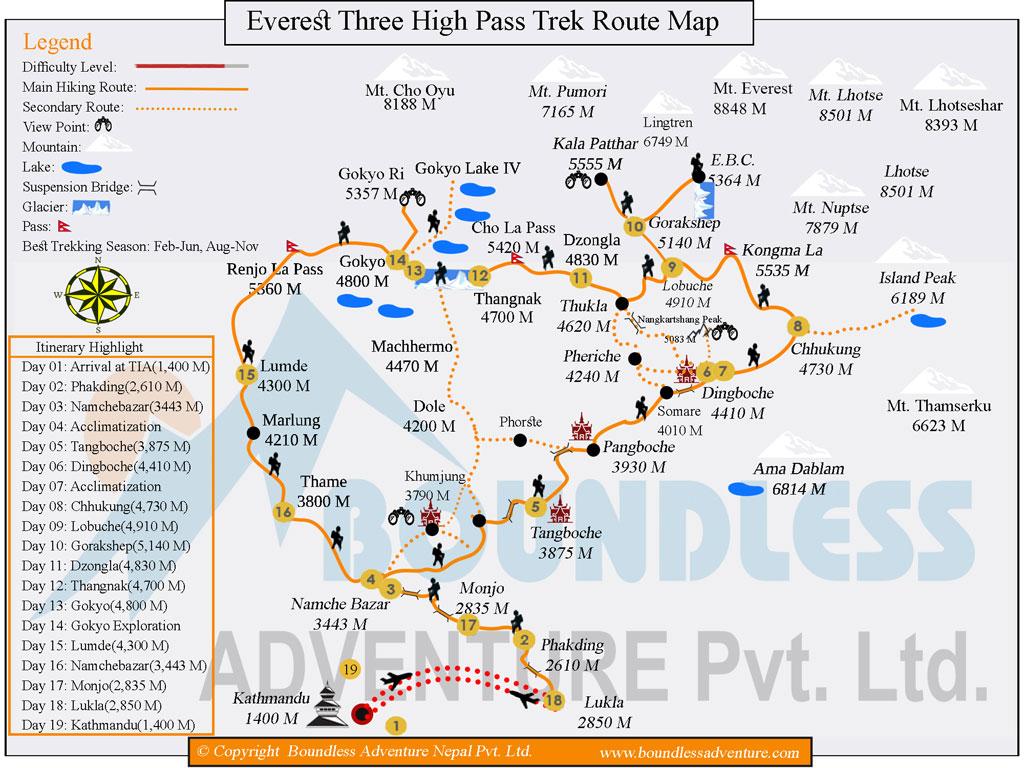
Everest three passes trek route map
Everest three passes trek route map illustrates detailed information about the significant areas' trails, landmarks, and elevation. On the left-hand side of the map, there…

- Best Hikes In The World
- Appalachian Trail
- European Hikes
- Nepal Hikes
- Patagonia Hikes
- See All Hikes
- Mount Kenya
- Mount Kilimanjaro
- Mount Toubkal
- See All Mountains
- South Africa
- New Zealand
- Switzerland
- United Kingdom
- Packing Lists
Kanchenjunga Base Camp Trek – Hike To Kanchenjunga
Asia , Nepal
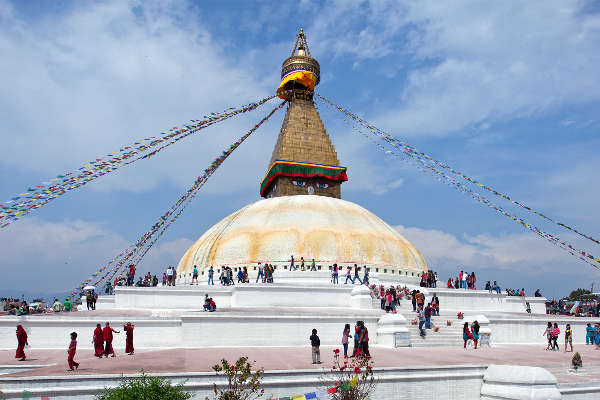
The Kanchenjunga Base Camp Trek provides unsurpassed views of snow-capped mountains. The forests of rhododendrons are also enchanting and there is much wildlife to be seen. The area is one of 200 recognised by the World Wildlife Fund as a global ecoregion – one of the Earth’s most biologically outstanding habitats. A quarter of Nepal’s red pandas live in this region.
On this page, you will find a comprehensive and impartial guide to the Kanchenjunga Base Camp trek.
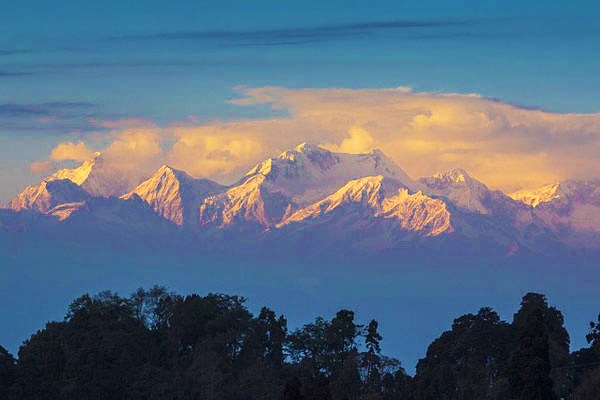
Kanchenjunga Base Camp Hike
Kanchenjunga, meaning “five great treasure houses of the snow,” is the third-highest mountain in the world and the second highest in Nepal. Until 1856, it was believed to be the highest of all.
The Kanchenjunga hike is one of the longest treks in Nepal , taking from 23 to 29 days. It is possible to make this a tea house trek, as the government has encouraged the building of infrastructure around not just Kanchenjunga but all of the Himalayas . However, in Lhonak, Kambachen and Kanchenjunga Base Camp, lodges only open when there are more trekkers.
The avalanches that can erupt on Kanchenjunga are widely believed to be the largest found anywhere in the world.
Kanchenjunga Regional Map
Kanchenjunga, one of the least-populated regions of Nepal, is on the country’s eastern border, next to India.
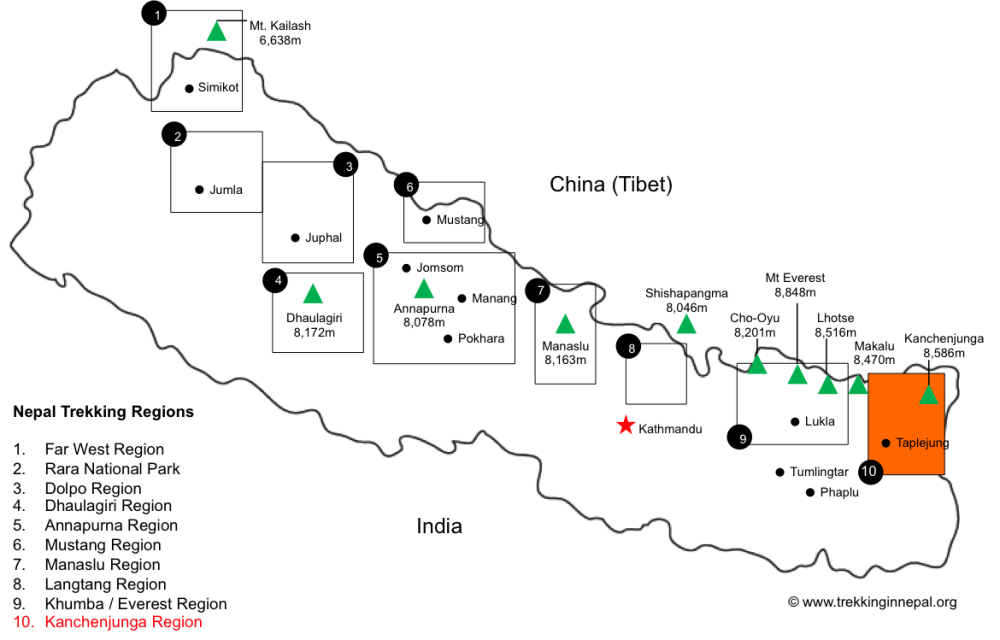
Recommended Kanchenjunga Map
We recommend the following map - A Trekking Guide to Kanchenjunga (Himalayan Travel Guides .
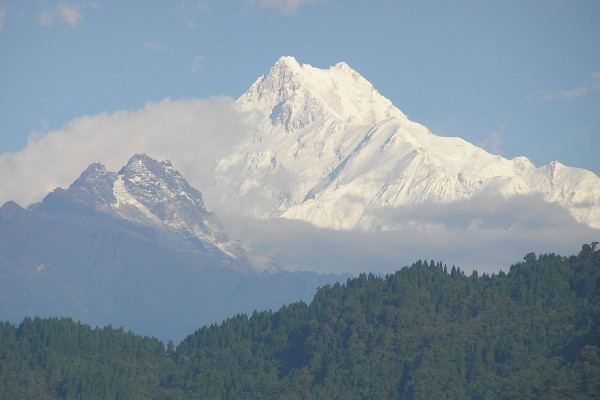
Kanchenjunga Base Camp Trek Itinerary
Below is a detailed Kanchenjunga Base Camp Trek itinerary.
Please note that there are several Kanchenjunga trek itineraries that can be done. Below, we have laid out the most popular version – 28 days, leaving from Kathmandu.
You will arrive at Kathmandu’s Tribhuvan International Airport and transfer to a hotel. Kathmandu is brimming with attractions. A major one is Boudhanath Stupa , one of the largest Buddhist shrines in the world. Another is Pashupatinath, the country’s most famous Hindu temple, where you can see sadhus (holy men) meditating, pilgrims bathing and sometimes funeral pyres ablaze. Another site is Bhaktapur Durbar Square, a medley of pagoda and shikhara-style temples surrounding a 55-window palace constructed of brick and wood.
I recommend checking out my article on the best things to do in Nepal , which includes lots of attractions in Kathmandu.
You will take an afternoon flight to Biratnagar which lasts for 40 minutes.
Another flight, this time lasting 30 minutes, transports you to Suketar Airport in Taplejung. In the afternoon, I recommend you get some exercise: an easy walk of two or three hours can be had along the ridgeline to the grazing area of Lali Kharka. You will most likely be camping from now until you return to Kathmandu.
You will traverse the hillside for a short distance and then descend to the village of Pakora on the Phawa Khola. You will cross a suspension bridge prior to a steep climb that heads for Kunjuri. After lunch, the campsite at Khesawa is not far. Here, you are presented with your first views of Kanchenjunga. The south and main summits and Kangchenjunga West, otherwise known as Yalung Kang, ought to be visible.
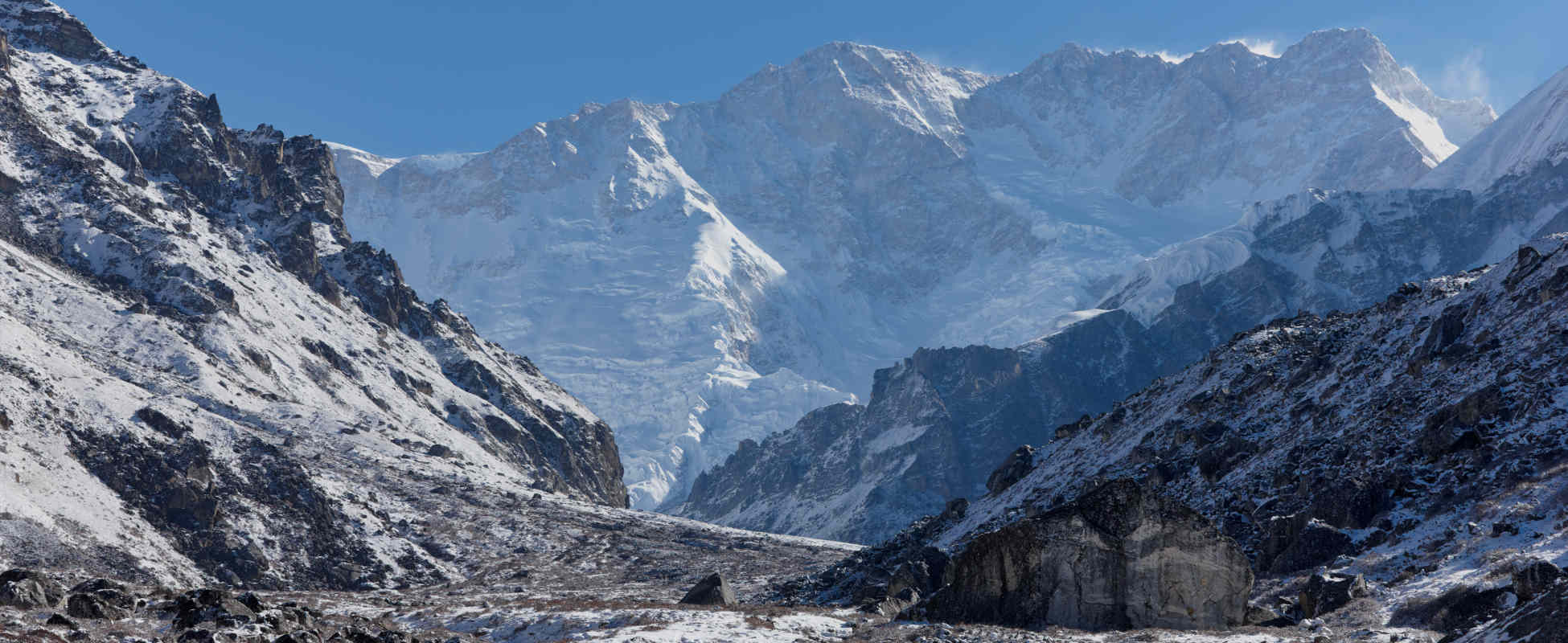
Today, you will cross steep hillside far above the Kabbeli Khola. There are ups and downs but no shortage of shady places to rest. Following lunch, you will pass the village of Anpan prior to descending to cross the Kashawa Khola. Then it is time to climb once more, through terraced fields to the village of Mamankhe.
Day 7
Walking begins with a gentle climb on a track above the Kabeli Khola. The path undulates as it passes ridges. After that, the ground is mostly flat. Eventually, the river becomes level with the trail, after which there are a few hours before Yamphudin is reached. This is the last village you will see before Ghunsa. This charming place is found below the ridge at Deurali Danda, which you will cross, and then the tent comes out.
Leaving Yamphudin, you will find yourself on a trail that ascends a steep spur, a sight to which you will grow accustomed. You will trek through pleasing forest. Lunch is in a meadow with a grand view to the north and south. A sharp drop to a river brings you to an interesting bridge over the Omje Khola and then your campsite at Chitre.
Your day begins with three hours ascending steeply to the crest of Deurali Danda, mostly through dense forest. You will arrive at a pass from which you can see Jannu. You will descend across steep and exposed areas and then go back into the beautiful forest. The path goes down the the valley of the Simjua Khola. You cross a very interesting-looking wooden bridge to reach Tortongn, where numerous rock shelters provide places to camp.
You will follow the river through more beauteous forest, with conifers giving way to rhododendrons. The valley climbs steeply and as the day progresses, trees become increasingly stunted and scattered. In the distance, you can see snow-capped giants. Just before you get to Tseram, the mammoth heights of Kabru and Rhong peaks come into sight. Tseram, where you stay, is a grazing area. The temperature at night is a reminder that you are really gaining height.
In the run-up to Ramche, the scenery is marvellous. You will pass the snout of Yalung Glacier, where there is a series of ablation valleys which make for easy walking. The highlights of this stroll are clear streams, a frozen lake and views of Kabru, Koktang and Rathong.
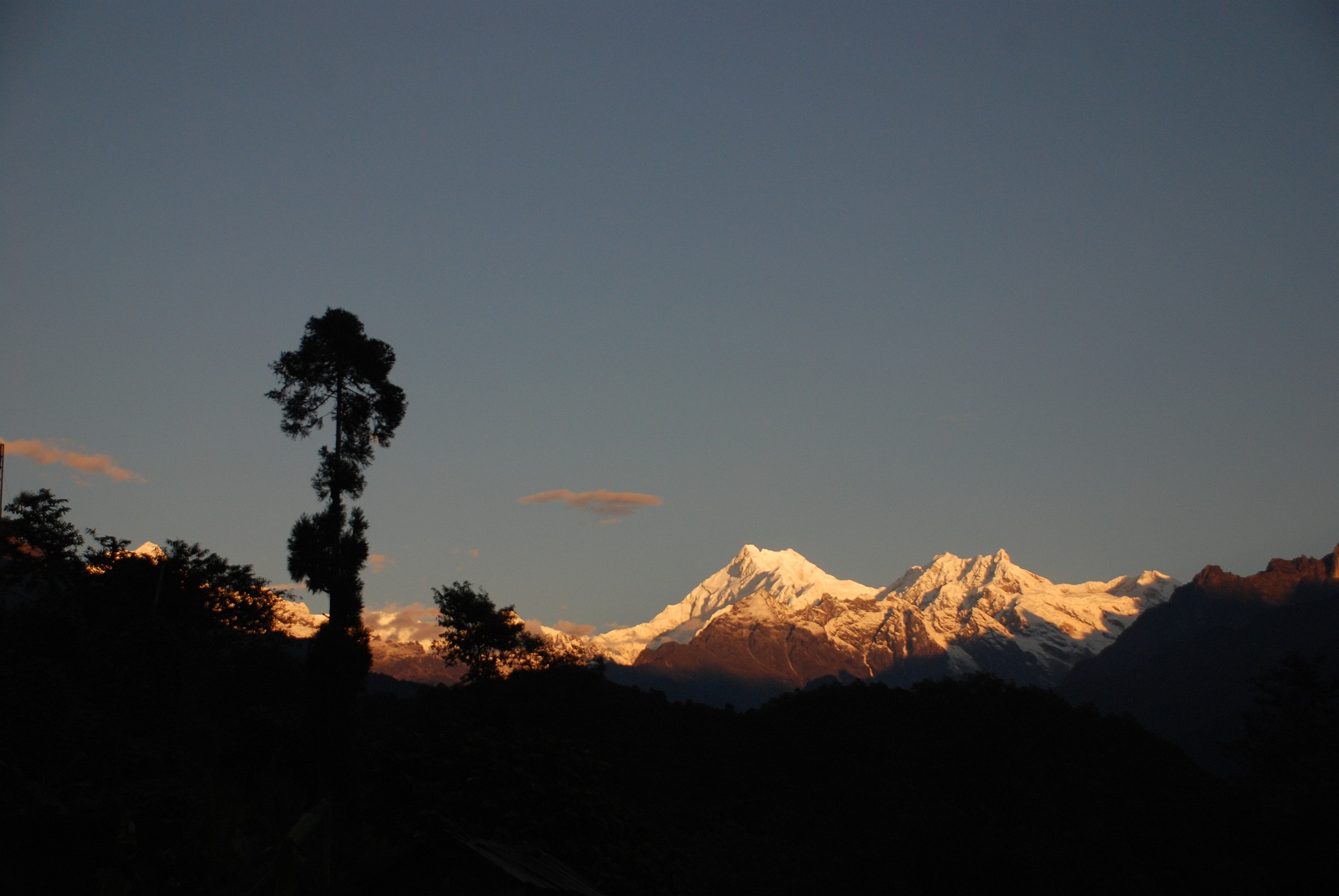
Kanchenjunga is clearly visible and stunning. You cross the Yalung Ri glacier. At Oktang, you will be on a massive ridge that forms a cirque – a steep-walled, bowl-shaped mountain basin – that is more than nine miles long and always more than 25,000 feet. Kanchenjunga’s three main summits can be observed – a breathtaking mountain panorama.
You will remain at a high altitude. Determination is called for. Crossing high passes is only possible in good weather – and with good logistics. Your abode for the night will be at Yalung Ri Base Camp.
Traversing the Yalung Glacier, the walking is good.
You will trek down a valley, then come to a pass that is rough and dangerous. After what begins as a steep climb with a number of false summits, you will reach Mirgin La. On the horizon are Everest, Jannu, Chamalung, Gyakung Kung, Lhotse and Makalu. To the south is the Terrai, a belt of marshy grasslands, savannahs, and forests that is a most worthwhile sight.
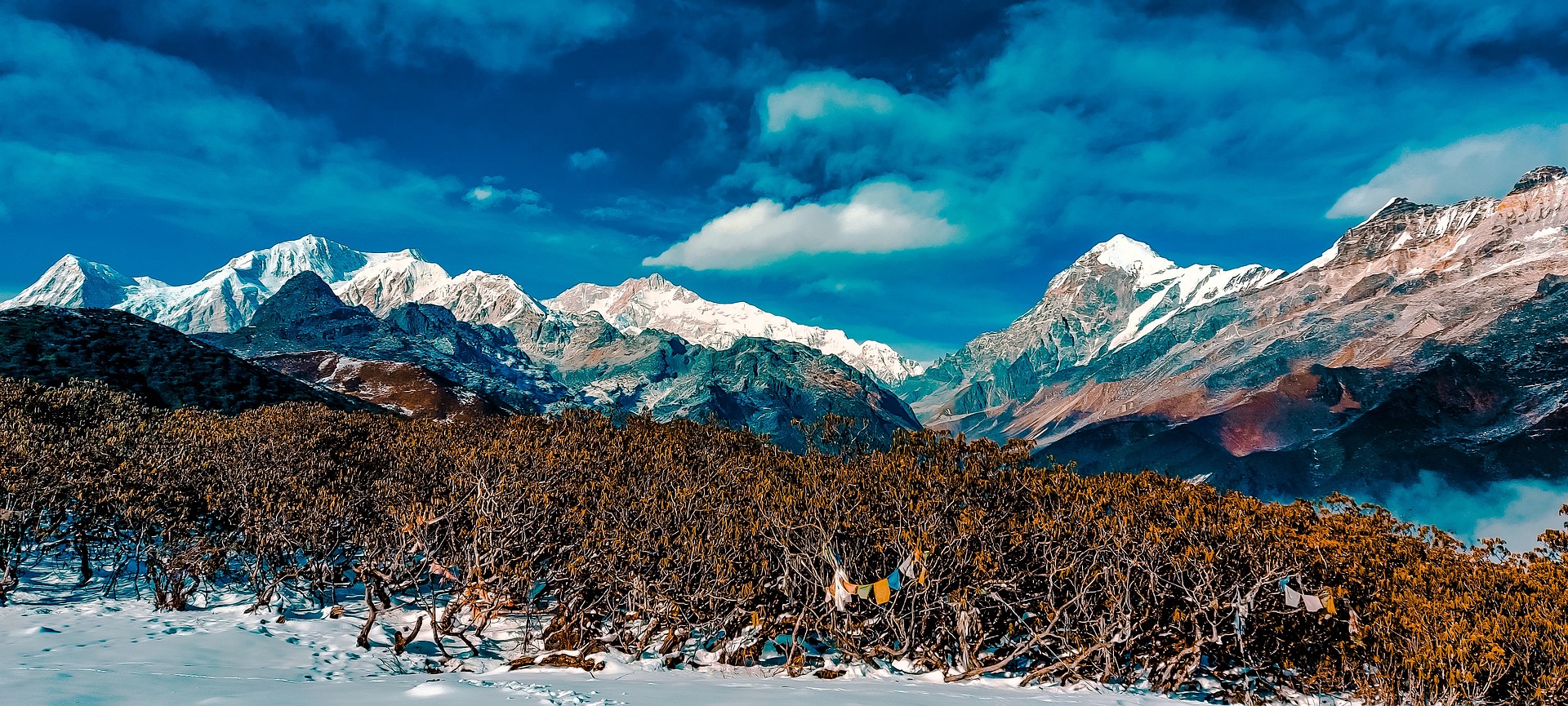
Now, you will face four more passes, although there is little by way of descent between them. After lunch, you will descend to Lamba Sumba Kharka, replete with more views of the impassive southwestern face of Jannu. From here, the going is easy, and you will follow a pleasant, forested trail that brings you to Ghumsa, a picturesque village where prayer flags flutter from wooden houses and there are two monasteries. This is a most welcome sight after so many days in the wilderness.
A local speciality is tongba, an unusual alcoholic drink: boiling water is poured into a jug or large bamboo cup filled with fermented millet seed. It is drunk through a special straw. After walking for between four and six hours, you may wish to partake of this.
South of Ghunsa Khola, the trail ascends. You will cross flood plains and emerge onto a pasture north of the river. There is a steep climb, and you will then cross a slide before descending to Lakepo. There is a short climb that puts you in the village of Kambachen.
This day is devoted to acclimatisation. A day hike will take you to Jannu Base Camp. A shorter hike will allow you to explore the vicinity of Kambachen. Or you could catch up on your laundry. Or even read a book, so long as you brought a good one.
A gentle climb through rocky fields puts you in Ramtang. You will cross northwest of the Kanchenjunga glacier to reach Lhorak, which is situated on a sandy plain close to a dry lakebed. There are beautiful mountain views in every direction. Water is scarce in Lhorak, so you should be abstemious. You will camp between boulders to protect yourself from the wind.
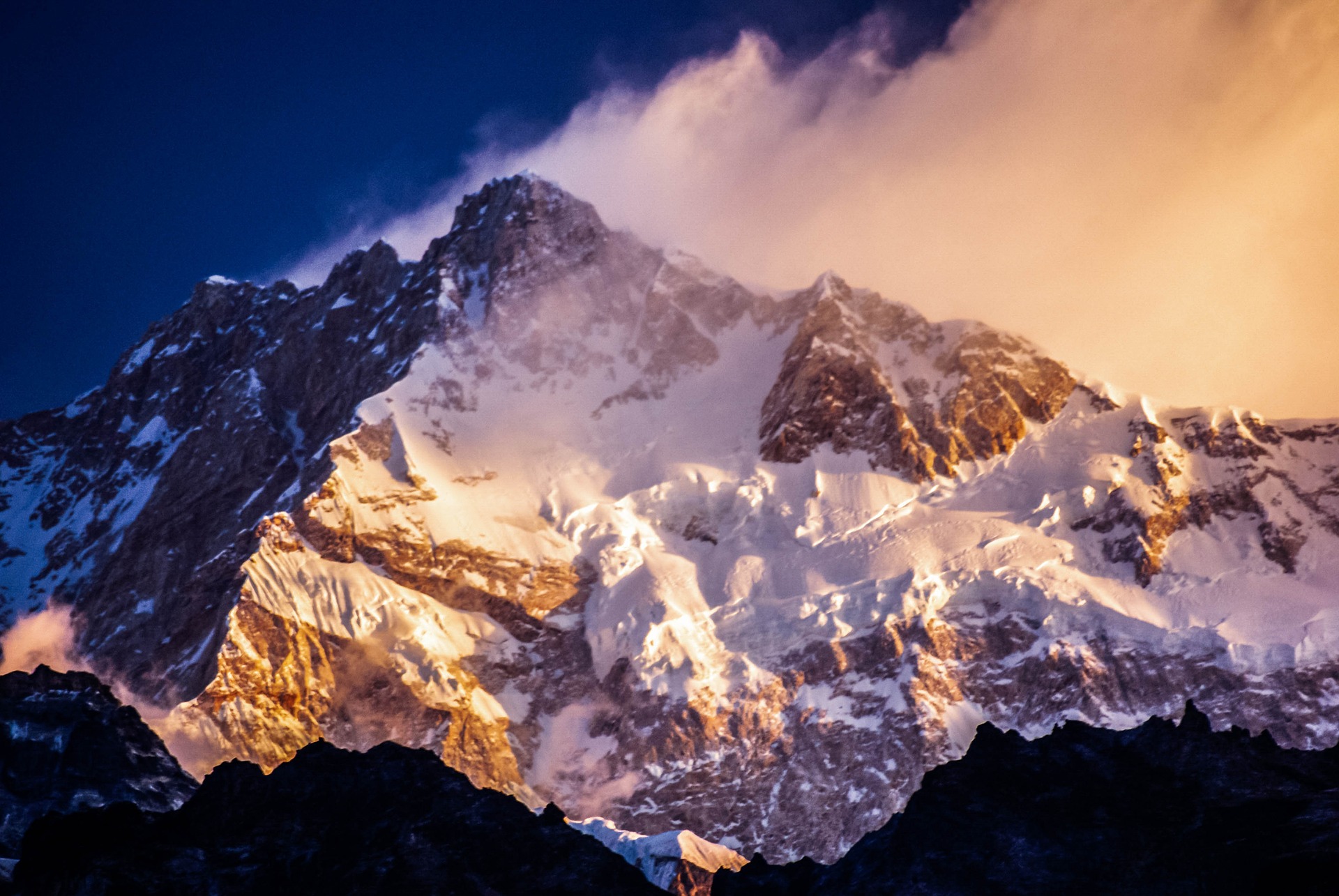
From Lhorak, the path ascends slowly through a plain but later becomes steeper. This will get you to Pang Pema, the base camp for Kanchenjunga, which is 16,900 feet up. Since Biratnagar was only 266 feet high, you will have come a long way. Here, you will get the best view of the peak of Kanchenjunga.
You will hike a few hundred feet up a ridge to the north of Pang Perma. This is a wonderful vantage point where Kanchenjunga, Tent Peak, the Twins and Wedge Peak stand before you. You will then descend to Kambachen.
You will descend once more, this time through magnificent forest. You will pass Ghunsa and, an hour later, Phole, a village split into two sections, one of which is for Tibetan refugees. After that is Yangswa, where you will camp for the night.
Today sees more lovely forest which soon turns into steep, grassy hillside. It is there that you will find Amjilosa.
Now, you will have a short climb and then a radical descent, which consumes most of the day. Camp will be at the junction between the Tamur and Ghunsa Kholas.
You will cross the Simbu Khola, which stems from Kanchenjunga’s southern base camp. It is pleasantly warm at such a low altitude – only 4,000 feet. Cardamom grows freely in this moist and shaded forest. You will cross a goodly number of small tributary streams to reach Chhirwa, a village surrounded by large boulders. Camp will be in a field before the village.
You will encounter minor valleys and picturesque villages before reaching Suketar Airport late in the afternoon.
Flying from Taplejung , you will have a final glimpse of the mountains with which you are now rather more familiar.
You will return to Kathmandu.
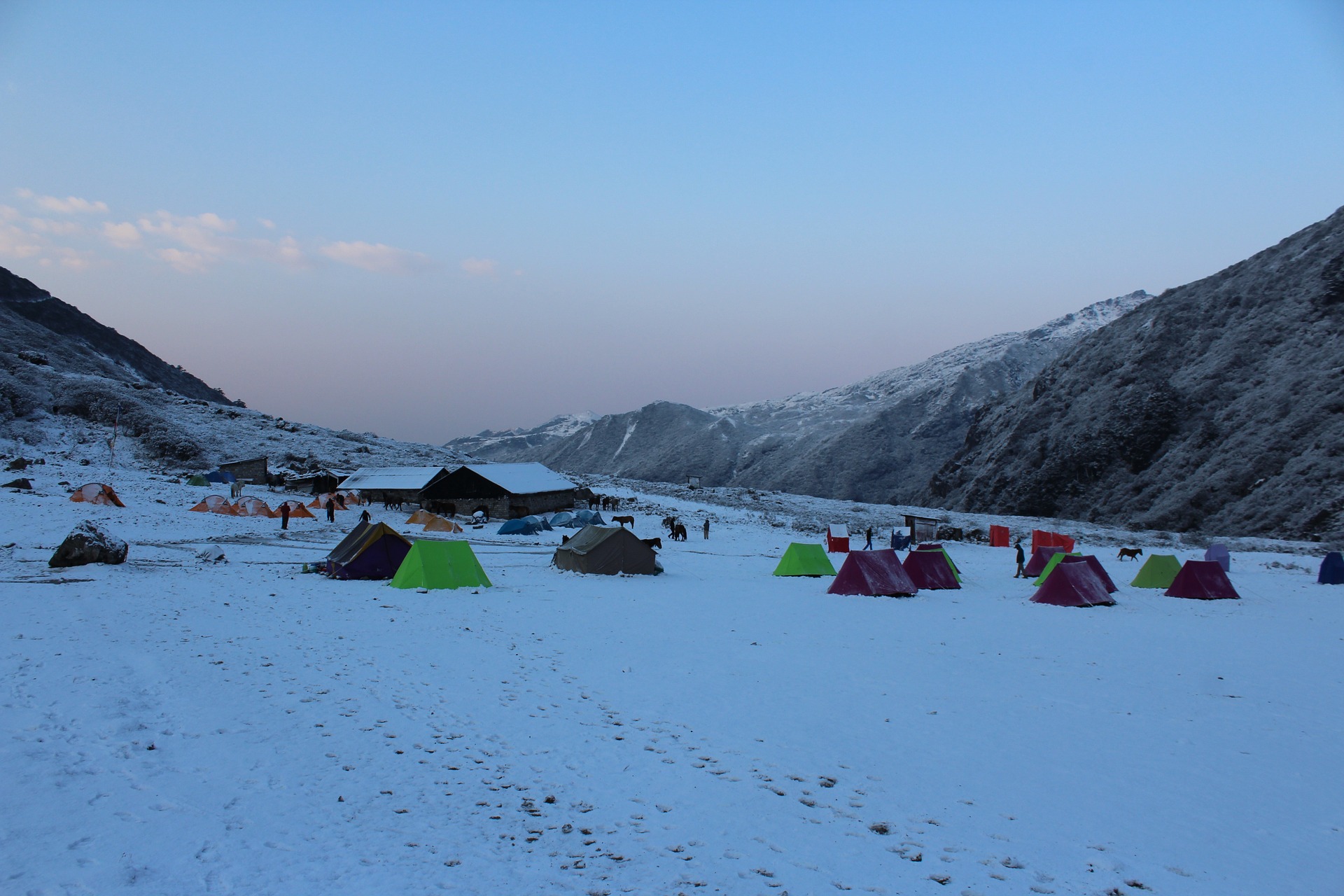
Kanchenjunga Base Camp Hike FAQ
How much does the kanchenjunga base camp trek cost.
Costs for the Kanchenjunga Base Camp trek tend to be above $5,000, but there are some Nepal trekking companies who will run the trek for as little as $3,000.
Are permits required for the Kanchenjunga Base Camp trek?
Yes, a permit is required for the Kanchenjunga Base Camp Trek (a restricted trekking region) which costs $10 per person per week. This obviates the need for a Trekkers Information Management System card. There must be at least two trekkers in your party and a registered guide who will cost roughly $35 a day. You also must pay for entrance to the Kanchenjunga National Park which costs about $20.
When is the best time to trek Kanchenjunga?
The best time to trek Kanchenjunga are autumn and spring. Fall/Autumn is from September to November and is the best time for Nepal Trekking in general, while spring is from March to May.
Is altitude sickness a risk on the Kanchenjunga Base Camp hike?
Yes, there is some risk of altitude sickness on the Kanchenjunga Base Camp trek because it ascends to some high altitude points. At its highest point, Pangpema, you will reach an altitude of 5,030 meters (16,500 feet). There are steep sections on this trek where you will ascend very rapidly. It is important to have a clear understanding of the risks associated with high altitude trekking and how the body acclimatises to high altitudes .
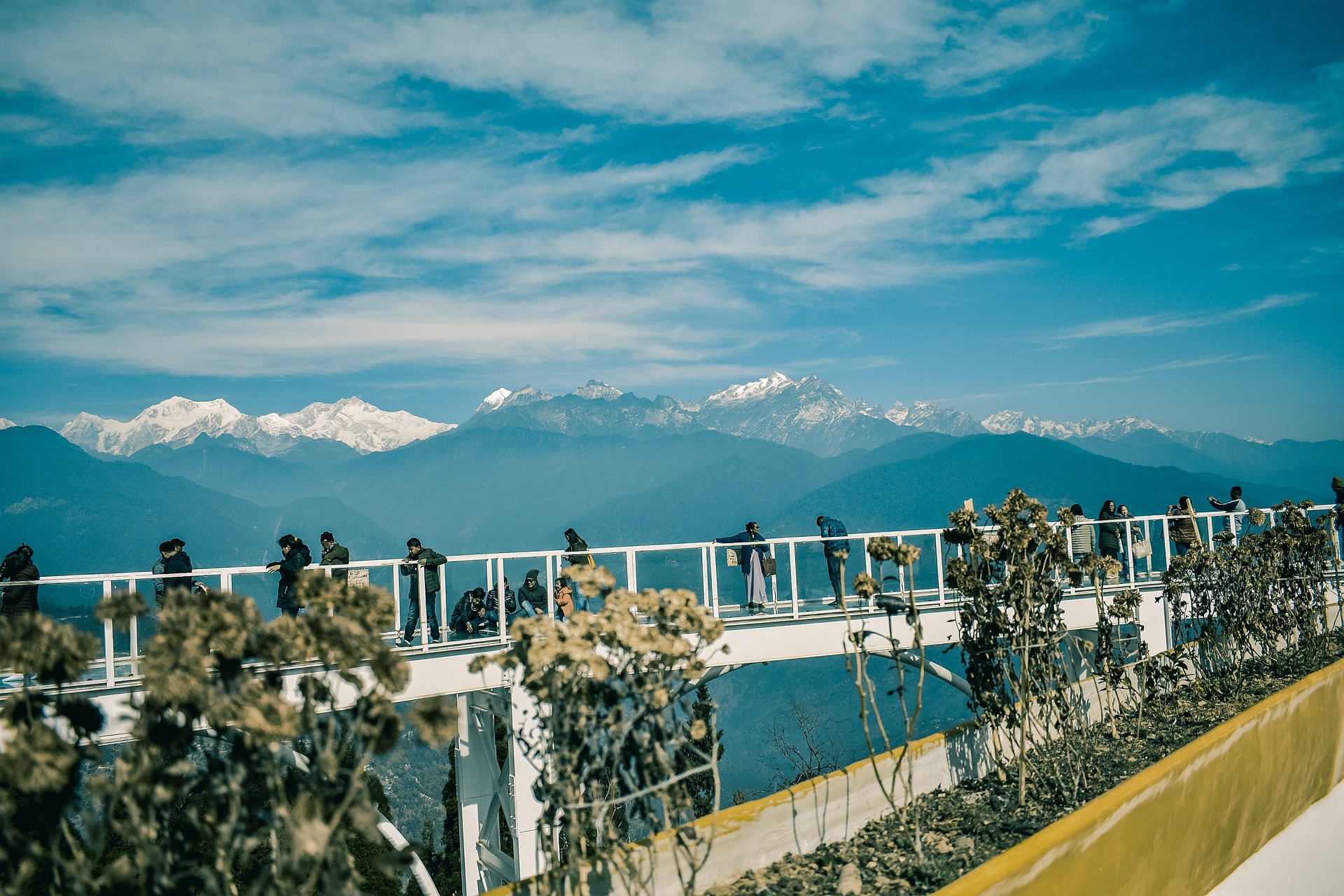
How difficult is the hike to Kanchenjunga Base Camp?
The Kanchenjunga Base Camp Trek is challenging. It is one of the longest treks in Nepal and requires constant hiking for over 3 weeks. You will need a good level of fitness and determination. There are some very steep sections and high-altitude points along the route that also make the trek a strenuous one.
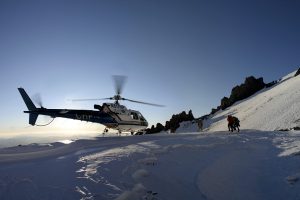
Do I need insurance for the Kanchenjunga Base Camp Trek?
I recommend you get insurance coverage for the Kanchenjunga Base Camp hike. If an accident or incident should occur that requires immediate medical assistance and evacuation, you will most definitely want hiking insurance that can cover the costs of air ambulance and treatment.
Make sure you have trekking insurance for Nepal that covers you for any travel related risks, like lost, stolen, damaged or delayed baggage, interruptions and flight delays and tour operators' default.
Are there any recommended guidebooks for Kanchenjunga?
Yes, there are a few Kanchenjunga guidebooks that we highly recommend.
In terms of guidebooks, we recommend A Trekking Guide to the Nepal Himalaya: Everest, Annapurna, Langtang, Ganesh, Manaslu & Tsum, Rolwaling, Dolpo, Kangchenjunga, Makalu, West Nepal by Sian Pritchard-Jones, Bob Gibbons and the Himalayan Map House.
There are dozens of books about the Kanchenjunga region as well. For instance, there's Living on the Edge: The Winter Ascent of Kanchenjunga by Cherie Bremer-Kamp. Kanchenjunga gets a mention in Do What Thou Wilt: A Life of Aleister Crowley by Lawrence Sutin. In his novel, A Movable Feast , Hemingway described Crowley, an occultist, as the most evil man in the world; to be mentioned in a book about him is deeply flattering - not that a mountain will feel it.
See our recommended library of Nepal books and guidebooks for more options.
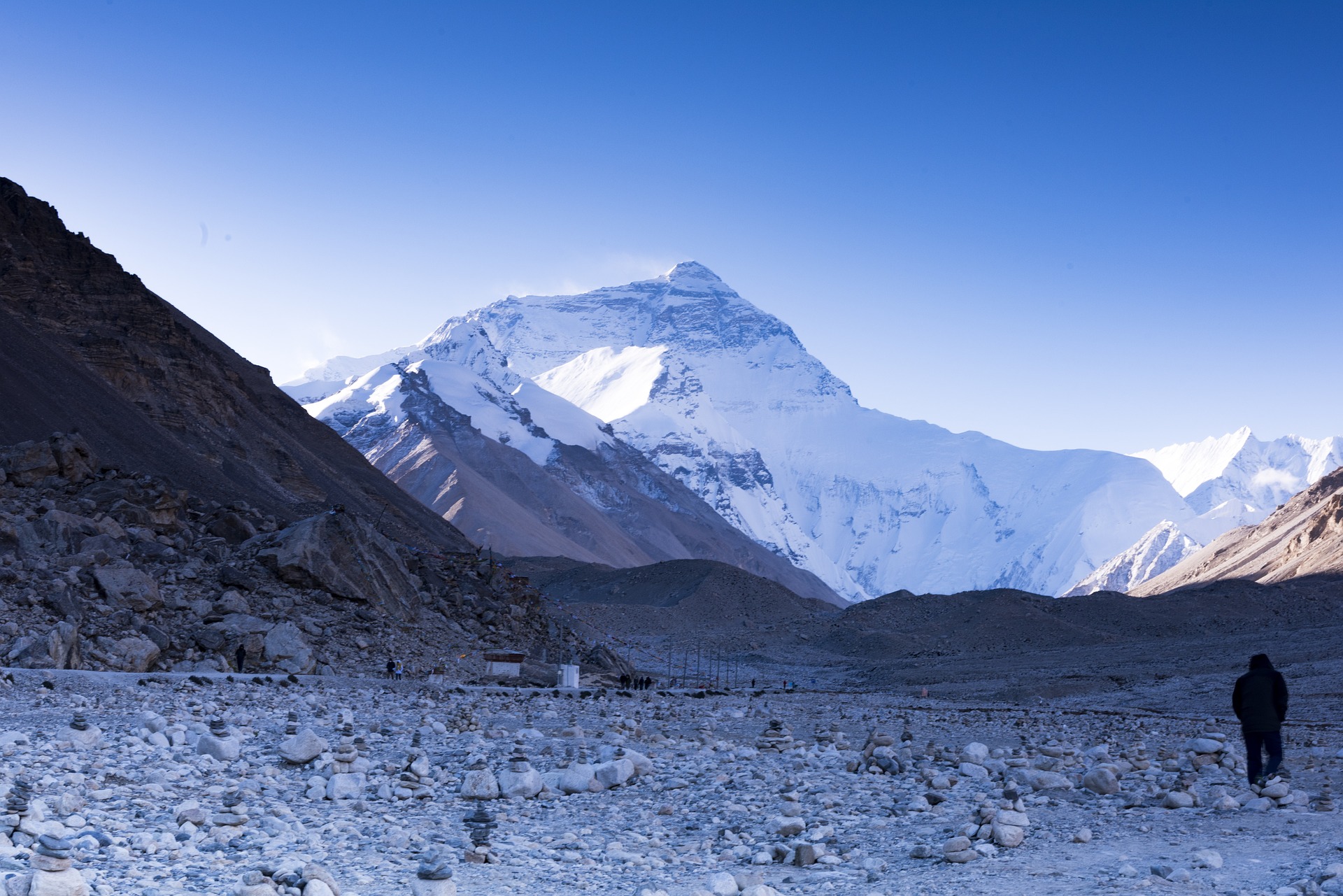
Are there are other Nepal trekking routes?
If the Kanchenjunga Base Camp Trek isn't your cup of tea, you can always try your hand at the Everest Base Camp hike , the Langtang Valley hike or the Manaslu Circuit hike . These treks are considered some of the best hikes in Nepal .
Continue browsing
See more information on Nepal . Or check out these other Nepal hiking articles:
- Short Treks in Nepal
- Easy Hikes in Nepal
- Food and Water on Everest Treks
- Royal Trail
- Kala Patthar Trekking Guide
- Rara Lake Hike
- Annapurna Circuit Trail
- Island Peak Climb
- Mera Peak Climb
- Manaslu Circuit Hike
- Helambu Trail
- Mustang Circuit Trek
- Gokyo Lakes Trekking Guide
- Makalu Base Camp Trek
- Gosainkunda Trail
- Limi Valley Hike
About the author
Mark Whitman
Mark has trekked extensively in Asia, Europe, South America and Africa. He founded Mountain IQ in 2014 with the sole aim to be the best online information portal to some of the most popular mountain destinations around the world. When not writing for Mountain IQ, Mark is out exploring the outdoors with his wife!
Leave a Reply
Your email address will not be published. Required fields are marked
We work with local guides to offer great value adventures at unbeatable prices
- Everest Base Camp Trek
- Everest Base Camp - Chola Pass Via Gokyo Trek
- Everest Panorama Trek
- Everest Base Camp Trek with Helicopter Return
- Pikey Peak Trek
- Everest Three Passes Trek
- Everest Gokyo Ri Trek
- Rolwaling Trek
- Annapurna Base Camp Trek
- Annapurna Circuit Trek
- Mardi Himal Base Camp Trek
- Annapurna Panorama View Trek
- Annapurna Three High Passes Trek
- Mardi Himal Trek
- Ghorepani Poon Hill Trek
- Gosaikunda Trek - 8 Days
- Langtang Trek - 8 Days
- Gosaikunda Helicopter Tour
- Langtang Triangle Trek
- Langtang Gosainkunda Helambu Trek
- Tamang Heritage Trek
- Helambu Trek 6 Days
- Gosainkunda Pilgrimage Trek
- Buddhist Pilgrimage Tour
- Muktinath Pilgrimage Trek
- Kanchenjunga Base Camp Trek
- Kanchenjunga Circuit Trek
- Manaslu Circuit Trek
- Manaslu Circuit Tsum Valley Trek
- Makalu Base Camp Trek
- Rara Lake Trek
- Naar Phu Kangla Pass Trek
- Machhapuchhre Model Trek
- Upper Dolpo Jomsom Trek
- Upper Mustang Trek
- Kanchenjunga Olangchung Gola Trek
- Mustang Teri La Pass Trek
- Upper Dolpo Trek
- Lower Dolpo Trek
- Makalu Ice Col Trekking
- Mustang Tiji Festival Trek
- Mera Peak with Amphu Lapcha Pass Trek
- Mahabharat Rhododendron Trek
- Dhaulagiri Trek
- Bhairab Kunda Trek
- Ganesh Himal Trek
- Rupina La Pass Trek
- Mount Everest Expedition
- Amadablam Expedition - 6812 M
- Manaslu Expedition - 8163m
- Mt- Saribung Expedition - 6346 M
- Mera Peak Climbing - 6470m
- Island Peak Climbing - EBC
- Lobuje Peak Climbing- 6,119 M
- Larkya Peak Climbing- 6,219 M
- Pisang Peak Climbing - 6,091 M
- Kusum Kangaru Climbing - 6,369 M
- Kwangde Re Climbing - 6011m
- Chulu West Peak Climbing - 6,419M
- Ramdung Peak Climbing - 5925m
- Sports Tourism
- Jungle Safari
- Everest Base Camp Helicopter Tour
- Mardi Himal Helicopter Tour
- Namobuddha Tour
- Privacy Policy
- Follow Us On
- 9779851014405
Kanchenjunga Base Camp Trek Guide 2024 - Cost, Map, Itinerary
25th march 2022.

Table of Contents
Planning for Kanchenjunga Base Camp Trek in Nepal - Know about Kanchenjunga Base Camp Trek Guide 2023 - Cost, Map, Itinerary, Permit Kanchenjunga , the third-highest peak in the world at 8,586m, is an exciting option for anyone wanting to trek a route that remains relatively undiscovered. The number of trekkers allowed on the route has long been restricted by the government to preserve the natural beauty and diverse flora and fauna. There is more than one way to do the trek with long and short options, as well as arduous or simple routes and we can cater to whichever our client desires. The advertised 19-day trek is on the long and more adventurous side and we visit both the northern and southern base camps over the high pass at Sele Le.
To trek, this route special permits must be obtained through a registered company and all trekkers must be accompanied by a local guide and porter Peace Nepal Treks are here to ensure all those needs are taken care of. How do I prepare for the Kanchenjunga Base Camp Trek ? We have designed this 19-day itinerary for someone with a good level of fitness who can walk 7-9 hours daily. Due to the remote nature of the trek and lack of access to medical facilities, we advise those interested to train by carrying backpacks or around 8kgs on long walks while cycling and swimming will also help prepare. Our trek is designed to include a few days for acclimatization to the altitude and we suggest everyone walks slowly, drinks 2 liters of water each day, and eats plenty to maintain their health.
Kanchenjunga Base Camp Trek cost
Due to the restricted nature of the trek, the cost may be higher than more well-trodden routes. Listed below is everything included; there is more on the lodge and meal quality below. 01, Local guide: Daily wages and his insurance/meals and trekking equipment 02, Local porter: Daily wages and his insurance/meals and trekking equipment 03, Flight ticket: Kathmandu to Bhadrapur guest (return) 04, Flight ticket: Kathmandu to Bhadrapur local guide and porter (return) 05, Transportation: Bhadrapur to Taplejung by local jeep 06, Accommodation: Lodge accommodation 07, Special permit fees: Restricted permit fees for 2 weeks 08, Conservation fees: Kanchenjunga conservation area entry fees 09, TIMS CARD fees: Trekking Management System fees 10, Transportation: Taplejung to Bhadrapur by local jeep Note: During the trek, meals are paid for locally by the client. Your guide will help with understanding menus if needed. We advise a budget of around USD $30 each day per person to cover 3 daily meals. In total, the cost will be around USD 1475 to 1775 per person.
Best time for Kanchenjunga Base Camp Trek
The weather will play a huge role in the enjoyment of your trek, so it is important to choose the best time. Of course, the weather in the mountains can be unpredictable and over a long trek like this one, clients should always be prepared for some inclement weather conditions. In general spring (March/April & May) and autumn (September to early December) offer the best conditions and most moderate temperatures. However, it is likely to be cool at night. We strongly advise avoiding the monsoon season for this trek as the trekking trail will be slippery meaning a high risk of accidents and roadblocks. It is not possible to trek this route in winter due to the heavy snowfall.
Kanchenjunga Base Camp Trek permit
Kanchenjunga Trek is one of the restricted remote trekking areas of Nepal. A person who is planning to go trekking with a local guide and porter through the local trekking agencies, needs the special permit fees, Kanchenjunga Conservation entry fees, and the TIMS CARD from the Nepal government.
Here is the cost of Kanchenjunga permit fees
01, Kanchenjunga special permit fees are USD 10 for a week 02, Kanchenjunga conservation entry fees are USD $30 per person 03, TIMS CARD (Trekking Information Management System) is USD $10 per person
Accommodation and meals
This trek involves lodge accommodation however one should not expect the same quality of lodge that you may have experienced on other treks in Nepal such as Annapurna or Everest. Here the lodges will be basic with simple bathrooms. The meals are Nepali rice Dhal Bhat/vegetables/noodles/thukpa/Tibetan bread etc. We recommend using boiled water or water purifying tablets during the trek and advise against using bottled water and plastic utensils.
We always suggest carrying your own first aid kits and any medicine from your home country because the trek is remote with limited access to medical facilities. Our guides are trained in mountain first aid and will carry a basic first aid kit for emergencies.
What to bring and pack for this Trek?
Before traveling anywhere, you should check the necessary items and be fully prepared. Clothing items, accessories, toiletries & medicines should all be on your packing list. If you are happy to buy clothing/trekking gear in Nepal then it will likely be cheaper, but it may not be as reliable. Renting equipment is also possible if you wish.
Kanchenjunga Base Camp Trek Start and Ending
There are a few different ways to travel to Kanchenjunga Trek. Our Itinerary starts in Kathmandu and we take a plane to Bhadrapur before a jeep ride to Taplung where our walking both starts and ends. We then take the same route back, although there is also an option to drive the full route from Taplejung to Kathmandu, which is a full day.
Travel Document and Cash
Please ensure your passport has at least 6 months to run and that a valid visa is obtained before departure. We also advise that you carry a few passport-size pictures, a copy of your passport and travel insurance (which should cover emergency helicopter evacuation), and enough cash for your meals (about USD $500 to 600 per person for 19 days).
Challenges of Kanchenjunga base camp trek
As stated, the Kanchenjunga base camp i s a challenging adventure because of its diverse landscapes, long walking days, high-altitude passes, and unpredictable weather. Combine that with the basic meals and accommodation and this becomes a trek unsuitable for someone without some previous trekking experience. As such we do not recommend this trek for first-time trekkers. Due to the restricted nature of the area, it is also not possible to take on this trek as a solo traveler.
Recent From Blogs

11th Jan, 2022

30th Jul, 2013

23rd Mar, 2016

2nd Jul, 2013

10th May, 2016

13th Jan, 2022

2nd May, 2016

23rd Feb, 2017

19th Jun, 2013

11th Aug, 2015

10th Jan, 2022

23rd Oct, 2022

18th Nov, 2022

21st Nov, 2022

22nd Nov, 2022

23rd Nov, 2022

25th Nov, 2022

28th Nov, 2022

29th Nov, 2022

3rd Dec, 2022

7th Dec, 2022

8th Dec, 2022

16th Dec, 2022

30th Dec, 2022

5th Jan, 2023
6th Jan, 2023

10th Jan, 2023

8th May, 2023

12th May, 2023

14th May, 2023

6th Jul, 2023

18th Oct, 2023

1st Feb, 2024

7th Feb, 2024

13th Feb, 2024

26th Feb, 2024

10th Apr, 2024

14th May, 2024

22nd May, 2024

2nd Jun, 2024

22nd Jun, 2024

17th Jul, 2024
Our representatives, adrian mula.
- Mobile: +61-414527610
- Email: [email protected] Lisa Shuck Email: [email protected]
Robert and Arnica Reurekas
- Boterstraat 60, 3111 ND Schiedam
- [email protected] Paul Hogenbirk Email: [email protected] Remy Van Meel Email: [email protected]
Patrick Keulens Helmond
- Phone: 0031-613639901
- Email: [email protected]
Richard Kirtley
- Phone: +44 (0) 7891 072 550
- Email: [email protected] Alan Curr Email: [email protected]
Chang Jong Kwon
- Phone and whatsApp: 6013-8086065
- Email: [email protected]
Lim Tianshun
- Email: [email protected]
Switzerland
Mark eversham.
- Phone: 0041 78 608 1713
We Are Associated
Find & follow us on.
© 2011 - 2024 All rights reserved. Peace Nepal Treks.
We use cookies to improve user experience and analyze website traffic. By clicking Accept Cookies you agree to our website's Privacy and Cookies Policy.
Regd. No: 175840/074/075, Tourism License No: 2432

Run and Managed by:
Local tourism experts & sherpas of nepal.

- Nepal Trekking
Kanchenjunga Base Camp Trek
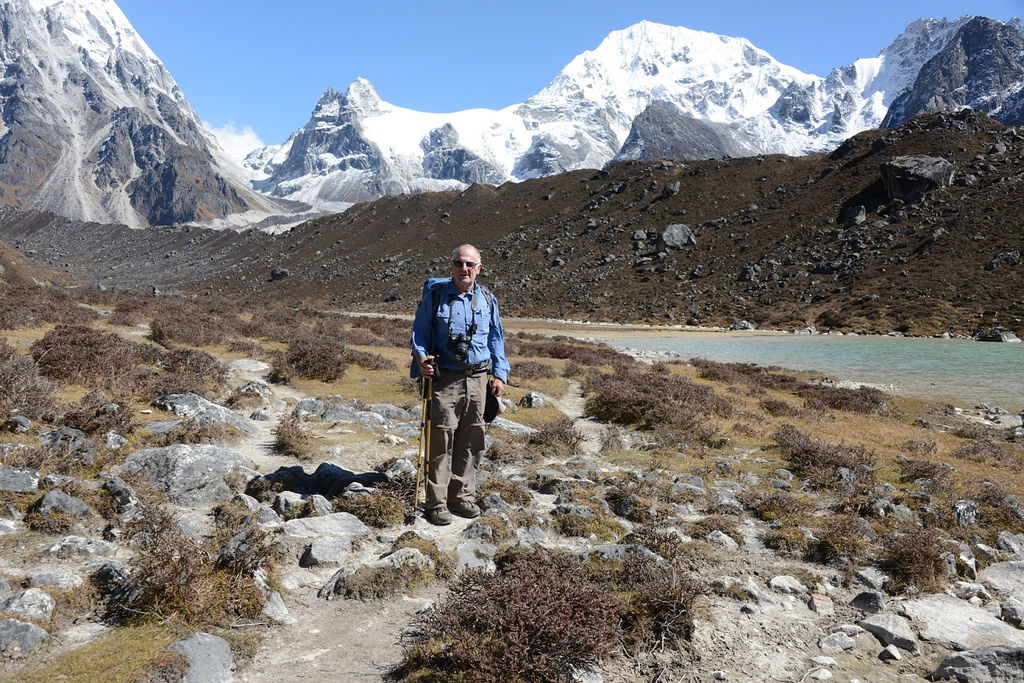
- Trip Code: N-OBT-152
- Destination: Nepal
- Season: Oct, Nov, March, April, May
- Max Altitude: Alt 5388 meters/ 17673 feet
- Trip Starts/Ends: Kathmandu/Kathmandu
- Transportation: Private Car. Public Bus & Flight
- Accomodation: Hotel in Kathmandu, best available local hotel in Biratnagar, Phidim, Birtamod & normal tea house in Trekking
- Trip Grade: Stratenous
- Trip Overview
Kanchenjunga Base Camp Trek is an advisable walking excursion because of its visiting base camps of world’s third tallest mountain ‘Kanchenjunga’ which is elevated 8586 meters/ 28169 feet from sea level. Mount Kanchenjunga is located in the eastern corner of Nepal, borderline with India.
Kanchenjunga Base Camp trekking offers a unique opportunity to explore incredibly varied landscape beneath the Mount Kanchenjunga with following of traditional rural lifestyle untouched by the outside world. This vibrant route has been only opened to travel for foreigners since 1988.
The gateway of Kanchenjunga trek is Suketar can be accessible by road and flight. As the direct flight to Suketar from Kathmandu is infrequent and mostly disturbed by cancel due to weather, it is suggested to take 45 minutes of flight from Kathmandu to Bhadrapur then take a drive to Suketar with one day night halt at Birtamod or at Ilam.
From Suketar the trail follows the glinting Tamor River for the first trekking days that allows plenty of time to visit the village and interact with local people. Then it gradually climbs along the Ghunsa River passing forests. In Ghunsa, a Sherpa village marked with prayer flags and gompa (monastery), the route joins with another trail from Kanchenjunga’s southern flank.
Then the trail moves upward to Pangpema, the northern base camp of Kanchenjunga. Upon reaching base camp the short hike up the ridge offers astonishing views of Mt. Kanchenjunga and its surrounding peaks.
The return trip from Pangpema crosses mountain passes between Yalung Glacier and Kanchenjunga Glacier that takes to visit the southern base camp of Kanchenjunga at Ramche. At Ramche you encounter the gigantic Yalung Glacier enclosed by rocky crags and ice precipice.
Visiting the Yalung Glacier, the following days will be retracing your footsteps to Suketar by passing through rhododendron thickets, mountainside villages, waterfalls, and terrace fields.
In Suketar the trekking ends and you back to Kathmandu firstly by drive from Suketar to Bhadrapur with the one-night stopover at Birtamod then flight from Bhadrapur to Kathmandu.
Kanchenjunga Base Camp Trek- Note:
Kanchenjunga Base Camp Trek- 28 days is the standard trip. However, the itinerary is likely to be customized. Thus, please let us know if you have any request to change the itinerary.
Day 1: Arrival in Kathmandu Airport.
Our tour officer will be receiving you at Tribhuvan International airport, Kathmandu. He/She will be displaying play card with your name written in it outside the airport terminal. He will meet, greet and welcome you with auspicious garland and escort you to your respective hotel by our private tourist vehicle. At the hotel, he will assist you to check in and do a pre-trip meeting with you. You will be briefed about your overall program, introduced your guide and clear your questions/queries if any. During the meeting please clear the due balance and handover a readable copy of your travel insurance policy. Overnight at hotel.
Day 2: Flight from Kathmandu to Bhadrapur. Flight time 45 minutes. Drive from Bhadrapur to Birtamod. Driving 40 minutes.
After breakfast, you have time for few hours for the preparation of trekking. Our trekking guide will meet you at the hotel. Then you will be transferred to the domestic terminal of Kathmandu airport. Then you board a flight from Kathmandu to Bhadrapur. It’s forty-five minutes flight. After you land at Bhadrapur airport you will drive to Birtamod. Birtamod is an eastern city of Nepal on the flat terrain just 300 meters from sea level. Today your night halt will be at the guest house in Birtamod. Overnight at guest house.
Day 3: Drive from Birtamod to Suketar. Driving 8 to 10 hours.
Early in the morning, you catch up public bus goes directly to Suketar. This is a long drive. After you reach Ilam it becomes very interesting looking over tea states. The road passes through villages with terraced fields. You will feel an amazing experience of changing the landscape from flat to mountain terrain. In the evening you will arrive at Suketar, the gateway of Kanchenjunga trekking. Overnight guesthouse.
Day 4: Trekking from Suketar to Mitlung (Alt. 921m/ 3021ft). Walking 4:30 hours.
After breakfast, your trekking journey starts to Mitlung. Today the trail is totally downhill to Mitlung. After crossing Hangdewa River the trail follows riverbank of Tamor River. After few hours of walking passing small villages and terraced fields, you will make another descent of approx 400m through the muddy trail that takes you to Mitlung, the beautiful village of Limbu people. Overnight at Tea House.
Day 5: Trekking from Mitlung to Chirwa (Alt. 1270m/ 4166ft). Walking 6 hours.
Leaving Mitlung the trail is up and down until reaching Sinwa village. From Sinwa it is again downhill all the way to Tawa village. Afterward, it ascends uphill and crosses suspension bridge that links Thiwa village. Eventually passing through terraced farms and surrounding ridges you arrive at another beautiful market village of Chirwa. Here you find some teahouses/lodges and retail shops. Overnight at Tea House.
Day 6: Trekking from Chirwa to Sukathum (Alt. 1576m/ 5169ft). Walking 5:30 hours.
From Chirwa you follow the route that ascends in the beginning then drops down to the Tamur River. The trail crosses on a suspension bridge just above the confluence with the Ghunsa Stream. On the east side of the river, you will see the village of Helok. From the suspension bridge, it’s a short walk along the steep and narrow Ghunsa valley to the Sakathum village. This village has the helipad and some tea shops. Overnight at Tea House.
Day 7: Trekking from Sukathum to Amjilosa (Alt. 2308m/ 7570ft). Walking 6 hours.
Today you start on the narrow trail that winds along the north bank of the river. After few ups and downs beside the river, you will reach some stone steps that scramble high above the river to a waterfall and the small village of Ghaiyabari. Here the incline becomes gentler as you follow an exposed and precarious trail above steep grassy slopes to a crest at 2530m. Finally, the trail descends to Amjilosa, Tibetan village with several tea houses and camp sites. Overnight at Tea House.
Day 8: Trekking from Amjilosa to Gyabla (Alt. 2730m/ 8954ft). Walking 4:30 hours.
After breakfast, you continue to climb along the Ghunsa valley. You will feel the mountains are getting closer as you climb to a flat ridge and meander through a forest of bamboo, rhododendron and brown oaks, passing scattered pastures and waterfalls. Then you will come to a large cascade on the Ghunsa Khola. Here the trail begins a grinding climb to the Sherpa village of Gyabla also called Chapla or Kyapra. Overnight at Tea House.
Day 9: Trekking from Gyabla to Ghunsa (Alt. 3595m/ 11792ft). Walking 7 hours.
The day starts with a steep drop into a ravine followed by an easy level stage passing through rhododendron and fir forests along the riverbank. It takes all morning to trek to the yak pastures and potato fields of Phole. Here you visit small wooden gompa (monastery) contains several old statues and cloth paintings brought here from Tibet. Above Phole the valley widens and the trail improves as you trek through fields and larch forests dipping down to the riverbed before crossing to Ghunsa, the largest village on the trek which has Buddhist prayer flags flutter over the rooftops. Overnight at Tea House.
Day 10: Acclimatization day at Ghunsa (Alt. 3595m/ 11792ft).
Now you have entered high mountain region and you must prepare your body for the increase in altitude. So it is mandatory to stay one more day in Ghunsa to reduce the risk of AMS on later stages of the trek. On a free day at Ghunsa, you can hike along the trail to Lapsang La following the Yamatari stream to a lake at the terminal moraine of the Yamatari glacier or you can stroll up to the fading gompa (monastery) above the village. For the night halt back to the tea house of Ghunsa. Overnight at Tea House.
Day 11: Trekking from Ghunsa to Kambachen (Alt.4050m/ 13284ft). Walking 6 hours.
From Ghunsa heading towards the north, the trail makes a gradual ascent through a forest of larch and juniper along the east bank of the river. After crossing a sandy, boulder-strewn floodplain the path crosses wood and stone bridge to the west side of the river t Rambuk Kharka. The hillsides become increasingly barren as you climb along the valley. Continue north past a waterfall then make a short steep ascent over a very unstable scree slope. Take it slowly here. Beyond the landslide, the trail climbs gradually then drops down to Kambachen village. Overnight at Tea House.
Day 12: Acclimatization day at Kambachen (Alt.4050m/ 13284ft).
Since you did a steep ascent on previous day you must take another rest day in Kambachen to allow your body to adjust to the elevation. From here you can have views of the peaks of Khabur (6332m) and Phole (6645m). For the best views, you climb the ridge north of the village. From here you find the peaks of Khabur, Phole, and Jannu rise over the valley like three frozen giants. Alternatively, you could try a bit of nature photography- shaggy yaks graze serenely at the bottom of the valley and herds of blue sheep roam the boulder fields on the hillsides above the river. Overnight at Tea House.
Day 13: Trekking from Kambachen to Lhonak (Alt 4780m/ 15678ft). Walking 5 hours.
Leaving Kambachen the path enters a deserted landscape marked by the icy fingers of glaciers. It climbs gradually across the scree slopes to the antoher area of pasture at Ramtang. Here you are advised to wear your warmest trekking gear to safe from the chill winds. Above Ramtang the trail runs along the lateral moraine of the Kanchenjunga glacier following the north bank of the river to a wooden bridge at the mouth of the Lhonak glacier. Sooner you will arrive at the Lhonak village that sits beside a wide, often dry lakebed, on an open sandy plain. The views from here are awesome in every direction. Overnight at Tea House.
Day 14: Trekking from Lhonak to Pangpema (Kanchenjunga North Base Camp) (Alt 5388mm/ 17673ft). Walking 4 hours.
Today is your important day of trekking to Kanchenjunga North Base Camp at Pangpema. After breakfast, you ascend gradually across the plain and follow the line of the moraine. The most stable trail climbs onto the ridge before dropping to a pair of lonely looking huts at Pang Pema. Pang Pema is the flat grassy north base camp of Kanchenjunga, the world’s third tallest mountain. After reaching Pang Pema you climb ridge of its north direction from where you can have spectacular panoramic views of Kanchenjunga, Table Shikhar, Gimmigela Chuli and also the views of Pyramid Peak and Kirat Chuli to the east. Overnight at Hut/Tea House.
Day 15: Trekking from Pangpema to Kambachen (Alt 4050 m/13284ft). Walking 6-7 hours.
The views are often more clear in the morning so you are advised to rise at dawn and hike up again the ridge for the awesome panoramic views of Kanchenjunga and its surrounding peaks. Then you retrace your path to Lhonak and continue down the valley to Ramtang and eventually to Kambachen. As usual, the descent is faster so you can get back to Kambachen in a single day. Overnight at Tea House.
Day 16: Trekking from Kambachen to Ghunsa (Alt 3595 m/11792ft). Walking 4 hours.
Today from Kambachen you trek back to Ghunsa following the familiar trail that used earlier for up. You will pass through beautiful forest line on the way with a backdrop of impressive mountain scenery. From Kambachen to Ghunsa it takes you just four hours of walking. Reaching Ghunsa you will check in on the same teahouse where you had spent the night before on the way up. Overnight at Tea House.
Day 17: Trekking from Ghunsa to Sele Le (Alt 4290 m/14071ft). Walking 6 hours.
The day starts following the route that diverts right hand side leaving trail to Gyabla. It is steep uphill trek to Sele Le. This part is also not inhabited by locals. Trail mostly passes through dense forest of rhododendron and juniper with moss all around. In this route there may find spotting snow leopards so do not trek far from group always trek together. Even after staying at teahouse do not walk far away even in afternoon. In Sele Le there are some small teahouses made up of stones similar to in Lhonak and Pangpema. Overnight at Tea House.
Day 18: Trekking from Sele Le to Tseram (Alt 3870 m/12694ft). Walking 7 hours.
Today’s trekking is a long and somehow challenging too since you going for crossing mountain passes. You start your day crossing the stream and climb the ridge to the Tamo La (3900m), then the Sele La (4115m), further the Sinion La (4660m) and the Mirgin La (4663m) and finally the Sinelapche La (4724m). After finishing crossing these passes you drop down to meet the Kanchenjunga South trail and arrive at village of Tseram for night halt. There is another route to link of north and south trail through Lapsang La (5160m). But this path is a much more serious and tough that the trail of Sele La and Mirgin La. Overnight at Tea House.
Day 19: Trekking from Tseram to Ramche (Alt 4580 m/15022ft) and return to Tseram. Walking 5 hours.
This is another important day as you are moving for the south face of Kanchenjunga. Leave your entire backpack at the tea house of Tseram. You are advised to make a small day backpack with essential things for day hike. You will start walking early in the morning. Passing through Yalung Glacier (Kanchenjunga South Glacier), Simbuwa River and Lapsang Village you arrive at Ramche. Onward from Ramche you will hike up bit toward nearby ridgeline that offer you spectacular view of Kanchenjunga South Face. If you walk a little ahead you can also have southern face view of Jannu Peak. If time permits you can hike further to Oktang Monastery. Then you descend to Tseram for night stay. Overnight at Tea House.
Day 20: Trekking from Tseram to Tortong (Alt 2995 m/9824ft). Walking 5 hours.
From Cheram to Tortong it’s pretty easy trail. After short descending down from Cheram, the trail splits into two directions, you will follow the right-hand side trail as left again lead us back to Sele Le Pass. Then the trail enters on rhododendron forest after passing through Simbuwa Khola and sooner you will reach Tortong. Overnight at Tea House.
Day 21: Trekking from Tortong to Yamphudin (Alt 2080 m/6822ft). Walking 6 hours.
Trekking from Tortong to Yamphudin (Alt 2080 m/6822ft). Walking 6 hours.
Day 22: Trekking from Yamphudin to Phumphe (Alt 1860m/ 6102ft). Walking 6 hours.
The day starts following the path along the Kabeli River. The trail climbs little bit crossing suspension bridge and then down to Mamanke village. Leaving this village the trail steep down to Khaksewa Khola (stream) and crosses another suspension bridge. After that, it moves on an upward path passing through beautiful terrace farms and finally reaches at Phumphe. Overnight at Tea House.
Day 23: Trekking from Phumphe to Kunjari (Alt 1700m/ 5577ft). Walking 5 hours.
After breakfast, you follow the path that ascends to a ridge at 1850m. Then it descends to Yangpang passing through forests and a large water fall. Leaving Yangpang the trail further descends to Nadewa Khola then climbs to Khesewa passing series of small waterfalls. After Kheswa you follow the upward path to Sinchubu Bhanjyang (2240m). Eventually, it goes down all the way to Kundari through wheat fields. Overnight at Tea House.
Day 24: Trekking from Kunjari to Suketar/ Taplejung (Alt 2420m/ 7940ft). Walking 7-8 hours.
Today is the final day of trekking and it’s little bit long walking day. From Kunjari the trail follows steeply down to Phawa Khola. Crossing this stream over suspension bridge it climbs the ridge to Tembewa village. The climbing continues through terraced fields to Lali Kharka. After Lali Kharka the trail passes through forests and moves up to Surke Danda at 2580m. From here it follows the dirt road to Suketar then to Taplejung. Overnight at Tea House.
Day 25: Drive from Suketar/ Taplejung to Birtamod. Driving 8 to 10 hours.
Early morning you go to the bus station and drive to Birtamod, the flat Tarai land passing Phidim and beautiful tea states of Ilam. Reaching Birtamod you are taken to a best available guest house and take a rest. Overnight at guest house.
Day 26: Drive from Birtamod to Bhadrapur Airport. Flight from Bhadrapur to Kathmandu. Flight time 45 minutes.
As per flight schedule, you will drive from Birtamod to Bhadrapur airport. Driving takes 40 minutes. Then you catch your flight to Kathmandu. Upon reaching Kathmandu airport you will be transferred to your respective hotel. The rest of the day at leisure.
Day 27: Sightseeing tour of World Heritage Sites in Kathmandu valley. Evening farewell dinner with Nepali Cultural show.
After breakfast, you will be offered cultural sightseeing of World Heritage Sites in Kathmandu valley accompany with a professional guide. By our private vehicle you will visit Pashupatinath, sacred Hindu temple dedicated to Lord Shiva and is located on the banks of the Bagmati River 5 kilometres north-east of Kathmandu city; Boudhanath, the largest Buddhist stupa in Nepal and the holiest Tibetan Buddhist temple outside Tibet which is the center of Tibetan culture; Bhaktapur Durbar Square, medieval royal palace that glimpse you Nepalese authentic art and architecture and unique culture. After sightseeing, you have free time for your last minute shopping. Evening you will be offered farewell dinner with Nepali cuisines and cultural dances at typical Nepali Restaurant. Overnight at hotel.
Day 28: Final Departure.
The trip concludes today. Our tour officer will drop you at Kathmandu International Airport for your flight departure from Nepal.
- Travel Tips
About Nepal Visa and Taking Procedure
All foreign nationals except Indian Nationals are required to arrange a visa in order to enter Nepal. A Nepalese Visa can be obtained either prior to your arrival at a Nepalese embassy abroad or on arrival time in Kathmandu at the airport. But nationals from Afghanistan, Iraq, Cameroon, Ghana, Somalia, Swaziland, Palestine, Zimbabwe, Nigeria, Ethiopia, and Liberia cannot secure the Nepalese Visa upon arrival. The Visa can be also taken at entry points at Nepalese borders. For Nepalese Visa it requires your passport with at least six months validity, recent digital photo (size: 1.5″ x 1.5″) and the following fees either in USD dollars cash or the equivalent local currency:
Meeting and Greeting in Kathmandu Airport
We would offer you the meeting and greeting service in Kathmandu International Airport on your arrival time. For this, you need to pass us your International flight details at least 2 days before your arrival date in Kathmandu. After you get down from the aircraft you just pass on the Customs and come out of the Terminal building where you will see our tour officer standing with your name card. He will greet and welcome you with auspicious garland and escort you to the hotel.
Accommodation in Kanchenjunga Trekking
In the route of Kanchenjunga trekking, it should have depended on a tented camp for night halt until some years back. Now in most of the places, tea houses are available with basic facilities (lodges built of stones with wooden beds simple mattress or foam pad, a cotton pillow and a blanket or quilt). If you choose camping rather than tea house we would provide you twin sharing tents with mattress and sleeping bag for night stay. In Kathmandu, we would offer you tourist standard hotel under 3-star categories unless it is mentioned otherwise or clients have a special choice. In Birtamod we provide you guest house best available in that place.
Food and Drinks in Kanchenjunga Trekking
In Kanchenjunga route, the culture of tea house trekking has just been developed. For food, you will have authentic Nepali dish ‘Dal Bhat’ that is steamed rice with lentil soup, seasonal vegetables, and spicy pickle. Noodles, omelet (eggs), French fries and chapattis are available in most of the tea houses. Some tea houses also provide porridge, muesli, and pancakes. It is advisable to carry some snack bars or chocolates since there are few shops on the route. Tea is available in every lodge.
About your Trekking Guide and Team
The trekking team who will go with you is the most significant thing that makes your Kanchenjunga trekking successful, enjoyable and memorable. We would provide you skilled, experienced, courteous, knowledgeable and helpful trekking guide and porters. The trekking guide leads you on the trail and brief you all the about this route and porters carry your luggage. Our all trekking guides are carefully selected in terms of their appropriate experience, leadership skills and their knowledge about local culture, ecosystem, geography, flora and fauna, and history. With aim of sustaining local communities, we employ locals as your porters.
Luggage While Trekking
During the trek, your main luggage will be carried by porters or pack animals (usually yaks or cross-breeds). You simply carry a day pack with water bottle, camera, sunscreen, spare jacket, etc. – a small load that allows full enjoyment of the trek. A trek bag is ideal for your main luggage, plus a small lockable bag for travel clothes or anything that you do not need during trek which you can leave at hotel’s locker room in Kathmandu for free of charge.
Day Routine of Tea House Trekking
Every morning, first of all, packing your bags and then have a hearty breakfast at the lodge restaurant. Then set off on the day’s walk. After walking for 3-4 hours you all stop for lunch in local restaurant. Then continue walking to your destination. After lunch, it’s the only couple of hours walking. You usually arrive at your destination in the time of afternoon tea. Check in at the lodge. The rest of the day is at leisure. At the free time, you may explore surrounding village, do a bit of washing or simply relax by reading books and writing a diary. On some days you will arrive at your destination by lunch time and entire afternoon will be free. Most people also spend free time by playing cards and other games reliving the day’s adventures. Then in the evening have a dinner and you will be briefed by your trekking guide about your next day’s walking and then go to your bed for well-earned sleep.
Health & Fitness for Kanchenjunga Trekking
Kanchenjunga Trekking is fairly strenuous trek suitable for any passionate walkers who able to walk at least 5-7 hours a day with a light day pack. Walking in higher altitudes is more physically demanding than walking in lower altitudes; however, if you are in excellent health with average physical fitness and have a positive attitude, self-confidence, and strong determination, you can do this trek successfully. Exercising and jogging regularly for some weeks prior to the trip is a good idea to enhance your strength and stability. Past hiking experience would be an asset but no compulsorily required for this trip. It is vital for participants with pre-existing medical conditions such as heart, lung, and blood diseases to consult their doctor before taking the trip.
Prevention from Altitude Sickness
At high elevations, the combination of reduced oxygen and lower atmospheric pressure can produce a variety of unpredictable effects on the body, known collectively as Acute mountain sickness (AMS) is also commonly known as Altitude Sickness. Everyone who treks over 3500 m experiences some mild symptoms of AMS like slowness, dizziness, headache, nausea, loss of appetite, shortness of breath, racing pulse, disturbed sleep and swelling of the hands and feet but serious cases are very rare. The golden rule of prevention from Altitude Sickness doesn’t walk too fast at altitude, drink plenty of liquids, eating well, getting plenty of sleep and avoiding alcohol. If in case you feel any mentioned symptoms the simple cure is to move down (descend) and you shouldn’t ascend further until you start feeling better. To treat AMS there is also available medication Acetazolamide (better known under the brand name Diamox). The dosage is 250 mg every twelve hours. Diamox improves respiration at altitude and can, therefore, accelerate acclimatization. Some doctors recommend a preventive dose (125 mg twice a day) for people trekking at high elevations. At the time of trekking our trekking team always guides you to prevent from Altitude Sickness and they always have Diamox along with first aid kit.
Rescue/ Evacuations in the Emergency Situation
We believe casualty and a serious sickness will not happen on the trip. If it happens we will do everything to transfer you to the nearest hospital. Since all the expenses incurred in evacuation liable to you please make sure that it is covered by your insurance before assigning for it or be prepared to pay on your own after getting back to Kathmandu.
Travel Insurance
We strongly advise you to take travel insurance before joining a tour which should cover medical expenses, emergency repatriation and helicopter evacuation at high altitude places and loss of your luggage. We would request you to bring your insurance documents when you come to Nepal.
Equipments & Packing List for Kanchenjunga Trekking
The following list is a guideline to help you pack for your trekking. The weight limit for your luggage is 15 kg or 33 pounds. Remember that your luggage will be carried by our porter. However, you are required to carry a small day- pack with your valuables or anything important. We advise you pack only what is necessary.
Important Items : Airline tickets; Valid passport; 2 extra passport size photos; Photocopy of your passport; Insurance paper; Dollars, Pounds or Euros in cash for purchasing Nepalese visa at Kathmandu airport, for paying at restaurants and hotels, for gratuities, snacks and to purchase your own drinks and gifts; Credit Card (Visa/ Mater Card) for withdrawing cash from cash machines if needs.
For Head: Sun Hat; Bandana or head scarf; Headlamp with extra batteries; Sun Glasses with UV protection.
For Upper Body: Shirts (1 half sleeve and 2 long sleeves); Lightweight thermal tops; Fleece Jacket or Wool Sweater; Wind Cheater jacket; Down Jacket
For Lower Body: 1 pair of lightweight thermal bottoms; 1 pair of fleece or woolen trousers; 1 pair of waterproof shell pants and 1 pair of hiking trousers.
For Hands: 1 pair of lightweight wool or fleece gloves and 1 pair of lightweight poly liner gloves.
For Feet: 2 pairs of thin inner socks; 2 pairs of poly or wool socks; 1 pair of Hiking boots (sturdy soles, water resistant, ankle support); 1 pair of running shoes and/or sandals.
Medical: Your daily taking medicine if any; small personal first aid kit; Aspirin, plasters (band-aids); Sunscreen; lip balms; Anti-diarrhea pills; Anti-headache pills; A cough and/or cold medicine; Anti-altitude sickness pills: Diamox or Acetazolamide; Stomach antibiotic: Ciprofloxacin.
Other Useful Items: 1 sleeping bag (good to -20 degrees C or 28 degrees F); Rucksack and Travel Bags; 1 large duffel bag *; A small daypack/backpack for carrying your valuables; Small padlocks for duffel- bags; 2 large waterproof rucksack covers (optional); Digital camera; 2 water bottles (1 liter each); disposable rubbish sacks; Toiletries: 1 medium-sized quick drying towel; Toothbrush/paste; Multi-purpose soap; Deodorants; Nail clippers; Face and body moisturizer; Tissue /toilet roll; hiking poles, snack food (chocolate/ biscuits); umbrella; reading book or pack of cards (for leisure time during trekking).
Note: * mark item we will provide you in service. If any items are not available in your hometown you can buy in Trekking Store in Kathmandu before you embark for trekking.
Itinerary Changes
The itinerary for each trip should be taken as a guideline only. Depending on the situation, you can modify it to some extent after consulting with your guide. However, the date of trip ending should always coincide with the original itinerary. Kindly keep in mind that sometimes unforeseen events may contribute to the need for a change in itinerary. In such cases, we or your guide will suggest the best alternative similar to your original.
Environmental Concern in Kanchenjunga Trekking
Naturally Kanchenjunga Region is so beautiful but equally, it is fragile as well. Increasing population density and numbers of trekkers threaten the very beauty of this area. We at Silver Himalaya Adventures are extremely conscious about protecting its beautiful natural environment and preserving the fascinating local culture. We are doing our level best to minimize our impact as much as possible. Our all trekking guides and porters are well trained and motivated to following guidelines of responsible tourism and eco-friendly tourism. In trekking, they also advise you do’s and don’ts to minimize your impact on the local environment.
Optional Side Trips for Kanchenjunga Trekking
In addition to your Trekking trip, you can join in various side Trips in Nepal like a cultural tour of UNESCO World Heritage Sites, Jungle Safari in National Park, White Water Rafting in Himalayan Rivers, Golfing, Adventure activities like Bungee Jumping, Altra Light Flight, Paragliding, Jeep flyer etc. You also can extend your trip to neighboring Himalayan Countries: Bhutan, Tibet, Sikkim (India) which seems more appealing to you. On your request, we will give you the detail of the side trips.
Ask our experts (Inquiry)
Select Trip Annapurna Base Camp vs Khopra Danda Trek, Comparison, Differences From Kathmandu to Annapurna Base Camp Trek: KTM to ABC Trek Itinerary Three Passes Trek without flight to Lukla (By drive) How cold is Everest Base Camp Trek in December: Temperature, Weather, Travel Tips Kyanjin Ri vs Tsergo Ri, Comparative analysis of both Hiking Peaks Kyanjin Ri Trek, Hiking Distance, Itinerary, Highlights Khopra Danda vs Mardi Himal Trek, Comparison, Differences Khopra Danda Mardi Himal combined Trek including Poon Hill Comparision between Annapurna Circuit Trek and Manaslu Trek: Annapurna Circuit vs Manaslu Circuit Trek Monasteries in Upper Mustang Trek, Names of Buddhist Monastery in Upper Mustang Everest Base Camp Trek including Chitwan National Park Tour, Itinerary, Cost Khopra Danda Annapurna Base Camp Combined Trek, Itinerary, Cost Short Khopra Danda Trek, Itinerary, Cost, 5 Days Quickest Khopra Danda Trekking Annapurna Base Camp Trek including Chitwan National Park Tour, Cost, Itinerary Dingboche Trek, Itinerary, Hiking Routes around Dingboche Village Annapurna Circuit Trek including Chitwan National Park Tour, Itinerary, Cost Three Passes Trek including Ama Dablam Base Camp: Best Itinerary with Cost Three Passes Trek clockwise vs anti-clockwise route Everest base camp Trek with a return flight by Helicopter to Lukla Hiking to Ice Lake from Manang in Annapurna Circuit Trek Gokyo Lake to Cho Oyu Base Camp Trek including 5th Lake Everest Base Camp vs Annapurna Circuit Trek: Difference between EBC & Annapurna Circuit Trek Makalu Base Camp Trek Cost, Cheap, Affordable Package Price Everest Base Camp Vs Gokyo Lake Trek: Differences between EBC & Gokyo Trek Cost Breakdown of Manaslu Circuit Trek: Detailed Manaslu Trek Price Breakup Makalu Base Camp Trek Distance: Daily hiking distance in Km, Miles Everest Base Camp Height: Mount Everest Base Camp Trek Altitude Variation Kathmandu to Everest Base Camp: How far from Kathmandu to EBC Everest base camp Trek with Italian Pyramid Research Center Three Passes Trek without Everest base camp, Itinerary, Price Langtang Trek Cost Breakdown: Detailed Price Breakup of Langtang Trek Pokhara to Annapurna Circuit Trek, Itinerary with drive from Pokhara to Besi Sahar Kathmandu to Dharapani Jeep Drive Cost Kathmandu to Chame Jeep Drive: Jeep Rental Cost, Hire Price Poon Hill Mardi Himal combined Trek, Itinerary, Cost Everest Base Camp Family Trek: EBC Trek for Family with Kids and Children Everest Base Camp Trek for Single Woman: Best EBC Trek for Solo Girl Kathmandu to Ramechhap Airport Car, Jeep Rental & Sharing Transport Everest Base Camp Trek for Indian Citizens: EBC Trek Cost in Indian Rupees INR Everest Base Camp Trek for Students, Best Package, Cost Short Tilicho Lake Annapurna Round Trek: Best Itinerary Shortest Annapurna Circuit Trek: Best Itinerary Shortest Langtang Trek: Itinerary and Cost Everest Base Camp Trek including Ama Dabalam Base Camp, Itinerary, Cost Manaslu Annapurna Circuit Combined Trek, Itinerary, Cost Langtang Trek Cost for Nepali: Student Package of Langtang Trek Special Puja at Pashupatinath, Abhishek, Cost and Time Annapurna Base Camp Trek with visit to Hot Water Spring Rafting in Pokhara: Updated Price, Everyday Departure Bisket Jatra in Thimi Motor Bike Tour in Nepal Kathmandu to Manaslu Trek Canyoning in Pokhara Manang Tilicho Lake Trek Kathmandu to Langtang Trek Trek to Kala Patthar Nagarkot Tour from Kathmandu Thorong la Pass Trek: Affordable Cost with Best Services Lukla to Tengboche Trek: Tengboche Monastery Trek Ghandruk Poon Hill Trek Namche Bazaar Trek (Short Everest Trek) Sikles Kapuche Lake Trek Lwang Village Homestay Tour Panchase Trek 2 Days Astam Village Trek Tour Chitwan Sauraha Tour Package Mardi Himal Trek for Nepali and Indian People Australian Camp Trek Nepal Poon Hill Trek Package Besisahar to Jomsom Trek Pokhara to Jomsom Trek Khopra Danda Trek: Cheap Cost with Perfect Itinerary Mohare Danda Trek: Community Lodge Trek in Nepal Pikey Peak Trek: Affordable Cost and Package Pikey Peak Trek Nepal: Itinerary and Price 7 Days Annapurna Base Camp Trek Tamang Heritage Langtang Trek Cost: Cheap Package Price Langtang Tour Package: Hiking Trip Everest Base Camp Trek Booking 12 Days Short Everest Base Camp Trek Kushma Bungee Jump and Swing in Nepal Kathmandu to Ghandruk Tour Package Poon Hill Trek Route, Distance, Itinerary Annapurna Base Camp Trek Distance Tilicho Lake Annapurna Circuit Trek Itinerary with Length Everest Base Camp Gokyo Lake Trek Combine Tilicho Lake Annapurna Circuit Trek, Cheap Cost, Affordable Package Everest Base Camp Trek Nepal Companies Poon Hill Trek Cost Mount Everest for Beginners Annapurna Circuit Trek inclusive Tilicho Lake Everest High Passes Trek Cost Everest Base Camp Trek with Daily Hiking Distance in Km/ Miles Everest Base Camp Trek from Kathmandu, Budget Cost, Itinerary Manaslu Tea House Trek Annapurna Circuit Trek Package Manaslu Nar Phu Valley Trek Tsum Valley Manaslu Trek Three Passes Trek Distance Gokyo Lake Trek Distance Mera Peak Climbing Itinerary and Cost Guide Cost for Everest Base Camp Trek Mardi Himal Trek Distance Langtang Trek Distance in Km and Miles How Long Annapurna Circuit Trek Distance in Km and miles Annapurna Circuit vs Annapurna Base Camp Trek, Differences, Comparison Annapurna Base Camp Mardi Himal Trek Mardi Himal vs Annapurna Base Camp Trek, Comparison and Differences Best Company for Mera Peak Climbing Upper Mustang Jeep Tour Package Upper Mustang Trek Package Best Company for Upper Mustang Trek Best Tour Company for Everest Base Camp Trek Nepal Everest Base Camp Trek How Long? Nepal Trek to Everest Base Camp 4 Nights 5 Days Hiking Around Kathmandu 3 Nights 4 Days Hiking Around Kathmandu 2 Night 3 Day Hiking Near Kathmandu 1 Night 2 Day Hiking Around Kathmandu Hiking in Kathmandu Paragliding Kathmandu from Chandragiri: Price & Booking Contact Mardi Himal Trek Nepal One Week Nepal Honeymoon Tour Package Kathmandu Pokhara Honeymoon Tour Kathmandu Honeymoon Tour Package Nepal Honeymoon Tour Packages from India Nepal Tour Package for Couple Solo Poon Hill Trek Solo Three Passes Trek with Everest Base Camp Solo Mardi Himal Trek 7 Days Mardi Himal Trek Kalinchowk Package Langtang Trek with Local Company of Nepal Langtang Trek Nepal Island Peak Climbing: Cheap Cost and Best Package Everest Base Camp Trek: Hiking to Mt. Everest Everest Base Camp Trekking in Nepal Annapurna Base Camp Trek in Nepal Solo Annapurna Base Camp Trek Nepal Mahayana Buddhist Tour in Nepal Gokyo Renjo La Pass Trek: Less Crowded Trekking Route in Everest Trekking Agency to issue Upper Mustang Permit, Guide, Porter Hire Price Shortest Mardi Himal Trek, Cheapest Cost, Quickest Itinerary from Pokhara to Pokhara Trekking Agency to issue Manaslu Trek Permit, Guide, Porter, Jeep Hire Poon Hill Trek for Malaysia, Singapore People Mardi Himal Trek with Recommended Agency of Nepal Manaslu Trek with Best Local Company of Nepal Everest Three Passes Trek with Best Recommended Company Everest Base Camp Trek with Local Company Recommended Company for Island Peak Summit Climb Annapurna Base Camp Trek with Recommended Company of Nepal Annapurna Circuit Trek with Recommended Trekking Company of Nepal Best Everest Base Camp Trek Company Mount Everest Tour by Plane Quickest Trek to Everest Base Camp Best Nepal Trek Packages for Christmas and New Year Vacation Best Nepal Tour for Christmas and New Year Vacation Everest Base Camp Trek UK for British Poon Hill Trek by Jeep Drive Tour Everest Base Camp Trek in December Gokyo Lake Renjo La Pass Trek Mardi Himal Trek: Best Cost and Perfect Itinerary Trekking Guide and Porter Hire Cost in Nepal Everest Base Camp Trek from Brazil Everest Base Camp Trek from Philippines Everest Base Camp Trek from Indonesia Greenline Bus Kathmandu Pokhara Everest Mountain Flight for Bangladeshi, Sri Lankan & Others Everest Mountain Flight for Chinese, Thai, Malaysian & Others Three Passes Trek with Everest Base Camp Everest Mountain Flight for Indian Citizen Langtang Trek for Beginners, Seniors and Family Langtang Solo Trek Package Trek to Langtang Langtang Trek Cost: Cheap Package Price with Best value Annapurna Circuit Trek for Beginners Annapurna Base Camp Trek for Beginners Everest Base Camp Trek Best for Senior Citizen: EBC Trek Cost & Itinerary for Old Age Elderly People Muktinath Tour Package Sarangkot Hiking Everest Base Camp Trek from Singapore Everest Base Camp Trek for People from Australia Everest Base Camp Trek for Beginners: Best Itinerary with Price Recommended Operator of Everest Base Camp Trek Manaslu Circuit Trek Cost: Affordable Manaslu Trek Package Price Manaslu Trek with Cost Annapurna Base Camp Trek at Affordable Cost and Package Annapurna Circuit Trek: Affordable Cost and Package Bungee Jump in Pokhara at Affordable Price: 101 meters Height Annapurna Circuit Trek Cost for Single Trekker for 2020/ 2021 Best Price of Annapurna Circuit Trek Annapurna Circuit Trek for Malaysia and Singapore Hikers Everest Base Camp Trek Cost for Single Solo Everest Base Camp Trek in Nepal Everest Base Camp Trek at Hong Kong Dollar HKD Daily Hiking Distance of Everest Base Camp Trek in Kilometers and Miles Everest Base Camp Trek from Malaysia Annapurna Base Camp Trek from Malaysia Annapurna Base Camp Trek for Indian People Everest Base Camp Trek without flight to Lukla (By Road) 7 Days Poon Hill Trek 12 Days Annapurna Circuit Trek Shortest Annapurna Base Camp Trek: Best Itinerary & Cost Annapurna Base Camp Trek via Ghandruk Everest Base Camp Trek Cost: Affordable EBC Trek with Best Services Short Everest Base Camp Trek Hot Air Balloon in Pokhara Everest Base Camp Trek Manaslu Expedition: 8163 m/26781 ft Everest Expedition: 8848 m/29029 ft Amadablam Expedition: 6812 m/22349 ft Helambu Trek Tamang Heritage Trek Alternate of Lukla Flights in Everest Base Camp Trek: Alternative EBC Trek Route Gokyo Renjo La Pass Trek: Affordable Package with Cheap Price Everest Base Camp Gokyo Lake Trek Cost: Perfect Itinerary, Best Package Amadablam Base Camp Trek Naya Kanga Peak Climbing: 5844 m/19168 ft Hinuchuli Peak Climbing: 6441 m/21126 ft Saribung Peak Climbing: 6346 m/20815 ft Dhampus Peak Climbing: 6012 m/19724 ft Tent Peak Climbing: 5663 m/18563 ft Singu Chuli Peak Climbing: 6501 m/21323 ft Mardi Himal Peak Climbing: 5587 m/18330 ft Paldor Peak Climbing: 5896 m/19343 ft Yala Peak Climbing: 5732 m/ 18790 ft Chulu West Peak Climbing: 6419 m/ 21059 ft Chulu East Peak Climbing: 6564 m/ 21005 ft Lobuche Peak Climbing: 6119 m/ 19581 ft Makalu Base Camp Trek Dhaulagiri Base Camp Trek Khopra Danda Trek Pashupatinath Tour Pashupatinath Janakpur Tour Muktinath Overland Tour Muktinath Tour Maratika Tour: Halesi Tour Lumbini Tour: Best Itinerary at Affordable Cost Kathmandu Temple Tour 3 Days Nepal Tour: Classic Nepal 4 Days Nepal Tour: Glance of Nepal 5 Days Nepal Tour: Romantic Nepal 5 Days Nepal Travel: Kathmandu World Heritage Tour 6 Days Nepal Tour: Wonderful Nepal 6 Days Nepal Travel: Nepal Jungle Safari Tour 7 Days Nepal Tour: Incredible Nepal 1 Week of Nepal Tour 7 Days Nepal Trip: Discover Nepal Best Selling Nepal Tour: Affordable Package Price Langtang Helicopter Tour 9 Days Nepal Tour: Nepal Vacation Package 10 Days Nepal Tour: Fascinating Nepal 11 Days Nepal Tour: Exploring Nepal 12 Days Nepal Tour: Colorful Nepal Island Peak Climbing: 6189 m/ 20305 ft Mera Peak Climbing: 6461 m/ 211907 ft Pisang Peak Climbing: 6091 m/19980 ft Rara Lake Helicopter Tour Muktinath Damodar Kund Heli Tour Annapurna Base Camp Helicopter Tour Nepal Honeymoon Tour Mardi Himal Trek Druk Path Trek: 10 days Trekking in Bhutan Gangtey Trek: 9 Days Trekking in Bhutan Bhutan Travel 8 days : Paro Thimphu Trongsa Tour Bhutan Travel 7 days : Paro Thimphu Gangtey Tour Kalinchowk Tour Bhutan Travel 6 days : Paro Thimphu Punakha Tour II Bhutan Travel 5 days : Paro Thimphu Punakha Tour I Bhutan Travel 4 days : Paro Thimphu Tour Bhutan Travel 3 days : Paro Tour Everest Base Camp Tour by drive: Nepal Tibet EBC Tour Nepal Tibet Travel: Kathmandu Lhasa Overland Tour II Nepal Tibet Tour: Kathmandu Lhasa Overland Tour I Guge Kingdom Tour Kailash Heli Yatra: Kailash Helicopter Tour Kailash Yatra : Kailash Overland Tour Kailash Tour with Lhasa Everest Base Camp Mount Kailash Tour with Lhasa Tibet Tour 9 days : Lhasa Everest Base Camp Travel Tibet Tour 8 days : Lhasa Everest Base Camp Tour Tibet Tour 7 days : Lhasa Gyantse Shigatse Tour Tibet Travel 6 days : Lhasa Tsedang Tour Tibet Tour 6 days : Lhasa Namtso Lake Tour Hindu Pilgrimage Tour Nepal Buddha Temple Tour Nepal Muktinath Helicopter Tour Everest Base Camp Helicopter Tour Nepal Adventure Tour 9 days Nepal Adventure Tour 6 Days Tibet Tour 5 days : Lhasa Yamdrok Lake Tour Upper Mustang Trek Nepal Family Tour Everest Family Trek Nepal Family Trek Rara Lake Trek Kanchenjunga Base Camp Trek Upper Dolpo Trek Lower Dolpo Trek Tsum Valley Trek Langtang Gosaikunda Lake Trek: Cheap Cost with Perfect Itinerary Everest View Trek Three Passes Trek Everest Cost- 3 Passes Trek Package Gokyo Lake Trek Cost: Affordable Gokyo Lake Trek Package Classic Everest Trek The Last Resort Bungee: Bhotekoshi Bungy Jump Paragliding in Pokhara: Updated Price with Best Services Manaslu Trek Zipline in Pokhara: Classic and Superman Zipline Bhote Koshi Rafting Ultralight Flight in Pokhara: Best Price with Exciting Flight Everest Mountain Flight: Cheap Fare, Flight Booking Contact Everest Helicopter Tour Trishuli Rafting: Affordable Best Price Chitwan Jungle Safari Tibet Tour 4 days: Lhasa Tour Nar Phu Trek Ghandruk Trek Tilicho Lake Trek with Annapurna Circuit Poon Hill Trek Annapurna Circuit Trek Annapurna Base Camp Trek Langtang Valley Trek
Share this trip on
Have you any questions, if this trip doesn't suit you, make your trip happen, why travel with us.
- Run by local experts, guide & Sherpa.
- Focus on your needs.
- Good value for money.
- Real cared services.
- Government recognized company.
- Best reasonable rate.

Quick Navigation
- Trip Reviews
Steps of Contact and Booking with us


- Mount Kilimanjaro
- Mount Kenya
- Mount Toubkal
- Mount Aconcagua
- Mount Everest
- Mera Peak and Island Peak
- Mount Kinabalu
- Himalayan Mountains
- Borneo treks
- Nepal treks
- Moroccan Atlas treks
- Treks in East Africa
- Trek in Europe
- Wildlife Safaris
- School Expeditions
- Family Holidays
- Medical Electives
- Volunteering
- Private Expeditions
- Indonesia and Papua
- Experiences
- Trip Finder
- Trip Leaders
- Sustainable Tourism
- Adventure blog
- Add a review
- Trip reviews
Ask Us A Question...

North and South Base Camps Kanchenjunga Trek
- Kanchenjunga Trek
Dates & Bookings
Our Kanchenjunga base camp trek is a superb 26 day holiday in the east of Nepal, with 21 days of actual trekking covering 220 km in an area which is far less visited by tourists and includes a wide range of wonderful scenery from lush, tropical jungle through to rhododendron, chestnut and oak forests and high onto the glaciated base camp of the third highest peak in the world.
Visitors numbers to this trekking area are restricted, so to trek in Kanchenjunga, you need a local guide and at least 2 trekkers fulfil and gain the necessary permits.
This trek visits both base camps on the north and south side of the mountain and is generally run for small groups of people looking for custom dates; we provide experienced advice and preparation for the trek and a high level of professionalism and care on trek with excellent staff.
The route to Kanchenjunga Base Camp passes through the Arun valley which is considered one of the most beautiful regions for trekking in Nepal, and one of the highlights is the Kanchenjunga Conservation area which covers an area of 2035 square kilometres.
The video shows the route on google map visiting north base camp first and then to the south side.
Have a look at these two videos of some trekkers who first went to the North base camp and then the South base camp . They both show the level of trekking, the habitats passed through and the trails very well.
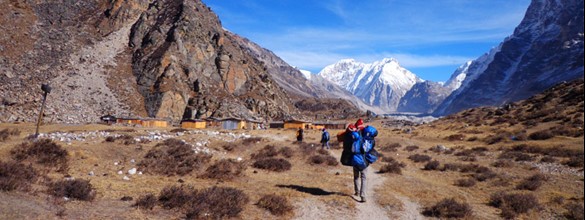
SUMMARY OF KANCHENJUNGA BASE CAMP TREK ITINERARY
The trek begins at Taplejung which is a 45 minute flight from Kathmandu to Bhadrapur, followed by a jeep to Birtamod and then to Taplejung. The broad itinerary for the whole trek is below, and we visit the north base camp first. Days 1 - 3: Arrival in Kathmandu, rest, then fly to Biratnagar and drive to trek start Days 4 - 24: Trek up to Kangchenjunga base camps Days 25 & 26: Travel back to Kathmandu, spare day and depart for home
This walk around Mount Kanchenjunga visits both the North and South Base Camps. The route begins by approaching the North side of Kanchenjunga where you will have great views of Tent Peak, Nepal Peak, Cross Peak before the bulk of Kanchenjunga itself becomes visible.
From Pangpema on the north side the trek returns to Ghunsa and then crosses Mirgin La pass over to the south side of Kanchenjunga. Once over this pass, you follow the route through Ramche and Oktang where there are impressive views of the South West face of Kanchenjunga.
KANCHENJUNGA BASE CAMP TREK MAP
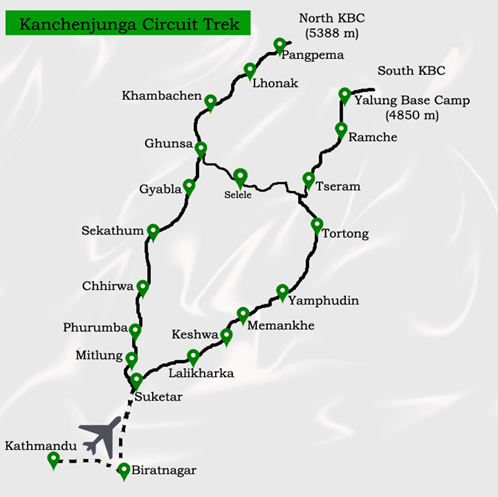
LENGTH AND TERRAIN OF THE KANCHENJUNGA BASE CAMP TREK
The Kanchenjunga trek is long (220 km) and quite strenuous, requiring a good level of fitness needed for three weeks of sustained walking with a light backpack. The terrain is often rough with rocky paths and some long hills and there are a few areas around the base camps where it might be necessary to use short ropes to aid moving across rocky terrain. These are for safety and assisting people over short rocky sections. However there are no climbing skills needed for the trek.
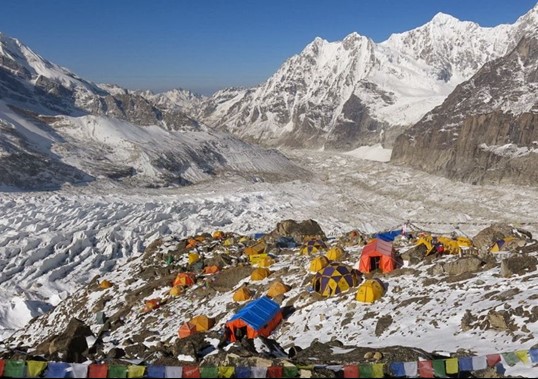
The mountain tracks are easy to follow; early on they follow the rivers and valleys and then ascend abruptly over ridges and shoulders, which means steep sets of rough steps and zig zags uphill.
It is a remote area with little access to medical help, so being fit and having good boots and being used to hiking many days carrying a pack is an important requirement. Training at home with pack on by going on long walks is a good start, plus some leg exercise in the gym and swimming for cardiovascular fitness. Since this is a long trek, do get a health and dental check before going.
When approaching Base Camp, the exposure to altitude makes the walking harder and the likelihood of altitude sickness higher, so it's necessary to allow rest days and walk slowly. The trek will have a wide range of temperatures depending on the altitude and the time of day. In the mountains between 1,000m and 3,500m, the nights will be cool, normally around 5ºc, and during the day temperatures sometimes rise to 25ºc. At higher altitudes temperatures range from about 15ºc to -20ºC at night so it will be important to have a good selection of clothing to provide layers and protection against the cold and the sun.
KANCHENJUNGA BASE CAMP TREK ALTITUDE PROFILE
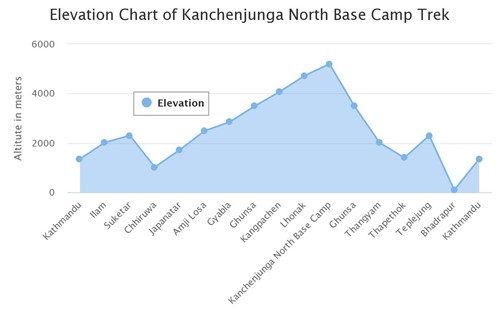
ACCOMMODATION ON THE KANCHENJUNGA BASE CAMP TREK
Accommodation is in lodges which offer western and Nepalese food and sometimes camping when our staff will cater for you. At places on this trek the lodges will be more rudimentary than in the Khumbu region and more likely to offer only Nepali food, which means lots of rice and dal bhat. We recommend using boiled water on the trek or using good quality water purifiers, and we do not recommend buying bottled water in plastic containers.
The itinerary is designed to allow for optimal acclimatisation to the altitude gain, and we do carry drugs like Diamox and Dexamethasone for managing high altitude sickness. Our staff are also trained in mountain first aid. The best advice is to go slowly, eat well, drink well and sleep well. There are no vaccinations needed for visiting the Kanchenjunga region.
PACKING LIST FOR THE KANCHENJUNGA BASE CAMP TREK?
The basic idea of the kit is to keep you warm, dry, protected from the sun, able to move efficiently on the mountains and able to be comfortable in the evenings and night. Your daypack should weigh around 8 - 10 kgs and your main duffle bag should weigh around 15kgs.
Generally speaking a good pair of trekking boots, thermal wear, fleece jacket, down jacket, light weight wind cheater, trekking trousers and shorts, long sleeved and short sleeved T-shirts, duffle bag and day sack, gloves, enough pair of socks, sunglasses, headlight, woollen beanie caps, water bottles, personal toiletries, gadgets and books.You can split your requirements into sections:
- BAGS - Duffle bag ~80L (for a porter) + Medium Daypack ~40L (carried by you)
- SHELL - Top and bottoms to keep dry from wind/rain/snow
- INSULATION - Warm layered system of fleeces, trousers, tops and gloves and hats for sun and cold
- BASE LAYER - Thin layers to wick away sweat and wear on very cold mornings or evenings
- FEET - good quality waterproof ankle high boots and camp/lodge shoes
- SLEEPING - Warm 3 to 4 season sleeping bag and a full length sleeping mat
- DRINKING - Water bottles and purifiers
- WASHING & MEDICAL - wash kit and personal first aid and items for personal hygiene
We recommend reviewing our Nepal Trekking Kit List Guide so you know what you'll need for this journey
FREQUENTLY ASKED QUESTIONS (FAQS) FOR THE KANCHENJUNGA BASE CAMP TREK
What is the flora and fauna like on the kanchenjunga base camp trek.
The trek starts from the subtropical region of Taplejung, through beautiful temperate forests of maple, chestnut and birch trees. Even though farming is less productive in the hilly regions, you can still see terraced fields around these lower regions.
Around Chitre you enter the upper temperate climatic vegetation of rhododendron, pine, firs, and orchids. Above here and across the Sele La (pass) towards Ghunsa begins the more subalpine and alpine climatic zone with shallow and dwarf shrubs and open meadows. Base Camp at 5143m is at the snowline with a rocky and icy landscape.
Snow Leopard, Himalayan Asian black bear and red pandas have been seen in this region although they are obviously shy and difficult to spot. Blood pheasant (below) and the Chestnut-breasted partridge are common bird species.
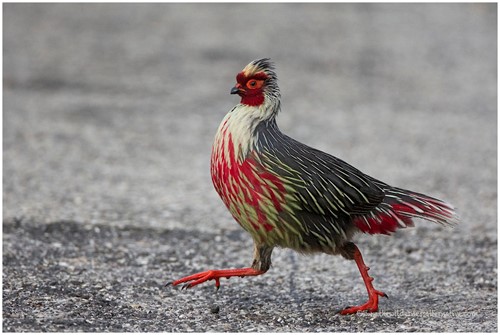
WHAT ETHNIC GROUPS WILL YOU MEET ON THE KANCHENJUNGA BASE CAMP TREK?
This trek explores Nepal’s border with Sikkim and Tibet. The lower region has a mixed community following Hinduism dominated by ethnic group Limbu (below) and the Rai people who follow animist beliefs. The upper region has a distinct community of Bhote and Sherpa people who follow Buddhism.
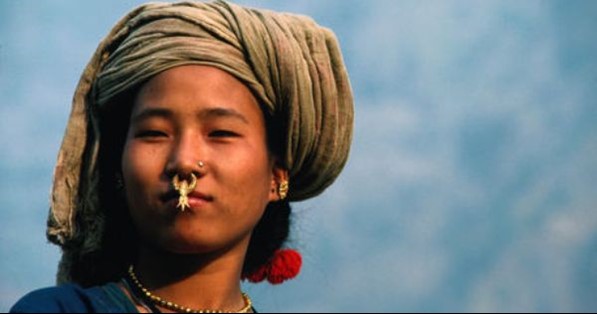
WHERE IS KANCHENJUNGA?
The third highest mountain in the world is in the Great Himalaya Range on the border between Sikkim state, northeastern India, and eastern Nepal, and 46 miles (74 km) north-northwest of Darjeeling.
WHEN IS THE BEST TIME TO TREK TO KANCHENJUNGA?
You can trek the Kanchenjunga Circuit in April, May and early June, and during October and November to early December. During these trekking seasons expect generally stable weather, clear skies, warm days and cool nights. The Kanchenjunga trek is quiet, you will meet other people on the trails and in the lodges but far fewer than in the central region.
WHAT IS THE HISTORY OF THE KANCHENJUNGA REGION?
Spectacular views of the Kanchenjunga range from the summer retreat town of Darjeeling (in India) first raised the curiosity of early British explorers. Then, due to a porous border, easy access to eastern Nepal from bordering Sikkim made adventures to the area possible as early as 1848 (whilst the rest of Nepal was closed to foreign visitors for another 100 years until the 1950s).
For many years Kanchenjunga was considered the highest mountain in the world, until 1856, when Peak XV, (Mount Everest) was discovered. Kanchenjunga literally translates to "Five Great Treasures in the Snow".
There are five peaks within the Kanchenjunga range, and local people believe that each of the five peaks is a repository of different treasures: gold, silver, gems, grains and sacred texts. Kanchenjunga is a sacred mountain, therefore the first summiteers stopped a few meters short of the summit in 1955.
WHAT IS KANCHENJUNGA PEAK LIKE?
Mount Kanchenjunga lies on the eastern end of Nepal, near the border with Sikkim, a tiny Himalayan state in the north-east of India. Until the mid 1800s Kanchenjunga was thought to be the highest peak in the world but it is actually the third and it is a sacred peak which means mountaineers generally avoid standing on the summit itself.
The main peak is 8586 metres, but the massif has four subsidiary summits exceeding 8000 metres, including Kanchenjunga West, also known as Yalung Kang (8,505m). Around the massif and seen on the trek are around twenty peaks more than 7000 metres high,the highest being Kambachen (7,903m) and also including legendary Jannu (7,710m) and Jongsong (7,483m), Kabru (7,353m), Tent Peak (7,365m) and the Twins (7,350m).
Five major glacial systems are found in this huge cluster of peaks and of these Zumu, Talung and Rathong flow into Sikkim while to the west, the Kanchenjunga and Yalung glaciers descned into the Tamor River of Nepal. Do have a read of our various Blogs about treks in Nepal and also the 'More Information' section, both have tabs on this page and will answer every question you may have! We also have a lot of useful information on our Nepal Preparation page.
KANCHENJUNGA TREK REVIEW
"Just a quick note to say thanks for getting my "missing bag" up the mountain for me. What initially looked like a disaster at the start of my trek turned out to be the most fantastic 3 weeks I have ever spent anywhere so far. The whole trek just blew my mind, from the culture, scenery and most of all the people, especially the Adventure Alternative sherpas & porters. I dont think I could praise enough the likes of Pasang, Jangbu & Gelgun who looked after us at times above & beyond the call of duty. Please pass on my sentiments to all of the crew out there". (Richard O'Donovan)
DAY BY DAY ITINERARY
Day 1 Arrive Kathmandu. Hotel.
Day 2 Rest day and acclimatisation to jetlag, sightseeing plus trek briefing.
Day 3 Kathmandu – Biratnagar Flight to Biratnagar which takes around 1hour and 30 minutes.
Day 4 Biratnagar – Suketar – Mitlung (5 – 6 hours) 921m Flight from Biratnagar to Suketar (airfield above Taplejung). It is possible to fly direct to Taplejung, however, at times flights to Biratnagar can be delayed due to bad weather. After the flight, it is quite an easy day of trekking to Mitlung along the Surke Danda ridge.
Day 5 Mitlung – Chirwa (5 hours) 1270m Quite a challenging day beginning on rough paths high above the river. The route passes through the villages of Sinwa, Tawa and Porke and the valley narrows while passing over old landslide debris. The trail then descends across the Thiwa Khola River on a wooden bridge and follows a few more ups and downs before arriving at Chirwa. The village of Chirwa, set among huge boulders and houses made from bamboo, has a bazaar and a few shops where you can buy souvenirs.
Day 6 Chirwa – Sekathum (5 – 6 hours) 1660m The day begins by follwing the Tamur River and climbing steeply before descending to the Simbua Khola (the river that comes from the Yalung Glacier on the south of Kanchenjunga). The trail then crosses a ridge and joins the steep and narrow Ghunsa Khola Valley and on to the Tibetan village of Sekathum, for an overnight stay. From here you will have incredible views of the high Himalayas, including Jannu.
Day 7 Sekathum – Amjilossa (5 – 6 hours) 2510m Another day of following a steep and narrow trail, up the north bank of the Ghunsa Khola to the Tibetan village of Amjilossa.
Day 8 Amjilossa – Gybala (5 hours) 2730m On leaving Amjilossa, there is a short ascent through oak, bamboo and rhododendron forests offering a great view of the south western side of Kanchenjunga. The route makes numerous steep climbs and short descents and passes a beautiful large waterfall before the final steep climb up to Gybala.
Day 9 Gybala – Ghunsa (4 – 5hours) 3595m From Gybala, the trail carries on to the village of Kyapra and then climbs easily up the right bank of the river. The trail crosses a large meadow past few villages and ascends a gentle hill before descending across the river into beautiful village of Ghunsa. This Tibetan village has several lodges, gompas and shops where you can buy a few souvenirs.
Day 10 Ghunsa – Khambachen (5 – 6 hours) 4100m The route climbs gradually along the south bank of the Ghunsa Khola, through beautiful rhododendron and pine forests, passing many mani walls, colourful prayer flags and chortens along the way. The trail climbs steeply up scree slopes to reach the Tibetan settlement of Khambachen, providing wonderful views of the huge north face of Jannu.
Day 11 Rest day at Khambachen. A day of rest and relaxation after a week of trekking. There is an optional day walk to the high ridge behind the village for impressive views of the surrounding Himalayas.
Day 12 Khambachen – Lhonak (5 hours) 4785m From Khambachen the trail climbs up through exposed rocky fields to the village of Ramtang and then crosses North West of the Kanchenjunga Glacier and past large stone huts to the village of Lhonak. From Lhonak there are impressive views of the Himalayas, including Wedge Peak (6750m), Mera Peak (6344m), Nepal Peak (6910m) and Twins (7351m).
Day 13 Lhonak – Pangpema (Kanchenjunga north side base camp) (5 hours) 5143m An early start for the trek the Kanchenjunga north side base camp at Pangpema (5143m), for majestic views of Tent Peak, Nepal Peak, Cross Peak, the Twins and the impressive Kanchenjunga, and returning to Lhonak for an overnight stay.
Day 14 Lhonak – Ghunsa (5 – 6 hours) 3595m Return to Ghunsa, following back along the same path for around 5 hours.
Day 15 Ghunsa – High Camp (5 hours) 4100m From Ghunsa, the trail climbs a steep 500m to a high camp, for an overnight stay in preparation for the trek to Mirgin La Pass.
Day 16 High Camp – Mirgin La Pass 4663m – Tseram (5 – 6 hours) 3870m For impressive views of the Himlayas the route crosses five passes, first Tamo La (3900m), an unnamed pass (4115m), Mirgin La (4663m), Sinion La (4660m) and another unnamed pass at 4724m. From this last pass there is a steep descent of 1000m to the small settlement of Tseram, high above the Simbua Khola.
Day 17 Tseram – Ramche (5 – 6 hours) 4580m The route passes the nose of the glacier into an ablation valley, offering magnificent scenery and views of all the peaks to the east along the India-Nepal border, such as Koktang (6147m), Rathong (6679m) and many more above 7000m. It then follows along a lake, meadow and stone houses to reach Ramche, for an overnight stay.
Day 18 Day trek to Oktang (4 - 5 hours) 4730m Leave early in the morning and follow the ablation valley to Oktang for a view of the south face of the magnificent Kanchenjunga and the climbing route to the summit, first climbed in 1953. From Oktang, the views of the surrounding Himalayas are incredible; the whole cirque is above 7500m. After spending some time in Oktang, we trek back to Ramche to rest for the evening and stay overnight.
Day 19 Ramche – Lamite Bhanjyang (5 – 6 hours) 3310m The trail descends steeply through rhododendron forest to Torontan, and then climbs up through mossy forest to reach the pass at Lamite Bhanjyang after around 5hours. From here, there are fantastic views of Kanchenjunga and Jannu.
Day 20 Lamite Bhanjyang – Yamphudin (5 hours) 2080m The trek descends over 1000 metres today, beginning with a steep descent to Imja Khola, and then crosses along the Dubi Pass. From here there is a further descent for a couple of hours until reaching the village of Yamphudin.
Day 21 Rest day at Yamphudin. Take a day’s rest and some time to explore this beautiful village, home to a mixed community of Sherpas, Gurungs, Rais and Limbus.
Day 22 Yamphudin – Ponphe (5 hours) 1900m From Yamphudin, the trail descends steeply to the Kabeli Khola River and crosses a log bridge before reaching the village of Mamanke. From here, the trail then enters a side canyon and crosses a stream over a long suspension bridge, then climbs up steeply to Ponphe village for an overnight rest.
Day 23 Ponphe – Khunjari (5 – 6 hours) 1928m The trail climbs high to two tea shops on the ridge above the village, and then crosses through a series of valleys and past numerous villages. The route continues down to Bhanjyang and crosses a ridge to descend steeply to the Limbu village of Khunjari, where you will spend the night.
Day 24 Khunjari – Suketar (4 – 5 hours) 2300m The route descends to the Pha Khola and then climbs steeply through Pokhara and Shimu villages to Thenbewa. The trail continues through forest to Lali Kharka and on to a ridge, then follows a gradual descent to Suketar for an overnight stay and to prepare for the early flight to Kathmandu in the morning.
Day 25 Flight from Suketar to Biratnagar, then another flight to Kathmandu.
Day 26 Depart Kathmandu*. If you leave in the morning it is possible to arrive in London the same day, or arrive home on day 27. *This trek relies on 3 internal flights, which can at times be delayed. Please allow at least one extra day in Kathmandu at the end to accommodate delays.
Kangchenjunga Base Camp Trek - £2895 per person based on 2 people £2495 per person, based on 4 people.
- Airport transfers
- All accommodation in lodges/tea houses and in tents on the camping days
- All meals on trek, either from the menu in the lodges or prepared by our staff at the camps
- National Park Fees and permit for Kangchenjunga area
- Sherpa guides (English speaking, trained in first aid) and porters
- Internal flight to Biratnagar
- Staff insurance
- First aid kit and group equipment
- International flight to Kathmandu
- Hotel in Kathmandu - we have a choice of options available during booking or you can book yourself
- Personal costs on trek - hot and cold drinks, hot showers, charging, wifi, snacks.
- Travel Insurance
The price is based on minimum two people, it will be more expensive for a solo traveller and there would be a discount for larger groups. We offer quality, service, security and an ethical stance on tourism in a developing country. We don’t want to be so expensive to end up running fewer trips and have our staff idle, but on the other hand we can't run cheap trips that compromise standards and promote the practise of skimming budgets which would result in the porters getting next to nothing. We also do not operate kitties because we believe it is better to offer an all-inclusive price that reassures people they have all their accommodation and food covered. Additionally we plan treks with sufficient rest days and with achievable daily altitude increases in order to acclimatise. Reducing the number of days may make the price cheaper but the chances of successfully completing the trek also greatly reduce. We include professional staff and a porter for each member. We have our own licensed company in Kathmandu, Adventure Alternative Nepal and full time staff to operate all our treks, climbs and tours in Nepal.
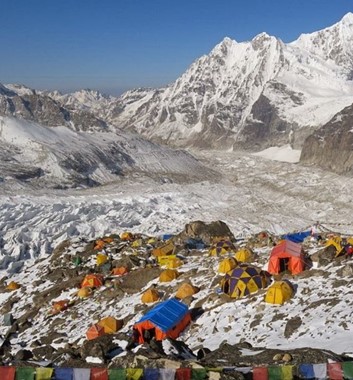
3 season sleeping bag
A good quality 3 season synthetic mummy shaped bag rated to a low of -12°C and a comfort rating of -5°C. Comes with a liner.

Trekking poles
A pair of adjustable trekking poles.

Hotel Manang
3 nights twin/double standard room in the heart of Thamel in Kathmandu. Hotel Manang is a 4 star establishment with excellent facilities, spacious ensuite rooms and a good restaurant.

Yak and Yeti Hotel
3 nights twin/double standard room in this luxury 5 star hotel offering a blend of modern day sophistication and cultural heritage with its 100-year-old palace and the newly designed structure of the hotel.

Kathmandu Guest House
3 nights B&B in a standard twin or double in the famous 4 star Kathmandu Guest House in Thamel, central Kathmandu. KTMGH is set in beautiful grounds with a number of restaurants and gardens, shops and museum pieces.

Kathmandu Eco Hotel
Budget hotel near city centre, price is for 3 nights double or twin room.
Choose a scheduled date or contact us to set up private dates or a bespoke itinerary. The minimum deposit is £100.00 and the balance is due four weeks before travel.
- Trekking days 21 days
- Highest altitude 5388m
- Trekking grade Stenuous
- Accommodation Lodges and camping
- Best time April-June, Oct - Dec
- Region Eastern Nepal
- Local airport Biratnagar
- Nepal trip preparation
- Health and altitude
- Trekking boot advice
- Acclimatising safely
- Kathmandu Accommodation
- Nepal trek kit list
- Nepal: Local price guide
- Sleeping bag advice
- Himalayan Flight Delays
- Guest House in Kathmandu

- Why with Odyssey
- Odyssey Team
- Legal Documents
- Terms and Conditions
- Client Reviews
Photo Gallery
- Upper Dolpo Trek – 22 Days
- Lower Dolpo Trek – 15 Days
- Rara Lake Trek – 15 Days
- Rolwaling Tashi Lapcha Pass Trek – 16 Days
- Jugal Himal Trek – 14 Days
- Ganesh Himal Trek – 15 Days
- Bhairav Kunda Trek – 10 Days
- Api Himal Trek – 19 Days
- Makalu Base Camp Trek – 16 Days
- Kanchenjunga Trek – 22 Days
- Khopra Ridge Trek – 11 Days
- Dhaulagiri Trek – 17 Days
- Guerrilla Trek – 13 Days
- Everest Base Camp Trek – 14 Days
- Everest Base Camp Trek – 13 Days
- Everest Base Camp Short Trek – 12 Days
- Everest Base Camp Trek via Salleri – 16 Days
- Everest Chola Pass Trek – 16 Days
- Everest High Passes Trek – 18 Days
- Everest Gokyo Lake Trek – 12 Days
- Everest View Trekking – 8 Days
- Pikey Peak Trek – 08 Days
- Short Everest Trek – 5 Days
- Everest Thame Legendary Trek – 06 Days
- Everest Yeti Trail Trek – 8 days
- Everest Classic Trek – 20 Days
- Annapurna Circuit Short Trek – 12 Days
- Annapurna Tilicho Lake Trek – 15 Days
- Annapurna Base Camp Trek – 14 Days
- Annapurna Circuit Trek – 19 Days
- Australian Camp Trek – 5 Days
- Mohare Danda Trek – 8 Days
- Dhampus Trek – 5 Days
- Ghorepani Poon Hill Trek – 8 Days
- Jomsom Muktinath Trek – 12 Days
- Mardi Himal Trek – 09 Days
- Royal Trek – 6 Days
- Annapurna Panorama Trek – 7 days
- Nar Phu Valley Trek – 16 Days
- Sikles Trek – 8 Days
- Panchase Trek – 6 Days
- Langtang Circuit Trek – 19 Days
- Langtang Tilman Pass Trek – 18 Days
- Langtang Ganjala Pass Trek – 14 Days
- Gosainkunda Frozen Lake Trek – 7 Days
- Langtang Helambu Trek – 7 Days
- Langtang Valley Trek – 08 Days
- Langtang Gosainkunda Trek – 14 Days
- Langtang Tamang Heritage Trek – 09 Days
- Manaslu Circuit Trek- 12 Days
- Manaslu Tsum Valley Trek – 11 Days
- Manaslu Circuit With Tsum Valley Trek – 18 Days
- Upper Mustang Trek – 16 Days
- Lower Mustang Trek – 12 Days
- Chisapani Trek – 6 Days
- Balthali Village Trek – 5 Days
- Nagarkot – Dhulikhel Trek 3 Days
- Namobuddha Trek – 2 Days
- Nagarkot Trek – 3 days
- Dhulikhel Trek – 04 Days
- Helicopter Trip to Everest Base Camp
- Annapurna Base Camp Helicopter Tour
- Nepal Pilgrimage Tour – 10 Days
- All Nepal Tour – 15 Days
- Kathmandu City Sightseeing Tour – 06 Days
- Nepal Heritage Tour – 11 Days
- Nepal Historical Tour – 13 Days
- Best of Nepal Tour – 10 days
- Basic Nepal Tour – 3 days
- Nepal Cultural Tour – 12 Days
- Nepal Adventure Tour – 14 Days
- Nepal Buddhist Tour – 9 Days
- Island Peak Climbing – 13 Days
- Mera Peak Climbing – 15 Days
- Lobuche Peak Climbing – 15 Days
- Tharpu Chuli Peak Climbing – 14 Days
- Pisang Peak Climbing – 15 Days
- EBC with Island Peak Climbing – 15 Days
- Mera & Island Peak Climbing – 19 Days
- Yala Peak Climbing – 10 Days
- Chitwan Jungle Safari Tour – 04 Days
- Bardia Jungle Safari – 04 Days
- Koshi Tappu Wildlife Safari – 4 days
- Namobuddha Hiking
- Shivpuri Hiking
- Phulchowki Hiking
- Champadevi Hiking
- Nagarjun Hiking
- Trishuli River Rafting
- Sunkoshi River Rafting
- Bhotekoshi River Rafting
- Ultra Light Aircraft
- Mountain Flight
- Paragliding
- Bungee Jump
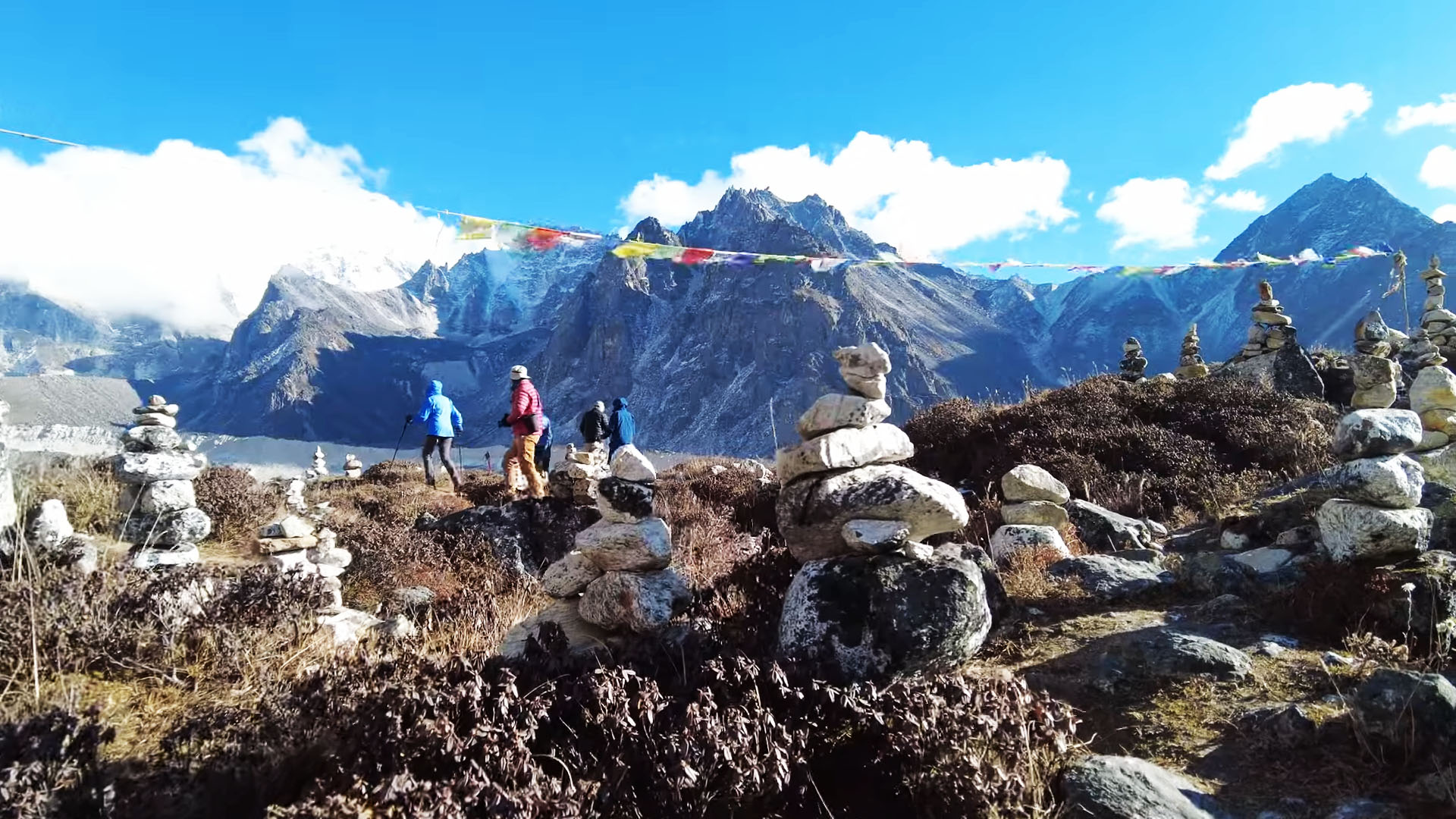
Kanchenjunga Trek – 22 Days
- Guest Review
Trip Highlights
- Trip Durations 22 Days
- Trip Destination Nepal
- Group Size 2-20
- Accomodation Tea House/Camping
- Trip Grade Moderate / Strenuous
- Best Season Sept-Dec, March-May
- Max Altitude 5,143m
Trip Overview
Introduction to the kanchenjunga trek.
“In the heart of the Himalayas, the Kanchenjunga trek reveals a story of beautiful nature and majestic peaks.”
Nepal is a paradise for trekkers looking for adventure and tranquility in nature. Among the numerous trekking routes in Nepal, the Kanchenjunga trek stands out as an untouched and mysterious journey that beckons the intrepid traveler. This 22-day trek takes you to the base camp of the magnificent mountain Kanchenjunga .
Kanchenjunga Trek is a wilderness and unspoiled trekking trail that was opened to foreigners for trekking only in 1988. Kanchenjunga Mountain is in the eastern part of Nepal. Mount Kanchenjunga is the third-highest mountain in the world, with a height of 8,586 meters.
This trekking trip in the Kanchenjunga Conservation Area is more exciting and challenging. This is a wonderful trekking experience in the Himalayan region of Nepal. The trek starts at 920 meters and reaches 5,143 meters above sea level.
The hike includes challenging high passes such as Mirgin La Pass and Selle La Pass. The panoramic views during the pass are nothing short of awe-inspiring, making the challenges worthwhile. From the base camp, you have a unique view of the surrounding peaks, including Jannu, Yalung Kang, and the Kanchenjunga massif .
The Kanchenjunga trek should be the dream of every traveler. But the remoteness of the place attracts only those travelers who prefer to stay away from the crowds. It is also suitable for those who want to enjoy solitude, are willing to walk on the beaten trail, and are ready to explore the unspoiled natural beauty.
Explore the Tibetan Buddhist culture.
This long trekking trail takes you to the border of Nepal, India, and Tibet and allows you to explore the beauty of the mountains. The region is mainly inhabited by people of the Rai and Limbu ethnic groups. These ethnic groups have their own unique culture, traditions, and ways of life. Tibetan Buddhist culture is mostly practiced by the people here. So you will find monasteries, stupas, and gompas on your way. Visits to monasteries and holy places during the Kanchenjunga base camp trek add a spiritual dimension.
During the trek, you will cross lush valleys, dense rhododendron forests, vibrant villages, and various floras and faunas. The area is home to many birds and animals, and if you are lucky, you will encounter animals like snow leopards, red pandas, and Himalayan black bears.
Attractions of the Kanchenjunga Trek
- Explore Kanchenjunga, the third-highest mountain in the world, with a height of 8586 meters.
- Walk through the Kanchenjunga Conservation Area, which is rich in flora and fauna.
- Experience lush green forests, mesmerizing waterfalls, rivers, and beautiful villages on a less-crowded trail.
- Cross passes, thrilling suspension bridges, and grasslands reach the base camp of the Kanchenjunga Mountains.
- Experience the lifestyle of the locals with a blend of traditional Nepali and Tibetan culture.
- Visit ancient monasteries along the trail.
- Interact with locals in Gurung, Limbu, Rai, and Sherpa villages.
- There is an opportunity to see endangered species such as snow leopard, red panda, musk deer, and various species of birds and butterflies.
- You can enjoy amazing panoramic views of high peaks and glaciers while crossing high passes like Sele La Pass and Mirgin La Pass.
What can you expect from the Kanchenjunga Trek?
Stunning Scenery: You will have panoramic views of the Kanchenjunga massif, the world’s third-highest mountain, and the surrounding peaks.
Various Scenarios: The Kanchenjunga Base Camp Trek takes you to different landscapes and remote areas. Experience different landscapes, from the dense forests of the lowlands to the high mountain terrain.
Rich Biodiversity: Explore the Kanchenjunga Conservation Area. This conservation area is home to diverse flora and fauna. It covers a range of ecosystems, from subtropical forests to alpine meadows.
Cultural Immersion: Along the trekking route are the traditional villages of the Limbu, Rai, and Sherpa communities. Experience their unique culture, traditions, and hospitality.
Remote and off-the-beaten path: The Kanchenjunga trek route is less crowded than other popular treks in Nepal. It provides a more peaceful and pristine trekking experience.
Challenging terrain: The Kanchenjunga Base Camp trek combines ascent and descent. It involves traversing steep mountain passes and navigating rugged terrain. Being on a physically demanding trek requires good fitness and stamina.
High Altitude Experience: The trek leads to an altitude of over 5,000 meters (16,404 ft). Experience high-altitude trekking at Kanchenjunga Base Camp. Proper acclimatization is essential to reduce the risk of altitude-related problems.
Tea House and Camping: Stay at teahouses at lower elevations, offering basic accommodation and food. Camping at high altitudes may be necessary, which adds a sense of adventure to the trek.
Unique scenario: Discover unique landscapes such as the Yalung Glacier and Pangpema. It adds a sense of exploration and adventure to your trip.
Visit Spiritual and Holy Places: Along the trail, visit monasteries and holy sites. This adds a spiritual and cultural dimension to your trek.
Is the Kanchenjunga trek suitable for you?
The Kanchenjunga Trek is a challenging and remote trek. It takes you around Kanchenjunga, the third-highest mountain in the world . Whether the Kanchenjunga trek is suitable for you depends on various factors. Before starting a trek, you should consider physical fitness, trekking experience, health condition, personal preferences, etc. Here are some considerations:
Physical Fitness: Kanchenjunga trekking is a challenging and demanding adventure. It involves long and strenuous days of walking over varied terrain, steep ascents, and descents. Physical fitness is essential to covering long distances and varying terrains. Ensure you have a good fitness level and are comfortable with high-altitude trekking. Before trekking, you can do regular cardiovascular exercise and strength training.
Altitude: This trek takes you to altitudes above 5000 meters, with a high risk of altitude sickness. It is essential to be aware of the risks associated with high altitudes and take necessary precautions. Proper acclimatization is also vital to avoid altitude sickness. We recommend taking rest days and ascending slowly to acclimate well. It is good to consult a healthcare professional before attempting this trek.
Trekking Experience: Some sections of Kanchenjunga trekking can be challenging. Previous trekking experience is not essential but is beneficial, especially at higher altitudes. Many people complete the trek without prior experience. However, being physically fit enhances the overall trekking experience. If you are a beginner, consider starting with shorter and less strenuous treks before trekking.
Duration: The Kanchenjunga is a long-day trek that takes about three weeks to complete. However, the duration also depends on your pace and rest days, so make sure you have enough time to complete the trek.
Terrain and Climate: The trek includes rocky paths, forest paths, and high mountain terrain. At high altitudes, the weather can change unpredictably. So, be prepared for rugged, high-altitude trails and different weather conditions.
Basic amenities: Accommodations at the Kanchenjunga base camp are usually tea houses or lodges. The tea house on the trail is like a small lodge with basic facilities. Foods are also more basic and limited, especially at high altitudes. This trek may suit you if you are comfortable with basic food and accommodations.
Personal Interests: When choosing a trek, it is essential to be clear about your interests and expectations. On the trek, you can enjoy stunning snow-capped mountain views, diverse landscapes, and cultural experiences. So, make sure that this trek matches your interests and expectations.
Benefits of booking a Kanchenjunga trek with Odyssey
- Free private vehicle service for pick-up and drop-off at the airport
- As souvenirs, an Odyssey Trek duffel bag and t-shirt
- Map of the Kanchenjunga Trek
- Use an oxygen meter at a high altitude to measure the oxygen saturation of the blood.
- Arrangement of emergency medical kit
- Accessible extra luggage storage facility for the duration of the trek
- Arrangement a down jacket and sleeping bag for trekking if you don’t have your own
Food and accommodations during the Kanchenjunga Trek
As Kanchenjunga is a challenging and remote trek, you should prepare well, considering food and accommodation. Food facilities during the trek may vary, and the options are generally more basic than in famous trekking areas. Along the trekking route, many villages have teahouses. These teahouses are like small lodges that provide basic accommodation and food.
Teahouses usually have a basic menu with various local and international dishes. The menu usually includes Dal Bhat (rice, lentil soup, and vegetables), noodles, soups, and sometimes Western food options. The menu in tea houses can be limited, especially in higher altitudes and remote areas.
You can also find a variety of hot drinks, such as tea, coffee, and hot lemonade, which can be comforting in cold weather. It is a good idea to carry some snacks and energy bars for extra energy during the trek.
Drinking water is available everywhere, but always make sure that the water you consume is safe. Purifying water using water purification tablets or a water filtration system is advisable. You can also buy bottled water if it is available.
Rooms in teahouses are basic, with simple beds and shared facilities. You can expect simple rooms in teahouses with beds, pillows, mattresses, and blankets. Extra blankets are available if it gets too cold. But it’s a good idea to bring a sleeping bag, as temperatures can drop significantly at higher altitudes.
Difficulty of Kanchenjunga Trek
The Kanchenjunga base camp trek is one of the most challenging treks in Nepal. Therefore, preparing for the challenges that may arise before attempting trekking is essential. Below are some factors that make this trek difficult:
Remote and Less Developed Areas: It is remote and less developed than popular trekking destinations such as the Annapurna and Everest regions. Food and lodging facilities in teahouses are very basic, and infrastructure is limited.
High Altitude: The trek leads to an altitude of over 5,000 meters. Altitude-related challenges, such as acute mountain sickness (AMS), are a concern in high-altitude trekking. The body needs to adjust to the change in altitude. So, ascending gradually with proper acclimatization is important to avoid altitude sickness.
Long Duration: It is a long trek that takes about three weeks to complete. The long duration and challenging terrain demand good physical fitness and endurance.
Variable Weather Conditions: The weather in the Kanchenjunga region can be unpredictable. During the trek, you may encounter rain, snow, and cold temperatures, especially at higher altitudes.
Trail Difficulty: The trek covers a variety of terrains, from lush subtropical forests to alpine meadows and high mountain landscapes. The trails are steep, rocky, and rugged, making the trek challenging.
Isolation: Compared to other popular routes, this area is less crowded and has limited access to services. This solitary trek contributes to the sense of adventure but also requires careful planning.
Due to the difficulty level, preparation is essential before attempting the trek. Previous trekking experience and good physical fitness are beneficial for completing the trek. It is advisable to go trekking with local and experienced guides for safety and navigation.
best time for Kanchenjunga Trek
The best seasons for Kanchenjunga trekking are spring (March to May) and autumn (September to November). The weather is usually stable during these seasons, and clear skies and moderate temperatures make trekking ideal.
In spring, the landscape is adorned with colorful rhododendron flowers . The trails are relatively dry, which makes the journey more comfortable. Autumn has less rainfall and a low chance of snowfall at higher altitudes, which can make trekking safer. Spectacular views of the surrounding landscapes are more likely due to low cloud cover. However, it is important to note that the weather in the Himalayas can be unpredictable. Therefore, checking the latest weather forecasts before planning a trip is always a good idea.
Trekking during the monsoon season (June to August) can be challenging due to heavy rains, muddy trails, and leeches. Similarly, the winter season (December to February) is extremely cold. Snow can fall during this season, especially at higher elevations, posing additional risks. So, the monsoon and winter seasons are generally not recommended for the Kanchenjunga trek.
High altitude sickness and acclimatization
Altitude sickness, also known as acute mountain sickness (AMS), affects hikers and climbers at high altitudes. The Kanchenjunga trek offers breathtaking scenery and challenging terrain that attract many adventurers. However, high-altitude treks can cause altitude sickness.
Altitude sickness occurs when the body cannot adjust to the reduced oxygen levels at high altitudes. At higher altitudes, the air pressure decreases, which reduces the amount of oxygen. Lack of oxygen can cause various symptoms, from mild discomfort to serious illness. Symptoms of altitude sickness include headaches, nausea, fatigue, dizziness, and shortness of breath. These symptoms usually occur at altitudes above 2,500 meters (8,200 feet). So, it is important to be aware of altitude sickness while trekking.
Altitude sickness is a serious concern, but the risk can be minimized with proper preparation, acclimatization, and awareness. To minimize the risk of altitude sickness, it is necessary to acclimatize the body and ascend gradually.
Rest days at certain altitudes should be included in your itinerary to allow the body to adjust to reduced oxygen levels. Staying hydrated also helps reduce symptoms and aid in adaptation. If the condition is severe, a low-altitude evacuation or medical assistance may also be necessary. Taking proper precautions allows you to safely enjoy the unique beauty of the Himalayas on the Kanchenjunga trek .
Kanchenjunga Trek Cost
The cost of the Kanchenjunga Base Camp Trek depends on various factors. It may vary depending on the duration of the trek, route, and services included (e.g., guide, porter, accommodation, food, and permits). Similarly, the cost of trekking also depends on the size of the group. According to your budget, you can choose a teahouse trek package or a luxury package with a camping trek.
The teahouse package includes basic teahouse service on trekking routes. A teahouse is a small guesthouse that provides travelers with basic accommodations and food. Depending on various factors, this package can range from $2,200 to $3,000 per person.
If you want better service than the basic teahouse package, you can opt for the luxury camping trek option. This luxury package offers complete luxury service. It includes high-quality accommodation in comfortable tents or lodges, professional chefs, hot showers, portable toilets, etc. Depending on various factors, you can expect to pay $3,500 to $6,500 or more per person for a luxury camping trip.
However, prices may fluctuate depending on the luxury you prefer and any additional services you require. Researching various trekking companies and finding the best option that fits your budget and preferences is advisable. Let us know your requirements, interests, and group size, and we will prepare an excellent package price per your requirements.
Water, toilet, shower, mobile charger, internet and wi-fi
Facilities like water, toilets, showers, mobile chargers, and internet on the trekking route may vary depending on the location and type of accommodation. Access to clean water is essential during the trek. Along the trekking trail, you come across teahouses or lodges where you can buy bottled water. You can also refill your water bottles with filtered or boiled water at these teahouses for a small fee. Treating the water using purification tablets or filters for clean water is a good idea.
Along the Kanchenjunga Base Camp trekking route , teahouses or lodges usually have basic toilet facilities. Depending on the location, these can range from squat toilets to more Western-style toilets. In some remote areas, you may also encounter simple pit latrines at high altitudes. It is advisable to carry toilet paper, small towels, soap, hand sanitizer, etc.
Teahouses have shower facilities, but their availability and standards may vary. In some places, you have to pay extra for a hot shower, while in others, only a cold water shower may be available. The availability of shower facilities in mountains at higher altitudes may be limited.
Many teahouses along the trail have charging facilities for electronic devices such as mobile phones and cameras. However, the availability of this facility may vary depending on location and teahouse infrastructure. They usually provide charging outlets in common areas or guest rooms.
Electricity in the Kanchenjunga region is generally generated from solar energy sources. Some teahouses provide electricity 24 hours a day, while others offer limited hours, usually in the evening. At some teahouses, charging may be free, while others may charge a small fee for each device. Carrying a portable power bank as a backup is a good idea.
Internet and wi-fi access are generally limited in Kanchenjunga trekking . Some teahouses offer wi-fi for a fee, but the connection can be slow and unreliable. As you climb higher, the availability of wi-fi and internet facilities decreases. Most teahouses in remote and high-altitude areas do not have any wi-fi or internet facilities. You can use satellite phones for alternative communication, but remember that it is expensive.
Permits for Kanchenjunga Base Camp Trek
A permit is mandatory for trekking in the Kanchenjunga region . The main permits you need for the Kanchenjunga trek are:
Restricted Area Permit (RAP):
Due to its sensitive nature, the Kanchenjunga area has been declared restricted. Trekking in this area requires a special permit, which can be obtained only through a registered trekking agency in Nepal . Since independent trekking is not allowed in this area, you must arrange a permit through a trekking agency.
This permit costs US$20 per person per week for the first four weeks. After the first four weeks, you pay US$25 per person per week. A minimum of 2 people are required for a special permit, as solo trekking is also prohibited in this area. Note that the cost of the special permit is the same for foreigners and SAARC nationals.
Kanchenjunga Conservation Area Project Permit (KCAP):
Another permit required for trekking is the Kanchenjunga Conservation Area Project Permit (KCAP). You can get this KCAP permit in Kathmandu or at the entry point to the conservation area. The KCAP fee is NPR 500 (approximately USD 4) per person for SAARC countries. The KCAP fee for nationals other than SAARC nationals is NPR 2000 per person (approximately USD 16).
Health and fitness training for Kanchenjunga trek
Kanchenjunga is a challenging trek that requires good health, physical fitness, and mental preparation. The trail leads through rugged terrain, high altitude, and varying weather conditions. It is better to do health and fitness training before going on the Kanchenjunga trek . Here are some health and fitness tips to help you prepare for the Kanchenjunga trek.
Cardiovascular Fitness:
Cardiovascular endurance is important for walking long distances at high altitudes through uneven terrain. To improve cardiovascular fitness, do aerobic exercise such as walking, running, cycling, or swimming. Gradually increase the intensity and duration of the workout to build endurance and stamina.
Strength Training:
Strength training strengthens the leg muscles, core, and upper body. It can help with vertical ascents and descents and comfortably carry bags. Include exercises such as squats, lunges, calf raises, push-ups, planks, and shoulder presses in your daily exercise routine.
Flexibility and Mobility:
Flexibility and mobility are essential to prevent injuries and maintain agility while trekking. Include stretching exercises and yoga into your workouts to improve flexibility and range of motion.
Trekking Practice:
Practice trekking on uphill and uneven terrain 1 month in advance. Gradually increase the duration and difficulty of your trekking to build endurance.
Height simulation:
If possible, engage in altitude simulation training by hiking at high altitudes. This helps your body adapt to the reduced oxygen levels and prepares you for the trek’s altitude challenges.
Hydration and Nutrition:
Staying hydrated is essential, so drink plenty of water throughout the day and during your workouts. Consume high-energy snacks and meals during training sessions. A balanced diet of carbohydrates, proteins, healthy fats, vitamins, and minerals will fuel your body for the trek.
Mental Preparation:
Remote and challenging trekking can be mentally demanding. Practice meditation or visualization techniques to stay focused and positive on the trek. Be prepared for unexpected weather changes, physical exertion, and possible obstacles during trekking.
Medical check-up:
Consult a doctor before starting the trek to ensure you are physically fit for high-altitude trekking. They may recommend particular medications or precautions for altitude sickness and other illnesses. It is also a good idea to carry essential medicine or first aid with you
Equipment packing list
Packing the right equipment and gear is important for a successful and comfortable Kanchenjunga trek. Depending on the season, the things you need may be slightly different. However, here is a comprehensive packing list to consider for the Kanchenjunga trek:
- Synthetic or merino wool tops and bottoms to wick sweat away from the skin.
- A fleece jacket or insulated vest for warmth in colder conditions.
- Insulated pants or down pants for extreme cold.
- Waterproof and breathable jacket with hood.
- Waterproof and breathable pants or rain pants.
- Lightweight, quick-drying trekking pants with zip-off legs for versatility.
- Thermal leggings or long underwear for layering in colder weather.
- Lightweight, long-sleeved trekking shirts for sun protection.
- A wide-brimmed hat or cap for sun protection.
- A beanie or warm hat for cold weather.
- Neck gaiter or scarf for wind protection.
- Lightweight gloves for mild conditions.
- Insulated waterproof gloves or mittens for cold and wet weather.
- Moisture-wicking liner socks.
- Thick, woolen trekking socks for warmth and cushioning.
- Spare pairs of socks for changing during the trek.
- Sturdy, waterproof trekking boots with ankle support.
- Break them in before the trek to prevent blisters and discomfort.
- Lightweight sandals or camp shoes are ideal for resting at tea houses.
Backpacking Essentials:
- Down or synthetic sleeping bags are rated for sub-zero temperatures.
- Inflatable or foam sleeping pad for insulation and comfort.
- Large, comfortable backpack with padded shoulder straps and a hip belt.
- Use a rain cover or waterproof liner to protect gear from rain.
- Adjustable trekking poles for stability and reducing strain on the knees.
- Lightweight, durable headlamp or flashlight with extra batteries.
- Insulated water bottles or hydration bladders help you stay hydrated.
- Detailed trekking map or GPS device for navigation.
- Sunglasses with UV protection.
- Sunscreen with high SPF.
- Lip balm with SPF.
- Basic first aid kit with bandages, antiseptic wipes, pain relievers, and any personal medications.
- Toilet paper, biodegradable soap, hand sanitizer, and personal hygiene items.
- Multi-tool, sewing kit, duct tape, and repair supplies for gear.
- Lightweight emergency bivy sack or space blanket.
Miscellaneous:
- A waterproof pouch to keep trekking permits, passports, and other identifications safe.
- Sufficient cash in Nepali rupees for trekking expenses.
- Credit and debit cards are available for emergencies (ATMs are unavailable in many villages).
- Camera or smartphone for capturing memorable moments.
- Extra batteries or a portable charger.
- Guidebook or map of the Kanchenjunga trek route.
- Notebook and pen for journaling or taking notes.
- High-energy snacks like nuts, energy bars, chocolates, and dried fruits.
- Ziplock bags or garbage bags for packing out waste.
- Water purification tablets, or filters, are used to treat water from natural sources.
Personal Items:
- Passport, visa, and trekking permit.
- A copy of the travel insurance policy with emergency contact information.
- Any prescription medications, along with a copy of the prescriptions.
- Toothbrush, toothpaste, biodegradable soap, and other personal hygiene items.
- Earplugs and sleep masks for a better night’s rest in teahouses.
- Quick-drying, lightweight towel for personal hygiene.
- Moisturizer and lip balm to protect skin from dryness and chapping.
The Kanchenjunga trek is for those looking for the perfect blend of adventure, nature, and cultural immersion. This trek is a physical and spiritual journey for those who dare to reach the lap of the Himalayas. It is a trek of a lifetime , a journey to the roof of the world. Explore the beauty of the Kanchenjunga region with Odyssey Treks . For more information about trekking and tours, feel free to contact us at [email protected]
You may like to visit: Nepal Adventure Tour in 14 days, tour, package, cost, itinerary .
Trip Itinerary
Fly kathmandu to taplejung (2,320m) and trek to mitlung (920m) - 3 to 4 hours walk., mitlung to chirwa (1,270m) - 6 to 7 hours walk., chirwa to sukathum (1,576m) - 6 to 7 hours walk., sukathum to amjilosa (2,308m) - 7 to 8 hours walk., amjilosa to gyabla (2,730m) - 7 to 8 hours walk., gyabla to ghunsa (3,595m) - 6 to 7 hours walk., free day at ghunsa., ghunsa to kambachen (4,050 m) - 6 to 7 hours walk., acclimatization day at kambachen., kambachen to lhonak (4,780m) - 7 to 8 hours walk., lhonak to pangpema/kanchenjunga north base camp (5,143m) - 7 to 8 hours walk., kanchenjunga north base camp to kambachen (4050m) - 7 to 8 hours walk., kambachen to ghunsa (3,595m) - 6 to 7 hours walk., ghunsa to sele le (4,290m) - 7 to 8 hours walk., sele le to cheram (3,870m) - 7 to 8 hours., cheram to ramche (4,580m) and return back to cheram - 5 to 6 hours walk., cheram to tortong (2,995m) - 6 to 7 hours walk., tortong to yamphudin (2,080m) - 7 to 8 hours walk., yamphudin to mamanke (1,800m) - 7 to 8 hours walk., mamanke to lalikharka (2,265m) – 5 to 6 hours walk, lalikharka to suketar (2,320m) – 5 to 6 hours walk., fly suketar to kathmandu., why not list the price.
Each client's needs may be different. The price of the trip varies according to the size of your group and the service you want. The cost of the trip is calculated according to the type of service and accommodation chosen by our customers.
Each trip is customized to fit the client's needs and group size, so the price of each organized trip is different. Please let us know the service you want and the size of the group. We create trips to suit your taste and travel budget per your requirements. Hope you find our price calculation reasonable according to your needs and preferences.
Get A Quote
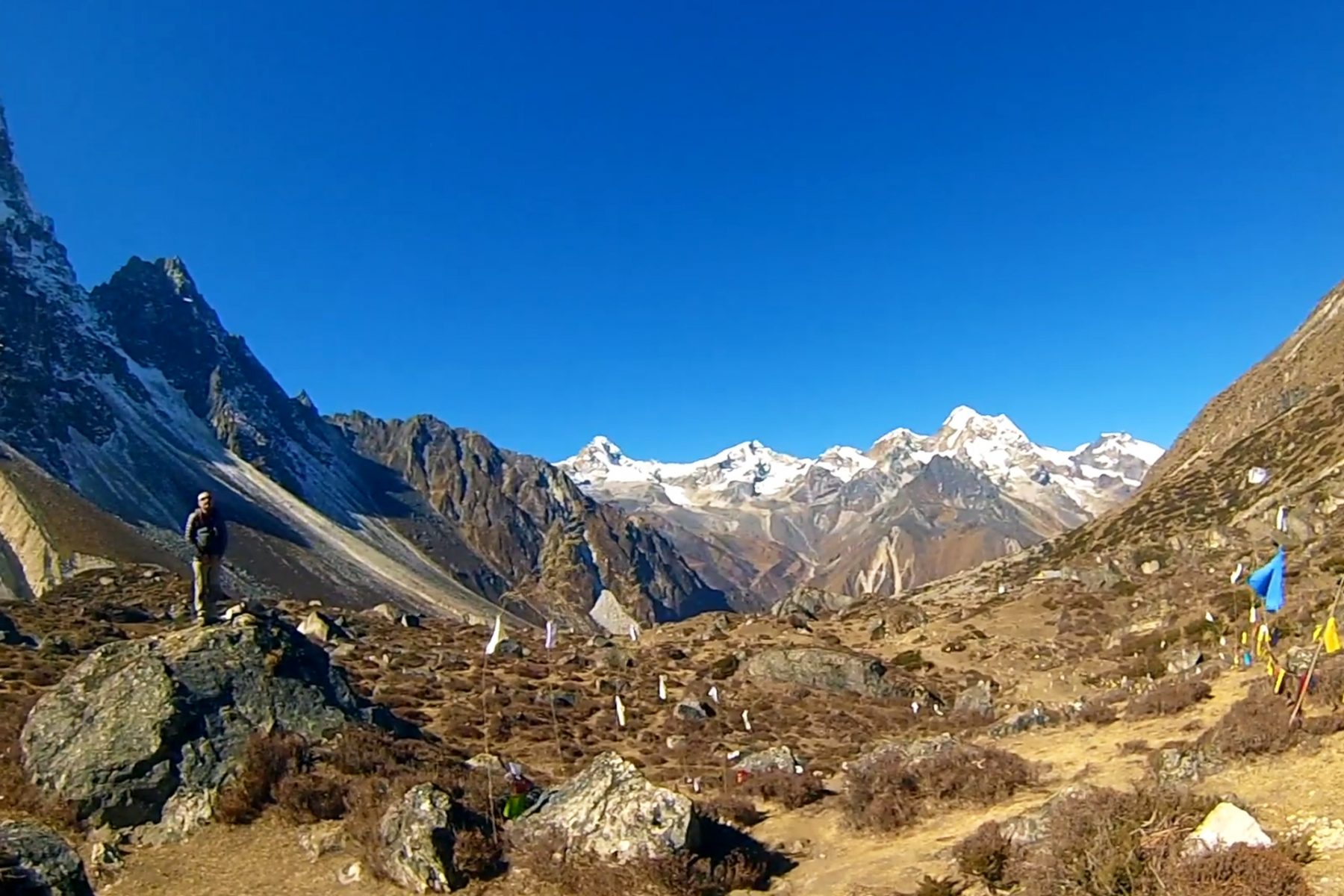
Frequently asked questions about this trip
How difficult is the trek.
The difficulty depends on where and how long you want to trek. The short trek is easy while the long trek requires some physical fitness.
What is altitude sickness?
Altitude sickness is normally known as acute mountain sickness. This can happen when people rapidly climb up to an altitude of more than 3000 meters. We ensure minimal risk by adding rest to our trekking itineraries. Most people will feel some effects of altitude, some shortness of breath and possibly light headache, this is normal enough. Acute mountain sickness patients are quite different and usually have a serious headache, sickness, and lose awareness. In almost all possible cases there are sufficient warning signs to take action properly. Descending to a lower altitude is usually enough to prevent any further problems.
What type of accommodation is available during the trekking?
There are mainly tea houses and lodges available for trekking and they are usually made using local materials and are very comfortable. These accommodations are often family-run and usually provide single and double rooms. The dining room is on the ground floor and is often on fire. All food will be cooked in order in the family kitchen. Toilet facilities are sometimes separate and sometimes outside. Most lodges provide mattresses and blankets. It's a good idea to always have a sleeping bag, which can be useful, and perhaps an inflatable pillow.
How long do we walk every day on trekking?
Trekking programs are classified into three different categories: soft, moderate and hard. Soft treks are only about 7 days to 10 days in duration. They generally do not go above 4000 meters; you can expect to walk about 4-5 hours each day. Moderate treks are challenging enough and long treks that go to the high hill country. Physically exhausting, this involves trekking along the cliffs of the mountains for about 6-8 hours. Harder treks are longer treks that go farther away from the general abode of trekkers and tourists. These physically challenging treks involve walking for 7- 9 hours each day.
How much weight do I need to carry on the trek?
You carry some of your personal belongings, such as warm clothing, water, snacks, sun block, cameras and more. Generally, these items will be lightweight, from 5 to 10kg (10 to 20 pounds). Our porters are available for other heavy goods and for your information one porter would be sharing by two people. The maximum weight carried by one porter is total 20 kg. this means 10 kg. per person is allowed for the trek. In case if you wish to carry more than this weight then you need to hire additional porters.
What is the best time for trekking in Nepal?
October and November are considered as the best times for trekking in Nepal due to dry season. December and January are also considered good times for trekking but it is extremely cold at high altitudes.
Google Reviews
Guest reviews.
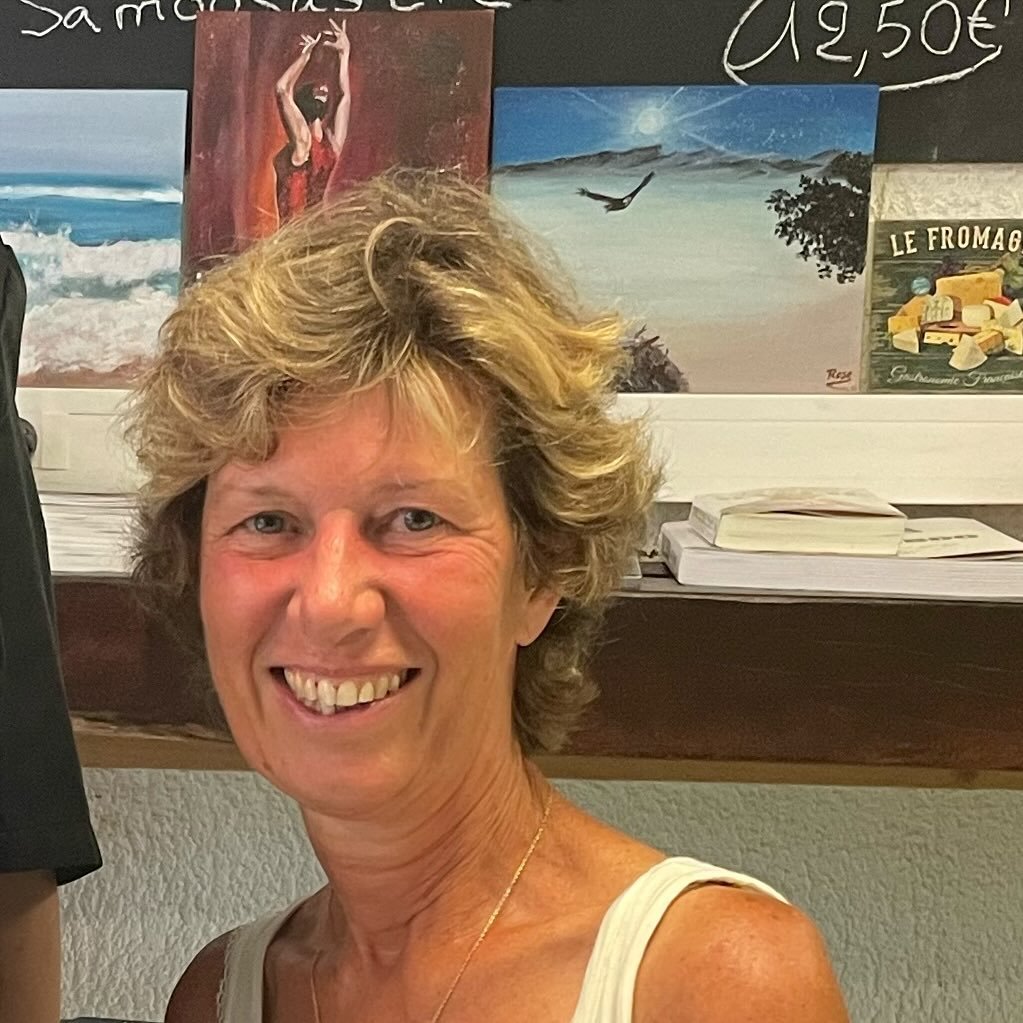
Thank you a lot for your organization about my trek. It was a superb experience; all was perfect. Karma is a very nice person and a good guide. I appreciated trekking with Odyssey (a reliable Nepal trek operator). If I come back to Nepal, I will be happy to...
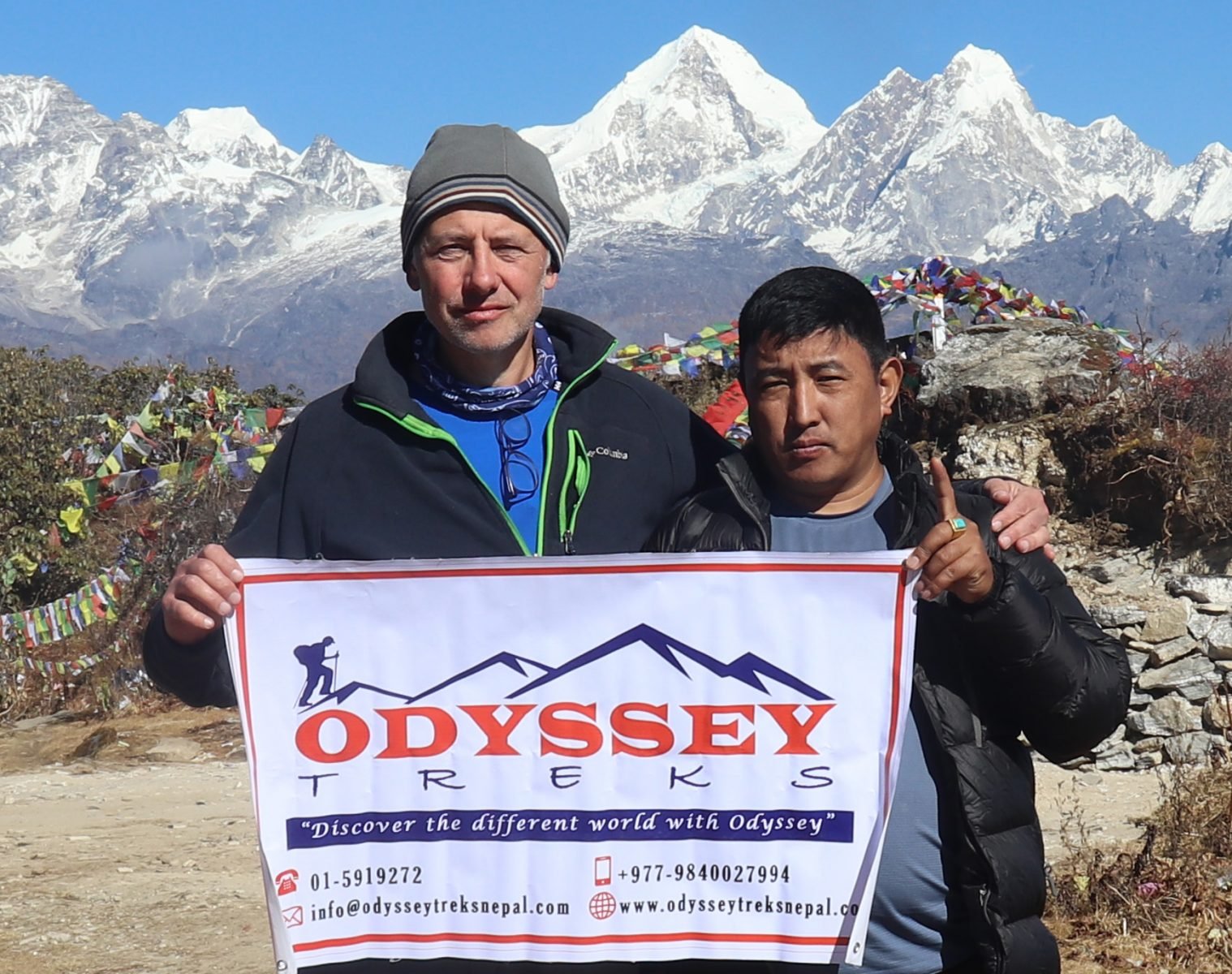
Have just returned from my fourth trip to Nepal and as always Odyssey Treks organized everything superbly. We visited Makalu relatively late in the season and were rewarded with empty trails and amazing weather. Karma was as entertaining, friendly, and informative as ever along with Ang Dawa Sherpa who...
Similar Trips
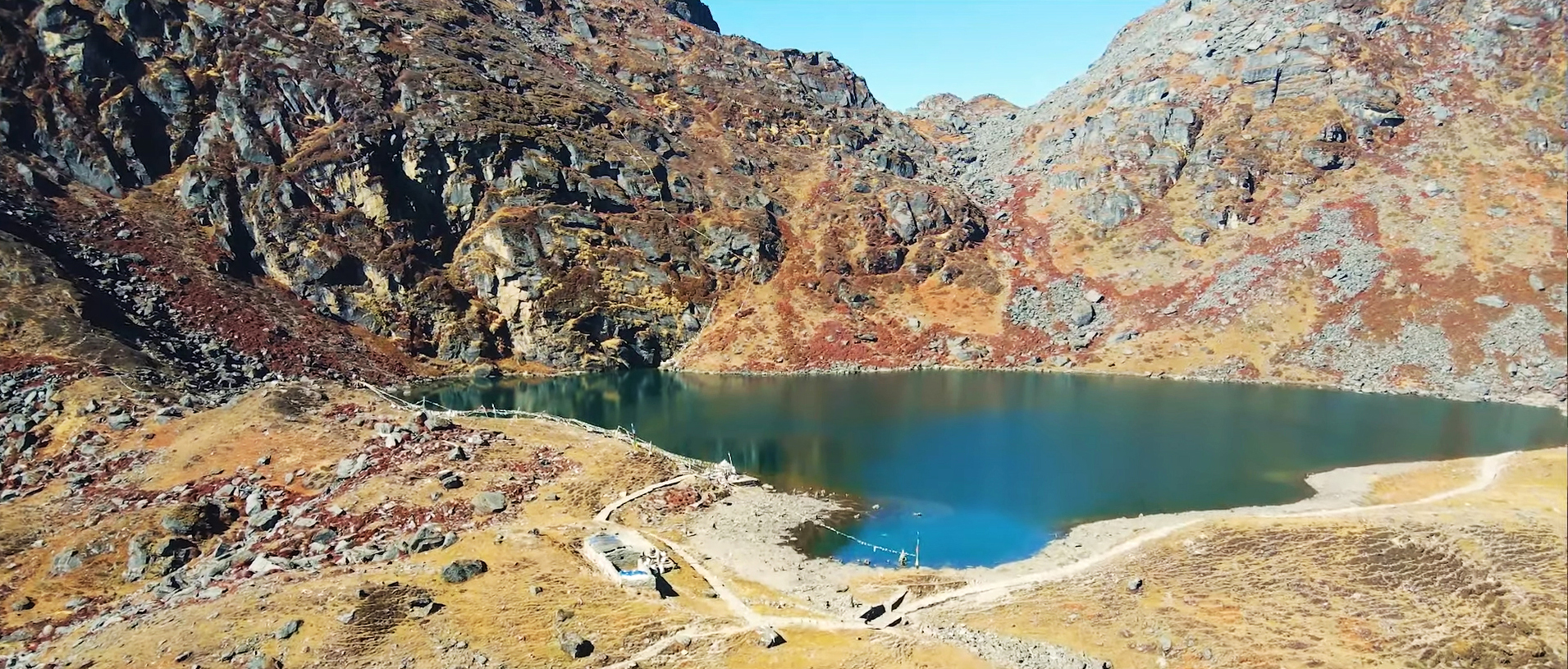
Bhairav Kunda Trek – 10 Days
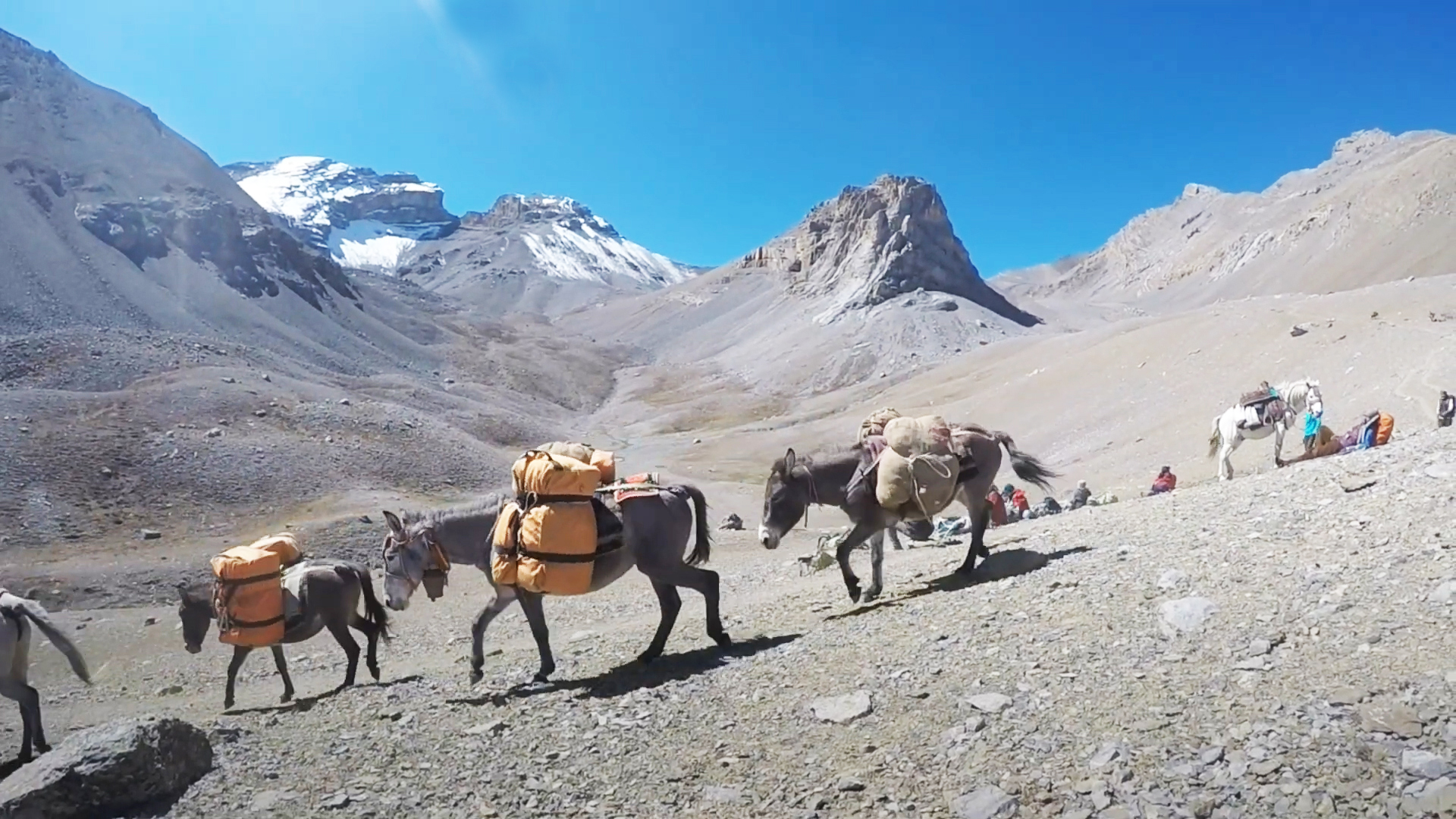
Lower Dolpo Trek – 15 Days
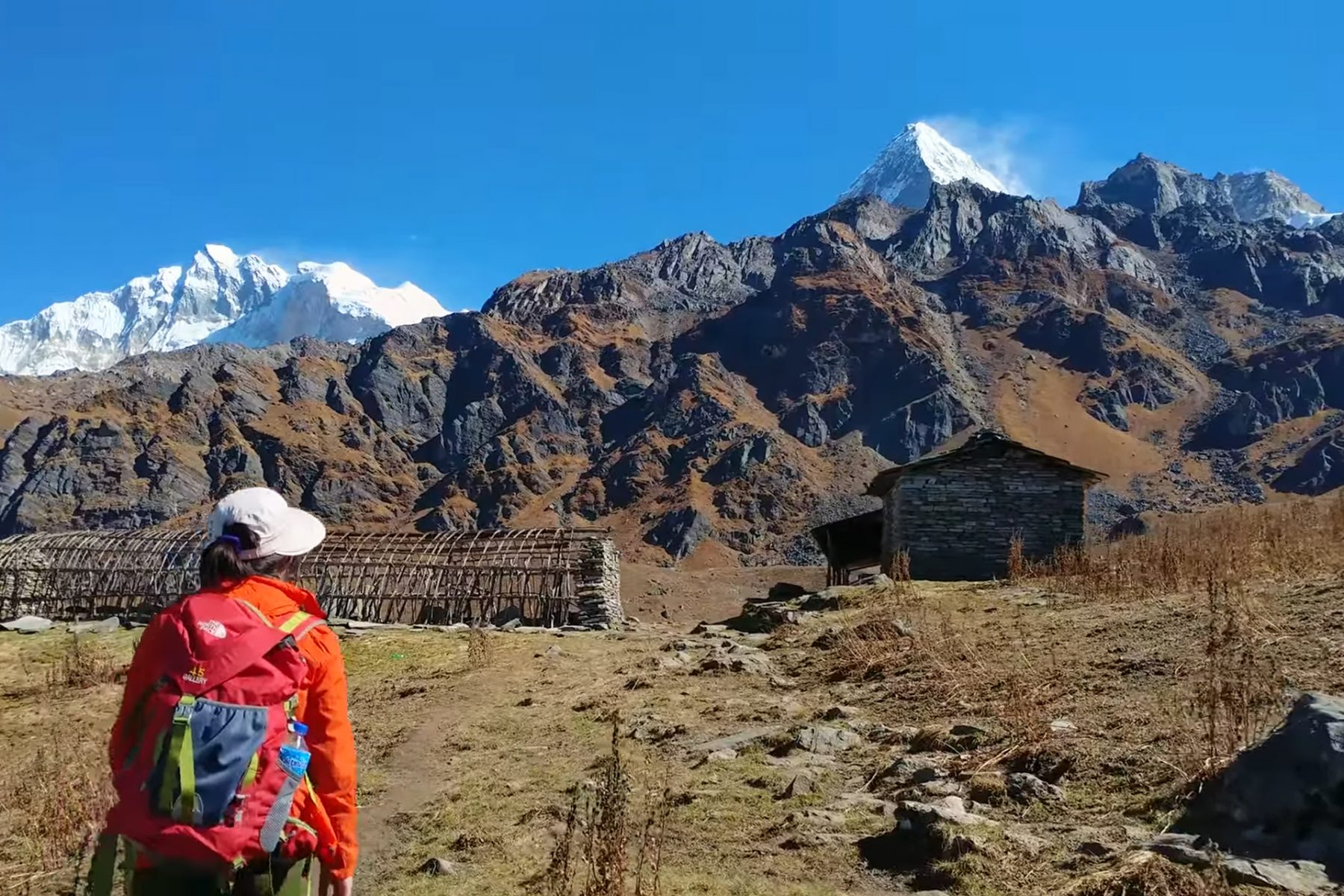
Khopra Ridge Trek – 11 Days
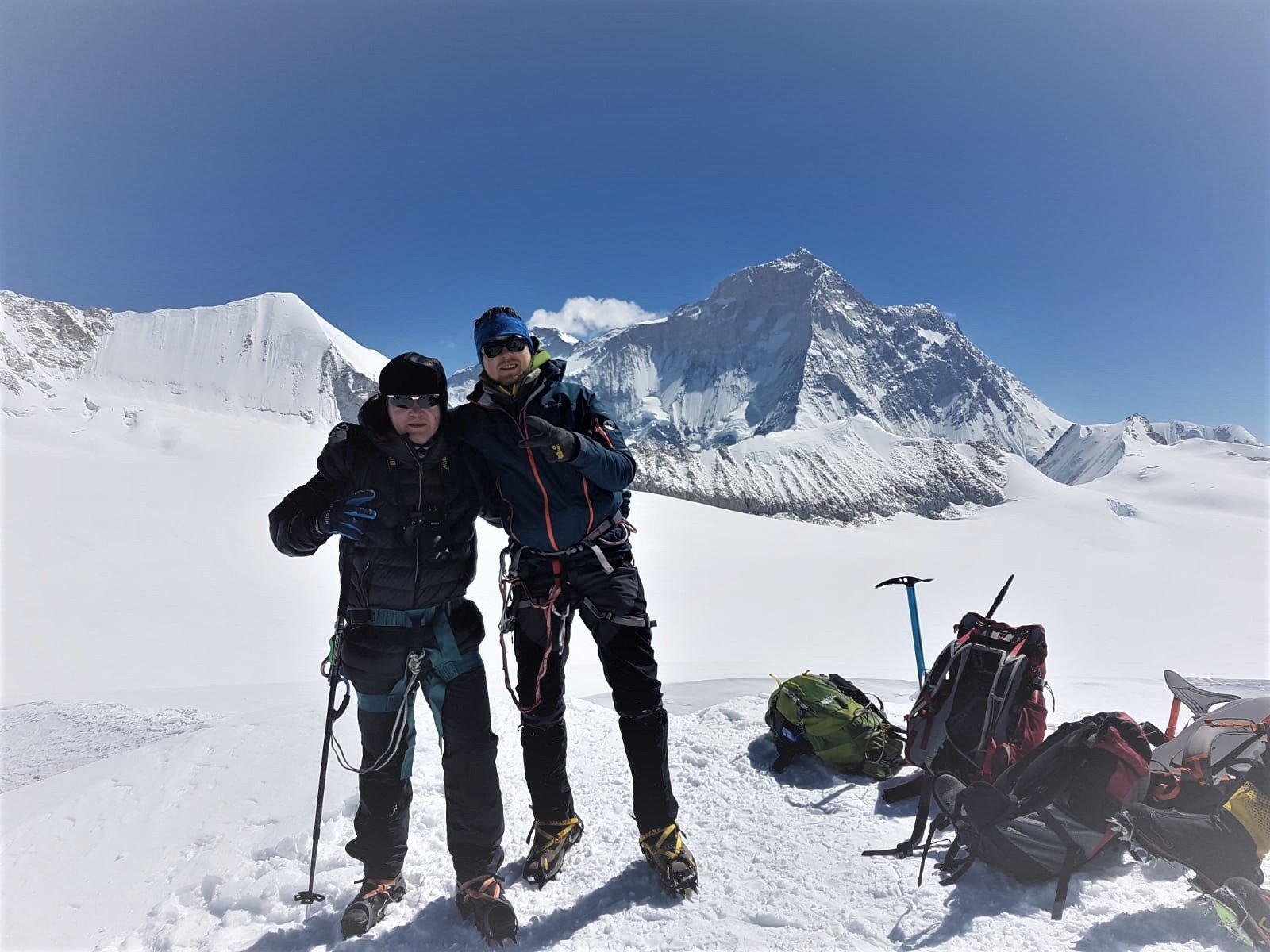
Makalu Base Camp Trek – 16 Days
Price inquiry.
Select Your Country United States Canada Mexico United Kingdom Afghanistan Albania Algeria American Samoa Andorra Angola Anguilla Antigua and Barbuda Argentina Armenia Armenia Aruba Australia Austria Azerbaijan Azerbaijan Bahamas Bahrain Bangladesh Barbados Belarus Belgium Belize Benin Bermuda Bhutan Bolivia Bonaire Bosnia and Herzegovina Botswana Bouvet Island (Bouvetoya) Brazil British Indian Ocean Territory (Chagos Archipelago) British Virgin Islands Brunei Darussalam Bulgaria Burkina Faso Burundi Cambodia Cameroon Cape Verde Cayman Islands Central African Republic Chad Chile China Christmas Island Cocos (Keeling) Islands Colombia Comoros Congo Congo Cook Islands Costa Rica Cote d'Ivoire Croatia Cuba Curaçao Cyprus Cyprus Czech Republic Denmark Djibouti Dominica Dominican Republic Ecuador Egypt El Salvador Equatorial Guinea Eritrea Estonia Ethiopia Falkland Islands (Malvinas) Faroe Islands Fiji Finland France French Guiana French Polynesia French Southern Territories Gabon Gambia Georgia Germany Ghana Gibraltar Greece Greenland Grenada Guadeloupe Guam Guatemala Guernsey Guinea Guinea-Bissau Guyana Haiti Heard Island and McDonald Islands Holy See (Vatican City State) Honduras Hong Kong Hungary Iceland India Indonesia Iran Iraq Ireland Isle of Man Israel Italy Jamaica Japan Jersey Jordan Kazakhstan Kazakhstan Kenya Kiribati Korea Korea Kuwait Kyrgyz Republic Lao People's Democratic Republic Latvia Lebanon Lesotho Liberia Libyan Arab Jamahiriya Liechtenstein Lithuania Luxembourg Macao Macedonia Madagascar Malawi Malaysia Maldives Mali Malta Marshall Islands Martinique Mauritania Mauritius Mayotte Micronesia Moldova Monaco Mongolia Montenegro Montserrat Morocco Mozambique Myanmar Namibia Nauru Nepal Netherlands Netherlands Antilles New Caledonia New Zealand Nicaragua Niger Nigeria Niue Norfolk Island Northern Mariana Islands Norway Oman Pakistan Palau Palestinian Territory Panama Papua New Guinea Paraguay Peru Philippines Pitcairn Islands Poland Portugal Puerto Rico Qatar Reunion Romania Russian Federation Rwanda Saint Barthelemy Saint Helena Saint Kitts and Nevis Saint Lucia Saint Martin Saint Pierre and Miquelon Saint Vincent and the Grenadines Samoa San Marino Sao Tome and Principe Saudi Arabia Senegal Serbia Seychelles Sierra Leone Singapore Sint Maarten (Netherlands) Slovakia (Slovak Republic) Slovenia Solomon Islands Somalia South Africa South Georgia & S. Sandwich Islands Spain Sri Lanka Sudan Suriname Svalbard & Jan Mayen Islands Swaziland Sweden Switzerland Syrian Arab Republic Taiwan Tajikistan Tanzania Thailand Timor-Leste Togo Tokelau Tonga Trinidad and Tobago Tunisia Turkey Turkey Turkmenistan Turks and Caicos Islands Tuvalu U.S. Virgin Islands U.S. Minor Outlying Islands Uganda Ukraine United Arab Emirates Uruguay Uzbekistan Vanuatu Venezuela Vietnam Wallis and Futuna Western Sahara Yemen Zambia Zimbabwe
Arrival Date*
Booking Form
Arrival Date
Departure Date
WHY WITH ODYSSEY

Enthusiastic Team
Our company boasts an exceptionally enthusiastic team whose passion and dedication act as the heartbeat of our success.
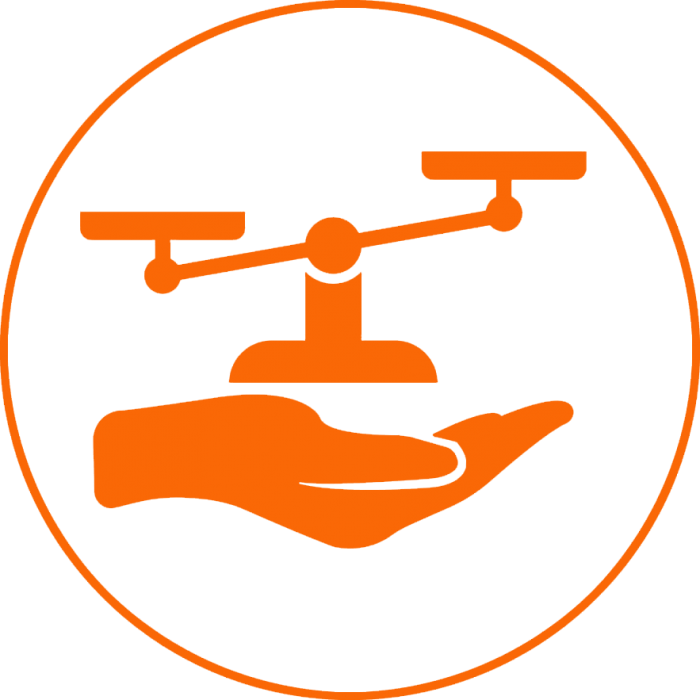
Responsibility and Ethics
We practice and promote sustainable and ethical tourism wherever we Travel & Treks.

Concern for Safety
We at Odyssey Treks always have the security of all our customers as a foremost priority at all times.

Affordable and discount price
We provide high-quality services at an affordable price, ensuring accessibility without compromising on value.

Staff insurance
Giving priority to safety, all our employees are insured by reputed insurance companies in Nepal.

100% satisfy customers
We have maintained a 100% satisfied customer record in all types of tourist activities by consistently prioritizing our excellent service.
Regd. No. 131741/071/072 WhatsApp No. 9861888201 +977-9841073239 [email protected]

Himalaya Darshan Treks Pvt. Ltd
"Experience Naturally Nepal With Us"
Kanchenjunga Base Camp Trek - 19 Days
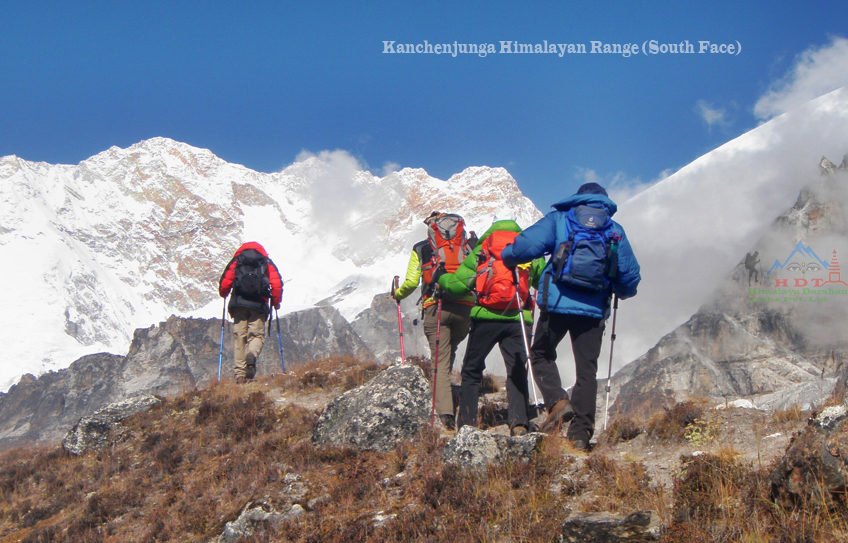
Per person - All price inclusive
- Trip Overview
- Includes/Excludes
- Trip Grade: Moderate
- Max-Altitude: 5,140m
- Best Season: Autumn and Spring
- Trip Mode: Tea House
- Group Size: Min 2+
- Destination: Kanchenjunga Region
“Trek to Kanchenjunga Base Camp: The Wilderness Trekking in Eastern Nepal”
Trek highlights.
- Magnificent flight from Kathmandu to Bhadrapur. The trip through the Ilam tea gardens for a scenic drive.
- Hike in a Rhododendron woodland (From March to May months are best for a Rhododendron view trek in Kanchenjunga).
- Amazing places for your day hikes to Dudh Pokhari and Ghunsa Viewpoint from Ghunsa. Likewise, Janu Viewpoint and Nupchu Pokhari from Khambachen.
- Your footsteps on the North and South Base Camps of Mt Kanchenjunga, with a wonderful view of Yalung Kang at 8,505 meters, Mt Kanchenjunga at 8,586m, Kanchenjunga Center at 8,473m, and Kanchenjunga at South 8,476m. As well as Khambachen Peak 7,902m and a plethora of other stunning alpine peaks.
- Hifetime adventure from Kanchenjunga high passes – Selela pass 4,200m , Mirgin la pass 4,720m, and Sinelapche la pass 4,640m
- Glacial Lakes, Kanchenjunga and Yalung Glaciers, Rivers, and Waterfalls.
- The Wildlife (Rare animals like Red pandas and Snow leopards).
- Enjoy the unique local culture and festival.
Kanchenjunga Base Camp Trek
The Kanchenjunga Base Camp Trek is beautiful as well as the best trekking destination in eastern Nepal. Mt Kanchenjunga 8,586m is the 3rd highest mountain in the world. We offer the Kanchenjunga Trek 19 Days Package. It helps to put your footsteps on the both base camp of Mt Kanchenjunga (the world’s 3rd highest mountain)
This beautiful trek passes across a variety of environments, from subtropical plains to breathtaking glacial plateaus at high altitudes. The lowlands are home to lush vegetation as well as unique cultural villages. Once the walk reaches a high altitude, it passes through some of the most beautiful alpine scenery on the planet.
The region’s main residents are the Limbu, Rai Gurung, Sherpa, and Tibetan Bhotiya, tribes. After passing through Khambachen on your way to Pangpema you’ll be rewarded with spectacular views of Mt Kanchenjunga. Likewise, Yalung Kang, Khambachen Peak, and stunning views of the Kanchenjunga Himalayan range and Glacier.
Kanchenjunga High Passes
You’ll return to Ghunsa Village and follow a different trail to Kanchenjunga South Base Camp. After a fantastic experience at Kanchenjunga North Base Camp. Then, to reach Ramche, you’ll have to cross the Sele La Pass 4,165 m , Mirgin la Pass 4,720m, and Sinelapche La Pass 4,640m, those are the high passes in the Kanchenjunga trek. We will day hike to South Base Camp from Ramche. This region is popular to see rare animals like Snow leopards and Red pandas.
Kanchenjunga Base Camp Trek Route:
There are two different sides to the start and end Kanchenjunga Base Camp Trek. ( Clockwise or Anti-clockwise ) Our 19-day Itinerary for this trek is clockwise. But we will organize the trek both clockwise and anti-clockwise. It depends on your choice or interest.
The Clockwise Trek Route starts from Sekathum and continues through Gyapla, Ghunsa, Khambachen, Lonak, and Pangpema (Kanchenjunga North Base Camp). After that, the trek descends to Ghunsa village and then follows the different valleys to reach the Kanchenjunga South base camp. via crossing three high passes like Sele La Pass, Mirgin La Pass, and Sinelapche Bhanjyang.
The KBC Trek Anti-Clockwise Route starts from Khebang or Sherpa Gaun and continues the trek to Kanchenjunga south base camp. Likewise, the trek continues Ghunsa village passing through 3 high passes. From the Ghunsa Village, the trek continues to Kanchenjunga’s north base camp then the same way descends and ends at Sekathum.
If our Kanchenjunga Base Camp Trek Itinerary (Clockwise) is not suitable. You can make a decision or choose a suitable route.
Kanchenjunga Base Camp Trek Difficulty
The Kanchenjunga Trek is graded as moderate to Strenuous . It is a beautiful trek in eastern Nepal. Kanchenjunga Region is an amazing place to visit. You can enjoy the incredible Himalayan vistas from the north and south base camp of Mt Kanchenjunga. Mainly the breathtaking view of the Kanchenjunga Himalayan range , Twins Peak, Nepal Peak, and Khambachen Peak. Likewise, Kumbhakarna (Janu Himal) Bhokta Peak, Rathong, Kabru range, and many other beautiful snow-capped mountains.
Kanchenjunga Base Camp Trek is an 18 to 21-day off-the-beaten-path trek. It is the remote part of eastern Nepal. The reason this trek is strenuous is that trekking to high altitude areas, crosses many ascend and descend , and some high passes around 5,000m. If there is snow on the way to Kanchenjunga High Passes , it will be more challenging. Kanchenjunga trek is best for your adventure trek and to experience real nature.
Kanchenjunga Base Camp Trek Best Time
The best time to trek to the Kanchenjunga base camp is from late September to December . The months of October, November, and December in Nepal are known for clear skies and breathtaking views of the Himalayas. March through May is another fantastic period to trek in Kanchenjunga Base Camp during the spring season; blooming rhododendrons make your trek amazing.
Kanchenjunga Trek Permit
Kanchenjunga region is a special area, which means no normal trekking routes like Everest, Annapurna, and Langtang. So you need a Kanchenjunga Trek Special Permit. It is only possible to apply the process from a Nepal government-registered Local Trekking Company to get a special permit. The requirement to get Permit – 1, must be at least two people in your group. 2, Need your original Passport with a valid visa from Nepal 3, Passport size photos. You need two types of permits to visit Kanchenjunga. 1, the Kanchenjunga Trek Special Permit and 2, the Kanchenjunga Conservation Entry Permit.
Food and Accommodation during the KBC Trek
Nowadays, it is possible to do a comfortable teahouse trek in Kanchenjunga. Before 6-7 years there are only possible to do a Camping trek. It was hard and expensive too. But now the teahouse trek is easy and cheaper, so it makes trekkers happy. All the Teahouses are owned by local people. The accommodation in this region is normal with twin beds. The toilets are on a shared basis but now at Ghunsa, there is a separate bathroom with a 24-hour running hot shower but only a few guest houses. The food is normal typical Nepali Dal Bhat and in most of the places you can choose food by menu which means they have many choices.
How to reach the Kanchenjunga Base Camp?
We will fly to Bhadrapur (Far East Terai region) and take a jeep to Kanyam (Enjoy the view of the beautiful tea garden) then the next morning continue the drive to Sekathum. After that, start our trek and continue to Kanchenjunga North Base Camp then trek back the same way to Ghunsa Village. From here, we will follow the different valleys, following the south base camp trek route. After the three high passes, we will continue the trek to the South base camp and then return to Khebang. This trek you can start from and to end north or south side. It depends on your choice. Also, you fly from Kathmandu to Suketar then a short drive to reach your trek starting point but there are no daily scheduled flights.
Kanchenjunga Base Camp Trek Cost
The cost depends on your group size and quality of services so different trekking companies offer this trek with various costs. We at Himalaya Darshan Treks offer a 19-day full board package that costs USD 1865 per person . Likewise, we also offer budget packages. Like the Budget Kanchenjunga Base Camp Trek package with the cost USD 1275 per person .
Tips for a Successful Trek
Physical Fitness: Prioritize physical and endurance training to prepare for extreme trails and altitudes. Acclimatization : Get enough rest, drink enough water, and acclimatize to avoid altitude sickness and enjoy a safe climbing experience.
Equipment: Bring the necessary gear, clothing, and gear suitable for hiking, including a sturdy pair of hiking shoes.
Local guides: Always travel/trek with local companies for your safety, navigation, and cultural knowledge.
Responsible Tourism: Respect the environment, local communities, and their customs while trekking in the Kanchenjunga region.
In conclusion, the Kanchenjunga Base Camp Trek is a life-changing experience that brings trekkers closer to nature, tests their physical and mental strength, and leaves them with lasting memories of one of the most stunning regions on Earth. It is a journey that leaves a profound impact and a desire to explore more of the world’s natural wonders and to follow your footsteps on the base camp of 3rd highest mountain in the world.
FAQS for Kanchenjunga Base Camp Trek
What is the highest altitude of kanchenjunga base camp trek.
The highest altitude of the Kanchenjunga base camp trek is the north base camp (Pangpema 5140 meters). Likewise, the second highest point is the south base camp (Okhtang 4810m). There are North and South two base camps of Mt Kanchenjunga during this trek.
What are the names of the 3 high passes in Kanchenjunga Base Camp Trek?
The three high passes during the Kanchenjunga base camp trek are Sele La Pass 4200m, Mirgin La Pass 4720m , and Sinelapche Bhanjyang (4,640m). These passes are adventurous and more challenging when there is snow on the way.
Do I get altitude sickness on the Kanchenjunga Base Camp Trek?
Might be, when you will do trekking above 3000 meters. There will be high chances of altitude sickness. So always be aware of the risks of Altitude Sickness . Follow the necessary precautions such as walking slowly, acclimatization, and staying hydrated (Drinking enough water). It plays a big role in the success of your trek. This trek is also riskier for the altitude so necessary to have a good experience with high-altitude trekking. But don’t worry our experienced guide is with you.
How long does it take the Kanchenjunga Base Camp Trek?
Normally, 19 to 21 days is enough to complete this trek. We offer the Kanchenjunga base camp trek 20-day itinerary and package. You will enjoy the incredible mountain views of Mt Kanchenjunga, Yalung Kang, Kumbhakarna (Janu Himal), and Khambachen Peak. Likewise, Wagde Peak, Twins Peak Nepal Peak, Kirat Chuli, Pathivara Peak, and surrounding peaks. High passes, Glaciers, Glacial lakes, unique culture, rare wildlife, red pandas, and snow leopards.
Can I customize the Kanchenjunga BC Trek Itinerary?
Of course, you can customize your trek itinerary. Normally, 19 to 21 days is enough to complete this trek. If you do not have enough time, there are other possibilities; you can do the Kanchenjunga north base camp or the south base camp for the Kanchenjunga short trek. We hope it will meet your needs and match your time frame.
Is the Kanchenjunga Trek Difficult?
The Kanchenjunga Trek is moderately challenging in categories. The circuit trek is a challenging trekking route in the Kanchenjunga region. It will be better to have a physical fit and experience about high altitude trek. It helps you to the success of your Kanchenjunga base camp trek. This trek route is also known as the high passes trek and the highest altitude of this trek is Base Camp 5140 meters. The high passes are such an adventure and difficult to walk when snow is on the way.
Do we need a Permit for the Kanchenjunga Trek?
Of course, you need two types of permits to do the Kanchenjunga trek, you need a Kanchenjunga trek Special permit and a Kanchenjunga conservation entry permit with these permits you are allowed to visit the Kanchenjunga Region Treks.
How much does the Kanchenjunga Trek Permit Cost?
A special permit is required for the Kanchenjunga Region Treks. The Kanchenjunga trek Special Permit costs $20 p/p per week for the first 4weeks. KCAP entry permit cost is NRs 2000 p/p per entry. You need a special permit for 2 weeks.
What is the Best Time to Do Kanchenjunga Trek?
The best time for the trek to Kanchenjunga Base Camp is spring ( March to May ) and autumn ( September to November ), when the weather will be clear and you can enjoy the breathtaking mountain views. Likewise, the autumn season is festival time so you can enjoy seeing the local and national festivals. It makes your trek more pleasant.
What about Communication/Network in Kanchenjunga Trek?
The good news, most of the places in the Kanchenjunga region have mobile networks now. Ghunsa village has a mobile network of Nepal Telecom. So you can send text messages and 2g also working. Likewise, Ghunsa has wifi so you can call/chat with your friends and family.
Is there Electricity in the Kanchenjunga Region Treks?
Yes, Sekhthum and, Ghunsa have micro hydropower while most other places will have solar power. So highly recommend bringing it back up to charge your phone and camera. The backup can be charged where there is good electricity mostly in Ghunsa village . Also, you can charge solar power at the teahouse where there is good power.
Can we get an ATM at Kanchenjunga Base Camp Trek?
No there is no ATM or Bank along the Kanchenjunga base camp trek. The last ATM you can get is Phungling Bazaar (Taplejung) So you need to take enough cash from Kathmandu or Taplejung for your trek and peak climbing in this region.
How to book this trip with Himalaya Darshan Treks?
To book this trip or for more inquiries, you can click Book this trip from our web page. Likewise, we have many different trekking and tour packages so you can choose your most suitable trek with us. We suggest early booking so you have enough time to prepare for the trek. We are ready to organize your travel bucket list trek. You can also contact us by WhatsApp at +977 9841073239 for quick inquiries.
Day 1, Arrival in Kathmandu Airport (1,400m) and transfer to hotel
We, Himalaya Darshan Treks warmly welcome you and your group to Nepal. One of our company staff will take you to your hotel in Kathmandu. The person will be waiting outside the baggage hall of the Tribhuwan International Airport, Kathmandu, holding an A4-size paper with your name and our company name . So, you have to look for that person for your pick up from the airport. Your check-in at the hotel .
Day 2, Free Day or Sightseeing in Kathmandu
Your free day or sightseeing in Kathmandu. This day is required to make Kanchenjunga Base Camp Trek special permit with your original passport. Trek briefing and meet your guide.
Day 3, Flight to Bhadrapur and Drive to Kanyam. Stay at hotel.
Your guide pick you up from your hotel to the domestic airport. Scenic flight from Kathmandu to Bhadrapur (45 minutes) and Drive to Kanyam. Explore and enjoy the beautiful view of the tea garden. Stay at the hotel.
Day 4, Drive to Sekathum. Stay at tea house.
Early morning, we will start to drive to Ranipul via Suketar. To get Sekathum , we’ll have to cross two suspension bridges over the Tamor River, which is only a 40-meter walk. After crossing the second bridge we will leave Tamor Valley and we will have to follow the Ghunsa River valley . Stay in the teahouse
Day 5, Trek to Amjilosa (2,498m). Stay at tea house.
After the breakfast at hotel, we will have to start our trekking to Amjilasa . This day is walking through the Ghunsa river valley so we need to cross several times the Ghunsa Khola . After crossing the last bridge we have to climb uphill through the narrow trail to reach Amjilasa. There is just 2 tea house. Stay at a teahouse.
Day 6, Trek to Gyabla (2725m). Stay at hotel
This day is also a beautiful day, with a trail leading up through an oak, bamboo, and rhododendron forest . The journey is notable due to the steep ascent and descent, as well as the passing of some beautiful waterfalls on the way to Gyabla. We will have to stop at Jungle Camp for lunch and then continue to Gyabla . Stay at the hotel.
Day 7, Trek to Ghunsa village (3,415m). Stay at hotel
After breakfast, we will start our journey to Ghunsa village. Following the right bank of the Ghunsa River Valley. Before entering the Ghunsa, the trail passes through a big grazing area and Foley Village . we will stop here for lunch. After lunch continued our easy walking to Ghunsa village . It is a very beautiful small village. There are nice guest houses and delicious food, a Coffee shop. The Ghunsa people welcome you with warm hospitality. Stay at a teahouse.
Day 8, Trek to Khambachen (4,146m), Stay at tea house.
Trek to Khambachen (4,146m) , Enjoy seeing beautiful views of Ghabur Peak (6,305m), Pholesobi Peak (6,652m), and Janu Himal (7,710m) (Kumbhakarna) and surrounding views. Stay at a teahouse.
Day 9, Acclimatization Day,
Today is your acclimatization day. So you have 2 options for your day hikes
The first option – After breakfast, hike to JanuView Point 4,420m . Enjoy the great view of, glaciers, Glacial lakes as well as Janu Himal just in front of you.
The second option is early in the morning breakfast at the hotel, You will start your day hikes to Nupchu Pokhari (Lake) through the Nupchu Khola Valley . It is hard walking due to the high altitude but very beautiful and amazing day hike.
Day 10, Trek to Lhonak (4,795m), stay at tea house.
The day begins with a short ascent out into the narrow valley, passing along a stony glacier track, which passes through an eroded portion before continuing into the narrow valley.
A short ascent leads out into a broader valley, with views of Kanchenjunga 8,586m, Yalung Kang 8,505m, and Kangbachen 7,905m opening up after passing by a waterfall.
For the next hour, the trail is more comfortable until it climbs into a small valley via another degraded part before rapidly crossing the river that leads to Lhonak . Stay at the tea house.
Day 11, Hike to Pangpema (5,140m). And trek back to Lhonak. Stay at tea house
Early morning start hike to Pangpema (5,140m) (Kanchenjunga North Base Camp). Enjoying great views of Mt Kanchenjunga (8,586m), Yalung Kang (8,505m) (Kanchenjunga west), and beautiful Himalayan panorama, Kanchenjunga glacier, Blue sheep, etc. And trek back to Lhonak. Stay at the tea house.
Note: If you have a dream to hike Dormo Ri (Dormo Peak) you have to stay at the Pangpema. And next early in the morning hike to Dormo ri, enjoy the incredible Kanchenjunga Himalayan panorama then descend to Lhonak.
Day 12, Trek back to Ghunsa village (3,415m). Stay at hotel
Same way back down the trail when we ascend. Stay at the tea house.
Day 13, Trek to Sele La Camp (4,200m), Stay at tea house.
Our hike begins in the direction of Kanchenjunga’s south base camp, walking through a huge forest before the Bhanjyang. Via Sele La Pass, we will continue to reach Sele La Camp . with only a very rudimentary tea house at Sele La. In this section of the Kanchenjunga Base Camp Trek. Some hikers have seen snow leopards around here. Stay at the tea house.
If you don’t have enough time, You can do it directly from Ghunsa to Cheram.
Day 14, Trek to Cheram (3,870m). Stay at the tea house
Trek to Cheram (3,870m) via Mirgin La Pass (4,720m) , and Sinelapche Bhanjyang (4,640m). You can enjoy incredible views of Janu Himal, Mt Makalu 8,463m, and Bharuntse Himal from the Mirgin La top. Likewise, Views of Rathong Peak, Kabru Himalayan range, and Kanchenjunga south range from the Sinelapche La Pass (4,650m). From the Sinelapche la pass we will all the way descend to Cheram.
Day 15, Trek to Ramche (4,610m), Stay at tea house.
The day begins with a fairly difficult rise, and after the first half-hour of steep climbing, the valley opens up. The trail travels through various pasturelands, including one with a yak shed. (The shed is moved according to the seasons) Views of Rathong Peak (6,678 m) and Kokthang (6,148 m) arrive after the first meadow. After the first two meadows, the trail becomes very easy, and Ramche is found on the third meadow, immediately beneath a massive ridge, on the level territory. Stay at a tea house.
Day 16, Hike to Okhtang (4,810m) and back to Tortong (2,980m). Stay at the tea house
Hiking to Okhtang (4,810m) (Kanchenjunga South Base Camp). Enjoy Spectacular views of Mt Kanchenjunga Himalayan range, Khambachen Peak, Kabru Himalayan Range, and Rathong Peak. As well as Yalung Glacier, Glacial lakes, Wildlife, Blue sheep, etc. Trek back to Tortong (2,980m). Stay at a teahouse.
If you have enough time, you can stay at Cheram for the night.
Day 17, Trek to Sherpa Gaun. Stay at teahouse.
We will cross the river and after a few minutes of walking, we will start to climb uphill through the nice jungle. enjoying seeing many birds and wildlife. To reach Bhanjyang (Little pass) then our trek all the way descend to Lasiya Bhanjyang . we will enjoy the mountain view of Kumbhakarna and the range from here. we will have lunch here. After lunch, our trek descends to Sherpa Gaon ( Yamphuding ). It is a small and beautiful Sherpa village. Stay at a teahouse.
Day 18, Trek back to Khebang. Stay at tea house.
The trail passes through many beautiful villages and terraced fields to reach Khebang . Today is your last day of walking this beautiful trek. Stay at a teahouse.
Day 19, Drive to Kanyam or Ilam Bazaar. Stay at the hotel.
We will take a Jeep to drive to Kanyam or Ilam Bazaar. It will be a nice and scenic drive. Stay at the hotel.
Day 20, Drive to Bhadrapur and flight to Kathmandu. Transfer to hotel
Short drive to Bhadrapur , Then, we are back to Kathmandu on a 45 minutes scenic flight, with our final views of the spectacular snow-capped Himalayas. Kanchenjunga Base Camp Treks will return you to your accommodation and will pick you up this evening for a goodbye meal with a cultural performance at a Nepalese restaurant.
Day 21, Final Departure
This will be the last day of your trip to Nepal. One of our staff will take you and your group to Tribhuwan International Airport, Kathmandu for your final departure. We wish you and your group safe flights with unforgettable memories from your Nepal trip. Hope to see you again.
Trip Includes
- Airport pick up and drop by private vehicle (Domestic/International).
- 3-night hotel in Kathmandu with bed and breakfast, twin sharing.
- Both-way flights from Kathmandu to Bhadrapur to Kathmandu.
- Both-way Flight for the guide.
- Experienced and government-licensed holder Guide, a porter with salaries, food, accommodation, and Insurance (1 porter for 2 trekkers).
- Drive from Bhadrapur to Kanyam to Yamphuding and Sekathum to Ilam to Bhadrapur by private Jeep.
- Teahouse accommodation and 3 times meals during the trek (Breakfast, Lunch, Dinner, and one cup of tea/Coffee with a meal.)
- Kanchenjunga base camp trek special permit.
- Kanchenjunga conservation entry permit.
- All government and local taxes.
- First Aid medical kit, Oximeter to check pulse, heart rate, and oxygen saturation at higher altitude
- Emergency Helicopter service arrangement (If needed) which will be paid by your Travel Insurance Company.
- We will arrange a Duffel bag, Sleeping bag, Down Jacket, and warm hat (If you don’t have your own.)
- Himalaya Darshan Treks branded T-shirt and as a souvenir.
- Kanchenjunga base camp trek map for a group.
- Trip achievement certificate.
- Farewell dinner in Kathmandu with a culture program.
Trip Excludes
- Lunch and Dinner in Kathmandu.
- Extra night accommodation in Kathmandu than the scheduled itinerary.
- Your expenses (Laundry, bar bills, battery recharge, bottle or boiled water, hot shower, etc.)
- Tips for staff and drivers. (Tips are expected).
- Delay due to weather.
- Your travel and medical insurance. (Necessary)
- Nepal entry visa fees
- Desserts Sweet things like chocolate, cake, pie, pudding, etc.
- Any other expenses that are not mentioned in the cost include.
- Sightseeing in Kathmandu.

Photo Gallery
Responses & ratings, 2 replies to “kanchenjunga base camp trek”.
I have just completed a 26 days trek in the Kanchenjunga area, Eastern part of Nepal, with Gyan Katuwal, known to us as GB Katuwal, as our Guide/Sirdar. i was member of a 6-person group conducting engineering, health and education work for the Kanchenjunga School Project. Organization for our group was complex. We carried extra supplies for the project work and spent several days working along the route. GB speaks English and assisted with the project work and provided language translation during our workdays and ensured that we were well supported in each village. GB had a strong sense of responsibility towards our group and supported each person individually. I personally experienced his support during a difficult climb of Deorali Danda early in the trek. His manner is professional and he is respectful of his clients, always reliable and quietly good company. He is honest and forthright, essential qualities in a guide/sirdar. In turn GB is respected by the porters, kitchen staff and assistant guides. He managed the team very well to accommodate our needs. I happily recommend GB Katuwal as a Guide/Sirdar. I can answer, questions and confirm this reference by return email.
This was my first experience with GB and his crew and I can honestly say I was most impressed with the entire experience. I have had extensive experience both trekking and climbing in Nepal, so am no neophyte, and am not easily impressed; nonetheless GB exceeded all my expectations on what services a company should provide. In addition, apart from being 73 years old I have multiple medical issues that include bilateral knee replacements, a shoulder replacement, aortic valve replacement, amputations of all fingers and toes, making trekking a challenge, yet the itinerary was planned in such a way I was never taxed physically, and we reached our goals comfortably. This gives me the confidence to plan a trip in the future with my grandchildren, ages 11 and 8. Thank you GB you are a gem!!
Leave a Reply Cancel reply
Save my name, email, and website in this browser for the next time I comment.
Fixed Departures
Related packages.
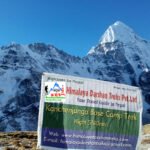
Budget Kanchenjunga Base Camp Trek - 18 Days
Are you planning to visit the Kanchenjunga region and looking for a...
- Max-Altitude: Pangpema-5140mm
- Group Size: Min 1+
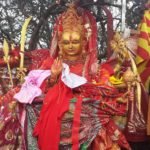
Pathivara Pilgrimage Trek - 9 Days
Pathivara Devi (Shrine) is a prominent pilgrimage site where devotee can realize...
- Max-Altitude: 3,795m
- Group Size: Min 02
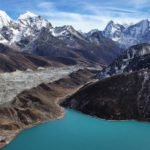
Gokyo Lake Trek - 13 Days
Nepal is a trekking paradise and offers a plethora of climbing routes that will...
- Max-Altitude: Gokyo Ri 5360m
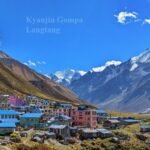
Langtang Gosaikunda Trek - 13 Days
The Langtang Gosaikunda Trek is a well-known trekking route in Nepal. Set...
- Max-Altitude: 4,610m
Book Kanchenjunga Base Camp Trek Now
Select Country Afghanistan Albania Algeria Andorra Angola Anguilla Antigua & Barbuda Argentina Armenia Australia Austria Azerbaijan Bahamas Bahrain Bangladesh Barbados Belarus Belgium Belize Benin Bermuda Bhutan Bolivia Bosnia & Herzegovina Botswana Brazil Brunei Darussalam Bulgaria Burkina Faso Myanmar/Burma Burundi Cambodia Cameroon Canada Cape Verde Cayman Islands Central African Republic Chad Chile China Colombia Comoros Congo Costa Rica Croatia Cuba Cyprus Czech Republic Democratic Republic of the Congo Denmark Djibouti Dominican Republic Dominica Ecuador Egypt El Salvador Equatorial Guinea Eritrea Estonia Ethiopia Fiji Finland France French Guiana Gabon Gambia Georgia Germany Ghana Great Britain Greece Grenada Guadeloupe Guatemala Guinea Guinea-Bissau Guyana Haiti Honduras Hungary Iceland India Indonesia Iran Iraq Israel and the Occupied Territories Italy Ivory Coast (Cote d'Ivoire) Jamaica Japan Jordan Kazakhstan Kenya Kosovo Kuwait Kyrgyz Republic (Kyrgyzstan) Laos Latvia Lebanon Lesotho Liberia Libya Liechtenstein Lithuania Luxembourg Republic of Macedonia Madagascar Malawi Malaysia Maldives Mali Malta Martinique Mauritania Mauritius Mayotte Mexico Moldova, Republic of Monaco Mongolia Montenegro Montserrat Morocco Mozambique Namibia Nepal Netherlands New Zealand Nicaragua Niger Nigeria Korea, Democratic Republic of (North Korea) Norway Oman Pacific Islands Pakistan Panama Papua New Guinea Paraguay Peru Philippines Poland Portugal Puerto Rico Qatar Reunion Romania Russian Federation Rwanda Saint Kitts and Nevis Saint Lucia Saint Vincent's & Grenadines Samoa Sao Tome and Principe Saudi Arabia Senegal Serbia Seychelles Sierra Leone Singapore Slovak Republic (Slovakia) Slovenia Solomon Islands Somalia South Africa Korea, Republic of (South Korea) South Sudan Spain Sri Lanka Sudan Suriname Swaziland Sweden Switzerland Syria Tajikistan Tanzania Thailand Timor Leste Togo Trinidad & Tobago Tunisia Turkey Turkmenistan Turks & Caicos Islands Uganda Ukraine United Arab Emirates United States of America (USA) Uruguay Uzbekistan Venezuela Vietnam Virgin Islands (UK) Virgin Islands (US) Yemen Zambia Zimbabwe
Booking For Fixed Departure
[recaptcha]
Customize Trip
[datetime* arrival-date class:form-control date-format:mm/dd/yy time-format:HH:mm placeholder "Planned Arrival Date"]
Subscribe Us Now
Stay updated with our news and events.
- +9779851276377
- 977 01 5348594
- [email protected]
- Follow us on:
Kanchenjunga Trek
View of kumbhakarna from shyala la, mirgin la pass, pangpema, north base camp, you can also, things to know before trip, trip introduction.
Mt. Kanchenjunga is the third highest Himalaya in the world after Everest and K2 stands tall at an altitude of 8,586 meters above sea level. And our Kanchenjunga Trek allows you to experience this Himalaya along with its nature and surroundings in close proximity. It is actually an opportunity to explore the unexplored and travel through an off-the-beaten trekking route in eastern Nepal . Mostly en route, we always get great views of the Himalayas above 8,000 meters with neighboring peaks. And this trek is also topographically diversified which makes it home to varied wildlife and endangered species. For instance, Musk Deer, Snow Leopard, Red Panda, and other habitats.
Overview of Kanchenjunga Trek
Among other Kanchenjunga trek itineraries available to discover around Kanchenjunga, the most feasible, as well as best alternatives for this trek, is beginning from Suketar then trekking to Ghunsa and Kanchenjunga North Base Camp then retracing back to Ghunsa and traversing Sele Le Pass eventually explore south base camp at Ramche and descend to Birtamod instead of Suketar. The time required for encircling this circuit trek is 24 days. But in total including Kathmandu sightseeing and preparations like taking permits will make it 27 days of exciting trekking adventure.
Who can join this trek and how?
Kanchenjunga Trek can be done entirely as a lodge trek in September-October-November and in March-April-May. Particularly at higher altitudes, some lodges remain closed at the start and end of this main season. We also organize professional camping trekking as per the client’s requirements.
Kanchenjunga Trek requires a good level of physical fitness with love and an adventurous attitude to explore rugged trails from jungles to glaciers. Join this amazing trek with Nepal Mountain Trekkers for professional management and an organized trekking adventure. Contact us now for further inquiries. Simply fill out the Booking form and let us know about your interest. Or you can contact us directly by sending us an email in order to get more information about this trek.
If this itinerary doesn’t suit your requirement or if you want to customize it, please feel free to contact us. This trek could be customized as per your required time frame and budget limits.
- Day 1 Arrival in Kathmandu and transfer to hotel::
- Day 2 Kathmandu sightseeing and trek preparation::
- Day 3 Drive from Biratnagar (80 m/260 ft)to Phidim (1,756m / 5,761ft), after Kathmandu to Biratnagar via a flight:
- Day 4 Further take a drive from Phidim to Suketar (2,419 m/7,936 ft):
- Day 5 Trek from Suketar to Mitlung (996m/3,267ft):
- Day 6 Trek from Mitlung to Chirwa (1,270m/4,166ft) with many quick uphill and downhill trails:
- Day 7 Trek from Chirwa to Sekathum (1,660m/5,446ft):
- Day 8 Trek to Sekathum to Amjilosa (2,510m/8,234ft):
- Day 9 Trek from Amjilosa to Gyabla (2,730m/8,956ft):
- Day 10 Trek from Gyabla to Ghunsa (3,595m/11,794ft), most developed settlement of northern side of Kanchenjunga:
- Day 11 Acclimatization day in Ghunsa for adaptation with the high altitude of Kanchenjunga North Base Camp:
- Day 12 Trek from Ghunsa to Kambachen (4,100m/13,451ft):
- Day 13 Acclimatization day in Kambachen:
- Day 14 Trek from Kambachen to Lhonak (4,785m/15,698ft):
- Day 15 Trek from Lhonak to Pangpema (Kanchenjunga Base Camp North - 5,200m/17,060ft):
- Day 16 Trek from Pangpema to Kambachen:
- Day 17 Trek from Kambachen to Ghunsa (3,595m/11,794ft):
- Day 18 Trek from Ghunsa to Sele Le (4,310m/13,549ft):
- Day 19 Trek from Sele Le to Cheram (3,868m/12,696ft):
- Day 20 Trek from Cheram to Ramche (4,610m/15,124ft) and back to Cheram (Ramche is Kanchenjunga South Base Camp):
- Day 21 Trek from Cheram to Tortong (2,995m/9,826ft):
- Day 22 Trek from Tortong to Yamphuding (2,080m/6,824ft):
- Day 23 Trek from Yamphuding to Yangpang (1,007m/3,304ft):
- Day 24 Trek from Yangpang to Thorpu (1,500m/4,290ft):
- Day 25 Drive from Thorpu to Birtamod (300m/1,000ft):
- Day 26 Drive from Birtamod to Bhadrapur and fly back to Kathmandu:
- Day 27 Departure Day:
Detail Itinerary
Day 1 : Arrival in Kathmandu and transfer to hotel:::
As you arrive at the capital city, Kathmandu, you will be met by a representative from Nepal Mountain Trekkers at International Airport terminals and he will take you to your respective hotel ( Hotel Green Horizon or similar standard). After checking into a hotel, you can enjoy the free time relaxing in the cozy room or stroll around the tourist hub Thamel area until the end of the day.
Day 2 : Kathmandu sightseeing and trek preparation:::
After having our early meal, we start our day with a visit to the Nepal Mountain Trekkers office at Thamel. After being introduced to our team including tour guide, trekking leader, and director of operations, we head for necessary trekking preparations, getting needed equipment with the initiation of Kathmandu sightseeing around world heritage sites. Kathmandu Durbar Square, Swayambhunath Stupa, Pashupatinath temple, and Boudhanath Stupa are UNESCO world heritage sites that we explore till sunset. Overnight stay at a hotel in Kathmandu. B included.
Day 3 : Drive from Biratnagar (80 m/260 ft)to Phidim (1,756m / 5,761ft), after Kathmandu to Biratnagar via a flight::
Initially, we board our domestic flight from Kathmandu to Biratnagar. Upon arrival at Biratnagar, we have our lunch followed by a drive to Phidim. In this way after taking a flight and drive on the first day out of Kathmandu valley, we take rest overnight at Phidim.
Day 4 : Further take a drive from Phidim to Suketar (2,419 m/7,936 ft)::
Likewise a day earlier, we take a drive from Phidim to Taplejung early in the morning which is also the starting point of our trekking activity. We gear up with our trekking crew and start ascending towards Suketar where there is also a small airstrip with basic teahouses. We stay overnight at Suketar.
Day 5 : Trek from Suketar to Mitlung (996m/3,267ft)::
Today we will be heading at rough off the beaten path of our Kanchenjunga trail, initially, we walk through the pasture land, walk downhill trails crossing many colorful settlements along the tracks. We leave behind Tamur River and make our way towards Mitlung. We stay overnight at Mitlung.
Day 6 : Trek from Mitlung to Chirwa (1,270m/4,166ft) with many quick uphill and downhill trails::
We arrive at a beautiful village inhabited by Limbu, Rai, Gurung, and Chirwa communities who will welcome us with an open heart. With quite a number of quick ascend and descends, we gradually arrive at Thiwa. Cross suspension bridges and finally arrive at Chirwa for an overnight stay.
Day 7 : Trek from Chirwa to Sekathum (1,660m/5,446ft)::
Today after having our early meal, we make our way crossing greenery, enjoying the walk along with vegetations gradually gain some altitude at the end of the day. We stay overnight at Sekathum which is considered an ideal place for a night halt.
Day 8 : Trek to Sekathum to Amjilosa (2,510m/8,234ft)::
Following mostly the ascending trails through beautiful yet challenging gorges, jungle walks, we finally arrive at Amjilosa. However, a gradual and careful walk following the instructions of the guide will be helpful. Your trekking stick will come in handy on this day while you are making your way towards Amjilosa for an overnight stay.
Day 9 : Trek from Amjilosa to Gyabla (2,730m/8,956ft)::
Following the excellent views of striking waterfalls, walking through beautiful forests, trekking along with Tibetan settlements we finally arrive at Gyabla. We also witness blossoming rhododendron forests during spring, which is also the national flower of Nepal. In this way, we completely immerse ourselves in the natural beauty that features across the trails.
Day 10 : Trek from Gyabla to Ghunsa (3,595m/11,794ft), most developed settlement of northern side of Kanchenjunga::
Today after having our early meal, we get an exclusive chance to explore the local village inhabited by Sherpa communities. It is quite a large local settlement compared to nearby ones at Kanchenjunga trekking trails. On our course to Ghunsa valley, at a place called Phaley, Tibetan refugees are settled. And in just about a couple of hours of walking, we finally arrive at Ghunsa.
Day 11 : Acclimatization day in Ghunsa for adaptation with the high altitude of Kanchenjunga North Base Camp::
To avoid altitude sickness, it is recommended that we take proper acclimatization at every 600 meters of altitude gain and we take Ghunsa as our acclimatization point before we gain further altitudes. During the rest day, we visit around the Lapsang La and nearby monasteries so that our body adapts according to the high-altitude surroundings.
Day 12 : Trek from Ghunsa to Kambachen (4,100m/13,451ft)::
Today we face quite a bit of challenge while heading from Ghunsa to Kambachen. There will be a couple of landslide-prone areas we have to cross. We make our way through beautiful rhododendron and pine forests too. Today, our fitness will also be tested. However, we get excellent views of Mount Kumbakarna which will be a rewarding experience.
Day 13 : Acclimatization day in Kambachen::
Today will be another day for acclimatization during Kanchenjunga Trek. It will help our body gets familiar with changing altitudes and makes it easy during further trekking ascents. At above 4000 meters, we should take care of ourselves that we are not showing any symptoms of acute mountain sickness. In this way, walking taking precautions, we continue our Kanchenjunga Trek.
Day 14 : Trek from Kambachen to Lhonak (4,785m/15,698ft)::
Today we wake up early in the morning and head towards Lhonak from Kambachen. There will be plenty of obstacles today. Avoiding the landslides prone areas, we quickly cross that site and finally arrive at Lhonak for an overnight stay.
Day 15 : Trek from Lhonak to Pangpema (Kanchenjunga Base Camp North - 5,200m/17,060ft)::
We walk through the glacier moraines today in our Kanchenjunga Trek as we cross the rocky part of our trekking trail. Upon arrival at Pangpema, we stay at stone hut and hike a little further up to enjoy magnificent views of glaciers and Kanchenjunga’s north ridge. It will be the most important day of our trek as we finally step at Kanchenjunga Base Camp from the northern side.
Day 16 : Trek from Pangpema to Kambachen::
We descend today and lose altitude quite drastically than in former days. After having our early meal, we start our downhill trekking starts gradually to Kambachen. With whole lots of wonderful memories, we leave Kanchenjunga North Ridge behind.
Day 17 : Trek from Kambachen to Ghunsa (3,595m/11,794ft)::
Today, we again step downhill towards Ghunsa from Kambachen enjoying the natural and cultural essence during our Kanchenjunga trekking journey. We feel quite relaxed while descending down the trails.
Day 18 : Trek from Ghunsa to Sele Le (4,310m/13,549ft)::
Today we arrive at the stone hut at Sele Le, where we will be camping. It is the most isolated area in Kanchenjunga Trek and we also might get a chance to spot a snow leopard. We will not be strolling around outside after sunset. Will be quite an adventurous day.
Day 19 : Trek from Sele Le to Cheram (3,868m/12,696ft)::
Testing our fitness level, we cross the high altitude pass at top of Sele Le Pass (4,290m/14,074ft) in the Southern hemisphere of Kanchenjunga. From here, we get excellent views of Makalu and other surrounding peaks. In this way, we trek steeply downhill towards Cheram.
Day 20 : Trek from Cheram to Ramche (4,610m/15,124ft) and back to Cheram (Ramche is Kanchenjunga South Base Camp)::
After having our early meal, we visit Oktang Monastery and trek from Cheram to Ramche which is a dead-end or also known as Kanchenjunga’s south base camp and we get back to Cheram at the end of the day. Today we start our day quite early, cross the Yalung glacier too.
Day 21 : Trek from Cheram to Tortong (2,995m/9,826ft)::
After we cross towards Sele le pass, we make our way towards the left ridge trail and downhill trekking towards Tortong which is covered by lush green forests and the Simuwa river. We will arrive at Tortong and stay overnight over there.
Day 22 : Trek from Tortong to Yamphuding (2,080m/6,824ft)::
Yamphuding is the biggest village we explore during our Kanchenjunga trek where the air is full of oxygen. While trekking from Tortong to Yamphuding, we also get a chance to encounter the local Limbu Museum, a culture center, cross through beautiful forests. It will be a great exploration opportunity of both natural and cultural highlights today.
Day 23 : Trek from Yamphuding to Yangpang (1,007m/3,304ft)::
To make the lower altitude trekking short, we head from Yamphuding to Yangpang instead of going back towards Taplejung. Along the day’s course of the journey, we pass through beautiful terraced farmlands, local settlements and finally arrive at Yangpang.
Day 24 : Trek from Yangpang to Thorpu (1,500m/4,290ft)::
Today is the last day of trekking activity in our Kanchenjunga Trek. We walk through large farmlands, on the eastern side of Nepal. We finally arrive at Thorpu and stay overnight.
Day 25 : Drive from Thorpu to Birtamod (300m/1,000ft)::
Today we take a drive from Thorpu to Birtamod, which is a popular local city of eastern Nepal well connected with roads and highways.
Day 26 : Drive from Birtamod to Bhadrapur and fly back to Kathmandu::
Today we take about an hour’s drive through the fertile terai lands of Nepal from Birtamod to Bhadrapur airstrip and board an hour flight that takes us back to Kathmandu. Upon arrival at Kathmandu, you will be met by our director of operations, Mr. Dhakal, and offer you a farewell dinner as a complimentary token of love from Nepal Mountain Trekkers Company.
Day 27 : Departure Day::
Today will be your final day in Nepal, as we drop you at International Airport for your scheduled international flight towards your onward destination.
Price Includes
- Airport pick up and drop
- 3 nights Hotel in Kathmandu ( Hotel Green Horizon or similar standard)
- Sanitation: The accommodation we provide will be neat and clean with warm-hospitality and quality services.
- Single Accommodation: You won’t have to share your accommodation with anyone else so that your privacy is protected.
- We provide hygienic and safe meals to re-energize you.
- We request you not to waste your meals for it is difficult to transport food in the rural area.
- You are not allowed to share your meals with anyone else from another group.
- Domestic flights (KTM-BRT, BDP-KTM) and Private Vehicle/Bus as mentioned in the itinerary
- Local Staffs: Our guides are locals of the region which ensures that you will surely get to explore a bit more during the trek than with any other guides.
- Experienced: With an experience of more than a decade of working in this field, our trekking guides possess excellent knowledge on briefing during the trek as well as they are experts in handling all kinds of critical situations that might occur during the trek.
- Insurance: Nepal Mountain Trekkers have an insurance policy for all our trekking staff.
- Local Staffs: The porters we hire belong to the same region where we trek in order to provide employment opportunities to the locals as well as to make you explore every prospect of the region.
- Four seasonal sleeping bags, down jacket, Nepal Mountain Trekkers duffer bag, t-shirt, and trekking map (Note: down jacket and sleeping bag are to be returned after trip completion)
- TIMS Card , Conservation Area Permit , and Special Kanchenjunga Permits.
- Rescue arrangement service
- A comprehensive medical kit
- 13% Tax and 10% service charges.
- Farewell dinner
Price Excludes
- Visa fee to enter Nepal ( Visa Information )
- International flight tickets and extra baggage charges
- Food in Kathmandu
- Extra night accommodation and meal costs in Kathmandu due to any change in the scheduled itinerary
- Travel insurance / Rescue operation costs
- All personal expenses(internet, laundry, battery charge, donation, etc)
- All soft drinks and alcoholic beverages
- Tips for guide and porters
Trip Gallery
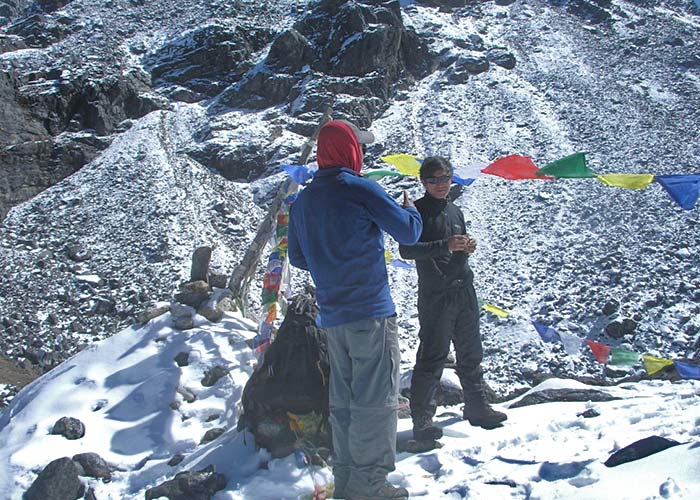
- Sun hat or scarf
- Light balaclava or warm fleece hat
- Suncreams(40+) and Lip Balms
- Cotton t-shirts and thermals
- Fleece jacket
- Waterproof jacket
- Down jacket
- Lightweight cotton pants (long)
- Waterproof pants
- Inner thermals
- Thin inner socks (3 pairs)
- Thick, warm wool hiking socks
- Comfortable hiking boots
- Shower sandals
- Gloves (Cotton and Waterproof)
Accessories
- Sleeping bag rated to -20°C +
- Trekking bag (Rucksack)
- Large plastic bags (for keeping items dry inside trek bag)
- Trekking poles (optional, recommended)
- Water bottle or camel bag
- Toiletries and Tissue Papers
First aid kits
- Personal Regular Medicines
- Blister Tape
Fixed Departures
- 31/08/2024 2-10 Yes $3500 $2975 Book
- 27/09/2024 2-10 Yes $3500 $2975 Book
- 06/09/2024 2-10 Yes $3500 $2975 Book
Related Trips
You will also like …
- View Details
- Enquire Now
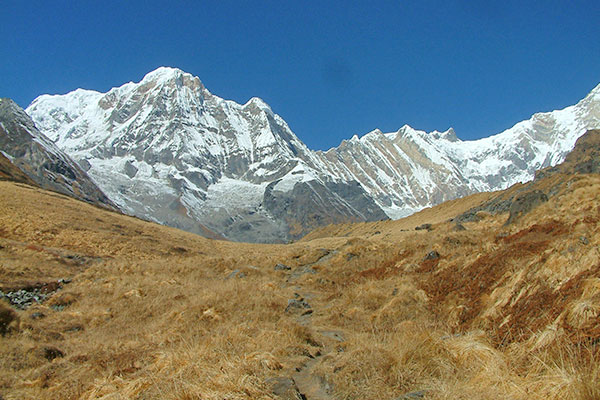
Annapurna Base Camp Trek
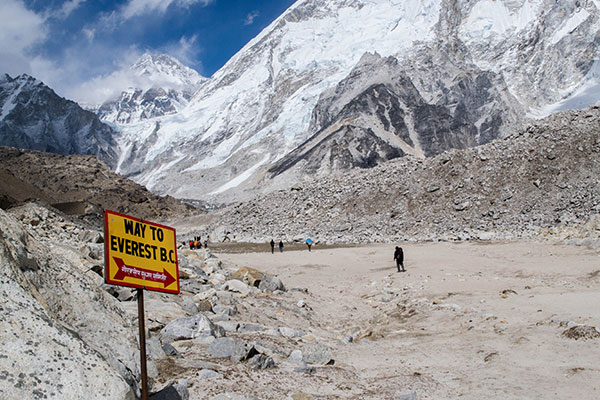
Everest Base Camp Trek
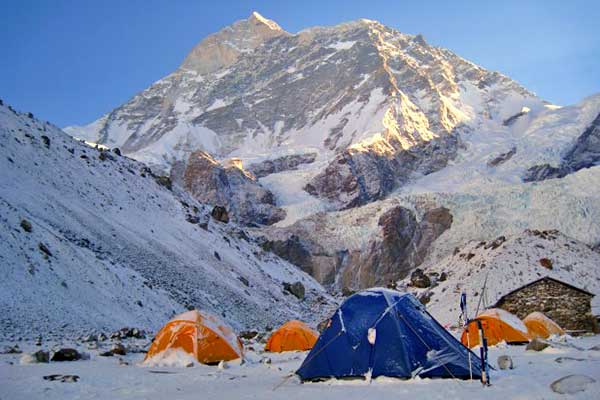
Makalu Base Camp Trek
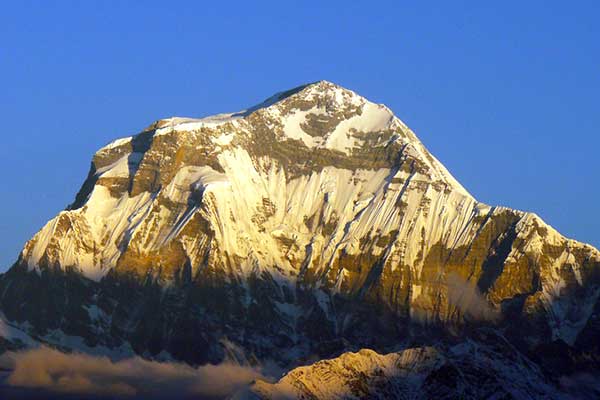
Dhaulagiri Round Trek
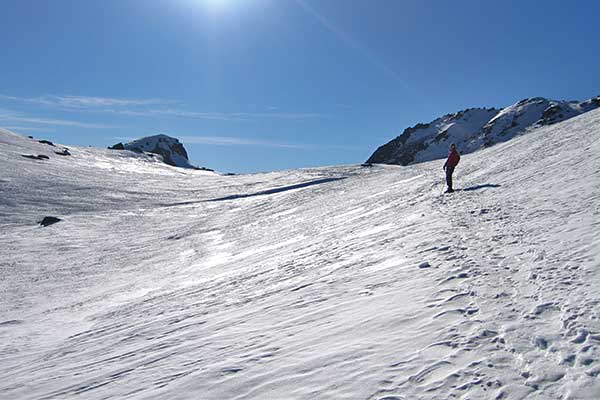
Gosaikunda Lauribina Pass Trek
- Strenuous Plus
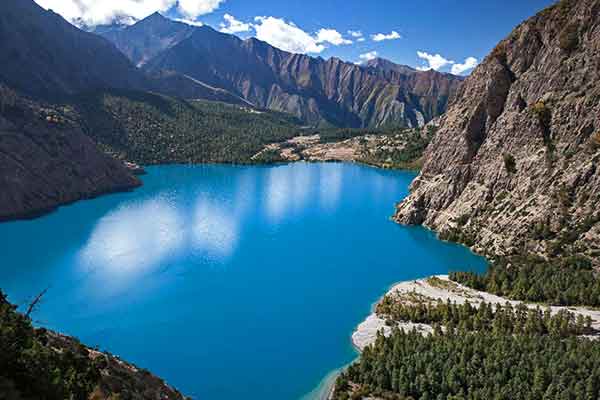
Phoksundo and Rara Lake Trek (Camping)
Clients review.
What our customers say about us
Beautiful Kanchenjunga Trek
We had an amazing trek to the Kanchenjunga north and south basecamp with our guide Pasang Sherpa. We could recommend Nepal Mountain Trekkers and our guide Pasang, the organisation was perfect. Thanks for your support
Christina S
Kanchenjunga trek.
We did a 20 day trek to south and north side Kanchenjunga. We highly recommend this trek and this company. The trek takes you through lovely villages, giving insight into the lives of the different people who live in this area, and the amazing terraces and farming that is done in this area. Then there are the beautiful forests, and of course the mind blowing mountains that seemed so close to us at the south and north base camps of Kanchenjunga and when we were crossing the pass from south to north. We had excellent support from our guide Min and our team of 5. They were very conscientious over our welfare and delightful to be with. There was a fuel blockade at the Nepal/India border at this time which made the logistics of the long overland travel very difficult. Ramesh and Shiva from Nepal Mountain Trekkers did an amazing job organising our bus and jeep to get us to and from the start of the trek and Min sorted any problems on trek efficiently. We are also pleased that the company prioritises trying to bring benefit to the villages, and the welfare of the trekking crew. Thank you and we hope to be back!
Kitoiandrobert
We are associated with.
SEND US A MESSAGE
Don't have account create here.
Kanchenjunga Base Camp Trek

We Offer Group Discount
- Best Price Guarantee
- Hassle-Free Booking
- Team of highly experienced Experts
- 24/7 Customer Support
All Inclusive Cost
This famous Kanchenjunga Base Camp trek takes you to both the north and south base camps of Mt. Kanchenjunga (8586m) the third world’s third-highest mountain. This 20 day Kanchenjunga Circuit Trek is famous for its glorious snow-clad peaks, high altitude alpine crossings, lush green valleys, and raging glacial rivers - all in one complete package!
Mt. Kanchenjunga is situated on the border with Sikkim in India and Tibet. The north and south case camp of Kanchenjunga are isolated, unspoiled, and will leave you awestruck. This is a trek to divine heights and the memories will last you a lifetime.
There are some physical challenges along the trail, such as the high altitude Lapsang La Pass (5108m) and Sinon/Mirgin La Pass (4650m) and Kanchenjunga Base Camp at 5140m. You will have time before reaching these heights to acclimatize at lower levels.
Mount Kanchenjunga, meaning "Five treasures of the snow" is within the protected Kanchenjunga conservation area, established in 1997 and covers over 2035 sq km.
The World Wildlife Fund (WWF) has classified the Kanchenjunga Conservation Area Project (KCAP) as a Global Eco Region. There are a number of fascinating species in this region, such as red panda, wild bear, musk deer, blue sheep, rhesus macaw, and the elusive snow leopard. The birdlife along the trek is abundant and brings the forests alive with song. There are over 1200 types of flowering plants, 69 kinds of orchids and 30 rhododendron species that brighten the trail – most especially during spring.
As well as Kanchenjunga there are four other peaks exceeding 8,000m, one is Kanchenjunga West, also known as Yalung Kang (8,586m). There are more than 17 peaks with an altitude of more than 7000m, including Kambachen (7,903m), Janu (7,710m), Jongsong (7,483m), Kabru (7,353m), Tent Peak (7,365m) and the Twins (7,350m). Besides these massive peaks there are a number of peaks over 6,000m. Surrounded by this astounding cluster of peaks are five major glaciers: Zumu, Talung, and Rathong that run into Sikkim and in the west the Kanchenjunga and Yulang Glaciers that flow into the extraordinary swift Tamor River in Nepal.
The trek along the Kanchenjunga Circuit is rough and at times physically demanding and hard going, but this is what makes this trek different from the rest.
Day 1 : Arrival in Kathmandu and transfer to hotel (1,400m).
On your arrival at Kathmandu Tribhuvan International Airport, you will be met by Sherpa Expedition and trekking staff and transferred to your respective hotels followed by a briefing regarding Kanchenjunga Base Camp Trek.
Day 2 : Explore Kathmandu and prepare for trek
Today, we will spend the day sightseeing in Kathmandu Valley with our guide. We will visit Pashupatinath, which is regarded as the holiest Hindu temple in Nepal and where pilgrims worship Lord Shiva (situated on the banks of the holy Bagmati River), Bouddhanath, a Buddhist temple known as ‘Little Tibet’ and then on to Swayambhunath known as the Monkey Temple. From Swayambhunath we drive to Kathmandu’s famous Durbar Square, a UNESCO World Heritage-listed site and located in front of the old royal palace. Upon arriving back at your hotel you may have time to do some last-minute shopping around Thamel – the tourist hub of Kathmandu. Back at your hotel your guide will help you prepare for your trek.
Day 3 : Fly from Kathmandu to Bhadrapur (45 min) & drive to Suketar (2,420m) Duration: 8-10 hours.
Today we will pick you up from your hotel and take you to the airport for your flight to Bhadrapur and then we will drive to Suketar, a seven to eight-hour drive. We will stay overnight at Suketar.
Day 4 : Trek from Suketar to Lali Kharka (2,266m) Duration: 4-5 hours.
Today our trek begins with a relatively relaxed four to five-hour hike through lush forests and finally on to Lali Kharka Village where we stay the night.
Day 5 : Trek from Lali Kharka to Kande Bhanjyang (2,190m) Duration: 5-6 hours.
After an early breakfast we follow the trail that ascends to Simbu Village and then have a steep ascent to Kande Bhanjyang Village. Along the trail we pass through several small village and forested areas before reaching Kande Bhanjyang Village where we stay the night.
Day 6 : Trek from Kande Bhanjyang to Phumphe Danda (1,860m) Duration: 6-7 hours.
Today’s trail takes us up a steep hillside passing terraced farmlands situated high above Kabbeli Khola (river). The trail is undulating, passing through valleys and across hillsides. We will stop for lunch along the way and after lunch pass through Anpan Village before descending to c Kashawa Khola (river) which we cross and then begin climbing up through the fields until we reach Phumphe Danda Village where we stay overnight.
Day 7 : Trek from Phumphe Khola to Yamphudin (2,080m) Duration: 6-7 hours.
The trail today follows the contours of the hillside above the Kabeli Khola (river), traversing small rivers and valleys. There are several great places to stop and take a dip in the river as we follow it until reaching Yamphudin Village. We will also stop beside the river for lunch. We will stay at Yamphudin in a guest house tonight.
Day 8 : Trek from Yamphudin to Tortong (2,995m) Duration: 8-9 hours.
Our trail today leads us through cooling forests and along the way offers amazing views of the Himalayas. The trail follows the Amji Khola. Further down the trail we cross Lassiya Bhanjyang Pass before reaching Tortong where we will stay the night in a guest house.
Day 9 : Trek from Tortong to Ramche (4,610m) Duration: 6-7 hours.
We start today by following the trail next to the river, passing through lush rhododendron and conifer forests. The trail descends rather rapidly down to the valley of the Simjua Khola (river). We then climb to the base of the Yalung Glacier and through valleys until we find a good campsite for the night. The trail today takes us near-frozen alpine lakes, across crystal clear rivers and offers magnificent views of Koktang, Rathong, and Kabru peaks. Tonight we will sleep soundly due to the physical exertion at these higher
Day 10 : Explore vicinity of Ramche (4,610m) and Trek to Oktang (4,730m) Duration: 4-5 hours.
Today we have our first close up view of Mt. Kanchenjunga. Soon after beginning our trek we will have impressive views of the south face of Mt. Kanchenjunga and Jannu. After spending the morning at Ramche we head to Yalung Ri Glacier and to Oktang. From this altitude we have breath-taking views of the surrounding mountains, especially the towering east face of Jannu Peak. Tonight we stay here in a guest house.
Day 11 : Trek from Oktang to Yalung Ri Base Camp (4,840m) Duration: 4-5 hours.
Again we begin by climbing higher as we head to Yalung Base Camp. Crossing these high altitude passes requires a good energy level and fine weather. The trail is more difficult but more rewarding as the views become more spectacular, especially of the stunning Mt. Kumbakarna (Jannu), Nyukla Lachung, and other nearby Himalayan snow-clad peaks. We will stay here overnight in a guest house.
Day 12 : Trek back to Tsheram (Cheram) (3,800m) Duration: 5-6 hours.
Along the trail we continue to have awesome views of Yalung Glacier, a frozen lake, and numerous lush valleys. Tonight we stay at Tsheram in a guest house.
Day 13 : Trek from Tsheram to Selele (4110m) via Mirgin La Pass (4,645m) Duration: 7-8 hours.
The trail heads down into the valley and along the way pass the trail that leads to the physically demanding Lapsang La Pass trail to Ghunsa and the north side of Kanchenjunga. This pass is dangerous, so we will head across the southern passes crossing Mirgin La Pass. At the beginning it is a steep ascent to reach the pass. On reaching the pass we have fantastic panoramic views of Jannu, and further away in the distance Mt. Makalu, Gyakung Kang, Everest, Lhotse, and Chamalang. Today’s trek will take about six to seven hours and will leave you tired and ready for a good night’s sleep at our campsite tonight.
Day 14 : Trek from Selele to Ghunsa (3,415 m) Duration: 5- hours.
Our trek today descends through pine and rhododendron forests until we reach Ghunsa, the last village in the valley. Ghunsa is a charming Tibetan village with many wooden houses displaying fluttering prayer flags. Ghunsa has two monasteries that are worth a visit. Tonight we stay at Ghunsa in a guest house.
Day 15 : Trek from Ghunsa to Kambachen (4,145m) Duration: 5-6 hours.
The trail today ascends to the south of Ghunsa Khola (river) crossing the broad river flats until we reach the elevated pastures on the north banks of the river. Along the trail we have magical views of. Mt Jannu. Once we arrive at the small Tibetan village of Kambachen we find ourselves surrounded by mountains. Tonight we stay here in a guest house.
Day 16 : Trek from Kambachen to Lhonak (4,792m) Duration: 3-4 hours.
Our trail crosses a rocky landscape until we reach Ramtang Village (4240m) then crosses to the northwest of the Kanchenjunga Glacier before reaching Lhonak, situated on a sandy plain with magnificent mountain views surrounding us. Tonight we will find a sheltered area to set up our tents in this arid windswept region.
Day 17 : Trek from Lhonak to Pang Pema (North base Camp) (5,143m) Duration: 4-5 hours.
Kanchenjunga peak is only visible from Pang Pema, the base camp for mountaineers wanting to climb Kanchenjunga. The trail ascends across the arid plain but very quickly gets steeper as we traverse the moraine. Tonight we stay at a guest house at Pang Pema.
Day 18 : Explore around Kanchenjunga Base Camp (5,143m) and Return to Kambachen; Duration: 5-6 hours.
An early morning climb of about 200 to 300m up a ridge north of Pang Pema offers magical views of Kanchenjunga, Wedge Peak, the Twins, and Tent Peak. We will then head back to Kambachen where we will stay in a guest house for the night.
Day 19 : Trek from Kambachen to Ghunsa (3,415m) Duration: 5-6 hours.
We head back on the same trail all the way to the Tibetan village of Ghunsa where we will stay the night in a guest house.
Day 20 : Trek from Ghunsa to Amjilosa (2,498m) Duration: 6-7 hours.
After an hour’s trek we descend to Phale, home to several monasteries and juniper forests until arriving at a grassy hillside where the tiny village of Amjilosa lies. We stay here in a guest house tonight.
Day 21 : Trek from Amjilosa to Sakathum (1,650m) Duration: 5-6 hours.
The day begins with a short climb and then a steep descent for the remainder of the day. At the beginning of our trek we can see a waterfall cascading form the mountains. Out trail leads to the junction of the Tamur and Ghunsa Kholas (rivers) and finally to Sakathum where we stay in a guest house for the night.
Day 22 : Trek from Sakathum to Chirwa (1,185m) Duration: 5-6 hours.
Our trek begins with a crossing of the Simbu Khola, a river with its origins at Kanchenjunga’s south base camp. The temperature is warmer at these lower altitudes. We cross a number of small streams before reaching Chirwa, a small village set among large boulders. Tonight we stay here at a guest house.
Day 23 : Trek from Chirwa to Taplejung (1,820m) Duration: 6-7 hours.
The trail today passes through more lush forests with unique examples of various flora and fauna. Our trek today lasts for about eight to nine hours before we reach the quaint village of Taplejung where we stay in a guest house overnight. On our way, we can witness a lush forest filled with flora and fauna. About 8-9 hours of long walk we reach to a picturesque village, Taplejung, where we stay in a guest house overnight.
Day 24 : Drive from Taplejung back to Bhadrapur (2,08m) Duration: 8-10 hours.
The nine to ten hour road trip takes us through many small valleys and through villages until we reach Bhadrapur where we stay in a guest house for the night.
Day 25 : Fly back to Kathmandu & transfer to hotel Duration: 45 minutes flight.
Today we have a 45-minute scenic flight back to Kathmandu and have our final glimpses of the majestic snow-covered mountains. Sherpa Expedition and Trekking will take you back to your hotel.
Day 26 : Transfer to Tribhuvan International Airport.
Your adventure comes to an end today – but your memories will last a lifetime! Our company representative will take you to the airport approximately 3 hours before your scheduled flight. On your way home you'll have plenty of time to plan your next adventure and explore the most magnificent mountains of Nepal.
Costs Included in your package:
- Airport picks up and transports by private Car/Jeep.
- Three night’s standard twin sharing Hotel in Kathmandu with breakfast.
- Three meals a day (Breakfast, lunch, and dinner) during the trek.
- Transportation from Bhadrapur to Suketar and Taplejung to Bhadrapur by sharing Jeep.
- Trekking Lodge (Tea House)/ tent accommodation during the trek.
- All necessary paperwork including Kanchenjunga conservation area Entry Permit & Special permit.
- Kathmandu-Bhadrapur-Kathmandu flight with private airport transfer and domestic airport tax.
- A highly experienced, helpful, knowledgeable, friendly, English speaking well trained, Government license holder guide with all his salary, food, drinks, accommodation, transport and insurance.
- Strong, helpful Sherpa porters with proper safety equipment and walking equipment, his salary, food, accommodation, and insurance (one porter for two people).
- Comprehensive medical supplies (first aid kit will be available).
- Arrangement of emergency helicopter service (paid by your Travel Insurance Company).
- Use of sleeping bag, down jacket, duffel bag and walking poles (if you don’t have your own, to be returned after trip completed).
- Sherpa Expedition and Trekking T-shirt
- Government taxes and official expenses.
- Guided Kathmandu sightseeing tour with private car/jeep.
- Oxygen meter to check your pulse and oxygen saturation and heart rate twice daily (Very useful to check Altitude Mountain Sickness(AMS) symptoms) which will ensure your health during the trek.
- Assistant guide for groups of 8 or more people.
Costs Exclude
- Meals whilst you are in Kathmandu - lunch, and dinner.
- Nepal entry visa fee (easy to obtain the visa on arrival at Tribhuvan International Airport – Kathmandu). $30 USD for 15-day, $50 USD for 30 Days, and $125 USD for 90 Days visa.
- Personal travel and medical insurance.
- International airfare.
- Your personal expenses.
- All the alcoholic and nonalcoholic, soup, tea, coffee, hot chocolate, cocoa, mineral water, extra food, cold and hot drinks on trek ( i.e. those you choose to purchase along the way and during evenings in the tea houses)
- All desserts & sweet things like chocolate, cake, pie, pudding.
- Hot shower and battery charging at the tea houses.
- Tips for the guide, porter, and driver (tipping is expected)
- Kathmandu sightseeing monument entrance fees($30 USD per person)
- Excess baggage of more than 20 kg for Badarpur flight.
The following information will give you some idea about what you need to bring for the trek. It is important you do not forget the essential items, as this will determine your comfort and safety on the trek. Equally important is that you do not burden yourself with unnecessary equipment on the trek.
- Sleeping Bag (Sherpa Teams will provide but need to return after completing the trip)
- Duffel Bag (Sherpa Teams will provide but need to return after completing the trip)
- Fleece jacket or pullover
- Waterproof windbreaker or windcheater
- Thermal underclothes
- Rain poncho
- Down jacket (Sherpa Teams will provide but need to return after completing the trip)
- Fleece or wool trousers
- Sun hat or scarf
- Trekking pants (two pairs)
- Mittens or woolen gloves
- Hiking socks (several pairs)
- Moisture-wicking shirts, including t-shirts
- Trekking shoes or boots with spare laces
- Flip-flops or sandals for relaxing in the evenings
- Underwear (several pairs)
- Swimsuit or swimming costume
- Headlamp or flashlight/torch
- Sleeping bag (Sherpa Teams can provide this for you)
- Trekking poles (if desired)
- Hiking backpack with a capacity of at least 40 liters
- Small lock for your backpack
- Reusable water bottles (at least two liters)
- Water purification tablets or filtration device
- Basic first aid kit
Toiletries (tissues, toilet paper, moisturizer, lip balm, sunscreen, sanitary pads, hand sanitizer, nail clippers, a small mirror, toothbrush, toothpaste, glasses, contacts, etc.)
GOOD TO KNOW
Hotel and accommodation:.
We offer you 3-star hotel accommodation in Kathmandu (3 nights) and Lodge/Teahouses during the Kanchenjunga Base camp Trek. Rooms are basic, normally just a bed with blankets and a pillow. All accommodation is on a twin share basis except at the higher elevations or after Kambachen, where you will enjoy homestay style accommodation. The Kanchenjunga trek is situated in some very areas so you may not have the same level of comfort as lower down the mountain. Sherpa Expedition and Trekking will provide you down jackets, sleeping bags, and duffle bags (which need to be returned after the trek).
Meals during the trek
In Kathmandu your hotel includes breakfast, whereas all meals (breakfast, lunch, and dinner) will be provided during the trek. A staple food of these mountain regions are potatoes, oats, buckwheat, Sherpa stew and Tibetan bread. Sherpas started farming potatoes when the first seeds were introduced to the region in the early 90s. There is a limited choice of food at higher elevations and except many potato dishes. Potatoes are high in carbohydrates – an excellent source of energy needed at high altitudes.
Transportation
We use a private car for sightseeing and for the airport to hotel pick and drop off. We do not have to use public transportation or local buses during the trek. Our only flights are from Kathmandu, Jomson and Pokhara.
Physical condition and past experience:
Kanchenjunga Base Camp trek is graded as highly challenging and a tough trek due to the terrain and high altitudes. This trek takes you to many less-traveled and undeveloped areas, making it difficult in places to traverse rockfalls, moraines, and streams Trekking in these remote areas can sometimes be difficult due to landslides. The roads at the beginning and end of the trek can also be affected too. It is recommended that you prepare yourself beforehand and get physically prepared. This will make it easier to manage the difficult terrain and high altitudes.
Remember – The better prepared – the more enjoyable your trek!
Photos/videos.
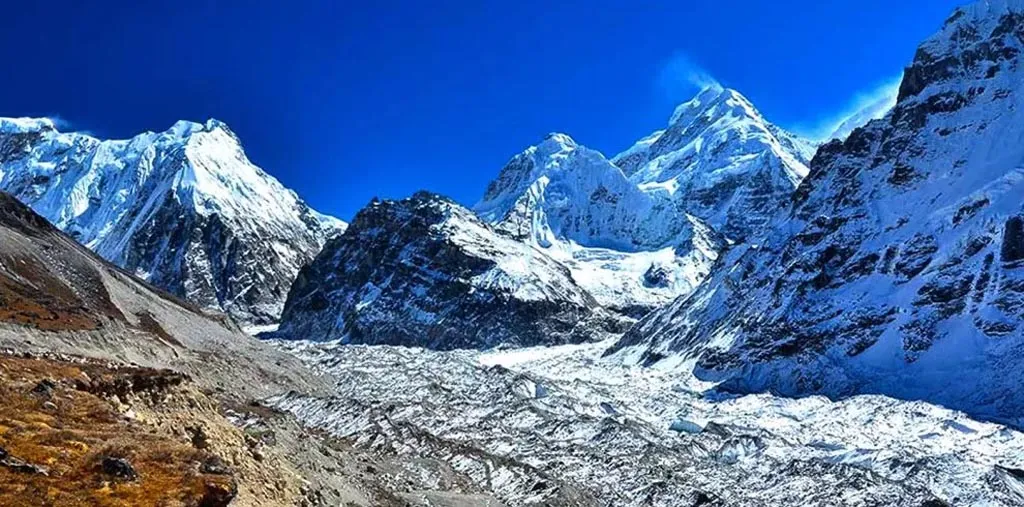
- Personalized Tour
Select a departure month
- Upcoming Departures
Fill out the form below and a Travel Expert will reach out to create your perfect tour.
Travellers(Optional)
How difficult is the kanchenjunga base camp trek.
The Kanchenjunga Base Camp Trek is considered to be a challenging trek. It involves long days of walking, steep ascents and descents, and high altitude. Previous trekking experience and a good level of fitness are recommended.
How long does it take to complete the Kanchenjunga Base Camp Trek?
The trek usually takes around 15-25 days to complete, depending on the itinerary and the pace of the trekking group.
What is the best time to do the Kanchenjunga Base Camp Trek?
The best time to do the Kanchenjunga Base Camp Trek is during the spring (March to May) and autumn (September to November) seasons. These months offer stable weather conditions, clear skies, and good visibility of the mountains.
Do I need a permit for the Kanchenjunga Base Camp Trek?
Yes, you need a special permit called the Kanchenjunga Restricted Area Permit to trek to the Kanchenjunga Base Camp. You also need to obtain the TIMS (Trekkers' Information Management System) card.
Are there any altitude sickness risks on the Kanchenjunga Base Camp Trek?
Yes, there is a risk of altitude sickness on the Kanchenjunga Base Camp Trek, as you will be reaching high altitudes. It is important to acclimatize properly, drink plenty of water, and listen to your body's signals. It is also advisable to consult with a doctor before undertaking the trek.
Are there tea houses or lodges along the Kanchenjunga Base Camp Trek route?
Yes, there are tea houses and lodges available along the Kanchenjunga Base Camp Trek route. However, the facilities may be basic and limited in some areas. It is recommended to carry your own sleeping bag and be prepared for shared accommodations.
Is it possible to do the Kanchenjunga Base Camp Trek independently?
No, it is not possible to do the Kanchenjunga Base Camp Trek independently. The trek requires a licensed guide and a minimum of two trekkers due to the restricted area regulations.
What should I pack for the Kanchenjunga Base Camp Trek?
Some essential items to pack for the Kanchenjunga Base Camp Trek include warm clothing, hiking boots, a good quality sleeping bag, a backpack, trekking poles, waterproof clothing, sun protection, a first aid kit, and a water purifier.
Can I hire a porter for the Kanchenjunga Base Camp Trek?
Yes, it is possible to hire a porter for the Kanchenjunga Base Camp Trek. A porter can help carry your heavy backpack, allowing you to trek with less weight and enjoy the journey more comfortably.
Is travel insurance necessary for the Kanchenjunga Base Camp Trek?
Yes, travel insurance is highly recommended for the Kanchenjunga Base Camp Trek. It should cover emergency medical expenses, helicopter evacuation, and trip cancellation. Make sure to check the policy details and ensure that it includes trekking activities at high altitudes.
Latest Traveller’s Reviews
Travel experiences of our clients who recently returned from their trips..
Based On 38 Reviews
United States
September 11, 2024, expert navigation and friendly service.
Sherpa Expedition’s team excelled in expert navigation and friendly service on the Kanchenjunga Base Camp Trek. The guides demonstrated a deep understanding of the trek’s routes and shared valuable information about the natural and cultural highlights of the region. Their friendly and professional approach made the trek enjoyable. The support staff was exceptional, efficiently managing all logistical needs and ensuring our comfort. Their dedication to delivering a high-quality trekking experience was clear. Sherpa Expedition is highly recommended for their exceptional service and expertise.
JanXada HaMdaRd
August 29, 2024, exceptional trekking adventure.
Our Kanchenjunga Base Camp Trek with Sherpa Expedition was an exceptional adventure. The guides were highly skilled, expertly managing the challenging routes and providing insightful information about the area’s natural beauty and culture. Their dedication to safety and client satisfaction was impressive. The support staff was excellent, handling all logistical needs with efficiency and care. Their commitment to ensuring a smooth and enjoyable trek was clear throughout the journey. Sherpa Expedition is highly recommended for their exceptional service and high-quality trekking experience.
Paulette Grondin
August 4, 2024, highly efficient and knowledgeable team.
Sherpa Expedition’s team was highly efficient and knowledgeable on the Kanchenjunga Base Camp Trek. The guides were adept at navigating the rugged terrain and provided detailed information about the trek’s highlights and the region’s cultural significance. Their commitment to safety and comfort was evident. The support staff’s efficiency in managing all logistical aspects ensured a smooth and pleasant trek. Their attention to detail and dedication to delivering a high-quality experience made our adventure truly enjoyable. Sherpa Expedition is an excellent choice for a memorable trek.

Write Your Review
Average Customer Ratings
How The Travellers Have Rated This Package
People Considering This Package Right Now Check availability
Write A Review
Your email address will not be published. Required fields are marked*
Download PDF
Your email address is required for downloading package details.*
Recommended On

Subscribe and Win a Free Everest Trek!
Follow us on:.

- MAKE A PAYMENT
- B2B Partner
- OUR PARTNERS
USEFUL LINKS
- Terms and Condition
- Payment Procedure
- Why Sherpa Expidition & Trekking?
- 8000m Expedition
- 7000m Expedition
- 6000m Peak Climbing
- Popular Peak Climbing
EXPEDITIONS
- Everest Expedition (South)
- Everest Expedition (North)
- Everest Base Camp Trek
- Gokyo Valley Trek
SHERPA EXPEDETION
Kuala lumpur, malaysia,, phuket, thailand, sydney, australia.

Sherpa Expedition and Trekking is one of the pioneers of Trekking, tour and expedition in Nepal which was established on January 07, 1977, with a motto: ‘Enhancing Tourism possibilities across the Globe’. Sherpa Expedition and Trekking is proud to be recognized as the fifth Trekking and Adventure company authorized by the Tourism Board of Nepal.
© Copyright Sherpa Expedition And Trekking. All rights reserved.
Made with in Nepal by TECH 101
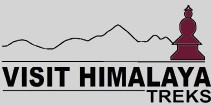
- Company Profile
- Nepal Holidays
- Bhutan Holidays
- Tibet Holidays
- India Holidays
- Bangladesh Tour
- Pakistan Holidays
Kanchenjunga Base Camp Trek
- Kanchenjunga Yangma Valley Trekking
- Kanchenjunga Circuit Trek
- Makalu Base Camp Trek
- Lumba Sumba Pass Trek
- Makalu Base Camp Sherpani Col Trek
- Rara Upper Dolpo Trek Via GHT Trail
- Rolwaling Tashi Lapcha Pass Trek
- Kanchenjunga To Makalu Base Camp Trek
- Rara Lake Humla Yari Valley Trek
- Upper Dolpo Trek
- Lower Dolpo Trek
- Humla Limi Valley Trek
- Rara Lake Trek
- Mundum Kirat Cultural Trail Trekking
- Annapurna Circuit Trek
- Annapurna Tilicho Lake Trek
- Annapurna Base Camp Trek
- Ghorepani Poon Hill Trek
- Upper Mustang Trek
- Annapurna Community Lodge Trek
- Mardi Himal Trek
- Nar Phu Valley Trek
- Nar Phu Annapurna Tilicho Pass Trek
- Nar Phu Teri La Pass Upper Mustang Trek
- Dhaulagiri Circuit Trek
- Jaljala Dhorpatan Trek
- Annapurna North Base Camp Trek
- Everest Base Camp Trek 17 Days
- Everest Base Camp Trekking 14 Days
- Gokyo Lake Cho La Pass EBC Trek
- The 13 Days Everest Base Camp Trek
- Gokyo Lakes Renjo La Pass Trek
- Gokyo Lakes Cho Oyu Base Camp Trek
- Everest Three Passes Trek 22 Days
- Jiri To Gokyo Everest Base Camp Trek
- Everest Panorama Trek
- Everest Luxury Trek
- Pikey Peak Dudhkunda Lake Trek
- Pikey Peak Trekking
- Numbur Cheese Circuit Trek
- Everest Base Camp Chola Pass Gokyo Trek
- Tamang Heritage Trek
- Langtang Gosainkunda Lake Trek
- Helambu Circuit Trek
- Ganesh Himal Base Camp Trek
- Ganesh Himal Panorama Trek
- Langtang Valley Trek
- Jugal Himal Base Camp Trek
- Manaslu Tsum Valley Trek
- Manaslu Circuit Trek 18 Days
- Manaslu Circuit Rupina La Pass Trek
- Tsum Valley Ganesh Himal Base Camp Trek
- Mera Peak Climbing
- Everest Three Peaks Climbing
- Mera Peak And Island Peak Climbing
- Island Peak Climbing With Everest Base Camp Trek
- Lobuche Peak Climbing With Everest Base Camp Trek
- Nirekha Peak Climbing
- Parchamo Peak Climbing
- Ramdung Peak Climbing
- Larkya Peak Climbing With Manaslu Circuit Trek
- Chulu Far East Peak Climbing
- Pisang Peak Climbing
- Naya Kanga Peak Climbing
- Yala Peak Climbing 14 Days
- Saribung Peak Climbing
- Bokta Peak Climbing
- Norbu Kang Peak Climbing
- Ama Dablam Expedition
- Mount Baruntse Expedition
- Mount Himlung Expedition
- Putha Hiunchuli Expedition
- One Day Trisuli River Rafting
- Marshyangdi River Rafting
- Paragliding In Nepal
- Bungee Jumping In Nepal
- Chitwan National Park Tour
- Bardia National Park Tour
- Chitwan National Park 2N 3D Luxury Tour
- Chitwan National Park 3N 4D Luxury Tour
- Chitwan National Park 4N 5D Luxury Tour
- Chitwan Tiger Tops Safari 3N 4D Tour
- Chitwan National Park 2N 3D Budget Tour
- Chitwan National Park 3N 4D Budget Tour
- Chitwan National Park 4N 5D Budget Tour
- Bardiya National Park 2N 3D Tour
- Bardiya National Park 3N 4D Tour
- Bardiya National Park 4N 5D Tour
- Nagarkot Day Hike
- Dhulikhel Day Hike
- Shivapuri Hill Day Hike
- Mountain Flight Everest Experience
- Everest Experience Trekking Tour
- Family Holiday Tour Package In Nepal
- Experience Best Of Nepal Tour
- Discover Nepal Tour
- Bandipur Village Tour
- Muktinath Temple Tour
- Khotang Halesi Tour
- Mustang Tiji Festival Trek
- Everest Base Camp Helicopter Tour
- Annapurna Base Camp Helicopter Tour
- Luxury Holiday Tour In Nepal
- Upper Mustang Jeep Ride Tour
- Everest Base Camp Trek With Helicopter Return
- The Best Of Nepal And Bhutan Tour
Adventure Activities Awaits You
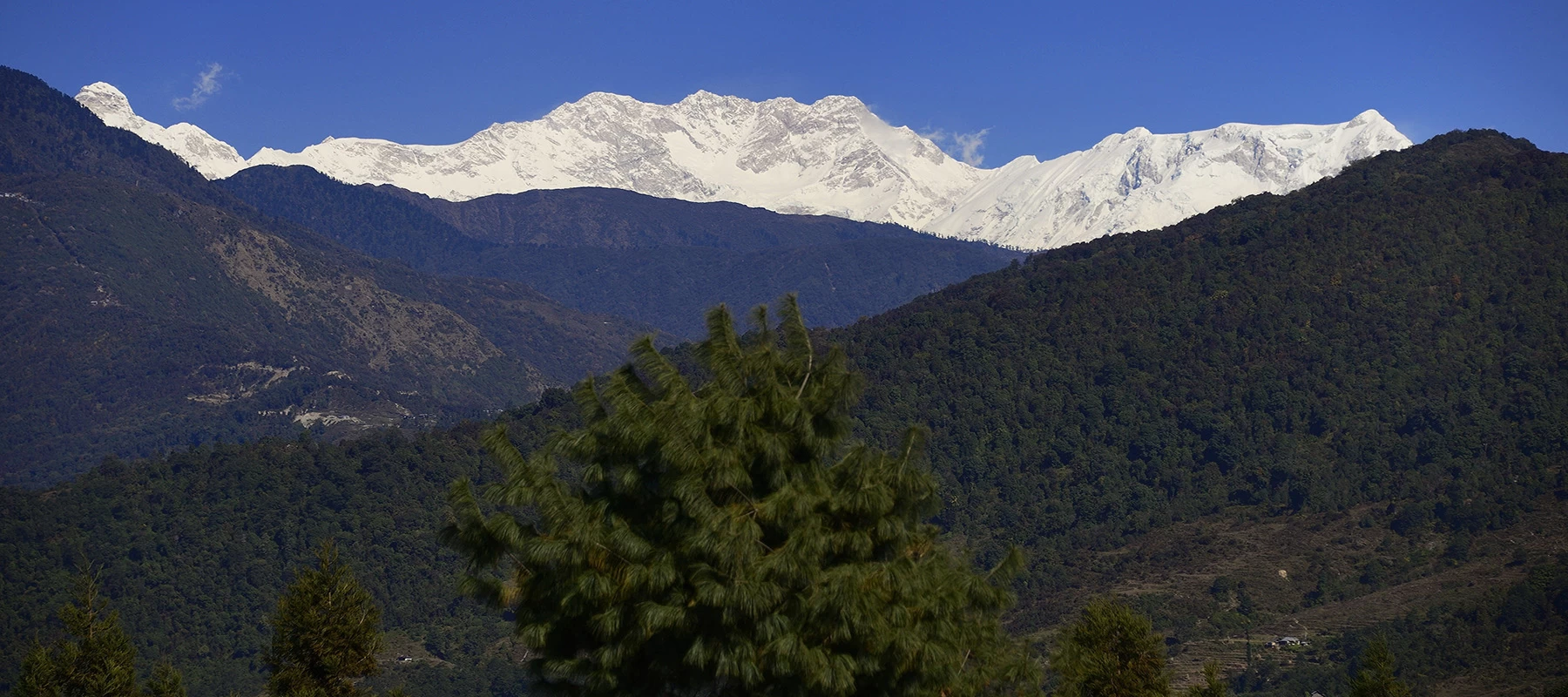
Janu, Kanchenjunga and Talung Panorama View
- Nepal Holidays >>
- Trekking & Hiking >>
- Off The Beaten Track >>
- Kanchenjunga Base Camp Trek >>
The Kanchenjunga Base Camp Trek is of 26 Days , with actually 22 days of challenging and unforgettable trek that will take you through some of Nepal's most beautiful landscapes. The entire trek to Kanchenjunga Base Camp covers a distance of 220km which offers an exhilarating and captivating experience. With breathtaking views of the Kanchenjunga massif, remote villages, and high-altitude terrain, this trek is perfect for experienced trekkers looking for an epic adventure. While trekking to the third-highest mountain in the world, located in eastern Nepal, you will traverse remote villages, traverse through alpine forests, and navigate high-altitude terrains, all while being rewarded with awe-inspiring vistas along the way. This Kanchenjunga Base Camp Trek route takes you to both South and North Base Camp, from where you can view a wide range of spectacular scenery, tropical jungle, culture, and traditional (Hindu & Buddhism) typical local villages.
Trekking to Kanchenjunga is one of the most adventurous, challenging, and exciting Treks in Nepal . If you're an avid trekker and have always wanted to challenge yourself with a high-altitude trek, it’s definitely for you.
- Exciting trekking experience around the Kanchenjunga circuit world’s third-highest peak.
- Breathtaking Kanchenjunga south view from Oktang, Oktang is the best viewpoint of the trek.
- Majestic Mountain north view from Pangpema base camp known as Kanchenjunga north base camp.
- Touching the Spectacular Tibetan village Ghunsa & Phale.
- Feel a real Wilderness trekking experience untouched trekking zone.
- Stunning views of the Kanchenjunga Massif.
- Remote villages and cultural immersion.
- High-altitude terrain and challenging passes.
- Biodiverse landscapes and wildlife
Trekking to Kanchenjunga in Nepal is a challenging adventure that takes you through remote villages, high-altitude terrain, and the biodiverse Kanchenjunga Conservation Area. The trek offers a unique blend of cultural immersion, natural beauty, and stunning mountain views. The cultural immersion aspect of this trek is special, as you get to interact with the local people and witness their way of life. The trekking culminates at Kanchenjunga Base Camp and Pangpema, offering breathtaking views of the Kanchenjunga mountain range. We have a comprehensive article that covers everything you need to know about trekking to Kanchenjunga in Nepal , ensuring you are well-prepared and informed beforehand. Feel free to read, it's written for you.
This video shows a glimpse of what the Trekking experience looks like.
Kanchenjunga Base Camp Trek Attractions
The route leading to Kanchenjunga Base Camp takes you through the scenic Arun Valley, widely regarded as one of the most beautiful trekking regions in Nepal. A prominent feature of this trek is the expansive Kanchenjunga Conservation area, spanning an impressive 2035 square kilometers. Within this area, a rich array of flora and fauna thrives, including the Himalayan black bear, musk deer, snow leopard, red panda, wild boar, and numerous other species. As you venture towards the base camp, the landscape unfolds in a captivating manner, transitioning from alpine grasslands to sub-tropical forests, meandering river valleys, glacial moraines, and rugged scree slopes. The trekking starts passing through typical hilly terraced villages and heads to the southern base camp of Kanchenjunga. On a trek to the south base camp, Oktang (4730 meters) is a spectacular viewpoint. It provides views of Kokthang (6148 meters), Rathong (6678 meters), Kabru Range, Kanchenjunga Range, and Jannu (7710 meters). These three scenic and tiring passes separate the northern and southern base camps of Kanchenjunga. On the other hand, there are more settlements, and Ghunsa (3475 meters), a lovely Tibetans Buddhist village is one of the biggest villages in the whole higher valleys of the Kanchenjunga Region. Kambachen (4225 meters) and Lhonak (4815 meters) are the only other two seasonal settlements situated higher than Ghunsa. At the end of the valley, Pangpema (5150 meters) offers full circular views of Kanchenjunga (8586 meters), Kangbachen (7903 meters), Ramtang Peak (6601 meters), Taple Sikhar (6341 meters), Nepal Chuli (6910 meters) and Kirat Chuli (7365 meters).
Check out for more 11 Must-see Attractions of Kanchenjunga Trekking. You don't want to miss it
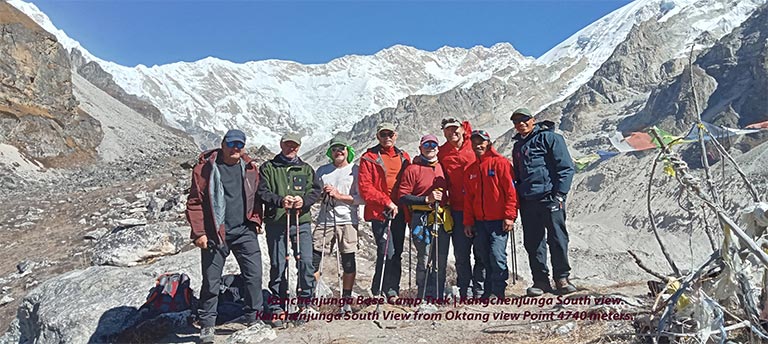
Kanchenjunga Base Camp Trek Route Map
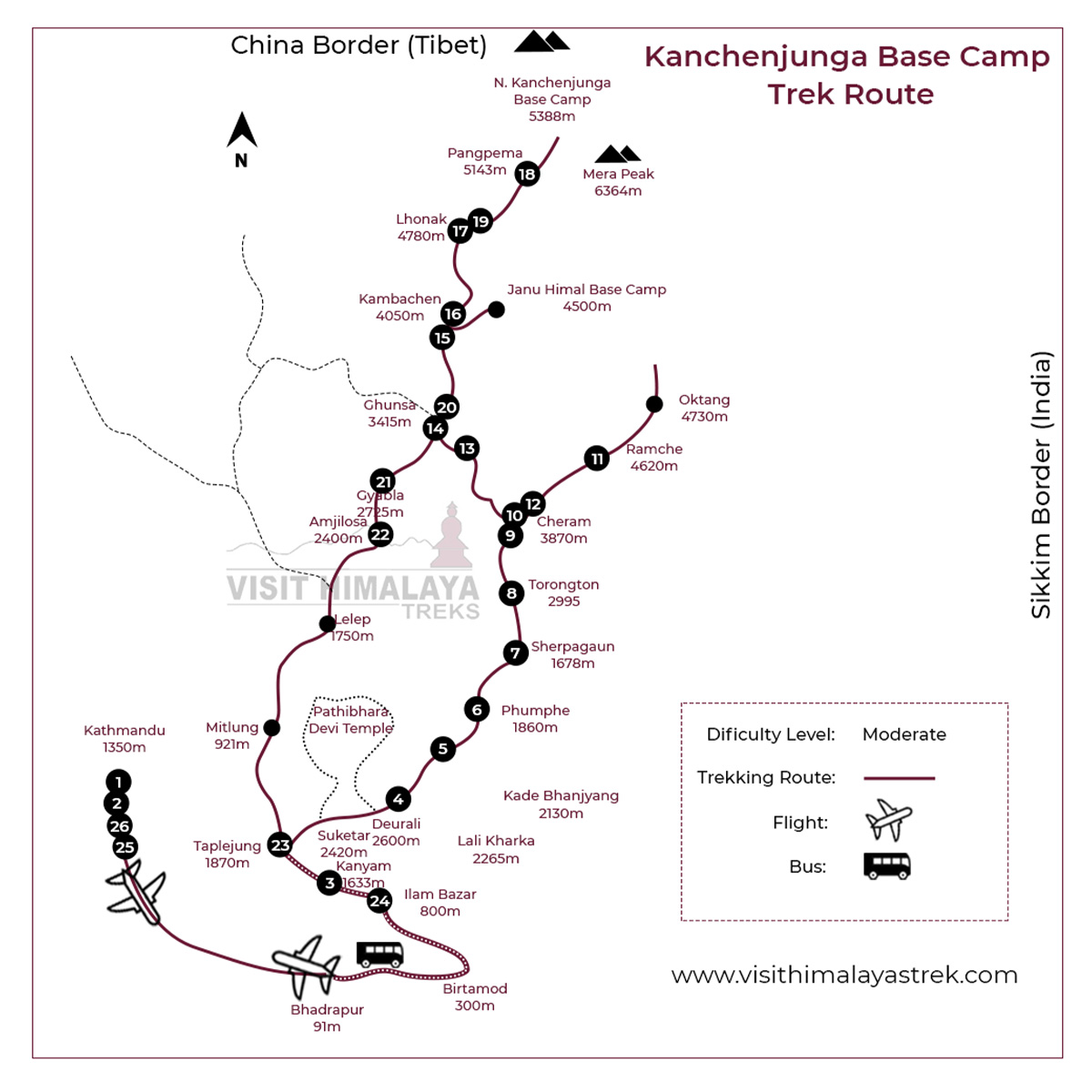
We start our trekking route by taking a flight to Bhadrapur and then embarking on a trek to reach Oktang, which serves as the southern base camp. Afterward, we retrace our steps to Tseram and trek towards the northern side at Pang Pema, before returning to Suketar.
What is the altitude of the Kanchenjunga base camp?
This chart shows the altitude from the day you arrive in Nepal, trek up to Kanchenjunga Base Camp till the Departure back to your home. Mount Kanchenjunga is located in Far Eastern Nepal, between Nepal and Sikkim. During your Trekking to Kanchenjunga, you will visit Kanchenjunga South Base Camp and Kanchenjunga North base camp. Ramche 4580 meters is the Kanchenjunga South base camp where trekking groups stop overnight here at Ramche. And they do day hikes to Oktang viewpoint 4730 meters to enjoy the super view of Mount Kanchenjunga Southside and Yalung Glacier views. After visiting Kanchenjunga's South Side, the trekking continues to Kanchenjunga North Base Camp. Pang Pema 5143 meters is the Kanchenjunga North Base Camp where trekking groups stop overnight. From Pang Pema, we can explore super views of Kanchenjunga North and Kanchenjunga Glacier.
Summary of Kanchenjunga Base Camp Trek Itinerary
Day 01: Arrive in Kathmandu (1350 meters) Day 02: Sightseeing and Trek Preparation. Day 03: Flight to Bhadrapur (91 meters) and drive to Kanyam. Day 04: After breakfast drive to Suketar and Trek to Lali Kharkha. (2265 meters). Day 05: Trek to Kade Banjyang (2130 meters). Day 06: Trek to Phumphe Danda (1858 meters). Day 07: Trek to Sherpaguan (2080 meters). Day 08: Trek to Torongton (2995 meters). Day 09: Trek to Tseram (3870 meters). Day 10: Acclimatization Day at Tseram. Day 11: Trek to Ramche (4615 meters). Day 12: Trek to Oktang viewpoint and Back to Tseram (3870 meters). Day 13: Trek to Sele La (4290 meters). Day 14: Trek to Ghunsa (3475 meters). Day 15: Trek to Kambachen (4050 meters). Day 16: Side trip to Janu Himal Base Camp (4500 meters) Day 17: Trek to Lhonak (4815 meters). Day 18: Trek to Pang Pema (5150 meters) Day 19: Day hike to Domo Ri peak view Point and back to Lhonak. Day 20: Trek back to Ghunsa. Day 21: Trek back to Gyabla (2725 meters) Day 22: Trek back to Amjilosa (2510 meters). Day 23: Trek back to Ranipul and drive to Taplejung. Day 24: Drive to Kanyam tea garden and stay overnight at Hotel. Day 25: Drive to Bhadrapur and fly to Kathmandu. Day 26: Departure.
- Trekking Boots: Sturdy, comfortable, with ankle support and waterproofing.
- Sleeping Bag: High-quality, rated for temperatures below freezing (-20°C).
- Clothing: Layered approach, including moisture-wicking base layers, insulation layers, and windproof/waterproof outer layers.
- Headwear and Gloves: Warm beanie, sun hat, thick gloves for warmth, and thinner gloves for dexterity.
- Backpack: Good quality, 50-60 liter capacity to carry gear and essentials.
- Trekking Poles: Adjustable, lightweight poles for balance and knee support.
- Sunglasses and Sunscreen: UV-protective sunglasses and high-SPF sunscreen for sun protection.
- First Aid Kit: A basic Kit with essential medications and supplies.
- Water Bottles or Hydration System: Carry at least two reusable bottles with purifiers.
Click to download the checklist for the gear list.
Necessary permits and documents
- Kanchenjunga Restricted Permits fees are $ 20 per person/Per week.
- Kanchenjunga conservation fees are $30 per/ person.
- TIMS (Trekkers information management system Card) fees are $20 per person.
- To obtain the restricted permits, a required original passport is required with a valid Visa.
- Travel Insurance: It is highly recommended that all trekkers obtain comprehensive travel insurance before trekking.
- The insurance should cover emergency medical expenses, evacuation, and Search.
01: Everything you need to know about trekking to Kanchenjunga in Nepal. 02: Best Itinerary For Kanchenjunga Base Camp Trekking In Nepal. 03: Wilderness Trekking To Kanchenjunga Base Camp . 04: Kanchenjunga Base Camp Trek Video.
Why VHT is the Best Trekking Company for Kanchenjunga Base Camp Trek
VHT (Visit Himalaya Treks) is a reputable and experienced trekking company in Nepal that prioritizes safety and offers customizable itineraries at affordable prices. VHT has always provided the Itinerary for the Best price to Travelers who want to do Trekking to Kanchenjunga Base Camp. Their team of knowledgeable guides is well-equipped to handle any unforeseen challenges that may arise during the trek. VHT is committed to responsible tourism and has supported local businesses while using eco-friendly practices in their operations since 2009. They have a proven track record of organizing successful treks in the Himalayas and are a good choice for your Kanchenjunga base camp trek.
FAQs for the Kanchenjunga Base Camp Trek
When is the best time for kanchenjunga base camp trek.
The best time to trek to Kanchenjunga in Nepal is during the spring (March to May) and autumn (September to November) seasons due to clear skies, moderate temperatures, and stable weather. Avoid trekking during the summer (June to August) due to heavy rainfall and the winter (December to February) due to snow and freezing temperatures. Consider checking out When Is The Best Time For Trekking To Kanchenjunga Base Camp In Nepal? in detail so you could better understand the best season to trek.
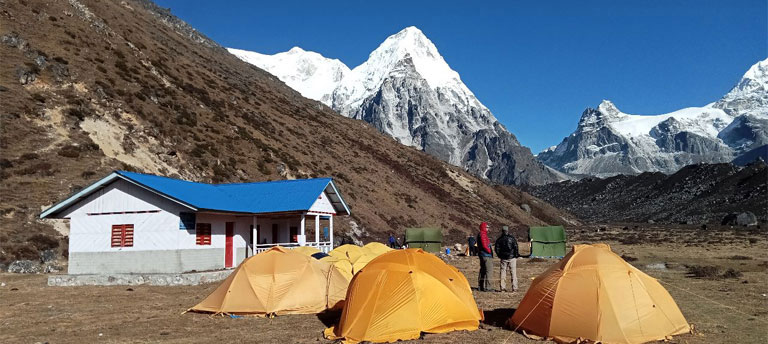
How difficult is the Kanchenjunga Base Camp Trek in Nepal?
Kanchenjunga Base Camp Trek is considered a difficult & challenging one, due to its remote location, high altitude, and rugged terrain. The trek involves steep ascents and descents, crossing several high mountain passes, and trekking through remote valleys & forests. The highest point during Kanchenjunga north base camp trek is at Pang Pema, 4785 meters. Whereas the Kanchenjunga south base camp trek's highest point is 4160 meters. Compared to South Base Camp, North Base Camp is a difficult and challenging one. The trek requires a high level of fitness and endurance, as trekkers will need to walk for several hours each day at high altitudes. Altitude sickness is also a concern on this trek due to the high elevation. It is recommended that trekkers have previous trekking experience and prepare themselves physically and mentally before attempting the trek. Hiring a local guide or porter is also advisable to navigate the challenging terrain and ensure safety on the trek.
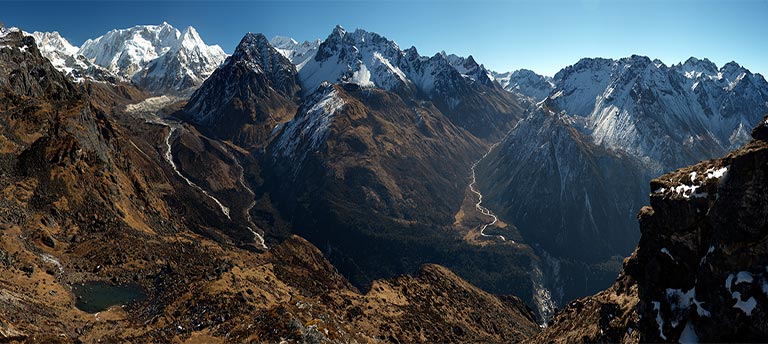
Which is the base camp of Mt. Kanchenjunga?
There are actually two base camps for Kanchenjunga: North Base Camp (Pang Pema 5143 meters) , which is located in Tibet, and South Base Camp (Ramche 4580 meters) , which is located in Nepal. The base camp of Kanchenjunga, the third-highest mountain in the world, is located on the south side of the mountain in Nepal. The South Base Camp of Kanchenjunga is the more popular and accessible of the two. It is located in the Taplejung district of eastern Nepal and can be reached via a multi-day trek from the town of Suketar. The trek to the Kanchenjunga South Base Camp offers stunning views of the Himalayan range and takes trekkers through remote valleys, forests, and mountain passes before reaching the base camp at an altitude of 5,143 meters (16,873 feet).
How much does it cost to Trek the Kanchenjunga Base Camp?
Trekking to Kanchenjunga Base Camp will cost USD 1180 per person which will be an epic 18 Days in total. And we run the Kanchenjunga circuit trek minimum group size of 2 people in the group. However, the cost of trekking to Kanchenjunga in Nepal can vary depending on several factors. Such as the duration of the trek, the route taken, and the level of service required. For a luxury Camping Trek in Kanchenjunga, we offer the Upper Kanchenjunga Yangma Valley Camping Trek for USD 6800 per person. We run the Kanchenjunga Yangma Valley Camping trek with a minimum group size of 2 trekkers and a maximum of 10 trekkers. Similarly, Visit Himalaya Treks offers Kanchenjunga South and North Base Camp tea house treks for USD 2600 per person with a minimum group size of 2 people.
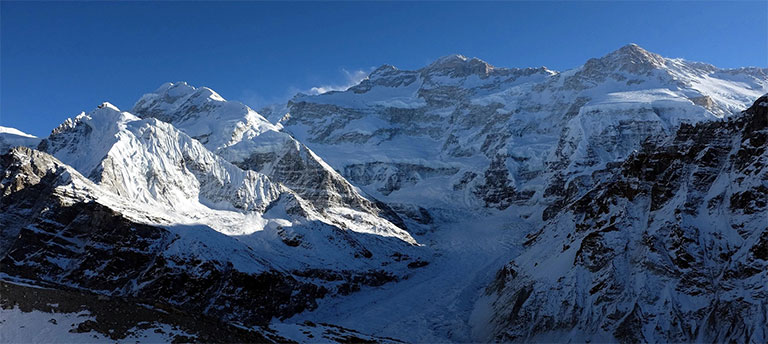
Is it possible to Trek the Kanchenjunga solo?
No, it is not possible to trek solo as the area is restricted and requires a special trekking permit. According to the rules of the Nepal government, trekkers must have a minimum of two people in their group and must be accompanied by a licensed guide or porter. This is to ensure the safety and well-being of trekkers, as the Kanchenjunga region is remote, and the terrain can be challenging and difficult to navigate. Moreover, having a guide or porter can be helpful in providing local knowledge, assistance with carrying equipment and supplies, and ensuring proper acclimatization to high altitudes. They can also help in case of emergencies or health issues, which can be particularly important in remote areas like Kanchenjunga. Therefore, it is advisable to hire a licensed guide or porter to ensure a safe and enjoyable trekking experience in Kanchenjunga.
A Real authentic destination Kanchenjunga Base Camp Trek with Visit Himalaya Treks
Kanchenjunga Base Camp Trek Detail Itinerary
A representative from Visit Himalaya Treks with the company’s display board will greet you outside the arrival terminal and transfer you to your Hotel. (Overnight at Hotel)
Full-day guided tour to several historical and spiritual attractions enlisted under the World Heritage Sites. After Sightseeing the trek leader will meet the group for a meeting and provide a detailed briefing on the trek. All the required information regarding the trek would be provided. (Overnight at Hotel. Breakfast included)
After breakfast drive to Bhadrapur airport and fly to Kathmandu, receive at the airport and transfer to Hotel, evening cultural dinner overnight at Kathmandu Hotel.
A representative from Visit Himalaya Treks Pvt. Ltd. will check your flight tickets and transfer you to the airport three hours from your flight with the hope of seeing you again in the future. (Breakfast included)
Cost Includes
- Arrivals and departure transport by car, Van, Bus (We will collect you from the Kathmandu International Airport) and transfer to the Hotel.
- Full-day sightseeing in Kathmandu (Swayambhunath temple, Boudhanath stupa, Pashupatinath temple, and Kathmandu durbar squire) with city guide and necessary land transport.
- Accommodation in Kathmandu before and after the trek (2 nights before the trek and 1 night after the trek) 2 in-sharing basis with Breakfast. (3-star categories hotel)
- Land transport – Hotel to airport and airport to Hotel upon arrival from Bhadrapur in the end.
- Domestic flight – Kathmandu – Bhadrapur – Kathmandu.
- Land transport from Bhadrapur – Taplejung – Suketar – and Suketar – Bhadrapur by private jeep.
- Accommodation of all meals (breakfast, Lunch, dinner tea coffee) while on the trek at the tea house.
- Kanchenjunga restricted area entry permits, Kanchenjunga conservation entry permits including TIMS Card.
- Experience government license holder trekking guide, including his accommodation, food, and wages.
- Porter (1 porter for 2 clients) including his accommodation, food, wages (porter can carry 25 to 30KG total (each client baggage’s load 12 to 15KG)
- Airfare for Guide – Kathmandu – Bhadrapur – Kathmandu. Land transport for porter Kathmandu – Taplejung – Kathmandu.
- Gears for porters (Jacket, trousers, shoes)
- Medicine Kit
- Government taxes and service charges.
Cost Excludes
- Nepal entry visa Fee.
- Entrance fee for sightseeing sports.
- Personal Travel insurance.
- Lunch and dinner in Kathmandu before and after the trek.
- Drinking water, shower, and hard and soft drinks cost.
- Telephone, Landry, personal tips for driver, guide, and porter.
Cost & Date
- Group Journey
- Personalized Journey
Start Dates are your arrival date in Nepal and End Dates are the returning date from Nepal.
The set departure dates listed are specially quoted and specified for group joining option. Let us know if the set departure dates are not suitable for you- another dates which are suitable for you can certainly be added by us.
Upcoming Trip Departure
- Guaranteed - Trip is Guaranteed to run
- Available - Trip is available to run if minimum group size is filled
- Limited - Only few space available
- Booking Closed - Maximum group size is filled
Check Available Dates
Looking for a personalized experience? We organize a privately guided trip designed to fit your taste and interest. Please fill out the form below to get started.
Reviews ( 19 Reviews For This Package )
Please wait..., howard and sue dengate, from australia, kangchenjunga base camp trek for the third time..
My wife and I have now completed 14 trips to remote areas with Visit Himalaya Treks to complete satisfaction. Our most recent trek, Kangchenjunga for the third time over 24 days in November 2023, was made particularly fantastic by guide Krishna Bohara, who was experienced, knowledgeable, and kind. In particular, he carefully assessed our capacity on a daily basis and worked within that to provide a truly outstanding and memorable trek. He is quiet and very effective, proficient, and professional. Thanks too to Tara Tamang, our always-smiling porter. Howard and Sue Dengate. From Australia Date: November 6 – 29 – 2023.
Lars Soderstrom, Sweden
Kanchenjunga basecamps trek.
There is a reason why this agency have so great reviews for sure.I was totally happy with both -the (email) service before even going-loads of info and prompt responses -the designated guide-a gem and I was even offered money by someone esle on the trek to switch-it was a joke of course but he was THAT good (ask for Tek if you do Kanchenjunga)
One caveat I did not check around for better prices elsewhere but when I heard what others were charged it seemed totally fair. This agency specializes in the more off the beaten treks I would stongly suggest (as always) that you try to book directly with a local company so the money goes to the correct place.I met a group from Europe +10 trekkers who had booked via an european trekking company and they all payed more for their trip that I did and I had a personal guide and also one porter so save money and do the right thing and go directly to a local agency. I have absolutely no problem in wholeheartedly recommending visit Himalaya Treks in fact I intend to try to do the long (42 days) extended Dolpha trek here in a year or two and I will definitely use Visit Himalaya Treks for that…and coming back is the best review of all Id say. Date - October - November - 2022.
Svein Gierbo, From - Norway
Solo kanchenjunga south and north basecamp trek.
I did the Kanchenjunga South and North basecamp trek with Visit Himalaya Treks in March 2022. I was one of the first trekkers on this trek after Nepal opened after the pandemic closedown. With Tek as guide and Dil as porter I was in very good hands. Tek knows the area as his on pocket, and knows “everyone” along the route. The tea house in Ramche had not opened so Tek arranged with tents, other equipment, and extra porter other equipment from Tseram. This is my second trip with Visit Himalaya treks, and Himal is very good at taking care of you from the first e-mail until he drops you at the airport after your trip. March -03 -30 – 2022.
Lynn Cecile Suter, From - Switzerland
Rachel javet, from - switzerland.
Amazing trek with great guide ! Thank to Himal and your guide Ishwar for this amazing trip in Kanchenjunga area. I appreciated really the flexibility with the intinerary and the great professionalism and reactivity of our guide who manage everything for one member of the group with knee injury. November - 2021
We always try to be flexible to design the trip itinerary for our client’s needs. However, if you are not convinced as our suggested itinerary then off-course you are always welcome to customize or change the trip itinerary.
Holiday should never be about making it to the final point quickly. Along your trek, we can add days at your request with additional costs to cover guides, porters, accommodation, and food.
An average physical fitness should be maintained prior to booking a trek. Any sort of illness or recent medical problems should be mentioned while booking a trip. Most of our itineraries are prepared to give you maximum time to acclimatize and pace-setting on the treks would be done according to your convenience. If you are having regular medication then tell us before the trip started which would be better for us to give you the physical feedback.
Our main concern is your safety. We never compromised on your safety during the Trekking and all our guides are properly trained and well equipped to take care of our client's safety in even the remote areas as well.
There would be always back support in case of an emergency situation like severe high altitude sickness or accident (which is least expected), you will be sent to the nearest hospital if possible otherwise rescued by a helicopter and sent you to the hospital as soon as possible. Since you are entirely liable for all the expenses incurred for the use of such emergency services, please make sure that your travel insurance covers both- medical and emergency evacuation costs.
It is not a problem at all because in a mountain most of the tea house/lodges serve vegetarian food as well and our guide will take care at the time cooking and on a camping trek, our cook and staffs will care all about the food section.
Most of the lodges in the mountains are the basic ones like a guest house or tea house style. On a few major towns or settlements, where are the possibilities we provide you with the best accommodation! Also, it depends upon the service packages.
Lately, most of the teahouses have electricity supply even with solar panels. So, charging your gadgets is not a problem at all. But charging your battery you should have to pay an additional fee (US$ 1 to 3 approx. per hour.), in order to get your gadgets to be charged.
Now a day’s most of the major village has a cell phone network connection. However, in a remote area where cell phone does not work, and even if there is not any other communication access then we send satellite phone along with our guide so you can always be in touch with your family.
Yes, either you can store the same hotel as you stayed or we can store your goods with us safely in our office free of cost.
The luggage must not exceed up to 20 kilos. A trekking helper (porter) carries baggage of less than 15 kilos. This bag can be received at the end of each day’s trek and you should carry the rest of the weight as a day bag with all your money and valuables inside it.
This is a difficult thing to gauge. We have seen everything from USD 25 to USD 900 per person for guides and porters. Tipping is not required, but a small gesture of thanks to your guides and local porters. The level of the tip should reflect the level of satisfaction from and personal involvement with your guide. However, we recommend you to spend a minimum of 10% of your total trip cost for tipping the entire local staff.
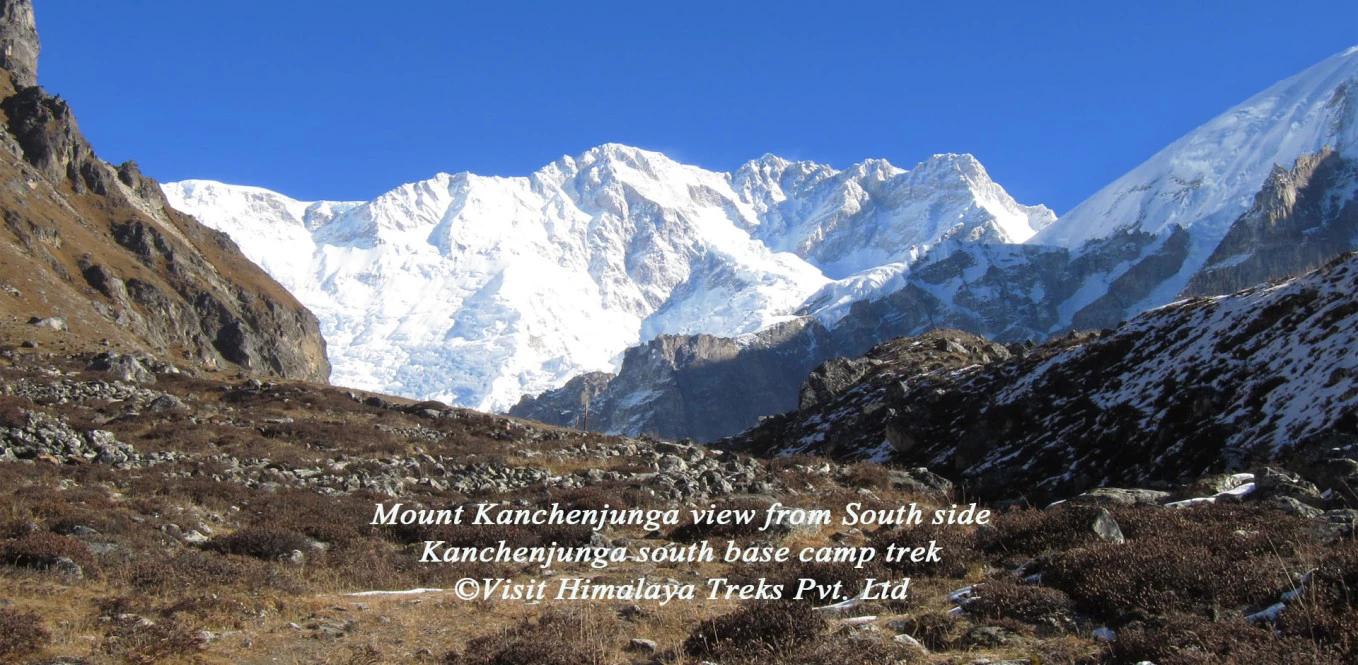
Best Selling Trip
TRIP OVERVIEW
QUICK INQUIRY
Kanchenjunga North Base Camp Trek - 16 Days

- Duration 16 Days
- Difficulty Level Strenuous
- Trip Start and End Kathmandu - Kathmandu
- Best Season Mar - May and Oct - Dec
- Trip Area Kanchenjunga Region
- Maximum Altitude 5143m.|16873ft.
- Trek in the Kanchenjunga Conservation Area and explore around the third highest mountain in the world
- Enjoy adventurous, off-the-beaten trekking
- Less crowded trekking route in the peak trekking season
- A budget-friendly alternative in one of the restricted areas in Nepal and slow itinerary
- If you are lucky, you may come across rare wildlife and birds
- Witness stunning mountain views and landscapes
- Get to see the unique mountain lifestyle of the locals
Our Kanchenjunga north base camp trek has a slow itinerary, perfect for those looking to spend a long time in the mountains. Unlike our Kanchenjunga Circuit Trek, it's more on the affordable side. The trek is led by expert guides, so you'll have a safe journey. We recommend Kanchenjunga north base camp trekking to seniors as well who are capable of walking at least 6 hours a day.
If you are looking for the best budget-friendly off-the-beaten trek in Nepal, then Kanchenjunga north base camp trek 16 days is the ideal package for you. You explore the far eastern part of the Himalayas and get to see jaw-dropping mountain panorama during the trek.
Kanchenjunga region is a restricted area that houses the third highest mountain in the world, Mt. Kanchenjunga. It is also home to some of the most exclusive wildlife & flora. Protected under Kanchenjunga Conservation Area, the trekking route has different climatic zones and ascends through sub-tropical lowlands to lush rhododendron forests that further go to alpine forests and open up to glaciers.
The Kanchenjunga base camp trek ascends to Pangpema (5,100 m), following the moraine of Kanchenjunga Glacier. You pass by beautiful remote villages resided by welcoming locals living a simple lifestyle. The off-beat trail and isolation of this region from other famous trails around the Himalayas have successfully preserved the essence of true wilderness trekking.
Mountain views during the trek
Kanchenjunga north base camp trek offers the best mountain views of Mt. Kanchenjunga (8,586 m/28,169 ft), Janu Himal (7,710 m/25,300 ft), Everest (8,849 m/29,032 ft), Makalu (8,463 m/26,247 ft), Tharpu Chuli (5,695 m/18,684 ft), Kabru (7,412 m/24,318 ft), etc. Likewise, along the way, you get to see gorgeous landscapes. There are pastures and rivers with yaks grazing on them, backed by snow-capped mountains. In the lower part of the trail, you mostly witness the scenery of dense forested hills and rivers with a glimpse of mountains.
Flora & Fauna
As we said, you’ll be trekking in the Kanchenjunga Conservation Area, so there's a high chance of you coming across exotic animals like Asian black bears, snow leopards, red pandas, etc. Similarly, if you love birds, then Kanchenjunga base camp trekking offers a great opportunity for you to see different species of birds, including snow cock, blood pheasant, golden-breasted fulvetta, etc.
Places you will embark on Kanchenjunga North Base Camp Trek:
Taplejung Taplejung is at an elevation of around 1820m.|5971ft. in the country's eastern region, close to the borderline with Sikkim, India. The townlet is the starting point for the Kanchenjunga Base Camp Trek and other treks in the Kanchenjunga region. The attractions in and around Taplejung are the Kanchenjunga Conservation Area, Phurumbu Danda, and the Phurumbu Monastery. The village is also home to several local markets and shops where you can purchase souvenirs and other items. If you are planning to embark on the Kanchenjunga North Base Camp Trek, on our first day we will travel to Taplejung from the Bhadrapur airport.
Chirwa Chirwa is a village situated at 1185m.|3887ft. above sea level in the Kanchenjunga region of the eastern Himalayas. Chirwa is a popular stop on the Kanchenjunga North Base Camp Trek, as it has a few lodges where trekkers can stay overnight. The journey to Chirwa involves a steep climb through dense forests and high alpine meadows. Now that roadways have evolved in the region, we can skip a couple of days of hiking by jeep ride directly from Taplejung to Sekathum.
Sekathum Located at an elevation of 1650m.|5413ft. Sekathum is a hamlet in the high Himalayas nearby Lelep and Lungthung villages. Sekathum lies above the intersection of Ghunsa Khola and Simbuwa Khola. The trekkers who want to spend long days on the Kanchenjunga trek can hike through the bank of Tamor Nadi, passing through Chirwa, Tapethok, Hellok, and Lelep, reaching the hamlet of Sekathum. According to our itinerary, we will drive from Taplejung to Sekathum, as the roadways have advanced to the village. We can reduce our days of trekking by driving to Sekathum.
Ghunsa Ghunsa is a tiny permanent settlement at the height of 3415m.|11204ft. in the Kanchenjunga region. You can stay at Ghunsa for acclimatization to Kanchenjunga Trek. You can find incredible places for the short day hikes, such as Dudh Pokhari (Milky Lake) and Ghusa Viewpoint.
Khambachen Khambachen is at an elevation of 4145m.|13599ft., with a couple of tea houses on the track to Kanchenjunga North Base Camp. If you want to explore the Kanchenjunga for more days, we suggest keeping a day extra at Khambachen. Khambachen is considered one of the great locations for acclimatization day. You can go on a side trip from Khambachen to Nupchu Pokhari or Janu Viewpoint.
Lhonak Lhonak, at an altitude of 4792m.|15721ft., is the final place to stay before reaching Kanchenjunga North Base Camp. From Lhonak, we can take in the spectacular panorama of snow-covered Mt. Kanchenjunga and several peaks bordering Tibet and Sikkim. We head towards the Kanchenjunga North Base Camp, also known as Pangpema, our final destination of the Kanchenjunga Trek from Lhonak.
Why trek with Nepal Nirvana Trails?
Our packages are hand-picked, and the itineraries are designed in a way to provide the best trekking to our guests. You can notice we have very distinct packages too. Regardless of our effort to offer something different in the Himalayas, our package costs are minimal and the best in the market.
Our goal behind creating the Kanchenjunga budget trek is to let travelers with low budgets explore the wonders of this region. You trek with the native guides and porters, who are trained in first-aid, remote survival, and rock climbing. They also have extensive knowledge about the trail.
You can rely on us for all your traveling needs in Nepal. We assure you of a safe trip and guaranteed departure. To book the Kanchenjunga north base camp trek 2024/2025, click on our booking button on the package page or get in touch with us.
Day to Day Details
Day 1: arrival in kathmandu (1400m.|4593ft.).
The Nepal Nirvana Trails representative will be waiting for you at the airport, with the company holding a board with your name. He/she will take you to the airport and help with the check-in. You can explore the night streets of Thamel in the evening.
- 1400m.|4593ft.
Day 2: Trek preparation and 3 Temple tour (1400m.|4593ft.)
Today is the free day before the long hike to Kanchenjunga North Base Camp. We will meet you at 8 am and take your original passports and two copy of photos for permit preparation. The tour guide will receive you from the hotel and take you to explore the three temples, Pashupatinath, Swayambhunath (Monkey Temple), and Boudhanath Stupa. The tour will last for 4-5 hours. Our team management will meet you at 5 pm at our office and return your permits. The trekking guide will be introduced to you. If you need any equipment for the trek to buy or rent, your guide can help you.
Day 3: Flight to Bhadrapur, then Drive to Taplejung (1820m.|5971ft., 8-9 hrs drive)
We will take an early flight to Bhadrapur from Kathmandu. From Bhadrapur, we will grab the seat and drive to Taplejung (1820m.|5971ft.). We will pass through picturesque places like Birtamod, Illam, Jorpokhari, Amarpur, etc., and cross through the Kabeli Khola Bridge to reach Taplejung.
- Breakfast, Lunch and Dinner
- 1820m.|5971ft.
Day 4: Taplejung to Sekathum (1650m.|5413ft., 39km.|24.23miles. 5 – 6 hrs drive)
We begin our drive of about 5-6 hrs following the route from Taplejung to Sekathum, which is approximately 39 km away. We may encounter narrow and winding roads on our drive. We will check our permits on the Kanchenjunga Conservation Area check post and pass through various settlements. By traveling along the Tamor Nadi and passing through some bridges, we will eventually reach Sekathum.
- 1650m.|5413ft.
Day 5: Trek from Sekathum to Amjilosa (2498m.|8195ft., 9km.|5.59miles. 5 - 6 hrs trek)
We will begin our hike to Kanchenjunga North Base Camp today. We commence the trek from Sekathum to Amjilosa crossing several suspension bridges and walking through Rhododendron forests. With the walk uphill and downhill, passing several little settlements, we will reach Amjilosa in about five to six hours. We will stay at Amjilosa overnight.
- 2498m.|8195ft.
Day 6: Trek from Amjilosa to Gyabla (2725m.|8940ft., 7km.|4.66miles, 4 - 5 hrs trek)
We will hike to Amjilosa, leaving Sekathum behind, following the bank of Ghunsa Khola. We will walk through the forest track, and there is a rare chance that we can spot a red panda. Ambling along the trail, we can see the splendid view of the snow-capped mountains. After about four to five hours of walking, according to our pace, we will reach Gyabla/Kyapra village, where we stay for the night.
- 2725m.|8940ft.
Day 7: Gyabla to Ghunsa (3415m.|11204ft., 10km.|6.21miles., 5 hrs trek)
After having breakfast, we will move forward on your path to Ghunsa. The trek follows the track of the forests. We can meet the trekkers moving toward and returning from the Pangpema, Kanchenjunga North Base Camp. We can encounter the Himalayan yaks carrying loads upward and downward on our way to Ghunsa. After walking for about five hours, we reach our destination for the day, Ghunsa.
- 3415m.|11204ft.
Day 8: Ghunsa to Khambachen (4145m.|13599ft., 10km.|6.21miles., 5 - 6 hrs trek)
The trekkers stop at Ghunsa to acclimatize their bodies and hike to Ghunsa Viewpoint or Dudh Kunda. But we will make our way to Khambachen after having breakfast, strolling through the open pine forest. Passing through the villages like Rambuk Kharka and Lyakep, enjoying the vista of Jannu(7711m.|25298ft.), Temachungi(6305m.|20685ft.), Pholesobi Thongje(6652m.|21824ft.), and many more, we will get to Khambachen.
- 4145m.|13599ft.
Day 9: Acclimatization and Rest Day
Today, we will have acclimation in Khambachen. The village offers a stunning view of the Jannu, Nagphu, Sarphu ranges, Nupchu, and many more. You can stroll around Khambachen village, hike up to Nupchu Pokhari (4952m.|16246ft.), or Janu Viewpoint. Overnight stay at teahouse in Khambachen.
Day 10: Khambachen to Lhonak (4792m.|15721ft., 10 km.|6.21miles., 4 - 5 hrs trek)
Following a trail of the bank of Ghunsa Khola, we will get closer to the Kanchenjunga North Base Camp. Getting to Ramdang(4375m.|14353ft.), we can see the stunning vistas of Kanchenjunga, Ramtang, Gimmigela, and many more. Walking along the side of Kanchanjunga Glacier and across the path through Dry Lake, we will reach Lhonak.
- 4792m.|15721ft.
Day 11: Hike to Kanchenjunga North base camp (Pang Pema) (5143m.|16873ft.) and return to Lhonak (9km.|5.59miles. 6 - 7 hrs trek)
We will be at the base camp of the World's third-highest mountain, Mt. Kanchenjunga. We start our day trip to Pang Pema, Kanchenjunga North base camp, with glorious views of the mountains en route. After spending some hours at the base camp with the prayer flags and the splendid views of the Himalayas, we will return to Lhonak.
- 5143m.|16873ft.
Day 12: Lhonak to Ghunsa (3415m.|11204ft., 21km.|13miles., 7 - 8 hrs trek)
Retracing the path we came to the stunning Kanchenjunga Base Camp, we will start our way down to Ghunsa. Relishing the rhododendron forests and vistas of the mountains, we will reach Ghunsa.
Day 13: Ghunsa to Sekathum (1650m.|5413ft., 6 - 7 hours)
Today we will walk downhill to Sekathum. The walk is longer, so we will begin our trek earlier. Passing through the track of the bank of Ghunsa Khola and crossing Phale, Gyabala, Amjilosa, and Ghaiyabari, we will reach Sekathum. There is steep descent and ascent, stone steps on our way to Sekathum.
Day 14: Sekathum to Kanyam, Ilam (1210m.|3969ft., 6 - 7 hrs drive)
Leaving the mountains behind, taking the memories, and feeling the cool breezes, we will catch our jeep and begin our ride to Kanyam, Ilam, the tea cultivation area. You can find a huge mass of Domestic tourists in Kanyam.
- 1210m.|3969ft.
Day 15: Drive from Ilam to Bhadrapur and late afternoon flight back to Kathmandu (1400m.|4593ft.)
We will visit the tea cultivation area for a while and drive to Bhadrapur Airport. The 45 to 50 minutes flight from Bhadrapur will bring us to Kathmandu in the late afternoon. We will accompany you to the hotel. Tonight, we invite you to have dinner with us and share your feedback on the trek.
- Breakfast, Lunch and Farewell Dinner
Day 16: Free from Program
We will meet you at the hotel and bid you the final goodbye and arrange for the vehicle to drop you at the airport.
Note: If you have extra days in Nepal and want to do other activities besides trekking, we can organize rafting, paragliding, bungee jumping, canyoning, and many more.
Want to customize your trip? Share your holiday plans. Our travel experts create an awesome trip for a lifetime experience holiday.
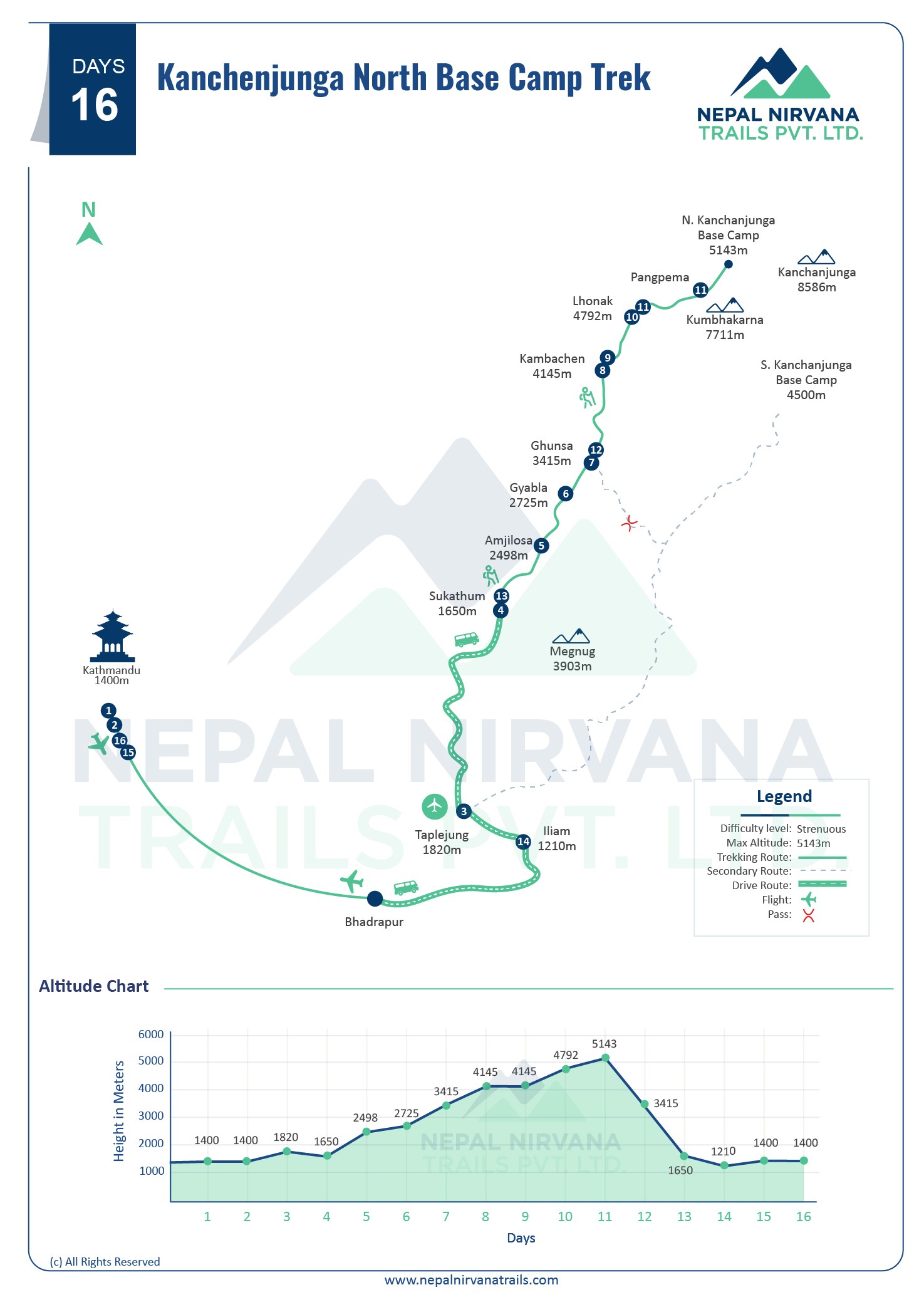
What's Included
- Airport Transport International and Domestic Flight
- Three-night Hotel in Kathmandu
- Three temple Day Tour (Tour Guide and Transport included in trip cost)
- Accommodations during the treks
- 3 meals (Breakfast, Lunch, Dinner) with Tea/Coffee.
- Available Seasonal Fresh fruit
- Government licensed trekking guide.
- Guide salary, food, equipment, and insurance, including on-trip cost
- Sharing Jeep / Bus (Bhadrapur - Taplejung - Sekathum and Sekathum - Illam - Bhadrapur airport)
- All applicable National park, Tims and Local permits
- Flight Kathmandu - Bhadrapur - Kathmandu
- Sleeping bag if needed (it is refundable)
- Nepal Nirvana Duffle, T-shirt, Trekking map, and Water purification drop
- Farewell Dinner in a fine Restaurant
- Official expenses and government tax/vat.
What's Excluded
- Travel and health Insurance which covercoversgency Rescues and evacuations
- Lunch and dinner in Kathmandu
- Late Departure and Early arrival from the trek accommodation Self.
- Monuments entry fee
- Porter ($320 One porter between two trekkers)
- Private Jeep ($400 - Bhadrapur - Taplejung - Sekathum and Sekathum - Illam - Bhadrapur airport)
- Personal expenses, snacks, drinks, WI-FI, etc.
- Tips for treks guide, porter (it is appreciated)
- What is not mentioned above
The package provides an affordable way for budget-conscious trekkers to explore the Kanchenjunga Region. However, there is also the option to enhance your experience with add-ons to the package.
Porter Service
You have the option to include a porter in addition to your guide. The porter carries a load of up to 20 - 25 kilograms. You can share the heavier belongings with the porter, allowing you to trek more comfortably and with the guidance of your trekking guide.
One Porter Costs: USD 320
Private Transportation
We offer sharing bus/jeep transportation between Bhadrapur - Taplejung - Sekathum and Sekathum - Ilam - Bhadrapur airport with the package.
Alternatively, you can opt for private transportation for an additional fee, which covers the journey from Bhadrapur - Taplejung - Sekathum and the return trip from Sekathum - Ilam - Bhadrapur airport.
Private Jeep from Bhadrapur airport - Taplejung - Sekathum: USD 300 Private Jeep from Sekathum - Kanyam - Bhadrapur airport : USD 300
Upcoming Departures
Useful info, kanchenjunga base camp trek difficulty.
Kanchenjunga trekking is generally considered one of the most challenging treks in the Himalayas and is recommended to experienced trekkers only. And it is a very demanding trek. The thing that makes our Kanchenjunga north base camp trek 16 days special is our slow itinerary. We have designed this budget-friendly Kanchenjunga trek for travelers who are open to spending more time amidst mountains.
We are not implying that it's going to be a comfortable trek. Rather our itinerary will let you trek slowly, enjoying every turn in the trail. Now, talk about your physical fitness, it has to be good, and of course, we need previous trekking experiences. Go on some day hikes and hit some easier treks in the Himalayas before aiming towards Kanchenjunga north base camp trekking.
If you are an experienced trekker who is ready to level up their trekking game, then we gladly welcome you to join us on our 16 days of adventurous trek in the Kanchenjunga region. Our team will provide you with all the necessary information regarding the trek and get you ready for it in no time.
Altitude Sickness
The highest altitude you touch on the Kanchenjunga north base camp trekking is 5,143 meters (16,874 ft). You spend six days above 2,500 meters, which makes you vulnerable to altitude sickness and also puts a lot of pressure on your body. The oxygen level gets thin as you approach the base camp. And you may not want to drink water frequently or even lose your appetite. It's given and common.
Even with all the odds, you have to keep yourself reminded to eat nutritious food and keep yourself hydrated to avoid altitude sickness. Our crew will make sure you eat and drink plenty of water. So, you may be thinking about how dangerous altitude sickness can get?
To be honest, altitude sickness is a common illness. However, if the symptoms do not subside, trekkers sometimes end with emergency evacuation, and the trek ends right then & there. Likewise, taking proper rest in between the trek is crucial too. So, we have acclimatization days in our Kanchenjunga north base camp trek itinerary.
Kanchenjunga trek itinerary
Upon your arrival in Kathmandu, we prep ourselves for the trek and take some time to appreciate the ancient monuments in Kathmandu. From Kathmandu, it's a short flight to Bhadrapur, and on the same day, we drive to Mitlung via Taplejung. The following day, the trek begins. We walk to Chirwa. In the next few days, we trek through lush forests and remote villages like Sekathum, Amjilosa, Gyabla, Ghunsa, and Khambachen.
All these villages are our rest points. We'll walk through many other small settlement areas and pass by beautiful waterfalls. We cross several streams and bridges on the way too. We take a rest day in Khambachen and pass by Lhonak before ascending to the Kanchenjunga north base camp. We follow the same trail back to Ghunsa and descend to Chirwa. The last day of the trek leads us from Chirwa to Taplejung.
Last Minute Booking for Kanchenjunga north base camp trekking
Taking last-minute bookings for packages like Kanchenjunga may not be feasible most of the time. But if we have even a small chance to arrange all the requirements, we'll gladly take the last-minute booking. So, do not hesitate to talk to our travel consultant at +977 9841380469 or +977 9843987606 (WhatsApp/Viber for a quick response) and see if it's possible or not.
*Note: We need 100% of the Kanchenjunga north base camp trek cost to accept the booking at the last minute.
Kanchenjunga trekking permit
Kanchenjunga trek permits are one of the most expensive permits in Nepal. It is a restricted area, so the trekkers have to obtain special permits. You'll need Kanchenjunga Conservation Area Project Entry Permit (KCAP) and Restricted Area Entry Permit. The trails of Tapethok and Yamphuding VDCs are restricted areas.
Kanchenjunga Conservation Area Project Entry Permit (KCAP) cost: Nrs 2000 per person
Restricted Area Entry Permit cost: USD 20 per person, per week
Best time to trek to Kanchenjunga base camp trek
The best time to do Kanchenjunga north base camp trekking is during the peak trekking season in the Himalayas. It's spring (March to April) and autumn (October to November). You can trek in these two seasons without worrying about unstable weather. Other seasons- winter and monsoon/summer are off time, which means, not suitable for trekking in the Kanchenjunga region.
Kanchenjunga trekking in spring and autumn lets you have the best trekking experience. The views of mountains and hills are fantastic. The climate is pretty moderate with a little cold in the nights & mornings. The teeming forests with seasonal vegetation and flowers enhance the trails. The walk is impressive and soothing.
Accommodation
Kanchenjunga north base camp trek is a teahouse trek. Kanchenjunga region is one of the least explored and undeveloped trekking routes in the Himalayas. If we compare the trail to Kanchenjunga base camp with other famous trekking routes like Everest base camp or Annapurna base camp, then there's pretty much nothing. That's why this trek is for trekkers whose endurance level is high when it comes to remote survival.
There is a somewhat countable number of teahouses available along the trail, but the services are very basic and limited. The rooms are equipped with two seperate beds, pillows, and blankets to have a good night's sleep. The washroom is shared. Do not expect hot water unless you are ready to pay a few extra bucks for it.
Food options are not that great. You'll get delicious authentic Nepal meals to have on a daily basis that will keep you energized. For instance, dal bhat, dhido, roti tarkari, etc. Meat items are available on the menu. We recommend you ask how old the meat is before ordering it. There are not many snacks available in the teashops on the way, so we advise you to carry your favorite snacks.
Other items like soup, porridge, burgers, pasta, mashed potatoes, oats, eggs, toast, etc are also available on the menu usually. We carry water purification tablets with us, so no worries about drinking water. Only make sure to pack a reusable water bottle for yourself.
Travel Insurance
Kanchenjunga north base camp trek is a very remote trek with high altitude. Therefore, travel insurance is a necessary part of our booking requirements. You have to get travel insurance with emergency air evacuation up to 6,000 meters, and if possible, also add medical bills.
Kanchenjunga region is hostile. Trekking in the north base camp of Mt. Kanchenjunga is not impossible, but does have risks, which can be minimized. Our goal is to take our guests to the most untouched part of the Himalayas safely, so we need travel insurance for some special packages like this one.
Travel Tips (electricity, internet, ATM, luggage, tipping, personal expenses)
- There should not be an issue with charging your device during the Kanchenjunga north base camp trekking. Charging stations are available in all the tea houses. You only have to pay a few extra bucks.
- It's better to carry a Nepali Sim and use cellular data for the internet instead of hoping for WiFi on the trail. You may see a disturbance in the network often because of elevation, weather, and remoteness of the region.
- Tipping is not covered in the package cost and is expected at the end of the tour & trek. So, better be prepared and make a small budget for it.
- You are free to buy additional snacks and drinks during the trek. There's no ATM on the trail, and neither the locals accept foreign currency, let alone cards. So, carry some Nepali cash with you.
- The hard carry luggage weight for each trekker is 5 kgs (allowed in airplanes), and the duffel bag weight limit is 10 kgs for each trekker. One porter carries two duffel bags.
Q1. How difficult is Kanchenjunga north base camp trek?
Kanchenjunga north base camp trek is strenuous (very demanding). It's an off-the-beaten trek with lots of hurdles. The facilities along the trail are very limited and expensive. There is also a risk of altitude sickness.
Q2. Can we trek to Kanchenjunga?
Yes, you can trek to Kanchenjunga but only in a group of two or more people. The guide and porters assisting in the trek are not counted in the group. Also, you can only travel in this region with a locally registered trekking company. Otherwise there's no way to obtain a restricted area permit.
Q3. Which is the base camp of Kanchenjunga?
There are two base camps on Mt. Kanchenjunga. The north base camp, also called Pangpema is at 5,143 m/16,873 ft, and the south base camp is at 4,780 m/15,682 ft.
Q4. How do you trek to Kanchenjunga?
To trek to Kanchenjunga, you have to arrive in Kathmandu, Nepal. From Kathmandu, you have to take a flight to Bhadrapu and drive to Taplejung where the trek begins. From here, you trek for five days to reach the base camp of Mt. Kanchenjunga and follow the same trail back to end the trek.
Q5. Is Kanchenjunga and K2 the same?
No, Mt. Kanchenjunga and Mt. K2 are not the same. They are two different mountains in two separate countries. Mt. Kanchenjunga is the third highest mountain in the world, located in Nepal. Mt. K2 is the second-highest mountain in the world, located in Pakistan.
Q6. Can I do a solo trek to the north Kanchenjunga base camp?
No, you cannot do a solo trek to the north Kanchenjunga base camp or anywhere in the Kanchenjunga region. Solo trekking is prohibited in the Kanchenjunga region by the government of Nepal as it is a restricted area.
Q7. How safe is Kanchenjunga north base camp trekking?
Kanchenjunga trek is quite safe because you trek with an experienced crew who have led many groups in the past. Our team will take care of you and your needs on the trail. You do not have to worry about anything and just be attentive on the way.
Q8. Can I trek with my kid to Kanchenjunga base camp?
Trekking with a kid in the Kanchenjunga region can get tricky. It's not impossible and depends on your kid's adjustment capability. We recommend doing a camping trek if you are planning the Kanchenjunga base camp trek with your child.
Q9. Do you have a guaranteed trip?
Yes, we assure a guaranteed trip departure. Our trip only gets canceled if any uncontrollable events occur like political chaos, bad weather, natural disaster, etc. In cases like this, we postpone the trek or refund the trip cost to our guests (as per their desire).
Q10. Who do I trek with? How's my guide?
You trek with one of the most experienced native guides during the Kanchenjunga base camp trekking. Along with a guide, porters also accompany you (depending upon your requirement). Our guides are very friendly and kind. You'll have a very comfortable journey. We'll assign you a guide who can speak fluent English. There'll be no language barrier issue.
Similar Trips
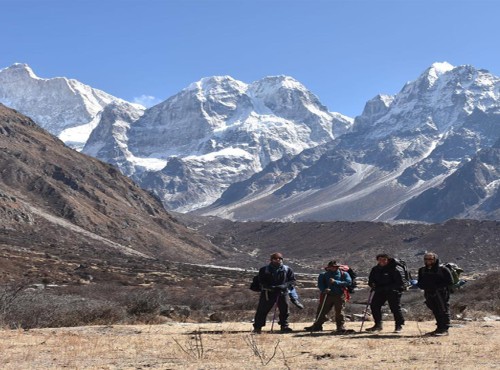
Kanchenjunga Base Camp Trek - 18 Days
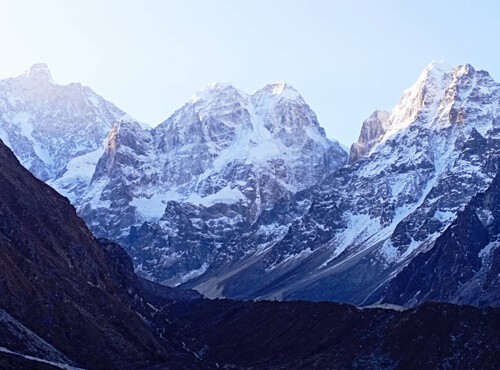
Kanchenjunga Circuit Trek - 19 Days
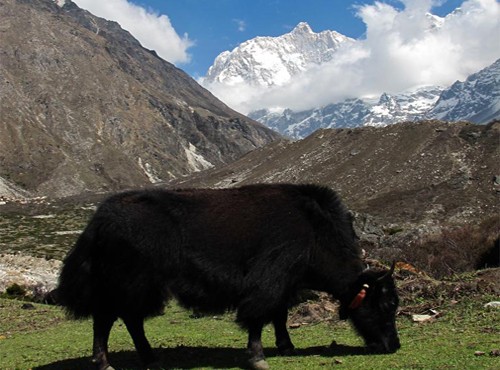
Kanchenjunga South Base Camp Trek - 14 Days
Ask a question.

Are you looking for the Nepal holiday? or need help to plan a trip, please do not hesitate to get in touch with us.
We use cookies to ensure that we give you the best experience on our website.
Connect With Us :

Follow Us :
Kanchenjunga base camp trek.

Kanchenjunga Base Camp Trek Overview
Many people imagine themselves wandering through the laps of the giant mountains in the Himalayas. In the Himalayas, you can find plenty of routes that go through the typical mountains. But more than that, you can find the routes that go through the world’s highest mountains here.
Among such routes, one of the most amazing and popular routes is the Kanchenjunga base camp route. However, It is popular for a reason. The reason is, that it passes through the less explored paths as it heads to the world’s third-highest mountain, Kanchenjunga.
Being one of the highest mountains in the world, Kanchenjunga is located in the remote region of the eastern encompass of Nepal. On this trip with us, you will walk through the off-the-beaten path of this untamed adventurous region of Nepal. Also, you will be exploring some of the highest points of the Kanchenjunga region that cross the 5000-meter mark.
While going through these amazing routes, you will not only encounter amazing views of nature and mountains. You will also gain great insights and information about the culture and heritage of the Tibetan and Buddhist people. This culture and heritage mostly belong to the mixture of the Limbu, Sherpa, and Rai communities.
To be more specific about the landscapes, you will pass through a variety of landscapes in this trekking journey. From alpine grasslands to subtropical forests and then to the rocky icy slopes, you will explore them all on this trek. While walking through these varied routes, you can witness the amazing views of the mountains. You will see the highest mountains in the world like Everest, Lhotse, Makalu, and Kanchenjunga on this trek.
As you now know that you have to go through a high altitude, you might have already guessed that this trek is hard. Yes, it is a bit tougher trek than the other renowned treks such as the Annapurna and Everest treks. But trekkers who prefer long hikes with good health can expect to do this Kanchenjunga base camp trek.
Trip Highlights:
- Stunning views of Kanchenjunga, the world's third highest peak, and surrounding Himalayan peaks.
- Immersion in rich biodiversity. From lush rhododendron forests to rare wildlife like the elusive snow leopard.
- Cultural encounters with indigenous communities such as the Rai and Limbu people. Great chance to Experience their unique traditions and hospitality.
- Challenging trekking terrain, including steep ascents, rocky trails, and high mountain passes.
- Remote wilderness experience, far from the crowds, allowing for solitude and a deep connection with nature.
- Exploring alpine meadows and pristine glacial lakes dotted along the trekking route.
- Opportunity for birdwatching, with a variety of Himalayan bird species found in the region.
- Crossing dramatic suspension bridges and traversing rugged landscapes, adding excitement to the adventure.
- Reaching the iconic Kanchenjunga Base CampReaching the iconic Kanchenjunga Base Camp, a pinnacle of achievement and a place of unparalleled natural beauty., a pinnacle of achievement and a place of unparalleled natural beauty.
History of Kanchenjunga Base Camp Trek
Being one of the highest and most beautiful mountains in the world, the holy Kanchenjunga is also considered home to the gods. Along with the history of the gods, we also want to mention that the first summit was held in 1955 by Joe Brown and George Band . But later on, the Kanchenjunga base camp trek was officially opened for trekking in 1988.
As you know Kanchenjunga is the world’s third-tallest mountain, you may not have known that this peak is the combination of the Five big massifs. Those big five massifs are –
Name of the Peak Height (meters/feet)
Kangchenjunga Main 8,586 28,169
Kangchenjunga West (Yalung Kang) 8,505 27,904
Kangchenjunga Central 8,482 27,828
Kangchenjunga South 8,494 27,867
Kangbachen 7,903 25,928
Furthermore, Here are the short history descriptions of the Kanchenjunga base camp trek:
- Exploration : The Kanchenjunga region remained largely unexplored until the mid-19th century. It wasn’t until British colonial officers and surveyors started mapping the area. that Westerners began to hear about this beautiful mountain range.
- Trekking Route Development :Trekking routes to the Kanchenjunga Base Camp are more popular among adventurers. seeking more remote and less crowded trails. The trek typically takes around three weeks to complete. It passes through lush forests, alpine meadows, and remote villages that go by ethnic communities like the Rai and Limbu people.
- Conservation Efforts : The region is also home to diverse flora and fauna, including rare species like the elusive snow leopard. Efforts to protect the environment and wildlife should be made. So for that reason, the Kanchenjunga Conservation Area was established in 1998. This conservation area covers a total area of 2,035 square kilometers.
- Present Day : Today, the Kanchenjunga Base Camp trek is considered one of the most rewarding and challenging treks in Nepal. It offers breathtaking views of Kanchenjunga and other peaks in the range. Also, it offers the opportunity to experience the unique culture and natural beauty of the region.
Hence, the history of the trek to Kanchenjunga Base Camp is linked with the quest for knowledge of the Himalayas. Also, it has a big role in the growth of Nepali tourism, and efforts to preserve the country’s natural heritage.
What makes the Kanchenjunga base camp trek so special?
First of all, being a journey to the 3rd tallest mountain in the world makes itself a special and unique journey. This region is less trekked than the other tallest mountain regions, like Annapurna and Everest. So, this thing ultimately makes it a special trek.
The Kanchenjunga base camp trek is very remote and it receives few travelers. However, it is off the beaten path, which makes it special and unique. Here are the other several reasons why the Kanchenjunga base camp trek is special and unique-
- Remote and unaltered scene: This trek takes you to one of the most remote and pristine regions of the Himalayas. The landscapes are untouched in this region. So for that reason, you will see the original and unspoiled views everywhere. Especially, you will see the giant peaks from different angles.
- Cultural Experience : The trek also allows you to immerse yourself in the rich cultural landmarks of the region. You’ll encounter various ethnic groups such as the Sherpas, Limbus, and Rai people in this region. You will see each of them with their distinct traditions, languages, and lifestyles.
- Biodiversity : The Kanchenjunga region is also renowned for its rich biodiversity. You’ll travel across a variety of ecosystems in this trek. From beautiful subtropical forests to mountain meadows, and you’ll come across a vast diversity. Hence, throughout the route, you will encounter endangered and rare kinds of plants and animals.
- Challenging Terrain : Those looking for adventure will find their trek to be both difficult and rewarding. You’ll go through treacherous terrain, high alpine passes, and challenging ascents. These things will put your stamina and ability to endure the adventure.
Overall, the Kanchenjunga Base Camp trek is an incredibly unique experience for trekkers. Thanks to its distinctive combination of breathtaking natural beauty, cultural immersion, and biodiversity.
Can a beginner do the Kanchenjunga base camp trek?
The Kanchenjunga Base Camp trek is considered one of the more challenging treks in Nepal. So, it may not be suitable for complete beginners due to its remote location, high altitude, and demanding terrain. However, beginners can undertake this trek. They will have to do thorough preparation on their physical and mental fitness. Moreover, they also need to have an understanding of the challenges involved.
With the Requirements of such things, beginners therefore should consider joining guided tours. They should choose experienced trekking companies like us. So that, they receive proper support, guidance, and assistance throughout the journey.
Beginners should focus on physical conditioning, altitude acclimatization, and prior trekking experience. With some experience, they will be prepared for the demands of the Kanchenjunga Base Camp trek.
So, where does the trek to Kanchenjunga base camp trek begin and end?
The trek to Kanchenjunga Base Camp typically begins in the village of Taplejung, located in the eastern part of Nepal. Trekkers can either fly from Kathmandu to Taplejung or opt for a longer overland journey. From Taplejung, the trek then follows a route that passes through various villages, forests, and alpine landscapes. Then it gradually ascends toward the base camp of Kanchenjunga.
Similarly, the trek to Kanchenjunga Base Camp also ends back in Taplejung, the starting point of the trek. Trekkers typically retrace their steps along the same route they took to reach the base camp. They descend through the beautiful landscapes until they return to Taplejung.
Kanchenjunga Base Camp Trek Difficulty
Kanchenjunga Trekking is classified as one of the most strenuous trekking in Nepal. This trek is not every beginner’s cup of tea which means it is listed as the most difficult trek . Since this is a restricted area and difficult area to trek, the permit is not given to solo trek to Kanchenjunga. You have to take a guide with you or anybody else with you.
The Kanchenjunga base camp trek route is considered a challenging route because you have to go through a variety of mountain passes. But you know this is a stunningly beautiful route filled with nature and stunning trekking trails. So this trip must be experienced by every adventure junkie. Furthermore, trekkers will endure challenging ascents and descents while heading to their destination.
In addition, the length of time required for the Kanchenjunga base camp trek makes it more challenging. The backpackers should walk through the peaceful settlements for 3 weeks. Getting to the elevation of 5150m and passing several passes is not easy. Every day you must motivate yourself and have the patience to conquer the Kanchenjunga base camp trek.
Certainly, the Kanchenjunga base camp trek is stressful. But, hikers will enjoy the scenic trails. They will see terraced fields, glacial rivers, groves, and a mind-blogging mountain panorama. This will help to heal all the pain that you will experience in this journey.
Best time to visit Kanchenjunga Base Camp Trek
One of the exceptional nations in the globe with a beautiful geographic location is Nepal. Likewise, the alien culture and traditions are also commemorated in Nepal which falls into different months.
The optimum time for the Kanchenjunga base camp trek depends on person to person. Because every trekker has their favorite season which they enjoy most. However, trekkers in Nepal prefer the middle of March to the end of June and the middle of September to late November. According to them, these will be great times to explore this KBC region.
The Kanchenjunga Base Camp trek is worth visiting throughout the year. But at this peak time, there will be perfect weather conditions. You can get to see a crystal clear view of the landscapes, Himalayan panoramas, and attractive scenarios.
Further, we want to tell you that doing the Kanchenjunga base camp trek is possible in another season also. Spring and autumn are the most popular times for the Kanchenjunga Base Camp trek. But, it’s also possible to undertake the trek during other seasons, although they come with their considerations-
Summer (June to August): Summer, or the monsoon season, brings heavy rainfall to the region. So this can make trekking challenging on the routes of the Kanchenjunga base camp trek. The trails become muddy and slippery, and there is a risk of landslides and flooding in some areas. Furthermore, the monsoon clouds also block the views of the mountains, limiting visibility.
On the other hand, for those who are brave enough to face the rain, the hillsides come alive with colorful flowers and greenery. So, trekkers should be prepared for wet and humid conditions. Also, it’s essential to check weather forecasts and trail conditions before going on the trek this season.
Winter (December to February):
Winter brings cold temperatures and snowfall to the Kanchenjunga region. The trails can be icy and snow-covered, making trekking more challenging and potentially dangerous. Due to the cold weather and a drop in trekkers, some teahouses and guesthouses remain closed. So during the winter, there will be fewer possibilities for accommodation.
For those who are prepared for the cold, wintertime also offers gorgeous snow-covered scenery. Also, it has calmer paths, making for a sublime trekking experience. Hence, trekkers should ensure they have appropriate cold-weather gear. And they should be cautious of the potential for avalanches in certain areas.
Overall, spring and autumn are the preferred times for the Kanchenjunga Base Camp trek. However, adventurous trekkers may still enjoy unique experiences in other seasons. For that, it’s essential to be prepared for the specific challenges and conditions. trekkers have to look associated with each season and plan accordingly for a safe and enjoyable trek.
So, is this Holiday for you?
As you know this classic trek has been given a high grade. Considering its overall length, the remoteness of the area, and the number of tough days to spend at high altitudes make this trek a high-grade trek.
Even though it is known as one of the less visited routes in the country, the conditions of the paths are almost good. The sections of the route whilst crossing the Mirgin La and elsewhere there have been recent landslides are however little bit risky. While making the trip with us, you can totally ensure your safety.
Furthermore, know that there are no international standard luxury guesthouses and hotels here. You will find teahouses and guesthouses that are run by Nepali Households. However, by any chance, if we do not get accommodation in-house, then we can manage the tent. We will do the camping, where two persons will be able to accommodate inside it with a fully comfortable mattress.
Now that we have pointed out some exceptions to the trek, you can decide by yourself whether to choose this trek or not.
Why Book Kanchenjunga Base Camp Trek with Us?
Our guides have decades of experience in taking trekking groups on this classic itinerary. Also, we are in contact with the lodges being established along this route. But for now, while doing the trek we will have to take service from basic lodges and accommodations. As mentioned above, we can also manage camping facilities on this trek, which will be one of the most remarkable experiences for you.
Our treks in the Kanchenjunga region can be both private and group treks. For any kind of trek, we will require a minimum of two participants on that particular date to initiate the trip. Furthermore, we do not lie about our services. In the above sections, we have clearly listed the inclusions and exclusions. If you have any kinds of doubts relating to cost, then you can directly ask us.
There are a lot of companies in the market, that advertise trips for very low prices. But after booking the trip they may offer you the services of low cost. They May also cut off services on the trip, which could make you unsatisfied. Most of our trekkers are from the web or direct contact. Also through their referrals, many have been on our contact.
Hence, being in business for over 15 years, we employ only the most professional and friendly staff. So, there is no doubt that you will have a remarkable experience throughout the trek.
Important note regarding itinerary –
Since this is one of the longest treks in the country, your safety will be a top priority for us. The probability of some kind of issues in the multiple-week duration is high, so we also request you take care of yourself. Furthermore, Any part of your journey may pose a risk to your safety.
In such a case, the trek leader will have the authority to alter or cancel the specific itinerary. We will try our best to stick to the itinerary. But if the situation demands your safety then we will have to deviate from it. Different factors can lead to changes in the trip plan. Factors like the health conditions of trekkers, bad weather conditions, and natural incidents are ones. So, please make adjustments and be flexible according to the situation. Here is the detailed itinerary for this trek-
Kanchenjunga Base Camp Trek Itinerary
Day 1: land at the kathmandu airport and ride to the hotel room.
Walking Hours: 30 Min Drive
Meals Included: Welcome Dinner
Accommodation: 3 Star Category Hotel
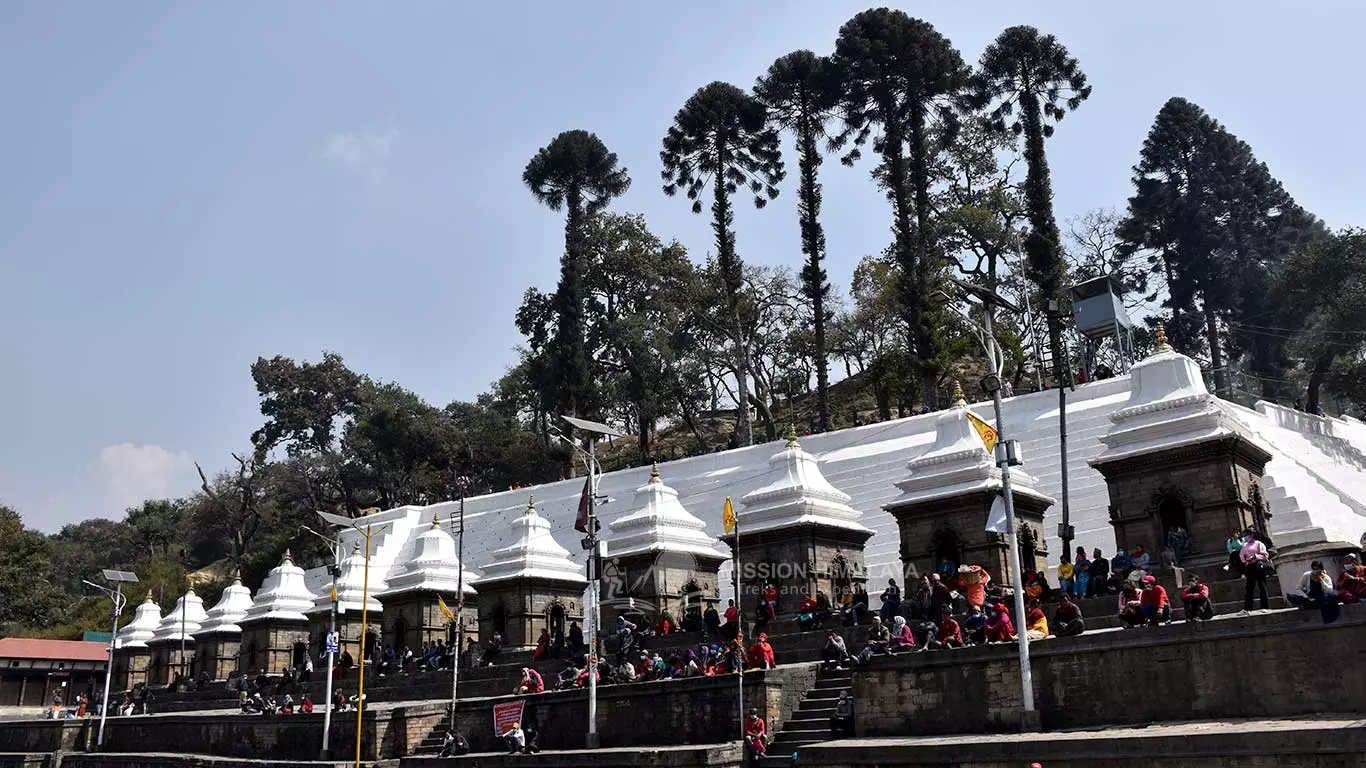
The highlight of the day: Views of Temples and stupas caress your eyes on this very first day.
Today, you will land from the aircraft at Tribhuvan International Airport. Then, our enthusiastic staff will transport you to the chosen place for your overnight stay.
When you get to your hotel, you can go to your room and relax for a bit. After that, leave your room and wander through the bustling streets of Thamel to delight in Nepal’s rich and rakish nightlife.
Day 2: Trek preparation and Sightseeing Tour
Walking Hours: Flight 45 Min. Drive 5-6 Hours
Meals Included: Breakfast, Lunch And Dinner
Accommodation: Lodge

Highlight of the day: Prolific venture into the cultural and historical life of Kathmandu.
Unlike your prosaic day-to-day life, your 2nd day in Nepal commences with a Kathmandu World Heritage Sightseeing Tour . The tour is all about the admiration of the astonishing historical, cultural as well and religious wonders of Nepal. Today, you will see the ancient artistic pottery work of locals to the vast commercialization. Also, you will get to experience everything within the border of the Kathmandu Valley.
As the day is not all about sightseeing tours, we will therefore pilfer some of your time for the pack and plan for the Kanchenjunga base camp trek. The permit to Kanchenjunga cannot be issued without your visa-stamped original passport. So, this day in Kathmandu is mandatory for every trekker.
Day 3: Fly Biratnagar and drive to Birtamod
Walking Hours: Drive 1 Hours
Accommodation: Tea House/Lodge

The highlight of the Day: Aerial view as well as overwhelming hospitality of the Eastern portion of Nepal.
There are a number of alternative flights to the Kanchenjunga Trek starting point. But, we will fly via Kathmandu to Biratnagar considering your comfort. After reaching Biratnagar, we will make a short drive to Birtamod and stay overnight there.
Day 4: Drive to Taplejung
Walking Hours: 6 Hours Trek
Max. Altitude: 1820M

Highlight of The Day: Scenic view of Illam, a tea plantation area in Nepal.
The trip of this day is all about tea and cardamom plantations. The slanted hills of most of the portions of the trails serve best for the growth of these tea spices. Reveling amidst the enthralling tea and cardamom gardens, we will then stop at Taplejung before starting the next day’s trek.
Day 5: Follow the jaunting trail to Chiruwa
Walking Hours: 5 - 6 Hours Trek
Max. Altitude: 1270M

Waking up with the melodious chirping of birds, you will savor the delicious breakfast at Pungling Bazar of Taplejung. Then, you will head out on your journey to Chiruwa.
The trail between Pungling to Chiruwa plunges up to Mitlung and continues the descent to the Tamur River. Following the trail, you will pass through villages consisting of fertile land. Here you will find growing potatoes, rice, millet, and several other crops. Shortly after, you will then reach Chiruwa and stay there for the night.
Day 6: Trek to Sekathum
Walking Hours: 5 To 6 Hours Trek
Max. Altitude: 2390M

Highlight of the Day: Thrilling Timber bedded bridges.
Today we get slightly closer to our destination Kanchenjunga Base Camp. We will follow the passage along the Tamur River. And then we will pass through the scattered thin villages of Taplethok, Temewahellok, and Ranipul. We will also cross several wooden as well as swinging bridges.
Further, the trail of the Kanchenjunga base camp trek will give us ample opportunity to witness landscapes. You can see cardamom cultivation on both green farmland terrain and the flora of the area.
Day 7: Trek to Gyabla
Max. Altitude: 2730M

Water sources like rivers, streams, and waterfalls will be spotted on this day. Every two minutes of walks on the uphill ridge trail of Kanchenjunga Base Camp you will see them. Thus, the route from Sermanthang to Gyabla also has no exception. While passing the routes, you have to walk over several suspensions as well as timber-made bridges.
Crossing a plethora of such bridges we reach Amjilossa. Then following the undulating route full of rhododendrons, bamboo, and oak we will walk toward Gyabla. Stay overnight at Gyabla.
Day 8: Trek to Gunsa
Max. Altitude: 3427M

The highlight of the Day: Enjoy the first view of Mt.Jannu
Though not at full, the luxury you have missed since the start of the Kanchenjunga base camp trek will be replenished today by the lavish stay at Gunsa. Commencing the Kanchenjunga base camp trek from Gyabla we will delve into the natural sceneries. We will encounter sceneries like waterfalls, rivers, and forests and head towards Gunsa.
On the way, you will eat lunch at Phale from where the trail takes us surprisingly to our today’s final destination, Gunsa. Upon reaching Gunsa, the views of Mt. Jannu ignite some positivity and happiness in every trekker’s face.
With an elevation, you will witness 7711m Mt.Jannu aka Mt.Kumbhakarna or the Sleeping Lion. It is the Thirty-Second highest mountain in the world and the 14th highest in Nepal. Here at Gunsa, we will show our permits at the Kanchenjunga Conservation Area Office and stay overnight there.
Day 9: Rest Day

The day is allocated specially for acclimatization purposes. After the continuous full-time walk of the 5 days, our body requires some rest on this Kanchenjunga base camp trek. Moreover, to make our minds cool to some extent, this one day’s rest will act as the best remedy for healing.
Day 10: Gunsa to Kambachen Trek
Max. Altitude: 4050M
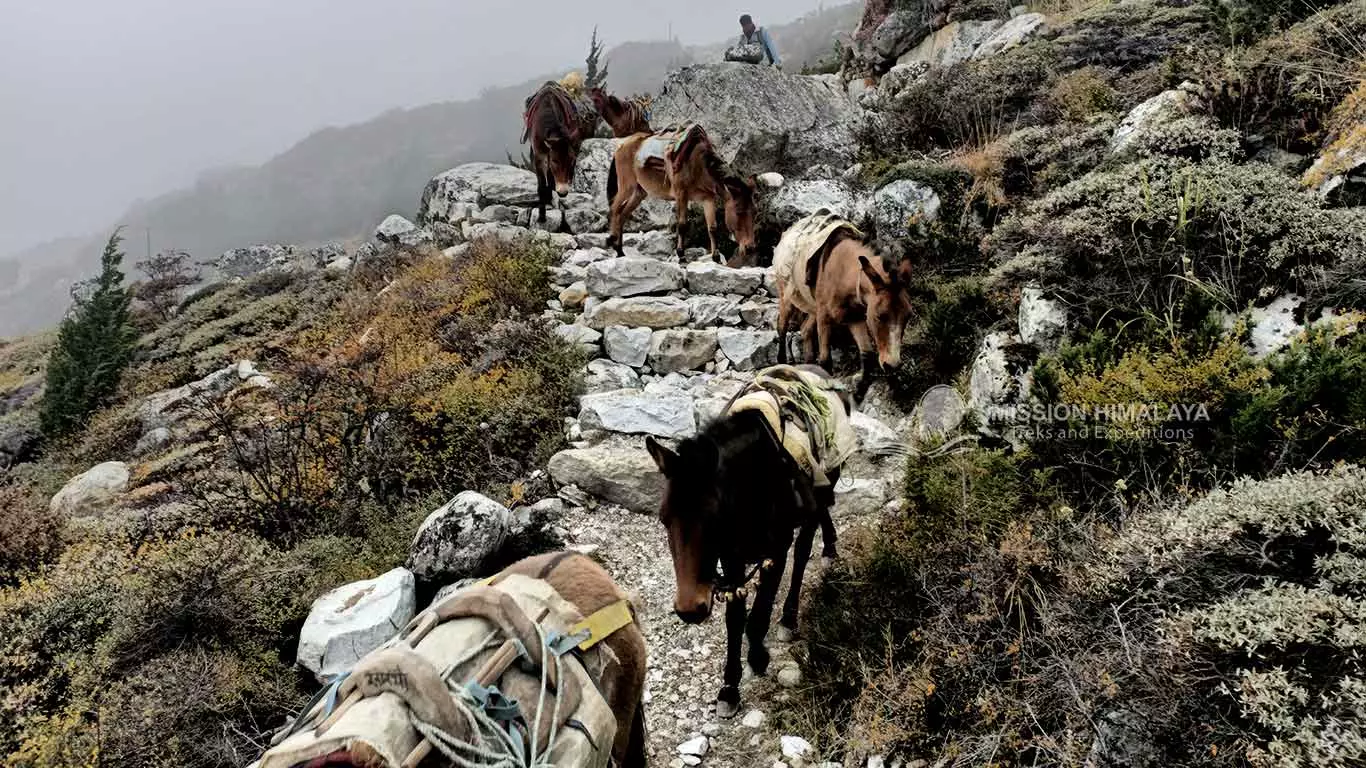
Highlight of the day: Scattered tiny Tibetan settlement lets you best explore the Tibetan Buddhist culture and lifestyle.
Leaving Gunsa behind, the trail hauls us via the mesmerizing Pine and Rhododendron forest. You will follow the trail that goes along the Gunsa Khola. Then, observing the inviting Buddhist mani walls and stupas, we will cross the bridge over Gunsa Khola. Further trekking, the views of Mt Jannu (Mt Kumbakarna) seem more than appealing today.
The trail of the Kanchenjunga base camp trek is not an easy one indeed. Attesting this fact, the trail slightly closer to Kambachen consists of the landslide area where we will have to trek with proper care. Overnight at the teahouse in Kambachen.
Day 11: Excursion Day at Kambachen

The highlight of the Day: Hike to the Kumbhakarna Base Camp
Climb high and sleep low is the motto to be recorded in everyone’s mind while doing the high-altitude trek. Here, we too are doing the high-altitude trek. Thus, to prepare our bodies to adopt the high altitude we will spend this extra day at Kambachen for the next camp day. On this day, Also, on this day, we will make an excursion to the Kumbhakarna Base Camp. Hence, wherever you go, come back to Kambachen for an overnight stay.
This hike to the Kumbakarna Base Camp is completed within around 5 hours. If not the Kumbhakarna Base Camp, you can also stroll around the Nupchu Khola for the stunning Mt Kumbhakarna Views. Nupchu Khola is located slightly above Kambachen.
Day 12: From Kambachen head to Lhonak
Accommodation: Tented Camp
Max. Altitude: 4780M

Highlight of the Day: Delve into the wonders of Mera Peak, Nepal Peak, Twins Peak, and many others.
The more we gain altitude, the tougher the trek becomes. Continuing our Kanchenjunga base camp trek from Kambachen we will have to tread via rocky terrain and icy trails. Following this route, we will cross the seasonal Yak herders camp at Ramtang before terminating our today’s trek at Lhonak.
Particularly, Lhonak is the mystifying stone huts area near the lateral Kanchenjunga Glacier. After the adventurous walk through the rocky trail, we will stay at Lhonak. This place blesses us with enthralling views of Mera Peak, Nepal Peak, Twins Peak, and many others.
Day 13: Trek to Pangpema(5143) at the North Kanchenjunga Base Camp and return to Lhonak
Walking Hours: 6 - 7 Hours Trek

Highlight of the Day: Rewarding view of the North Face of the Mountain Kanchenjunga.
The passage to Pangpema from Lhonak traverses the rocky and grassy trail along the edge of the Kanchenjunga Glacier. Following this trail, we will reach Pangpema. As soon as we reach there, we will pat ourselves for dealing with every challenge on the way out there.
We are compelled to do so all because of the rewarding Mt Kanchenjunga views. The views from there compensate for all our struggles and challenges.
As there is no teahouse for the night stay in Pangpema, we will make our return to Lhonak for a night stay.
Day 14: Retrace the route to Gunsa

This morning we will eventually open our eyes in Lhonak to witness the arresting sunlight view of Kanchenjunga. Thenafter without any delay, we will descend to the Gunsa Village via the yak pasture area of Ramtang. Overnight at the teahouse in Gunsa upon reaching.
Day 15: Continue the jaunt to Sele La Pass and sleep overnight at Sele Base Camp
Max. Altitude: 4480M

Following the rocky trail via the forested area, we will ascend towards the Sele La Pass. Here you will find that this spot boosts the incredibly excellent view of Mt.Makalu from a distance. Enjoying the views you will spend your night at Sele Base Camp.
Day 16: Trek to Tseram from Sele La Base Camp via Sinion La Pass(4646m)
Walking Hours: 7 To 8 Hours Trek
Max. Altitude: 3870M
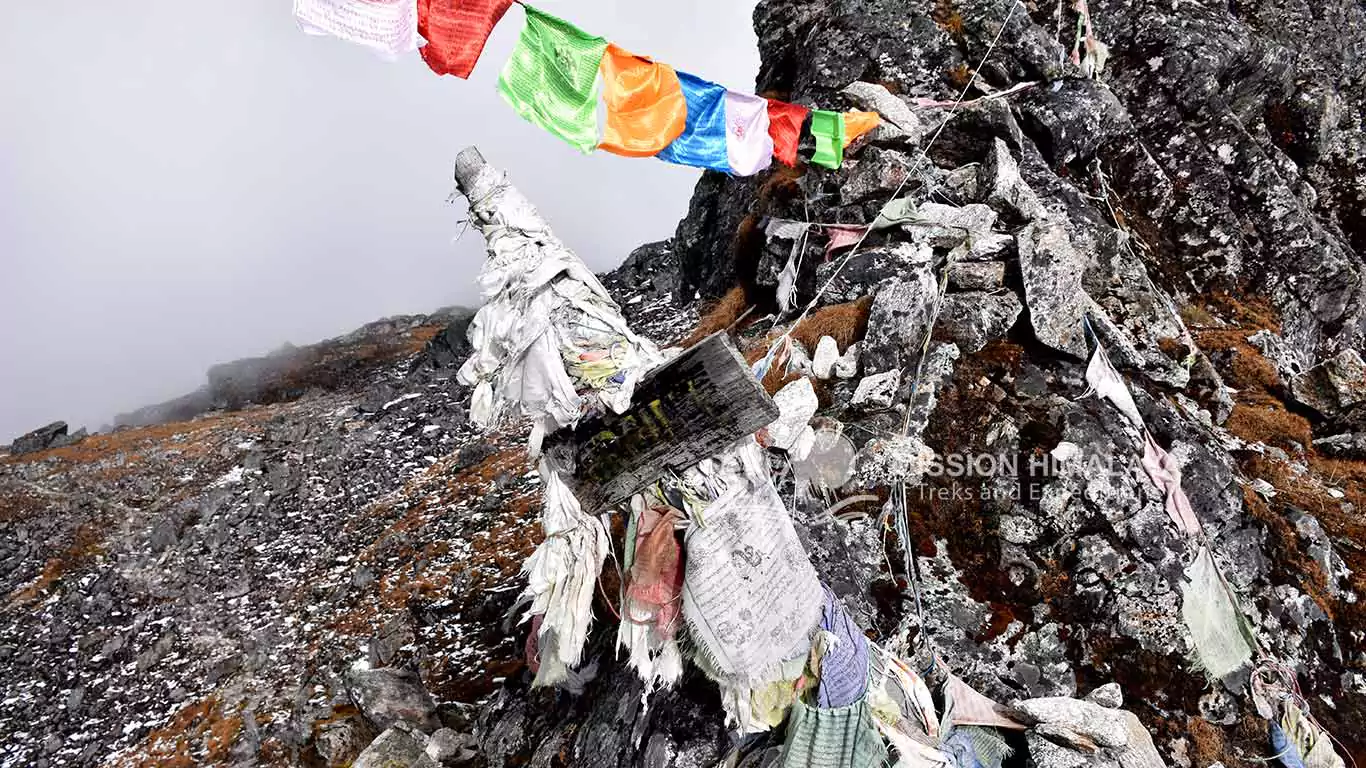
Enjoy the morning breakfast straightaway at the Base Camp. Then you will prepare your mind for the daunting walk via the pass. You will cross Sinion La Pass and Mirgin La Pass and descend to reach Tseram from the path. Tseram is a tiny settlement on the way to the South Kanchenjunga Base Camp. This settlement is settled above the Simbu Khola. Overnight at the teahouse in Tseram.
Day 17: Trek Tseram to Ramzher Or Ramche
Walking Hours: 5 To 7 Hours Trek
Max. Altitude: 4580M

The route to Ramchaur/Ramche today will pass through the beautiful forest of Pine and Rhododendrons. Also, we will go along the rocky trail to reach Ramche. On this trail, streams and small lakes will astonishingly embellish the charm of the trek.
Reaching Ramche you will find a single lodge here. So, before deciding to spend the night there, we will have to pay proper attention to the booking of lodges at Ramche for lodges. Besides that single teahouse, the place consists of several yak pastures where you can relax for a moment. Overnight at the teahouse in Ramche.
Day 18: Trek to Oktang at the South Kanchenjunga Base Camp and return same way back to Tseram
Max. Altitude: 4730M

Highlight of the day: Small and beautiful Oktang Temple and Enticing South Kanchenjunga and surrounding mountain views.
This morning in Ramche will start with a simple morning breakfast. After breakfast, we will follow the trail along the Yalung Glacier to reach Oktang. 4730m elevated Oktang in the South Kanchenjunga Base Camp lets you explore the revered Oktang temple. Furthermore, the views of the south face of Mt.Kanchenjunga and other several mountains appear incredible from here.
This day of the Kanchenjunga base camp trek is not so strenuous. So, the continuous long day’s trek will make us a little bit exhausted at the beginning of this day. But, as we reach Oktang, we will find our every effort worth it. Enjoying the wonderful moments there, you will then make your way back to Tseram for the overnight stay.
Day 19: Tseram to Tortong trek
Max. Altitude: 2995M

We are getting closer to accomplishing our dreams. So today, we will descend via the Pine, Rhododendron, and Juniper Forest to reach Tortong. We will also cross several bridges over several streams on the way. On the way to Tortong from Tseram, there is only one house in the place named Andhaphedi. And continuing through the routes, you will eventually reach Tortong where you will spend your night.
Day 20: From Tortong trek to Ranipul
Walking Hours: 8 To 9 Hours Trek
Max. Altitude: 2380M

Highlight of the day: Adorable Butterflies and Colorful Wildflowers.
Instead of heading towards Yamphudin, we will choose the way to Ranipul which blesses us with the best wildlife exploration. The scenery of waterfalls also can’t be ignored throughout the Kanchenjunga Circuit trekking trail and so is the case here.
Long hours of walking along the narrow trails make the trek much more difficult. Further, if you have acrophobia, we honestly want you to skip this entire Kanchenjunga Base Camp Trek and go for another easier one.
Also, another main thing to keep in mind for this day’s trek is that the route does not consist of several places to savor lunch. There is only one lunch eating place at Yasing Village. So we all will have lunch at this place. However, if you carry the packaged lunch there is nothing to regret for.
This trekking day is the most strenuous of all trekking days. But, you will see a glimpse of colorful flowers, green meadows, beautiful butterflies, and many other living creatures. This makes the Kanchenjunga base camp trek more tempting. Hence, upon arriving at Ranipul, you will see the beautiful views of farmland of Cardamom and corn. Finally, enjoy the wonderful night at Ranipul while remembering the entire trekking day.
Day 21: Drive to Suketar from Ranipul
Walking Hours: 5 To 7 Hours Drive.

Today we will take a drive to Suketar from Ranipul.
Day 22: Catch the flight from Suketar to Kathmandu
Walking Hours: Drive 45 Min And Flight 40 Min
Meals Included: Breakfast

Today, we will leave the Kanchenjunga region behind. Then, we will take a flight to Kathmandu with pleasing memories and experiences of trekking. Right after reaching Kathmandu, you can then go for the remaining sightseeing or souvenir shopping. Overnight at the hotel in Kathmandu.
Day 23: Contingency Day
Walking Hours: Rest Day
Today is the extra day for your trip. This day you will realize that the Kanchenjunga Base Camp trek is not the easiest one. You will remember all of the challenges you faced on the journey. So, you will never know when you have to spend the extra days on this journey. Even the flights might get delayed due to which this contingency day is a must for all Kanchenjunga region trekkers, so we keep this day as a rest day.
Day 24: Farewell program and Departure
Walking Hours: 30 Minutes Driving
Accommodation: None
It’s your departure day. As today is the final day of your trekking journey, we will drop you at the airport to return to your sweet home. In accordance with the regulations of the Nepali airport and your check-in time, we will drop you off at the airport three hours before the flight. In the near future, we hope that we will meet again. Enjoy your flight and take care!
Kanchenjunga Base Camp Trek Cost
- Airport pickup and drop-off services for both local and international flights.
- Accommodations in Kathmandu of the three-star deluxe category which includes breakfast.
- Beautiful and clean accommodations at guest houses, and lodges during the trek.
- Full board meals during the trek (Breakfast, Lunch, and dinner with a cup of hot drinks).
- Trekking guide who is very knowledgeable, courteous, fluent in English, licensed by the government, and trained by the ministry of tourism. He also receives a wage, meals, lodging, transportation, and insurance.
- One strong porter with his salary, meals, accommodation, transportation, and insurance.
- All required permits and Trekkers Information Management System (TIMS) Permits
- Down Jacket, Four-seasonal sleeping bags, Duffel bag, and trekking map (Jackets and bags should be returned after trip completion).
- Complimentary welcome or Farewell dinner in a typical Nepali restaurant with a cultural dance show
- All necessary paper works Government tax and office service charges.
- First Aid Medicines and medication with your guide.
- Certificate of your trekking signed by the company Manager and your trekking Guide.
- Domestic flight from Kathmandu to Suketar and back from Suketar to Kathmandu with your guide and porter.
- Lunch and dinner at Kathmandu (Also not included in case of early returns, flight delays, or other causes than the scheduled itinerary)
- International airfare from and to Nepal.
- Travel medical insurance and emergency evacuation.
- Your expenses (Hot shower, Alcoholic beverages, Telephone, Laundry, personal snacks, Internet, Battery Charging, hot water, Mineral water, beer, coke)
- Extra accommodation in Kathmandu and Pokhara rather than the itinerary
- Upon arriving at Tribhuvan International Airport in Kathmandu, a (two passport pictures, USD 25 for multiple entries for 15 days, USD 40 for multiple entries for 30 days, and USD 90 for multiple entries for 90 days) can be issued for Nepal Visa Fees.
- Gratitude, tips for your guide and porter.
- Cost arising from mishaps, and natural calamities.
- Services that are not mentioned in the Include section.
- Sightseeing costs in Kathmandu City.

Microspikes For High Altitude pass

Sandle For Teahouse Stay

Thin Hiking Socks

Waterproof Trekking shoes

Thick Warm Woolen Socks

Half pants For Day Hike

Inner Thermal Wear

Long Trousers for Trek

Waterproof Trousers For Rain

Short Sleeve Tshirt For Day Hike

Thermal Tshirt For cold

Woolen Upper Base Layer
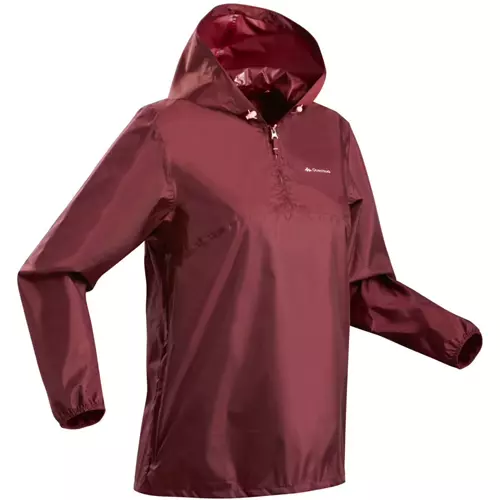
Waterproof Jacket For Rain

High Quality Down Jacket

Warm Wind Stopper
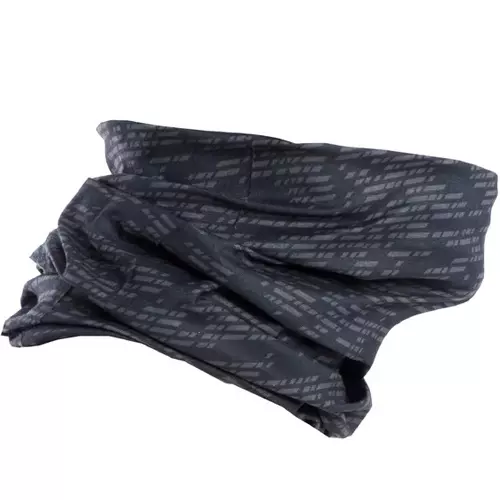
Bandana For Neck

Handkerchif For Sweating

Sun Cap For Strong Light

Uv Protected Sun Glass For Sun And Snow

Warm Woolen Hat For Cold

Headlight For Night Or Sunrise Hike

50+SPF Sun Cream

Lightweight And Fast Dry Travel Towel
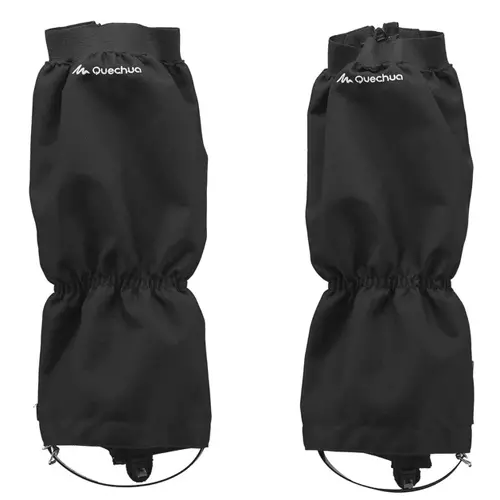
Hydration Water Bladder For Day Hiking

50+SPF Lip Balm

Tharmel Water Bottle For Hot Water

High Quality Trekking Poles

Day Bag For Trekker Own Hiking

Long Sleeve Tshirts

Backpack For Porter

Sanitery Pad For Lady

High Quality Sleeping Bag

Warm Waterproof Gloves

Padlock And Key For Safe Backpack

Snacks Energy Bars and Power Gel for Your Quick Energy

Toilet Paper For Teahouse Use

Toiletries For Man And Woman

Waterproof Bag For Your Water Safety

Spare Of Batteries

Camera For Photo And Video Of Trek

Power Bank For Mobile Charging

Two-Pin Travel Adapter

6 Month Validated Passport

Enough Cash And Credit Card For Mountain

Notebook For Your Day Experience Writting

Printed Flight Ticket IN case Loss from Mobile

Reading Book For Teahouse Free Time

Trekking Trail Map

First Aid Medicines For Trekking in Nepal
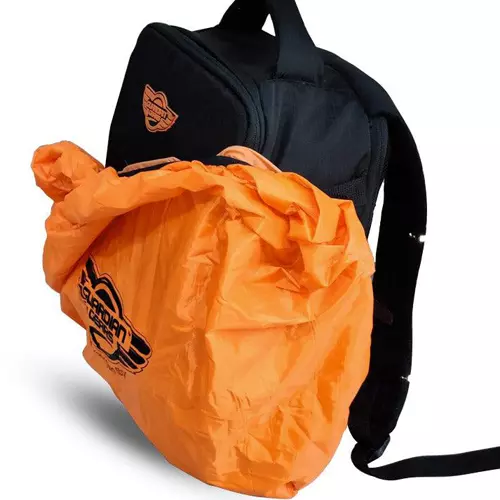
Waterproof Backpack Cover

High Altitude Covering Travel Insurance
Kanchenjunga base camp trek map.
Kanchenjunga Base Camp Trek Related Information
For more detailed info on Itinerary, here is the chart –

Accommodation facilities in Kanchenjunga Base Camp
Upon arrival, we will accommodate you in the 3-star hotel in the city of Kathmandu. Here, you have the option to be alone in this hotel or to share a room with others. If you are a lone trekker, you will need to let us know so we can arrange for you to have a separate accommodation.
When it comes to lodging options, the Kanchenjunga Base Camp Trek offers a small selection of lodges and tea houses. These teahouses can only hold the estimated number of visitors. However, the number of trekkers has surged recently. So, the Kanchenjunga region’s hotel quality and services are gradually improving. As you may know, each teahouse on the Kanchenjunga base camp trek has facilities that respond to the needs of the trekkers. The bed, pillow, mattress, and blanket are all included in the basic accommodation package here.
In earlier periods before 2015, the Kanchenjunga Trek was a Camping trek. Trek at that time was a lot more difficult than now. But with the construction of a few teahouses on the route, it is no more a camping trek.
Tips on Accommodation:
- Do not keep heating devices in the sleeping rooms.
- Prefer dining rooms to hang out in the evening or nighttime as they will have some sort of heating facilities.
- You will be sharing toilets with other trekkers in most of the places, so be prepared.
- Do not enter the kitchens of teahouses or hotels.
- Hot water for the shower may cost you a few bucks.
- Recharging your electric devices and Wi-Fi facilities may also cost you in higher altitudes.
- Bring your own sleeping bag for warmth and comfortable sleep.
- Try to order the same dish for dinner. If you are in a group it will be much quicker for them to prepare the meal.
- As soon as you reach the teahouse, make your dinner order. After that, you may relax or have a shower.
Foods and drinks
Throughout the great trekking to Kanchenjunga Base Camp in Nepal, you can find simple cuisine. The unique taste of the foods and culture of the Kanchenjunga area attracts many tourists.
The famous drink called Tong-Ba is the local drink that is the prime and unique charisma of the Kanchenjunga base camp trek. This drink is made up of fermented millet with a mixture of hot water which is served in a bamboo jar with a straw on it.
Only simple food is available in this region. In some embodies, you can find thukpa, pasta, and momo but mostly you can find ordinary food: rice, pulses, and vegetables. For more information, we will now present you with the food options by classifying them into breakfast, lunch, and dinner.
A hearty breakfast will guarantee that you get to your goal by the end of the day. We understand that you require extra power in this particular trek. Hence we strongly recommend that you consume nutritious and clean meals. Toast and bread are the options that are typically available, along with a range of egg options. Further, you can find oatmeal and puddings, pancakes with butter or jam, and lastly, a selection of soups.
In Nepalese culture, lunch is considered a vital mealtime. On the difficult and hilly Kanchenjunga base camp trek, lunch is the meal that will fuel you for the entire day. On this trip, you will find Daal-Bhat-Tarkari-Achaar (rice) as the primary meal. Also, you can find other lunch alternatives. It includes momo, noodles (thukpa), pasta, sandwiches, and potato dishes.
Since Dal Bhat is the most well-liked food and it gives a lot of energy throughout the journey, both local and foreign visitors love this meal. This meal will be well-known because it gives you a lot of energy throughout the day. For this reason, trekkers who complete the Kanchenjunga base camp trek rarely miss this meal.
In Nepal, dinner and lunch are the same meal, although dinner is typically a lighter meal. You may, however, eat as much as you want because you spend the entire day adventuring. Hence, you will be fed dinner at the lodge where you are staying that evening. And you will have the same alternatives that you will have in the lunch.
Throughout the Kanchenjunga base camp trek, teahouses and lodges serve hot, soft, and strong drinks. Some of the hot beverages that are offered here are black tea, milk tea, ginger tea, green tea, black coffee, milk coffee, and hot lemon. Soft beverages including Coke, Fanta, Sprite, and bottled juice are also available. Also, hard drinks like local wine and whisky are available. However, since you’ll be at a high altitude, you should avoid consuming any strong drinks to avoid altitude sickness in your body.
Dietary restrictions and Limitations:
In Nepal, meat is normally only eaten at festival times. The normal diet is vegetable curry and rice. Even in areas heavily influenced by Tibetan culture, meat is not an everyday thing.
In Nepal, meat is not eaten on a regular basis. In meals, you will mostly find curry with rice, vegetables, and pickles. In most of the regions of Nepal, meat is not easily accessible and people that follow Tibetan culture do not entertain meat. So, be ensured that those who are vegetarians will mostly benefit from this journey.
Furthermore, know that there is a lack of supplements and extra ingredients in the villages. The organic vegetables may be fresh, but other things may not be totally fresh as the cultivable land is not present in such areas. So, you have to limit your wants and not think about the luxurious and sweet food items.
Hence, overcoming the expectations, you can bring your extra food by yourselves. you can choose to bring food items like dried fruits, cookies, protein bars, and other energy-giving foods.
Expenses you may have on the Kanchenjunga Base Camp Trek –
Almost all of the necessary costs are covered by us on this trip. Costs that include Guide, transportation, lodging, and food are the primary costs that are covered by us. But there may be other things that you may have to pay upon your wish on this trip. Here is the description-
Since you will be traveling within Nepal, you will need Nepali currency to buy anything. However, if you wish to tip to your helpers and guide you may tip them with foreign cash.
Yes, flights are necessary for this flight, which will be covered by us. But more than that, you will also have to travel through four-wheelers in the journey. You must understand there are a range of options while traveling by road. So before the trek, you can discuss with us whether you would like to hire a private jeep or just travel in a public vehicle.
Along with three meals a day, we offer you hot drinks on the trekking journey. Anything over that must be paid by yourself.
Miscellaneous:
If you wish to take hot water for a shower, electricity facility to charge your devices, and additional Wi-Fi services. For this type of cost, you have to bear it through your own pocket. The cost for these services might cost you a few bucks. Furthermore, different kinds of beverages such as beer and cold drinks are available in shops and teahouses. So if you wish to buy them you have to pay in Nepali rupees.
Tips are given by heart and it is like a gift of appreciation for hard-working people. So, you can freely give to guides, porters, and any other people, who have helped you along the way. It’s all up to you.
What will you do in Kathmandu before/after your trek?
With seven UNESCO Heritage Sites within the Kathmandu Valley, there is plenty of history and architecture to see. So we will take you to visit Buddhist stupas, Hindu burning ghats, and ancient palaces right the next day after you come here. We are sure that, after doing this trip, you will be very glad that you have visited the cultural landmarks of the city.
Right after you do this trip you will head on to the trek journey. Then after you arrive from the trek, you will have an extra day in Kathmandu. So on this day, we advise you to do some fun activities. You can check out nightclubs, live music sessions, casinos, and parties inside the Valley. Or if you are looking into more peaceful activities then you can check out ashrams and Yoga centers. Here you can participate in healing and spiritual activities.
Permits for Kanchenjunga base camp trek
After Arrival in the country , you must have a group of at least two people to do the Kanchenjunga base camp trek. This means backpackers must obtain a permit because the Kanchenjunga Base Camp trek is listed as one of the restricted areas.
Every backpacker should get a special permit with a Kanchenjunga Conservation entry permit. As opposed to other treks you are not required to purchase a Trekker’s Information Management System (TIMS) pass.
Keep in mind that every trekker should explore the Kanchenjunga Base Camp trek with a professional guide. This might sound like a big turnoff but, a few of the trekkers lost their lives during a trek to Kanchenjunga. After that, the government made this rule for the foreign trekker’s safety.
Travel insurance to Acquire permits for the Kanchenjunga base camp trek
To obtain a trekking permit in Nepal, it is necessary to first obtain travel insurance and a travel insurance number. Furthermore, the adventurers are particularly likely to get altitude sickness. The chances are higher when traveling through the more isolated parts of the Kanchenjunga region. The chances are higher because these places lack specialized medical facilities. Under these conditions, the rescue operation must proceed, which will increase your expenses. Therefore, you have to avoid experiencing unwanted circumstances. So, to repay the costs, you must purchase travel insurance.
Evaluation of Risk for Kanchenjunga Base Camp Trek
You must know that trekking is a hardcore adventure and to do this adventure, you must have an open and curious attitude. Being able to predict and face challenges will make you a true adventurer. Therefore, you may face unanticipated weather and natural conditions on this trek. So as we mentioned above, there may be situations where the itinerary and route may change in the last hours. Hence, in these conditions of rough terrain, it will be very necessary for you to act in a team and help each other.
As we care a lot about our trekkers, we have performed a threat and risk assessment for our Kangchenjunga base camp trek. All of the trips have some degree of risk. So based on it, you can choose to join the adventure and head onto it.
Therefore, to measure the risk, we first identify the hazards of the adventure, and then only we assess the level of risk. Also along with the assessment of risk, we have control measures in place to reduce this happening or to reduce the impact it. Here is the list of the significant risks and hazards identified by us:
- Bodily harm from trips and falls, such as slipping on ice or tumbling off the route.
- Sickness related to altitude, such as AMS, HACE, and HAPE.
- Becoming disoriented or losing contact with the group, such as when crossing the Mirgin La Pass during a whiteout.
- Extremely unfavorable weather and trekking conditions.
- Injuries caused by the climate (such as sunburn, hypothermia, heat exhaustion, or heat stroke). Please be aware that the first three days of the walk will be quite hot and humid.
- Drowning and/or falling may be caused while crossing a river without a bridge.
- Landslides and rockfall.
- Risks of unpurified water.
This adventure goes through a remote region. So for that region, you will be very far from the emergency health services. If you get any kind of serious injury, then it will take time to get yourself into the hospital. The only type of evacuation and rescue is through the helicopter, so you will have to wait for some time. The helicopter only operates in optimal weather and flying conditions. So don’t expect helicopters to arrive instantly.
You may be interested in this long Kanchenjunga base camp trek, but for some reason, you might not be able to complete this adventure. In such cases, you can choose other options in the Kanchenjunga region for your adventure. Since this trip is a total of 24 days, many other shorter treks can be done in fewer days. Here are some of the shorter trekking options in the Kanchenjunga region-
- North Kanchenjunga Base Camp only (20 days) : This is another trekking alternative to the Kanchenjunga base camp trek. The route on this trek goes to Pangpema (north Kanchenjunga base camp from Taplejung. In particular, this trail passes past different communities. You will go through communities like Gunsa, Kambachen, Chiruwa, Sekathum, Gyabla, and Lhonak 4780m. Then finally, you will arrive at Pangpema.
- South Kanchenjunga Base Camp only (18 days) : This trek is also different from the other Kanchenjunga trek routes. First, this trek follows the route of Tseram to Oktang and the beautiful Kanchenjunga south base camp. On the way, you will pass through different villages like Lalikharka, Kande Bhanjyang, Yamphudin, and Tortong. Then finally, you will make your way towards the Southern Base camp of Kanchenjunga.
If you have more time and resources, you can add the trip to the Lumba Sumba Pass which is located in the Makalu region. This can be added to the above two Kanchenjunga treks. If you are in a group then it will be very easy for us to customize the trip. So think about it and inform us!
Kanchenjunga Base Camp Trek Rating
As we have discussed a lot about this trek we have known that this trek is a challenging one. The highest altitude where you will be spending your night is at Lhonak (4,790 m/15,700ft). Then finally, the highest elevation that you will be reaching on this trip is Pangpema (5,140m/16,900ft). In the whole trekking journey, there are only two acclimatization days to allow for proper acclimatization.
Furthermore, trekking to Kanchenjunga Base Camp involves an average daily hiking of around 6 hours. On some days the trekking hours could also go up to around 7-8 hours. So, Based on these facts and further information, we will rate this trek-
We rate this trek’s difficulty as 4.5/5. Spanning 20-24 days and reaching altitudes up to 5,143 meters, we already had said that this trek is challenging. Due to its remoteness, it involves steep ascents, rugged paths, and fewer amenities. So it is a must to have good physical fitness and stamina.
Scoring a perfect 5/5, the trek features spectacular scenery. It includes close-up views of Kanchenjunga and other peaks. Diverse landscapes from tropical forests to alpine meadows are prominent. Whereas, rivers, waterfalls, and glacial lakes are unavoidable.
Cultural Experience
With a rating of 4.5/5, the trek offers rich cultural experiences. It passes through villages of diverse ethnic groups like Limbu, Sherpa, and Rai. So there is no doubt you will have close interaction with locals and insight into various traditions and lifestyles.
Accessibility
Rated 2.5/5, accessing the trek is challenging. It requires a flight to Biratnagar or Bhadrapur followed by a long drive to Taplejung. Trekkers need special permits, adding to the logistical complexity.
Accommodation and Facilities
Scoring 3/5, accommodation is basic but adequate. Teahouses and lodges offer simple meals and lodging, though facilities lacking at the higher altitudes. Camping is an option but requires additional support.
Overall Experience
The Kanchenjunga Base Camp Trek earns an overall rating of 4.5/5. It offers an unparalleled adventure with breathtaking scenery and rich cultural interactions. Therefore, you will have a profound sense of accomplishment after exploring one of Nepal’s most remote regions.
Packing list for Kanchenjunga base camp trek
The Main theme of this trek is to carry as light as possible and make yourself comfortable with only essential items. While doing the trek, your day Backpack should be a maximum of 10 kg and it should not cross that limit. Furthermore, the Main duffel bag should weigh around 10 to 15 kg.
Hence, Packing for the Kanchenjunga Base Camp trek requires careful consideration of gear and clothing. Doing that will ensure your comfort and safety in the challenging Himalayan environment. Here is the list-
- Moisture-wicking long-sleeve shirts: 2-3
- Moisture-wicking short-sleeve shirts: 2-3
- Thermal tops (merino wool or synthetic): 2
- Moisture-wicking underwear: 4-6 pairs
- Thermal bottoms: 2
- Fleece jacket or pullover: 1-2
- Down or synthetic insulated jacket: 1
- Waterproof and windproof jacket (Gore-Tex or similar): 1
- Waterproof and windproof pants: 1
- Lightweight trekking pants: 2-3
- Convertible pants (zip-off to shorts): 1-2
- Sun hat or cap: 1
- Warm hat (fleece or wool): 1
- Buff or neck gaiter: 1-2
- Sunglasses (UV protection): 1
- Lightweight gloves (liner gloves): 1 pair
- Insulated gloves or mittens: 1 pair
- Waterproof trekking boots (well broken-in): 1 pair
- Camp shoes or sandals: 1 pair
- Warm socks (wool or synthetic): 4-6 pairs
- Liner socks (optional): 2-3 pairs
- 40-50 liter backpack (with rain cover): 1
- Sleeping bag (rated to -10°C or lower): 1
- Sleeping bag liner (optional for extra warmth): 1
- Adjustable trekking poles: 1 pair
- Water bottles or hydration bladder (3 liters capacity): 2-3 liters total capacity
- Water purification tablets or filter: Sufficient for the duration of the trek
- Map and compass or GPS device(Phone will do the job): 1
- First aid kit (personal medications, blister treatment): 1
- Headlamp with extra batteries: 1
- Multi-tool or knife: 1
- Emergency blanket: 1
Personal Items
- Toothbrush and toothpaste: 1 set
- Biodegradable soap and shampoo: 1 small bottle each
- Quick-dry towel: 1
- Wet wipes: 1-2 packs
- Sunscreen (SPF 30+): 1 small bottle
- Lip balm (with SPF): 1
- Hand sanitizer: 1 small bottle
- Toilet paper (packed in zip-lock bags): 1-2 rolls
- Energy bars, trail mix, dried fruit, nuts: Enough for the duration of the trek (estimate 2-3 snacks per day)
Miscellaneous
- Passport (with photocopies): 1
- Trekking permits: 1 set
- Travel insurance documents: 1 set
- Camera with extra batteries or power bank: 1
- Mobile phone with charger: 1
- Solar charger or portable power bank: 1
- Gaiters: 1 pair
- Lightweight packable daypack: 1
- Journal and pen: 1 set
- Books or e-reader: 1
Ensure all your gear is well-tested before the trek, especially your boots and backpack!
You will be heading on to this long adventurous journey in this trek. So, we suggest you gain some information about the Kanchenjunga region and trekking. Therefore, here are some books that provide detailed information about the Kanchenjunga Base Camp Trek. which will be helpful for your journey:
“Kanchenjunga: The Untrodden Peak” by Charles Evans
This classic mountaineering book details the first successful ascent of Kanchenjunga in 1955. It provides a historical perspective and insights into the region’s challenges and beauty.
“Kanchenjunga Adventure: The Story of the 1955 British Expedition to the World’s Third Highest Peak” by John Angelo Jackson
This book provides an in-depth look at the early explorations and expeditions to Kanchenjunga. Also, it offers historical context and fascinating narratives.
“The Kanchenjunga Adventure” by Frank Smythe
Another classic, this book recounts the early 20th-century explorations of Kanchenjunga. It provides a mix of adventure and historical perspective.
“Round Kanchenjunga: A Narrative of Mountain Travel and Exploration” by Douglas Freshfield
This book documents one of the first recorded circumnavigations of the Kanchenjunga massif in 1899. In this book, Freshfield provides detailed and engaging descriptions. He has covered topics like geographical challenges, stunning landscapes, and cultural encounters here. Reading these topics we believe that modern trekkers will get the inspiration and insights.
“The Himalayas: An Encyclopedia of Geography, History, and Culture” by Andrew J. Hund and James A. Wren
This book includes sections on the geography, culture, and history of the Himalayas. Also, it includes detailed information about the Kanchenjunga region.
“Kangchenjunga Himal and Kumbhakarna” by Jan Kielkowski
This book by Jan Kielkowski covers the Kanchenjunga region and the nearby Kumbhakarna (Jannu) peak. Also, it gives descriptions of various trekking routes, climbing expeditions, and topographical information. Hence this book is a valuable resource for trekkers and climbers. It offers insights into the geography, logistics, and challenges of this adventure.
“Trekking in the Nepal Himalaya” by Bradley Mayhew, Lindsay Brown, and Stuart Butler
Published by Lonely Planet, this guidebook includes a section on the Kanchenjunga Base Camp Trek. Hence, it offers practical advice, detailed maps, and cultural insights.
“The High Himalaya” by Art Wolfe and Peter Potterfield
This book features stunning photography and compelling stories about various Himalayan treks. Kanchenjunga region is also mentioned in it. Hence, it’s an inspiring read that will get you excited about your journey.
“Trekking Nepal: A Traveler’s Guide” by Stephen Bezruchka
This practical guide offers detailed descriptions of trekking routes in Nepal, including Kanchenjunga. It includes information on preparation, equipment, and local culture.
“Nepal – Culture Smart!: The Essential Guide to Customs & Culture” by Tessa Feller
While not specific to trekking, this book provides valuable insights into Nepalese culture. Especially, this will help you understand and respect local customs. So without a doubt, this thing will enhance your overall trekking experience.
Hence, reading these books will equip you with a wealth of knowledge about the Kanchenjunga region. It will let you know about its history and practical trekking tips. Ultimately, it will make your adventure more enriching and enjoyable.
In conclusion, we have to say that the Kanchenjunga base camp trek is undoubtedly a heavenly route. This is the route that astonishes trekkers with the spectacular views of the world’s third-highest mountain. Obviously, it is one of the toughest routes in the world of mountains. But with high preparation, determination, and patience you can complete this amazing adventure. Be sure that, the outcome of the hardcore adventure is worth your time, effort, and money. So get ready!
Thus, we would like to be clear that this journey is not intended for those with the bare minimum of physical capabilities. Nonetheless, people with moderate to high levels of physical activity can participate in this trekking. Finally, we would want to say that the journey to the Kanchenjunga base camp offers profound interactions. You will be interacting with native ways of life, life-altering experiences, and a great sense of achievement.
At Mission Himalaya, we always give visitors our whole attention as they go on a trekking journey. As a result, we kindly offer you to join us on this incredible journey to one of the most spectacular places on earth. You can be confident that you will be safe with us from the beginning to the end of the journey. You can contact us by phone at + 977-9841965533 or +977-14700252 if you have any queries or concerns regarding terms and conditions . As an alternative, you can contact us via email at [email protected] or by using our WhatsApp.
Kanchenjunga Base Camp Trek FAQ'S
Kanchenjunga has a wide variety of ecological systems because of its attitude profile. The zones here vary from subtropical woods to alpine zones that offer an extensive array of plants and animals. Here’s an overview of the kinds of flora and fauna you can expect to encounter on this trek:
- Subtropical Forests (Up to 2,000 meters)
- Trees and Shrubs: You will find a variety of trees including sal (Shorea robusta), oak, and rhododendron. The region is also rich in bamboo groves.
- Flowers: The lower regions are mostly filled with wildflowers, orchids, and ferns.
- Temperate Forests (2,000 to 3,000 meters)
- Trees: This zone is dominated by broad-leaved and coniferous trees such as maple, chestnut, birch, magnolia, and fir.
- Rhododendrons: This region is particularly famous for its spectacular rhododendron forests. Here you will encounter numerous Rhododendron species blooming in spring.
- Subalpine and Alpine Zones (3,000 to 4,500 meters)
- Trees and Shrubs: Higher elevations feature juniper, hemlock, and silver fir. The vegetation becomes sparser as you go higher, with dwarf shrubs and grasses.
- Alpine Meadows: This area is also home to a variety of high-altitude flowers like edelweiss, gentians, and potentillas.
- Red Panda: The dense forests of the Kanchenjunga region are one of the few remaining habitats for the endangered red panda.
- Snow Leopard: Rarely seen, the elusive snow leopard inhabits the higher altitudes.
- Himalayan Black Bear: This bear species is found in the temperate and subalpine zones.
- Blue Sheep (Bharal): Commonly spotted in the alpine meadows.
- Musk Deer: Known for their musky scent, they inhabit the higher altitudes.
- Himalayan Monal: The national bird of Nepal, recognized for its vibrant plumage.
- Blood Pheasant: Often found in the rhododendron forests.
- Snow Partridge: Common in the higher regions.
- Golden Eagle: Seen soaring in the sky, particularly in the alpine areas.
- Other Birds: There are numerous species of sunbirds, rosefinches, and warblers.
- Reptiles and Amphibians
- Reptiles: Limited due to the cold climate, but you may find some lizards in the lower, warmer regions.
- Amphibians: Frogs and toads are present in the moist forest areas.
- Butterflies and Moths: The trek features a variety of colorful butterflies and moths. Particularly, you will find them in the lower and mid-latitude regions.
- Other Insects: Various species of beetles, bees, and ants are also common.
On the Kanchenjunga Base Camp Trek, you’ll meet a variety of people, each adding their own flavor to the journey.
- Local Villagers
You’ll encounter friendly villagers along the way. Mostly, you will find the Sherpas, who are known for their mountain expertise and Buddhist traditions. There are also Rai, Limbu, Gurung, and Tamang communities, each with their own unique culture and customs.
- Tibetan Residents
You might meet Tibetan refugees who’ve made the region their home. They have their own colorful festivals and Buddhist practices.
- Fellow Adventurers
You can expect to meet fellow trekkers and mountaineers from all over the world. Here you can share stories and forge friendships amidst the stunning scenery.
- Guides and Porters
Local guides and porters are mostly from nearby villages. So, they will assist you throughout the journey, sharing their knowledge of the terrain and local life.
- Tea House Owners
The owners and staff of tea houses and lodges offer a warm welcome, providing a taste of local hospitality and cuisine.
Each encounter adds to the richness of the trek, making it not just a physical journey but a cultural adventure as well.
Mount Kanchenjunga is located in the eastern Himalayas. It straddles the border between Nepal and the Indian state of Sikkim. Especially, it is renowned as the third-highest mountain in the world, with an elevation of 8,586 meters (28,169 feet) above sea level. The name “Kanchenjunga” translates to “Five Treasures of Snow” in Tibetan, referring to its five distinct peaks. The mountain is revered by local communities and is a significant pilgrimage site for both Buddhists and Hindus.
Mount Kanchenjunga is close to Darjeeling. It is one of the popular tourist destinations in the Indian state of West Bengal. The distance from Darjeeling to the Kanchenjunga massif varies based on where you are in Darjeeling and how you choose to see the peak.
By road, the distance from Darjeeling to the base of Mount Kanchenjunga is approximately 50 to 60 kilometers (31 to 37 miles). But the actual distance to the summit is much greater. Yes, the Kanchenjunga base camp is geographically close. However, you will have to cross the tough terrain to reach the foot of Kanchenjunga from Darjeeling.
The highest altitude reached on the Kanchenjunga Base Camp Trek is approximately 5,143 meters (16,873 feet) at the Pangpema Base Camp on the north side of Kanchenjunga.
To get to the starting point of the Kanchenjunga Base Camp Trek:
- Fly from Kathmandu to either Bhadrapur or Biratnagar.
- Drive to Taplejung, the trek’s starting point. This usually involves a drive from Bhadrapur or Biratnagar to Taplejung, often with an overnight stop along the way.
Yes, it is absolutely necessary to have a guide while trekking in any region of Nepal, including the Kanchenjunga Base Camp Trek. This ensures the safety and Navigation of the paths. Also, it supports trekkers to comply with local regulations.
Yes, you can do the Kanchenjunga Base Camp Trek independently, but you will need to merge with other trekkers in a group. This is important for safety and to meet the requirements for trekking permits in this remote region.
Yes, it is possible to trek to Kanchenjunga Base Camp in the monsoon season, but it is not recommended. The monsoon brings heavy rainfall, which can make trails slippery, cause landslides, and block the views of the mountain. Trekking conditions are much more challenging and less safe during this time.
Yes, there are several health concerns to be aware of when trekking to Kanchenjunga Base Camp:
- Altitude Sickness: As you will be trekking to high altitudes, there is a risk of altitude sickness (acute mountain sickness). It’s important to acclimatize properly, drink plenty of water, and be aware of symptoms such as headaches, nausea, and dizziness.
- Weather Conditions: The weather can be unpredictable and temperatures can drop significantly, especially at higher altitudes. Proper clothing and gear are essential to stay warm and dry.
- Hygiene and Sanitation: Basic hygiene facilities may be limited along the trail. It’s important to maintain good hygiene practices to prevent illnesses such as diarrhea.
- Physical Fitness: The trek involves long days of walking on mountainous terrain. Good physical fitness is necessary to handle the demands of the trek.
- Food and Water Safety: Be cautious about the food and water you consume along the trekking route to avoid foodborne illnesses and gastrointestinal issues.
- Insect Bites: In some areas, there may be risks of insect bites that could lead to infections or diseases. Using insect repellent and wearing appropriate clothing can help mitigate this risk.
- Medical Facilities: Remote areas may have limited access to medical facilities. Carry a basic first aid kit and any personal medications you may need.
However, before starting the trek, it is essential to get in touch with a healthcare professional, particularly if you have any worries or pre-existing medical conditions.
Yes, drinking water is available along the Kanchenjunga Base Camp Trek, but it is important to treat it before consumption. Here’s what you need to know:
- Tap Water: Tap water from local sources (rivers, streams) is not safe to drink directly. It must be treated or purified before consumption.
- Boiled Water: Many tea houses and lodges along the trek route offer boiled water, which is safe to drink after it has cooled down.
- Filtered or Bottled Water: Some lodges may also provide filtered or bottled water for purchase. Ensure that the seal on bottled water is intact before buying.
- Water Purification: It is recommended to carry water purification tablets or a water filter to treat water from natural sources.
- Avoiding Plastic Waste: To reduce plastic waste, consider using a water filter and refilling your reusable water bottle with boiled or filtered water.
It’s essential to stay hydrated while trekking, so make sure to plan ahead for your water needs and always treat water to avoid waterborne illnesses.
You need to be reasonably fit and prepared for the challenges of trekking in the Himalayas. Here’s what you should consider:
- Physical Fitness: You should be able to walk 5-7 hours a day, with some days requiring longer than that. So for that, Regular cardiovascular exercise like walking or trekking is a must.
- Altitude: The trek reaches high altitudes (up to 5,143 meters), so you should be prepared for the effects of altitude. You should look out the symptoms like shortness of breath and fatigue. Acclimatization days are built into the itinerary to help adjust.
- Terrain: The trail varies from moderate to challenging, with steep ascents and descents. Some sections here also involve crossing rivers or traversing rocky paths.
- Preparation: It’s helpful to do some training hikes before the trek to build endurance and get used to walking with a daypack.
- Mental Preparation: Trekking at high altitudes can be physically and mentally demanding. Having a positive attitude and mental resilience are important.
Hence, there is no doubt that with proper preparation and a reasonable level of fitness, you can enjoy and complete the Kanchenjunga Base Camp Trek.
Yes, there are several cultural considerations to keep in mind while trekking the Kanchenjunga Base Camp Trek:
- Respect Local Customs: The trek passes through several villages inhabited by local communities, primarily Rai and Limbu people. So you have to respect their customs, traditions, and way of life.
- Dress Modestly: When entering villages or passing by local homes, it’s respectful to dress modestly, covering shoulders and knees.
- Greet Locals Appropriately: Greet locals with “Namaste” (hello) or “Namaskar” with a slight bow. This shows respect and is appreciated.
- Ask for Permission: If you want to take photos of local people, especially portraits, ask for their permission first out of respect for their privacy.
- Cultural Sites: If you visit any monasteries, stupas, or religious sites, remember to remove your shoes before entering and follow any other specific rules or customs.
By being mindful of these cultural considerations, you can contribute positively to your experience and to the local communities along the Kanchenjunga Base Camp Trek.
Cell phone reception on the Kanchenjunga Base Camp Trek is limited and unreliable. Here’s what you can expect:
- Lower Elevations: In some villages and towns along the lower parts of the trek, you may find periodic cell phone reception. However, the signal can be weak and unreliable.
- Higher Elevations: As you ascend higher into the mountains, especially beyond Tseram, cell phone reception will become extremely limited or non-existent.
- Satellite Phones: Some trekking groups or guides may carry satellite phones for emergency communication, but this is also not guaranteed.
- Local SIM Cards: If you want to use your phone, it’s advisable to buy a local SIM card in Kathmandu or Biratnagar before starting the trek.
Hence, be prepared for limited connectivity during the trek. Also, it will be good for you to inform family and friends beforehand about the potential lack of communication while you’re on the trek.
There are no ATMs on the Kanchenjunga Base Camp Trek route. It is important to plan ahead and bring enough cash with you for your trekking expenses, including accommodation, meals, and any other personal needs.
Training for the Kanchenjunga Base Camp Trek should focus on improving your cardiovascular endurance, strength, and overall stamina. Here are some recommended training activities:
- Hiking and Walking: The trek involves long days of walking, so you have to build up your endurance by hiking and walking regularly. Try to simulate trekking conditions by walking on uneven terrain and gradually increasing the distance and elevation.
- Cardiovascular Exercises: Activities such as jogging, running, cycling, and swimming are excellent for improving your cardiovascular fitness. Ultimately, it will help you with the long days of trekking.
- Strength Training: Focus on building strength in your legs, core, and upper body. Exercises like squats, lunges, step-ups, and core exercises (planks, crunches) will help prepare your muscles for the demands of the trek.
- Stair Climbing: Incorporate stair climbing into your training routine to simulate the uphill sections of the trek. This will strengthen your leg muscles and improve your endurance.
- Flexibility and Stretching: Stretch regularly to improve flexibility and reduce the risk of injuries. Yoga or Pilates can also be beneficial for improving flexibility and core strength.
- Pack Training: Train with a backpack similar to what you will be carrying on the trek. Start with a lighter load and gradually increase the weight to get used to carrying it for long periods.
- Mental Preparation: Trekking at high altitudes can be mentally challenging. Practice mindfulness, relaxation techniques, and mental resilience to prepare yourself for the trek.
Start your training well in advance of your trek to gradually build up your fitness levels. The better prepared you are physically and mentally, the more you’ll enjoy the stunning landscapes and experiences on the Kanchenjunga Base Camp Trek.
Yes, you can charge your electronic devices such as cameras, phones, and power banks on the Kanchenjunga Base Camp Trek. However, there are a few things to keep in mind:
- Tea Houses/Lodges: Most tea houses and lodges along the trek route have charging facilities available for a fee. They typically have a communal charging area where you can plug in your devices.
- Electricity Availability: Electricity in these tea houses/lodges is usually provided by solar power or hydroelectricity, and it may not be available all day. Charging may be restricted to certain hours, such as early evening, when the solar power is sufficient.
- Bring the Right Adapter: Tea houses/lodges typically have standard Nepali plugs (Type D or Type M), so make sure you have the appropriate adapter for your devices.
- Charge in Advance: It’s a good idea to charge your devices whenever you have the opportunity, rather than waiting until your battery is completely drained.
- Backup Power Banks: Consider carrying a power bank or two to ensure you have enough battery power for your devices, especially if you rely on them for navigation or emergency communication.
Hence, you will find charging facilities here. However, you have to be ready for occasional power outages.
The nearest airports to the Kanchenjunga Base Camp Trek are:
- Biratnagar Airport (BIR): This is the closest major airport to the trek. It’s located in southeastern Nepal and serves as a gateway to the eastern part of the country.
- Bhadrapur Airport (BDP): Located in the far southeastern region of Nepal, Bhadrapur Airport is another option for accessing the trekking route.
Both airports offer domestic flights from Kathmandu. From these airports, you can take ground transport to reach the starting point of the Kanchenjunga Base Camp Trek.
Trekking poles are not strictly necessary for the Kanchenjunga Base Camp Trek. But, they can be very helpful, especially on the steep ascents and descents encountered along the trail. Here are some reasons why trekking poles might be beneficial:
- Stability: Trekking poles provide extra stability, particularly on uneven terrain and during river crossings.
- Reduced Impact: They help reduce the impact on your knees and lower body, especially on long downhill sections.
- Aid in Balance: Useful for maintaining balance, particularly when the trail is narrow or rocky.
- Extra Support: Can provide additional support when ascending steep sections. Also, it can help to distribute the workload across your arms and legs.
- Tent Poles: Some trekking poles can double as tent poles if you’re camping along the trek.
If you’re comfortable hiking without trekking poles, that’s perfectly fine. However, many trekkers find them to be a helpful addition, particularly in the Himalayan terrain.
There are no strict age restrictions for the Kanchenjunga Base Camp Trek. However, due to the strenuous nature of the trek, it is generally recommended for participants to be at least 18 years old. Younger trekkers may participate under the supervision of a responsible adult. All participants need to be physically fit and prepared for the challenges of high-altitude trekking.
The average group size for the Kanchenjunga Base Camp Trek can vary. But typically the number ranges from 2 to 12 trekkers per group. Smaller groups allow for more personalized attention from guides and a more flexible pace on the trek. However, larger groups may be more cost-effective and offer a more social experience.
For the Kanchenjunga Base Camp Trek, you should use a sleeping bag that is rated for temperatures as low as -20°C (-4°F) or lower. Here are some recommendations:
- Temperature Rating: Choose to bring a sleeping bag rated for -20°C (-4°F) or lower to ensure warmth during cold nights at high altitudes.
- Down vs. Synthetic: Down sleeping bags are lighter and more compressible, providing excellent insulation. However, they are more expensive and less effective when wet. Synthetic sleeping bags are bulkier and heavier but retain insulation better when damp and are usually more affordable.
- Mummy Shape: A mummy-shaped sleeping bag is ideal as it is more thermally efficient, fitting closely to your body to minimize heat loss.
- Weight and Packability: Choose a sleeping bag that is lightweight and easy to pack. It will be easy for you to carry.
- Water-Resistant Shell: Furthermore, a water-resistant or water-repellent outer shell can help protect against dampness and condensation.
Hence, there is no doubt that by selecting a suitable sleeping bag, you’ll ensure a comfortable and warm sleep during your trek.
Yes, there are restrooms (often referred to as “toilets”) along the Kanchenjunga Base Camp Trek route, especially at tea houses and lodges where trekkers stay overnight. However, the type and cleanliness of the facilities can vary:
- Tea Houses/Lodges: Most tea houses and lodges have squat toilets or Western-style toilets. The cleanliness of these facilities can vary, so it’s a good idea to carry your own toilet paper and hand sanitizer.
- Campgrounds: When camping, you might have to use informal restrooms like pit toilets.
- Out in the Wild: When trekking between villages or away from tea houses, you may need to use nature as your restroom. However, you have to always follow Leave No Trace principles and dig a hole well away from water sources and trails.
Yes, you can buy or rent trekking gear in Nepal. Especially, in Kathmandu and other major cities you can rent gear for the Kanchenjunga Base Camp Trek.
The Kanchenjunga Base Camp Trek and the Everest Base Camp Trek offer distinct experiences. Situated in the isolated eastern part of Nepal, the Kanchenjunga trek features untainted surroundings and a wide variety of flora and fauna. Also, it’s less crowded with challenging terrain, has fewer facilities, and reaches a maximum altitude of around 5,143 meters.
On the other hand, the Everest Base Camp Trek offers incredible views of Mount Everest and other Himalayan peaks along with a well-established track, multiple tea houses, lodges, and facilities. Also, it takes you to a maximum altitude of 5,364 meters, provides insights into Sherpa culture, and tours Buddhist monasteries.
Hence, Both treks showcase Nepal’s natural beauty and rich cultural heritage but both of them have different features in terms of remoteness, difficulty, and cultural experiences.
Yes, along the Kanchenjunga Base Camp Trek, you can visit Buddhist monasteries, traditional villages inhabited by Rai, Limbu, and Sherpa communities, chortens (Buddhist stupas), mani walls (stone walls inscribed with Buddhist mantras), and occasionally witness cultural performances and local markets. Undoubtedly, these cultural sites provide insights into the rich cultural heritage of the region.
Kanchenjunga Base Camp Trek Reviews

The trek can be amazing and strenuous. The views of Rathok, Jannuhimal (Kumbhakarna), the Kabru Mountains, and Kanchenjunga are amazing. You will have an incredible experience traveling the high route in the Himalayas with the great landscapes and huge forests.
Third-highest mountain in the world and the second-highest mountain in Nepal. Situated in the east of Sikkim, India, and the south, north, and west of the Taplejung district of Nepal.
North Base Camp is also known as Yalung Base Camp and Pangpema Base Camp! The majority of individuals approach the mountain from South Base Camp! We can go from Tseram-Ramzer to South Base Camp by way of the stunning Yalung Glacier! Kanchenjungha is one of the world’s best trekking destinations!
One of the world’s greatest and least visited places. Beautiful mountains, plants, and species that are untouched and unspoiled by time. ethnic population, customs-based lifestyle, natural hospitality. Highly recommended for the trekkers.
- No Hidden Cost
- Customer Care And Safety
- Trustworthy Team
- Financially Secure
- Repeated Guests
- Flexible Departure Dates
- Different Group Sizes.
- High Successful Rate/Safety.
- Stress & Worry Free Travel
- Staffs Welfare

Managing Director
Birendra duwadi.

Don't have account create here.
16 DAYS KANCHENJUNGA NORTH BASE CAMP TREK

We Offer Group Discount
- Best Price Guarantee
- Hassle-Free Booking
- Team of highly experienced Experts
- 24/7 Customer Support
All Inclusive Cost
A breathtaking adventure that will leave you lost for words! Spend 16 days at the foot of the world’s 3rd tallest mountain amidst alpine glaciers, raging rivers, snow-capped mountains, and stunned by the natural beauty in Kanchenjunga Conservation Area . This is a physically demanding trek that rewards you with exceptional close-up panoramic views of these enormous peaks.
The 16 days Kanchenjunga North Base Camp trek takes you through subtropical forests, across remote arid moraines, through juniper, pine and rhododendron forests. Trekkers at these high altitudes will be put to the test and reach Pangpema (5,143m) which is also referred to as base camp. From base camp you will have magnificent views of the Kanchenjunga Glacier and Kanchenjunga West (8505m – also known as Yalung Kang).
Kanchenjunga is claimed to be one of the most beautiful mountains in the world and is believed to be where the Gods live. The area around Kanchenjunga Base Camp has some unique plant life and animals, largely due to its high rainfall during summer. There have been sightings of the elusive Snow Leopard in the region and more frequent sightings of the red panda. More common to this region are the Himalayan black bear and the Assamese macaque. In order to protect the area’s unique flora and fauna the entire region has been declared a conservation zone. The area is also home to several castes, including the Rai and Limbu ethnic groups.
The Kanchenjunga Base Camp was first opened, from the Nepal approach to explorers in 1950 and only become a commercial trekking destination after 1988.
Key Features of Kanchenjunga North Base Camp Trek
- Kanchenjunga, the third highest mountain in the world, and surrounding snow-clad soaring peaks.
- Visit and trek along with the Kanchenjunga Glacier and Pangpema Base Camp
- Stunning views of Mt. Makalu, the fifth highest mountain in the world, and the east face of Mt. Everest during the Kanchenjunga Trek.
- Pristine rhododendron forests, unique vegetation, high alpine passes, across rocky moraines, and terraced farmlands in these remote localities.
- A visit to the Tibetan refugee settlements and warm smiling faces of the Sherpa people, Rai and Limbu.
Day 1 : Fly from Kathmandu to Bhadrapur (45 min) & drive to Taplejung/Suketar (2,420m) Duration: 8-10 hours.
Today we will pick you up from your hotel and take you to the airport for your flight to Bhadrapur and then we will drive to Suketar, a seven to eight hour drive. We will stay overnight at Suketar.
Day 2 : Trek from Taplejung/Suketar to Sinuwa (9,80m) Duration: 5-6 hours.
Leaving Taplejung we trek through the flourishing green lower level hills passing by river-sand trekking along some steep ridges. Along the way we pass through some traditional villages with their unique mud houses, rice fields, fruit trees, and terraced farms before heading down to the Tamur River where we head upstream passing along the way some out-of-the-way villages. We eventually reach the Tamang village of Sinuwa where we stay the night.
Day 3 : Trek from Sinuwa to Chiruwa (1,280m) Duration: 5-6 hours.
After leaving Sinuwa Village the valley narrows as we traverse remnants of landslides and boulders before descending to Thiwakhola and then cross over a wooden bridge. The trail continues and follows the natural, but undulating, the contour of the terrain before reaching the market at Chirwa. Overnight stay at Chiruwa.
Day 4 : Trek from Chiruwa to Sakathum (1,575m) Duration: 5-6 hours.
After first climbing a spur we then descend to Simbuwa Khola and cross the bridge over the river – with its origin the Yalung Glacier. We again head along another ridge before reaching the Ghunsa Khola Valley. Once we reach the convergence of the Tamur River and Ghunsa Khola we continue on for a short time before making camp beside the river for the night.
Day 5 : Trek from Sakathum to Amjilosa (2,310m) Duration: 5-6 hours.
After leaving Sakathum we trek northeast alongside the banks of the Ghunsa Khola and then climb higher in the direction of Kanchenjunga Base Camp. The trek takes us across an exposed landscape and a steep ascent to the Tibetan village of Amjilosa, where we spend the night.
Day 6 : Trek from Amjilosa to Gyable (2,730m) Duration: 5-6 hours.
Today the trail takes us through rhododendron and bamboo forests. Climbing higher we come to a huge waterfall on the side of the river that signals our path us to our objective – Gyable, with its magnificent views of the surrounding landscape.
Day 7 : Trek from Gyable to Gunsa (3,595m) Duration: 4-5 hours.
After leaving Gyable the trail takes us through a large meadow, a small village, and a small hill. We then head downhill, crossing a river before reaching Gunsa Village, a large Tibetan village with traditional wooden houses, a school, health post, and its own hydroelectricity power plant. The village is within the Kanchenjunga Conservation Area has several Gompas (Buddhist fortifications) where people rest and exchange tales of their journey. Tonight we stay in Gunsa, the very last village in the valley.
Day 8 : Acclimatization day in Ghunsa
Ghunsa is an ideal location and at a high enough altitude for us to acclimatize. It is recommended that during the acclimatization period we do not remain idle. In order to do this we trek across the river to an altitude of 400 metres above the village, taking around 4 hours return. For the remainder of the day we will wander around this Tibetan village, chatting to the locals and absorbing their rich culture.
Day 9 : Trek from Ghunsa to Kambachen (4,050m) Duration: 5-6 hours.
After leaving Ghunsa we trek for five to six hours through stunning pine and rhododendron forests taking the south bank of the Ghunsa Khola and its, with numerous chortens and mani walls. Trekking across several slopes and glacier moraines we reach Kambachen - today’s destination, a tiny Tibetan village with only a few houses, but encompassed by mountains. Tonight we stay in this quaint village.
Day 10 : Trek from Kambachen to Lhonak (4,780m) Duration: 3-4 hours.
After reaching the source of the Ghunsa Khola, we trek along the north side of the Kanchenjunga Glacier and then take the trail on flat terrain past the Lhonak Glacier until we reach today’s destination, Lhonak. At this elevation the air is crisp and cold, but we are compensated with awesome views of Wedge peak, Mera peak, Nepal peak, and Twins, that will leave you spell-bound!. Tonight we stay at Lhonak.
Day 11 : Trek to Kanchenjunga Base Camp (5140m) and return to Lhonak (4,780m) Duration: 6-7 hours.
After leaving Lhonak we head in an easterly direction still staying close to the Lhonak Glacier on the northern ridges until we reach Kanchenjunga Base Camp at Pangpema where photo opportunities abound of the huge surrounding mountains. After this breathtaking experience we return to Lhonak for the night.
Day 12 : Trek from Lhonak to Ghunsa (3,595m) Duration: 6-7 hours.
Today we return to Ghunsa following the same route we took to reach Kanchenjunga Base Camp. This should take us between five and six hours. We will stay at Ghunsa for night.
Day 13 : Trek from Ghunsa to Amjilosa (2,498m) Duration: 6-7 hours.
After an hour’s trek we descend to Phale, home to several monasteries and juniper forests until arriving at a grassy hillside where the tiny village of Amjilosa lies. In total the trek today should take about five to six hours. We stay here in a guest house tonight.
Day 14 : Trek from Amjilosa to Sakathum & drive to Taplejung (1,442m) Duration: 6-7 hours.
We begin the day with a short ascent and spend the rest of the day descending down a steep trail that eventually takes us to Taplejung. After some time we reach the junction of the Tamur and Ghunsa Khola (rivers). We eventually reach Sakathum from where we take a jeep to. Taplejung and stay the night here in a guest house.
Day 15 : Drive from Taplejung back to Bhadrapur (2,08m) Duration: 8-10 hours.
The nine to ten-hour road trip takes us through many small valleys and through villages until we reach Bhadrapur where we stay in a guest house for the night.
Day 16 : Fly back from Bhadrapur to Kathmandu; Duration: 45 minutes flight.
Today we have a 30 minute scenic flight back to Kathmandu and have our final glimpses of the majestic snow covered mountains. Sherpa Expedition and Trekking will take you back to your hotel.
Costs included in your package.
- Domestic - Airport picks up and transports by private Car/Jeep.
- Three meals a day (Breakfast, lunch, and dinner) during the trek.
- Fresh fruit every evening after dinner.
- Transportation from Bhadrapur to Suketar and Taplejung to Bhadrapur by sharing Jeep.
- Trekking Lodge (Tea House)/ tent accommodation during the trek.
- All necessary paperwork including Kanchenjunga conservation area Entry Permit & Special permit.
- Kathmandu-Bhadrapur-Kathmandu flight with private airport transfer and domestic airport tax.
- A highly experienced, helpful, knowledgeable, friendly, English speaking well trained, Government license holder guide with all his salary, food, drinks, accommodation, transport and insurance.
- Strong, helpful Sherpa porters with proper safety equipment and walking equipment, his salary, food, accommodation, and insurance (one porter for two people).
- Comprehensive medical supplies (first aid kit will be available).
- Arrangement of emergency helicopter service (paid by your Travel Insurance Company).
- Use of sleeping bag, down jacket, duffel bag and walking poles (if you don’t have your own, to be returned after trip completed).
- Sherpa Expedition and Trekking T-shirt
- Government taxes and official expenses.
- Oxygen meter to check your pulse and oxygen saturation and heart rate twice daily (Very useful to check Altitude Mountain Sickness(AMS) symptoms) which will ensure your health during the trek.
- Assistant guide for groups of 8 or more people.
Costs Exclude
- Meals whilst you are in Kathmandu - lunch, and dinner.
- Nepal entry visa fee (easy to obtain the visa on arrival at Tribhuvan International Airport – Kathmandu). $30 USD for 15-day, $50 USD for 30 Days, and $125 USD for 90 Days visa.
- Personal travel and medical insurance.
- Hotel accommodation in Kathmandu
- International airfare.
- Your personal expenses.
- All the alcoholic and nonalcoholic, soup, tea, coffee, hot chocolate, cocoa, mineral water, extra food, cold and hot drinks on trek ( i.e. those you choose to purchase along the way and during evenings in the tea houses)
- All desserts & sweet things like chocolate, cake, pie, pudding.
- Hot shower and battery charging at the tea houses.
- Tips for the guide, porter, and driver (tipping is expected)
- Excess baggage of more than 20 kg for Bhadrapur flight.
- NOTE: If you return earlier from the trek due to sickness or any problem, the money you paid for the flight, hotel, mountain room, food, etc. is nonrefundable, and you will need to bear the expenses for the hotel, food, etc. in Kathmandu yourself.
The following information will give you some idea about what you need to bring for the trek. It is important you do not forget the essential items, as this will determine your comfort and safety on the trek. Equally important is that you do not burden yourself with unnecessary equipment on the trek.
- All season sleeping bag and down Jacket (we can provide if you need it, but has to be returned after the trek)
- Duffle bag ( Sherpa Expedition & Trekking provide duffle bag during the trek but has to be returned after the trek)
- A wind and waterproof thin layered jacket (a must-have for morning and evenings above 3,000m)
Upper Body- Head / Ears / Eyewear
- A pair of half gloves
- A warmer hat that covers the ears
- Sunglasses
- Sunscreen (35 to 60 SPF)
- Headlamp and an extra set of batteries
- A pair of half gloves for walking poles(if you prefer)
- Warmer shell gloves and liner
- long sleeve t-shirts
- Thermal tops
- wool jacket or pullover
- Sports bras for women and girls
- Water and windproof shell jacket
- Thermal underwear (especially trousers)
- windproof and waterproof trousers
- warmer trousers
- Comfortable trekking pants
- Extra casual sport pants
- A pair of good waterproof trekking boots
- Pair of sandals
- 4-5 pairs of woolen socks
- Sock liners
- Light shoes and sneakers
- First Aid Kits and Medicines
- Assorted adhesive bandages (fabric preferred)
- Blister treatment cream or similar
- Insect / anti-itch ointment
- Ibuprofen or other pain-relief medication
- Diamox (125mg to 250mg tablets for altitude sickness)
- Warps, splints, and wound coverings butterfly bandage
- Water purifying pills
(Note our company guide will carry the medicines and first aid kits during the trek. However, we recommend you bring your personal first-aid kit as well)
Miscellaneous - but must useful on the trek
- 4 passport size photos with original passport
- Water bottle & filter
- Flight details (please make a copy and leave one pic at our office in KTM because in case you want to change your flight date)
- Bathroom kit (conform, should be included toilet paper, plastic bags, hand wipes, towel, and soap, etc.)
Extra things
- Comfortable trekking poles
- Quality energy dry foods (up to you)
- Power bank and music players
- Camera (memory card, chargers, and extra batteries)
GOOD TO KNOW
Hotel and accommodation:.
We offer you 3-star hotel accommodation in Kathmandu (3 nights) and Lodge/Teahouses during the Kanchenjunga North Base Camp Trek . Rooms are basic, normally just a bed with blankets and a pillow. All accommodation is on a twin share basis except at the higher elevations or after Kambachen, where you will enjoy homestay style accommodation. The Kanchenjunga trek is situated in some very areas so you may not have the same level of comfort as lower down the mountain. Sherpa Expedition and Trekking will provide you down jackets, sleeping bags, and duffle bags (which need to be returned after the trek).
Meals and drinks during the trek:
Breakfast will be served in Kathmandu whereas all meals (breakfast, lunch, and dinner) will be provided during the trek. Food along the Kanchenjunga North Base Camp Trek is much like it is elsewhere in Nepal, with a heavy reliance on rice, lentils and vegetable curries. We suggest you bring a water purification pill to avoid stomach problems from drinking the local water. Bottled water is sometimes available if you prefer.
Transportation:
We provide a private car for the airport transfers and sightseeing tour of Kathmandu on the day you arrive. Flights from Kathmandu to Bhadrapur and return is also included. You will travel by jeep from Bhadrapur to Suketar.
Physical condition and past experience:
Kanchenjunga North Base Camp trek is graded as highly challenging and a tough trek due to the terrain and high altitudes. This trek takes you to many less-traveled and undeveloped areas, making it difficult in places to traverse rockfalls, moraines, and streams Trekking in these remote areas can sometimes be difficult due to landslides. The roads at the beginning and end of the trek can also be affected too. It is recommended that you prepare yourself beforehand and get physically prepared. This will make it easier to manage the difficult terrain and high altitudes.
Note: The trek itinerary is a guide and will be provided by Sherpa Expedition & Trekking . The Kanchenjunga circuit trek can be modified according to your time, budget, and requirements. What we offer here is a tea house style trek and can be modified as a purely camping trek as well. Contact us for the latest updated information and price for the varied options available.
Remember – The better prepared – the more enjoyable your trek!
Photos/videos.

- Personalized Tour
Select a departure month
- Upcoming Departures
Fill out the form below and a Travel Expert will reach out to create your perfect tour.
Travellers(Optional)
How long does the kanchenjunga north base camp trek take.
The Kanchenjunga North Base Camp Trek usually takes around 16-20 days to complete. This includes the trekking days, acclimatization days, and travel to and from the starting point of the trek.
What is the best time to do the Kanchenjunga North Base Camp Trek?
The best time to undertake the Kanchenjunga North Base Camp Trek is during the spring (March to May) and autumn (September to November) seasons. These months offer clear skies, stable weather conditions, and better visibility of the mountains.
Is it a difficult trek?
Yes, the Kanchenjunga North Base Camp Trek is considered to be moderately challenging. It involves walking on rugged terrain, steep ascents and descents, and long hours of trekking each day. A good level of physical fitness and prior trekking experience is recommended.
Do I need a special permit for this trek?
Yes, the Kanchenjunga region is a restricted area and requires a special permit to enter. You will need to obtain both the Kanchenjunga Conservation Area Permit (KCAP) and the Restricted Area Permit (RAP) from the Nepal Tourism Board. It is advisable to hire a local guide or join a trekking agency who can assist you with the permit process.
Can I do this trek solo?
Solo treks in the Kanchenjunga region are not allowed. You must trek with at least one other person and be accompanied by a licensed guide. This is for your safety and to ensure that you have a responsible and enjoyable trekking experience.
What kind of accommodation can I expect during the trek?
During the trek, you will be staying in teahouses or lodges along the trail. These are basic accommodations with shared rooms and common dining areas. The facilities may vary, but you can expect a bed with a mattress, blankets, and basic meals.
Is altitude sickness a concern on this trek?
Altitude sickness can be a concern on any high-altitude trek, including the Kanchenjunga North Base Camp Trek. It is important to acclimatize properly and take necessary precautions. It is recommended to consult with a doctor before the trek and to follow the guidance of your guide regarding altitude sickness prevention and treatment.
What are the highlights of the Kanchenjunga North Base Camp Trek?
The highlights of the Kanchenjunga North Base Camp Trek include stunning views of the Himalayan range, including Kanchenjunga, Makalu, and Jannu peaks. You will also have the opportunity to explore remote villages, interact with local communities, and experience the unique culture and traditions of the region.
What should I pack for the trek?
Some essential items to pack for the Kanchenjunga North Base Camp Trek include trekking boots, warm clothing, a down jacket, a sleeping bag, a hat, gloves, sunglasses, sunscreen, a water bottle, a first aid kit, and personal toiletries. It is advisable to pack light and carry only the necessary items.
Do I need travel insurance for this trek?
Yes, it is highly recommended to have travel insurance that covers trekking activities and emergency medical evacuation. Make sure to check the policy details and ensure that it covers high-altitude trekking in Nepal.
Latest Traveller’s Reviews
Travel experiences of our clients who recently returned from their trips..
Based On 6 Reviews
January 1, 2024
Trip of life time.
From the moment we met our guide, he talked about us becoming a family for the next fortnight as he wanted us all to stick together. This we did and it really made our trip special. He, our porters and two assistant guides looked after us every step of the way. The high mountains were tantalisingly shy for the first few days, but then gradually showed themselves to us. Simply
December 7, 2023
Simply unforgettable.
Embarking on the Kanchenjunga North Base Camp trek was a decision I will never regret. The initial shyness of the mountains only added to the anticipation, and as they gradually revealed themselves, their beauty took our breath away. The guidance and support of our guide, along with the exceptional service provided by the porters and assistant guides, made this journey simply unforgettable.
Brenda Bodziner Rabhan
Czech republic, november 8, 2023, my trip to kanchenjunga north base camp.
My trip to Kanchenjunga North Base Camp was a serene escape into the embrace of nature. The shy mountains gradually revealed themselves, leaving us in awe of their grandeur. The tranquil surroundings, coupled with the expert guidance and care provided by our dedicated team, made this journey a truly magical experience.

Write Your Review
Average Customer Ratings
How The Travellers Have Rated This Package
People Considering This Package Right Now Check availability
Write A Review
Your email address will not be published. Required fields are marked*
Download PDF
Your email address is required for downloading package details.*
Recommended On

Subscribe and Win a Free Everest Trek!
Follow us on:.

- MAKE A PAYMENT
- B2B Partner
- OUR PARTNERS
USEFUL LINKS
- Terms and Condition
- Payment Procedure
- Why Sherpa Expidition & Trekking?
- Bhutan Tour
- Helicopter Tour
EXPEDITIONS
- Everest Expedition (South)
- Everest Expedition (North)
- Everest Base Camp Trek
- Gokyo Valley Trek
SHERPA EXPEDETION
Kuala lumpur, malaysia, phuket, thailand, sydney, australia.

Sherpa Expedition and Trekking is one of the pioneers of Trekking, tour and expedition in Nepal which was established on January 07, 1977, with a motto: ‘Enhancing Tourism possibilities across the Globe’. Sherpa Expedition and Trekking is proud to be recognized as the fifth Trekking and Adventure company authorized by the Tourism Board of Nepal.
© Copyright Sherpa Expedition And Trekking. All rights reserved.
Made with in Nepal by TECH 101

IMAGES
VIDEO
COMMENTS
Kanchenjunga Base Camp Trek is a well-trailed route despite being a journey into the wilderness, as the region bears a mild topography and is easily accessible. Kanchenjunga, meaning Treasures of Snow, stands 28,198ft tall, the third-highest peak in the world. Considered a remote trek through Eastern Nepal, the trail passes restricted areas and ...
The Kanchenjunga Base Camp Trek is a challenging and rewarding journey that usually takes around 23-26 days to complete. The total distance covered during the trek is approximately 231 kilometers (143.5 miles), including both ascent and descent. The trail winds through remote villages, lush forests, cascading waterfalls, and high mountain ...
Trekking Route: A Brief Overview. The Kanchenjunga Base Camp Trek is a long and challenging trek that covers a distance of around 120 km. The trekking route is divided into two parts - the north and south base camps. The north base camp is situated in Tibet, while the south base camp is located in Nepal. In this trek, you will visit both the ...
The north Kanchenjunga base camp trek map uses bright orange lines to interpret the main hiking route. Also, the map hiking trail involves the camping point for each day with a yellow circle. The journey to Kanchenjunga base camp passes through diverse and adventurous trekking trails. The trekking route features green forests of rhododendrons ...
Kanchenjunga Base Camp Trek Difficulty: Kanchenjunga Base Camp Trek has one of the toughest trails in the Himalayas. Due to its remote, gravel terrain, difficult passes, steep routes, and many ascents and descents, the route can be considered as difficult. Also, the unpredictable weather in this region can cause the difficulty level to increase.
6 - 10 Pax. US $399. Kanchenjunga Base Camp Trek also known as Kanchenjunga Circuit Trek is a challenging adventure through the pristine landscapes of the Himalayas. As you move forward to the base of the world's third highest peak, you will go through a remote villages, lush forests, and awe-inspiring mountain views.
Kanchenjunga Base Camp Hike. Kanchenjunga, meaning "five great treasure houses of the snow," is the third-highest mountain in the world and the second highest in Nepal. Until 1856, it was believed to be the highest of all. The Kanchenjunga hike is one of the longest treks in Nepal, taking from 23 to 29 days.
Planning for Kanchenjunga Base Camp Trek in Nepal - Know about Kanchenjunga Base Camp Trek Guide 2023 - Cost, Map, Itinerary, Permit Kanchenjunga, the third-highest peak in the world at 8,586m, is an exciting option for anyone wanting to trek a route that remains relatively undiscovered.The number of trekkers allowed on the route has long been restricted by the government to preserve the ...
Kanchenjunga Base Camp Trek is the walking excursion to the base camps of the world's 3rd tallest mountain 'Kanchenjunga' elevated 8586 meters from the sea level. Mount Kanchenjunga is located in the eastern corner of Nepal, borderline with India.
The broad itinerary for the whole trek is below, and we visit the north base camp first. Days 1 - 3: Arrival in Kathmandu, rest, then fly to Biratnagar and drive to trek start. Days 4 - 24: Trek up to Kangchenjunga base camps. Days 25 & 26: Travel back to Kathmandu, spare day and depart for home. This walk around Mount Kanchenjunga visits both ...
This 22-day trek takes you to the base camp of the magnificent mountain Kanchenjunga. Kanchenjunga Trek is a wilderness and unspoiled trekking trail that was opened to foreigners for trekking only in 1988. Kanchenjunga Mountain is in the eastern part of Nepal. Mount Kanchenjunga is the third-highest mountain in the world, with a height of 8,586 ...
Kanchenjunga Trek explores around the third-highest mountain in the world, Mt. Kanchenjunga (8,586m). Our Kanchenjunga Circuit Trek itinerary leads you to the north and south base camp of Mt. Kanchenjunga. Check out our Kanchenjunga Circuit Trek map for information about the trial. We can also design a custom trekking itinerary for Kanchenjunga ...
The Kanchenjunga Base Camp Trek is beautiful as well as the best trekking destination in eastern Nepal. Mt Kanchenjunga 8,586m is the 3rd highest mountain in the world. ... Kanchenjunga base camp trek map for a group. Trip achievement certificate. Farewell dinner in Kathmandu with a culture program. Trip Excludes. Lunch and Dinner in Kathmandu.
Pay $498 Now & $1992 On arrival. Pay $478 Now & $1912 on arrival. The Kanchenjunga Circuit Trek offers an exhilarating trekking route in the eastern Himalayas of Nepal. The route is a circuit around the base of Kanchenjunga, the world's third-highest peak, and provides adventurers with mesmerizing views of the mountain and the surrounding ...
Trek from Gyabla to Ghunsa (3,595m/11,794ft), most developed settlement of northern side of Kanchenjunga: Day 11. Acclimatization day in Ghunsa for adaptation with the high altitude of Kanchenjunga North Base Camp: Day 12. Trek from Ghunsa to Kambachen (4,100m/13,451ft): Day 13. Acclimatization day in Kambachen:
Kanchenjunga circuit trek is a best kept treks of Nepal, connecting north and south base camp of Kanchenjunga via Sele Le Pass. ... With the recent addition to the trekking map of the Great Himalayan Trail, tourism is being promoted in this, as well as other, remote areas so there is the opening up of more teahouses on the route. ...
Kanchenjunga Base Camp Trek. This famous Kanchenjunga Base Camp trek takes you to both the north and south base camps of Mt. Kanchenjunga (8586m) the third world's third-highest mountain. This 20 day Kanchenjunga Circuit Trek is famous for its glorious snow-clad peaks, high altitude alpine crossings, lush green valleys, and raging glacial rivers - all in one complete package!
The Kanchenjunga Base Camp Trek is of 26 Days, with actually 22 days of challenging and unforgettable trek that will take you through some of Nepal's most beautiful landscapes.The entire trek to Kanchenjunga Base Camp covers a distance of 220km which offers an exhilarating and captivating experience. With breathtaking views of the Kanchenjunga massif, remote villages, and high-altitude terrain ...
The Kanchenjunga base camp trek ascends to Pangpema (5,100 m), following the moraine of Kanchenjunga Glacier. You pass by beautiful remote villages resided by welcoming locals living a simple lifestyle. ... Nepal Nirvana Duffle, T-shirt, Trekking map, and Water purification drop ; Farewell Dinner in a fine Restaurant; Official expenses and ...
Overview. Administratively, the city is divided into 12 administrative okrugs, which in turn are subdivided into 146 administrative units, which include 125 administrative districts and 21 administrative settlements. Municipally, each of the 146 administrative units have municipal status as 125 municipal okrugs, 19 municipal settlements, and 2 ...
Where to find Переделкино? Переделкино is located at ДСК Мичуринец, поселение Внуковское, ул.
The route on this trek goes to Pangpema (north Kanchenjunga base camp from Taplejung. In particular, this trail passes past different communities. You will go through communities like Gunsa, Kambachen, Chiruwa, Sekathum, Gyabla, and Lhonak 4780m. Then finally, you will arrive at Pangpema.
This is a physically demanding trek that rewards you with exceptional close-up panoramic views of these enormous peaks. The 16 days Kanchenjunga North Base Camp trek takes you through subtropical forests, across remote arid moraines, through juniper, pine and rhododendron forests. Trekkers at these high altitudes will be put to the test and ...